Zebra Technologies TC80NH Mobile Computer User Manual
Zebra Technologies Corporation Mobile Computer
Contents
- 1. User Manual
- 2. User Manual Regulatory
User Manual
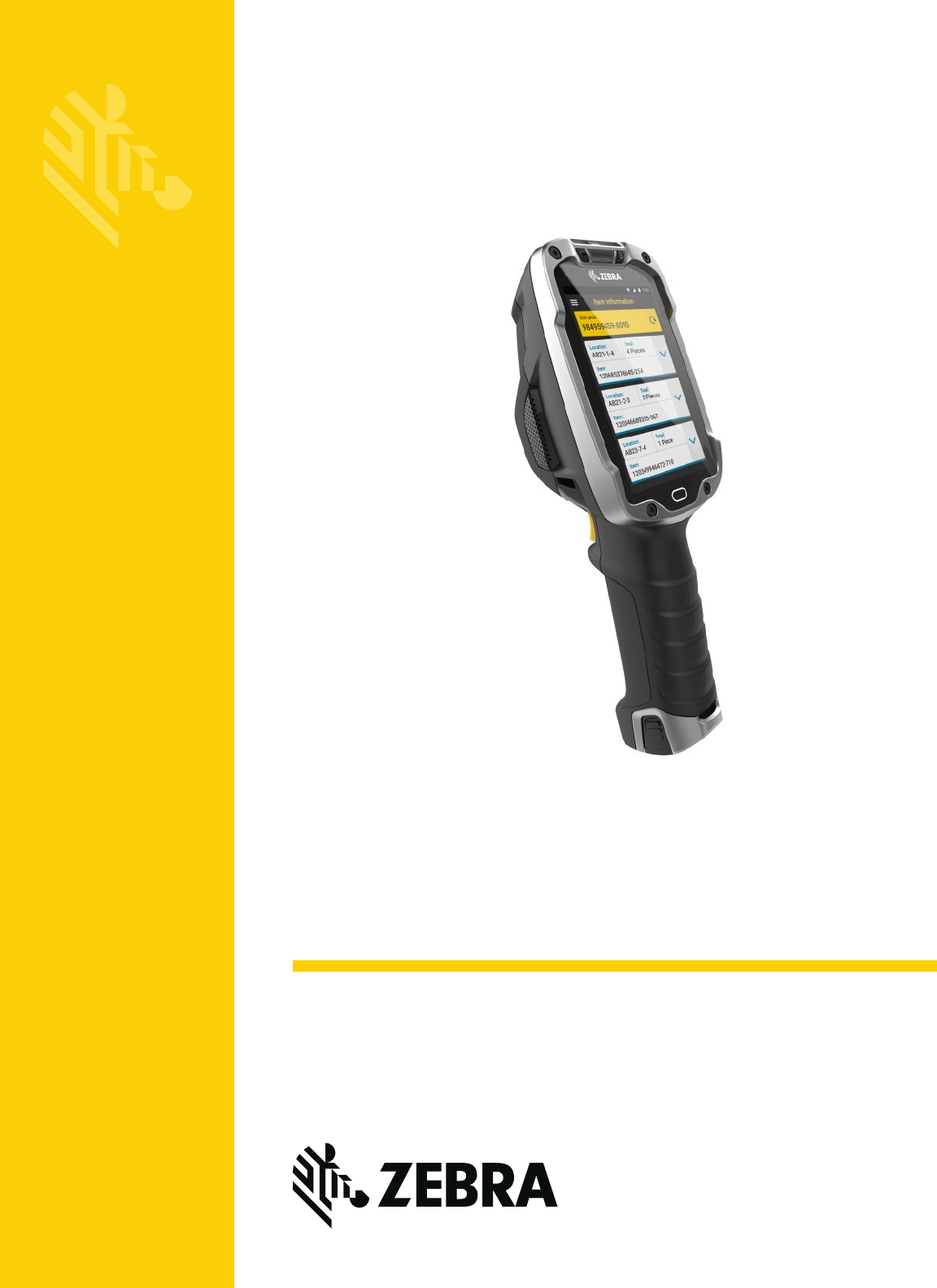
Touch Computer
User Guide
TC8000
MN002410A01
Review Copy
Review Copy

TC8000
User Guide
MN002410A01
Rev. A
October 2015
Review Copy

ii TC8000 User Guide
No part of this publication may be reproduced or used in any form, or by any electrical or mechanical means,
without permission in writing. This includes electronic or mechanical means, such as photocopying, recording,
or information storage and retrieval systems. The material in this manual is subject to change without notice.
The software is provided strictly on an “as is” basis. All software, including firmware, furnished to the user is on
a licensed basis. We grant to the user a non-transferable and non-exclusive license to use each software or
firmware program delivered hereunder (licensed program). Except as noted below, such license may not be
assigned, sublicensed, or otherwise transferred by the user without prior written consent. No right to copy a
licensed program in whole or in part is granted, except as permitted under copyright law. The user shall not
modify, merge, or incorporate any form or portion of a licensed program with other program material, create a
derivative work from a licensed program, or use a licensed program in a network without written permission.
The user agrees to maintain copyright notice on the licensed programs delivered hereunder, and to include the
same on any authorized copies it makes, in whole or in part. The user agrees not to decompile, disassemble,
decode, or reverse engineer any licensed program delivered to the user or any portion thereof.
We reserve the right to make changes to any software or product to improve reliability, function, or design.
We do not assume any product liability arising out of, or in connection with, the application or use of any
product, circuit, or application described herein.
No license is granted, either expressly or by implication, estoppel, or otherwise under any of our intellectual
property rights. An implied license only exists for equipment, circuits, and subsystems contained in our
products.
Zebra Technologies Corporation
3 Overlook Point
Lincolnshire, IL 60069 U.S.A.
http://www.zebra.com
Zebra and the stylized Zebra head are trademarks of ZIH Corp., registered in many jurisdictions worldwide. All
other trademarks are the property of their respective owners.
© 2015 Symbol Technologies LLC. All rights reserved.
Review Copy

iii
Revision History
Changes to the original manual are listed below:
Change Date Description
01 Rev. A Initial release.
Review Copy

iv TC8000 User Guide
Review Copy

TABLE OF CONTENTS
Revision History................................................................................................................................. iii
About This Guide
Introduction ....................................................................................................................................... xi
Documentation Set ........................................................................................................................... xi
Configurations................................................................................................................................... xi
Software Versions....................................................................................................................... xii
Chapter Descriptions ........................................................................................................................ xii
Notational Conventions..................................................................................................................... xii
Related Documents and Software ................................................................................................... xiii
Service Information.......................................................................................................................... xiii
Chapter 1: Getting Started
Introduction .................................................................................................................................... 1-1
Unpacking ................................................................................................................................ 1-1
Removing the Screen Protection Film ...................................................................................... 1-1
Setup .............................................................................................................................................. 1-4
Installing the Battery ................................................................................................................. 1-4
Charging the Battery ................................................................................................................ 1-5
Starting the TC8000 ................................................................................................................. 1-6
Installing the Hand Strap ................................................................................................................ 1-7
Replacing the Battery ..................................................................................................................... 1-9
Battery Management .................................................................................................................... 1-10
Monitor Battery Usage ........................................................................................................... 1-10
Low Battery Notification ......................................................................................................... 1-11
Battery Optimization ............................................................................................................... 1-11
Turning Off the Radios ........................................................................................................... 1-12
Setting the Date and Time ........................................................................................................... 1-12
Display Setting ............................................................................................................................. 1-12
Setting the Screen Brightness ................................................................................................ 1-13
Setting Screen Timeout Setting ............................................................................................. 1-13
Setting Font Size .................................................................................................................... 1-13
Review Copy

vi TC8000 User Guide
General Sound Setting ................................................................................................................. 1-14
Wake-Up Sources ........................................................................................................................ 1-15
Chapter 2: Using the TC8000
Introduction .................................................................................................................................... 2-1
Home Screen ................................................................................................................................. 2-1
Status Bar ................................................................................................................................ 2-2
Status Icons ....................................................................................................................... 2-2
Notification Icons ...................................................................................................................... 2-3
Managing Notifications ............................................................................................................. 2-4
Application Shortcuts and Widgets .......................................................................................... 2-5
Adding an Application or Widget to the Home Screen ....................................................... 2-5
Moving Items on the Home Screen .................................................................................... 2-5
Removing an App or Widget from the Home Screen ......................................................... 2-5
Folders ..................................................................................................................................... 2-5
Creating a Folder ............................................................................................................... 2-5
Naming Folders .................................................................................................................. 2-5
Removing a Folder ............................................................................................................. 2-6
Home Screen Wallpaper .......................................................................................................... 2-6
Changing the Home Screen Wallpaper .............................................................................. 2-6
Using the Touchscreen ............................................................................................................ 2-6
Using the On-screen Keyboard ................................................................................................ 2-7
Editing Text .............................................................................................................................. 2-7
Entering Numbers, Symbols and Special Characters .............................................................. 2-7
Applications .................................................................................................................................... 2-8
Accessing Applications .................................................................................................... 2-10
Switching Between Recent Applications .......................................................................... 2-10
Un-Locking the Screen ........................................................................................................... 2-11
Single User Mode ............................................................................................................. 2-11
MultiUser Mode ...................................................................................................................... 2-13
MultiUser Login ...................................................................................................................... 2-13
MultiUser Logout .............................................................................................................. 2-13
Suspend Mode ............................................................................................................................. 2-14
Performing a Soft Reset ......................................................................................................... 2-15
Performing a Hard Reset ....................................................................................................... 2-15
Chapter 3: Data Capture
Introduction .................................................................................................................................... 3-1
Status LED ..................................................................................................................................... 3-1
Laser Scanning .............................................................................................................................. 3-2
Imaging .......................................................................................................................................... 3-2
Operational Modes ................................................................................................................... 3-2
Digital Camera ............................................................................................................................... 3-2
Scanning Considerations ............................................................................................................... 3-3
Bar Code Capture with Laser Scanner .......................................................................................... 3-3
Bar Code Capture with Imager ...................................................................................................... 3-4
Bar Code Capture with Camera ..................................................................................................... 3-6
Bar Code Capture with RS507 Hands-Free Imager ...................................................................... 3-7
Review Copy

Table of Contents vii
Pairing the RS507 Hands-Free Imager Using SSI ......................................................................... 3-8
Pairing the RS507 Hands-Free Imager Using Bluetooth HID ........................................................ 3-9
Hands Free Scanning .................................................................................................................. 3-10
Scanning Mode ...................................................................................................................... 3-10
Proximity Range ..................................................................................................................... 3-11
Proper Scanning .................................................................................................................... 3-12
Improper Scanning ................................................................................................................. 3-13
Enable DataWedge ................................................................................................................ 3-14
Disable DataWedge ............................................................................................................... 3-14
Chapter 4: Wireless
Wireless Local Area Networks ....................................................................................................... 4-1
Scan and Connect to a Wi-Fi Network ..................................................................................... 4-2
Configuring a Wi-Fi Network .................................................................................................... 4-3
Manually Adding a Wi-Fi Network ............................................................................................ 4-4
Configuring for a Proxy Server ................................................................................................. 4-5
Configuring the Device to Use a Static IP Address .................................................................. 4-6
Advanced Wi-Fi Settings .......................................................................................................... 4-6
Remove a Wi-Fi Network ......................................................................................................... 4-8
Wi-Fi Advanced Features .............................................................................................................. 4-8
Zebra Mobility Extensions .............................................................................................................. 4-9
Bluetooth ...................................................................................................................................... 4-10
Adaptive Frequency Hopping ................................................................................................. 4-10
Security .................................................................................................................................. 4-10
Bluetooth Profiles ................................................................................................................... 4-11
Bluetooth Power States .......................................................................................................... 4-11
Bluetooth Radio Power .......................................................................................................... 4-11
Enabling Bluetooth ........................................................................................................... 4-11
Disabling Bluetooth .......................................................................................................... 4-12
Discovering Bluetooth Device(s) ............................................................................................ 4-12
Changing the Bluetooth Name ............................................................................................... 4-13
Connecting to a Bluetooth Device .......................................................................................... 4-13
Selecting Profiles on the Bluetooth Device ............................................................................ 4-13
Unpairing a Bluetooth Device ................................................................................................. 4-13
Near Field Communications ......................................................................................................... 4-14
Reading NFC Cards ............................................................................................................... 4-14
Sharing Information Using NFC ............................................................................................. 4-15
Enterprise NFC Settings ........................................................................................................ 4-15
Reader Mode ......................................................................................................................... 4-17
Chapter 5: Applications
Introduction .................................................................................................................................... 5-1
File Browser ................................................................................................................................... 5-1
Adding People .......................................................................................................................... 5-3
Editing People .......................................................................................................................... 5-3
Deleting People ........................................................................................................................ 5-3
Taking Photos .......................................................................................................................... 5-4
Taking a Panoramic Photo ....................................................................................................... 5-6
Review Copy

viii TC8000 User Guide
Recording Videos ..................................................................................................................... 5-7
Photo Settings .......................................................................................................................... 5-9
Video Settings ........................................................................................................................ 5-11
Working with Albums .............................................................................................................. 5-12
Share an Album ..................................................................................................................... 5-13
Get Album Information ........................................................................................................... 5-13
Deleting an Album ............................................................................................................ 5-13
Working with Photos ........................................................................................................ 5-14
Viewing and Browsing Photos .......................................................................................... 5-14
Cropping a Photo ............................................................................................................. 5-14
Setting a Photo as a Contact Icon .................................................................................... 5-15
Share a Photo .................................................................................................................. 5-15
Deleting a Photo ............................................................................................................... 5-16
Working with Videos ............................................................................................................... 5-16
Watching Videos .............................................................................................................. 5-16
Sharing a Video ................................................................................................................ 5-16
Deleting a Video ............................................................................................................... 5-17
RxLogger Configuration ......................................................................................................... 5-20
Configuration File ............................................................................................................. 5-20
Enabling Logging ................................................................................................................... 5-20
Disabling Logging ................................................................................................................... 5-20
Extracting Log Files ................................................................................................................ 5-21
Disabling Elemez Data Collection .......................................................................................... 5-22
Enabling Elemez Data Collection ........................................................................................... 5-23
Chapter 6: Accessories
Accessories .................................................................................................................................... 6-1
Battery Charging ...................................................................................................................... 6-4
Main Battery Charging ....................................................................................................... 6-4
Spare Battery Charging ...................................................................................................... 6-4
Charging Temperature ............................................................................................................. 6-5
Charging the TC8000 ............................................................................................................... 6-6
Battery Charging ...................................................................................................................... 6-7
Main Battery Charging ....................................................................................................... 6-7
Battery Charging ...................................................................................................................... 6-9
Main Battery Charging ....................................................................................................... 6-9
Spare Battery Charging ............................................................................................................ 6-9
Charging Temperature ............................................................................................................. 6-9
Charging the TC8000 ............................................................................................................. 6-10
Battery Charging .................................................................................................................... 6-11
Main Battery Charging ..................................................................................................... 6-11
Charging Temperature ........................................................................................................... 6-11
Establishing Ethernet Communication ................................................................................... 6-11
Ethernet LED Indicators ................................................................................................... 6-11
Charging the TC8000 ............................................................................................................. 6-12
Battery Charging .................................................................................................................... 6-13
Main Battery Charging ..................................................................................................... 6-13
Spare Battery Charging .................................................................................................... 6-13
Charging Temperature ........................................................................................................... 6-13
Review Copy

Table of Contents ix
Establishing Ethernet Communication ................................................................................... 6-13
Ethernet LED Indicators ................................................................................................... 6-14
Battery Installation .................................................................................................................. 6-15
Battery Removal ..................................................................................................................... 6-16
Battery Charging .................................................................................................................... 6-16
Spare Battery Charging .................................................................................................... 6-16
Charging Temperature ........................................................................................................... 6-16
Attaching the USB and Charging Cable ................................................................................. 6-18
USB Communication .............................................................................................................. 6-18
Removing the USB and Charging Cable ................................................................................ 6-19
Battery Charging .................................................................................................................... 6-19
Main Battery Charging ..................................................................................................... 6-19
Attaching the Audio Adapter .................................................................................................. 6-21
Connecting the Adapter to a Headset .................................................................................... 6-21
Removing the Audio Adapter ................................................................................................. 6-21
Attaching the Audio Adapter .................................................................................................. 6-23
Removing the Audio Adapter ................................................................................................. 6-23
Chapter 7: Maintenance and Troubleshooting
Introduction .................................................................................................................................... 7-1
Maintaining the TC8000 ................................................................................................................. 7-1
Battery Safety Guidelines .............................................................................................................. 7-1
Long Term Storage ........................................................................................................................ 7-2
Cleaning ......................................................................................................................................... 7-2
Materials Required ................................................................................................................... 7-2
Cleaning the TC8000 ............................................................................................................... 7-3
Housing .............................................................................................................................. 7-3
Display ............................................................................................................................... 7-3
Scan Exit Window .............................................................................................................. 7-3
Power Connector ............................................................................................................... 7-3
Cleaning Cradle Connectors .................................................................................................... 7-3
Cleaning Frequency ................................................................................................................. 7-4
TC8000 .................................................................................................................................... 7-5
Cradles ..................................................................................................................................... 7-7
Appendix A: Specifications
Technical Specifications ............................................................................................................... A-1
Index
Review Copy

x TC8000 User Guide
Review Copy
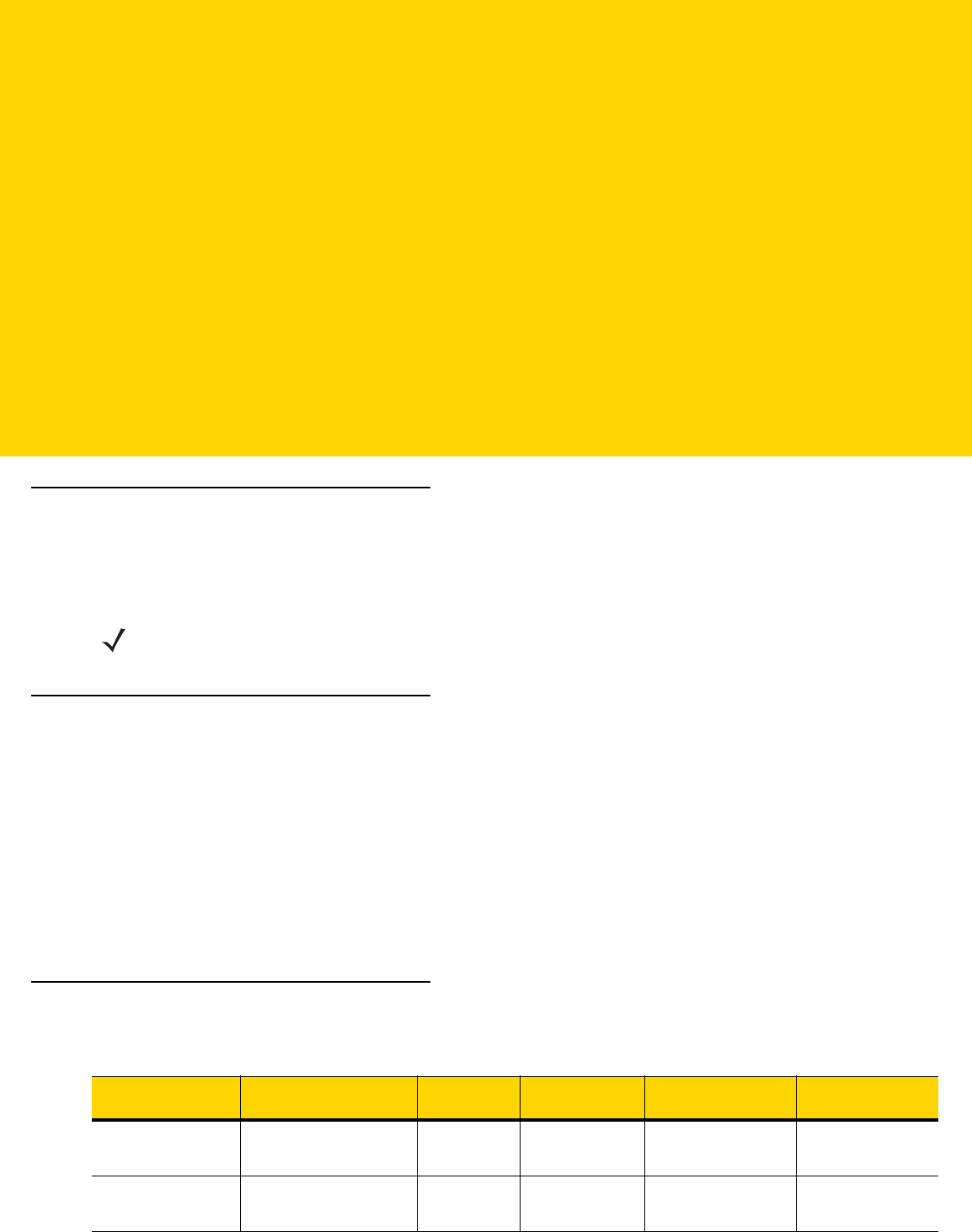
ABOUT THIS GUIDE
Introduction
This guide provides information about setting up and configuring TC8000 mobile computers with Android operating
system and installing its accessories.
Documentation Set
The documentation set for the TC8000 is divided into guides that provide information for specific user needs.
TC8000 documentation includes:
•
TC8000 Quick Reference Guide - describes basic set up and operation of the TC8000 and it’s cradles. The
guide also includes regulatory and safety information.
•
TC8000 User Guide (this guide) - describes how to set up, operate and program the TC8000 with Android
operating system and it’s accessories.
•
TC8000 Integrator Guide - describes how to setup and configure TC8000 and accessories.
Configurations
This guide covers the following configurations:
NOTE Some screens or windows shown in this guide may differ from the actual screens shown on the TC8000.
Configuration Radios Display Memory Data Capture
Options Operating
System
TC80N0 WLAN: 802.11 a/b/g/n
WPAN: Bluetooth v4.0 WVGA 4.0”
color 1 GB RAM/8 GB
Flash SE4750-SR imager
SE4850 long range
imager
Android Open
Source Project
(AOSP) 4.4.3.
TC80NH WLAN: 802.11 a/b/g/n
WPAN: Bluetooth v4.0
NFC
WVGA 4.0”
color 1 GB RAM/8 GB
Flash SE4750-SR imager
SE4850 long range
imager
Android Open
Source Project
(AOSP) 4.4.3.
Review Copy
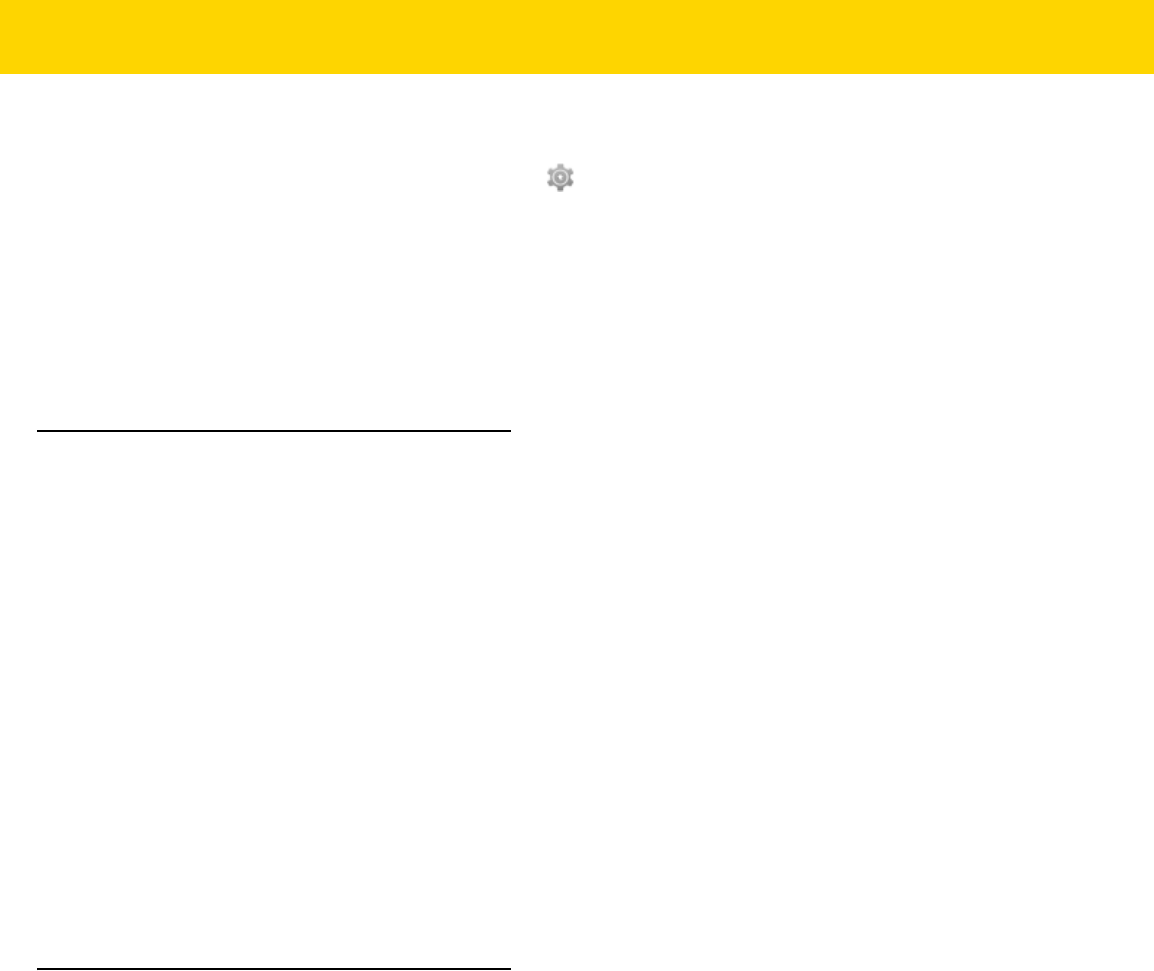
xii TC8000 User Guide
Software Versions
To determine the current software versions touch > About device.
•
Serial number - Displays the serial number.
•
Model number- Displays the model number.
•
Android version - Displays the operating system version.
•
Kernel version - Displays the kernel version number.
•
Build number - Displays the software build number.
Chapter Descriptions
Topics covered in this guide are as follows:
•
Chapter 1, Getting Started, describes the features and basic operation of the TC8000, lists the accessories
for the TC8000 and explains how to install and charge the batteries and start the TC8000 for the first time.
•
Chapter 2, Using the TC8000, provides instructions for connecting the TC8000 to a host computer and using
the OS desktop of the TC8000.
•
Chapter 3, Data Capture, provides information for capturing bar code data.
•
Chapter 4, Wireless, provides information on the various wireless options.
•
Chapter 5, Applications, provides information on various applications pre-installed on the TC8000.
•
Chapter 6, Accessories, Accessories, provides information for using the accessories with the TC8000.
•
Chapter 7, Maintenance and Troubleshooting, includes instructions on cleaning and storing the TC8000, and
provides troubleshooting solutions for potential problems during TC8000 operation.
•
Appendix A, Specifications, includes a table listing the technical specifications for the TC8000 and
accessories.
Notational Conventions
The following conventions are used in this document:
•
Italics are used to highlight the following:
•Chapters and sections in this guide
•Related documents
•
Bold text is used to highlight the following:
•Dialog box, window and screen names
•Drop-down list and list box names
•Check box and radio button names
•Icons on a screen
•Key names on a keypad
•Button names on a screen
Review Copy
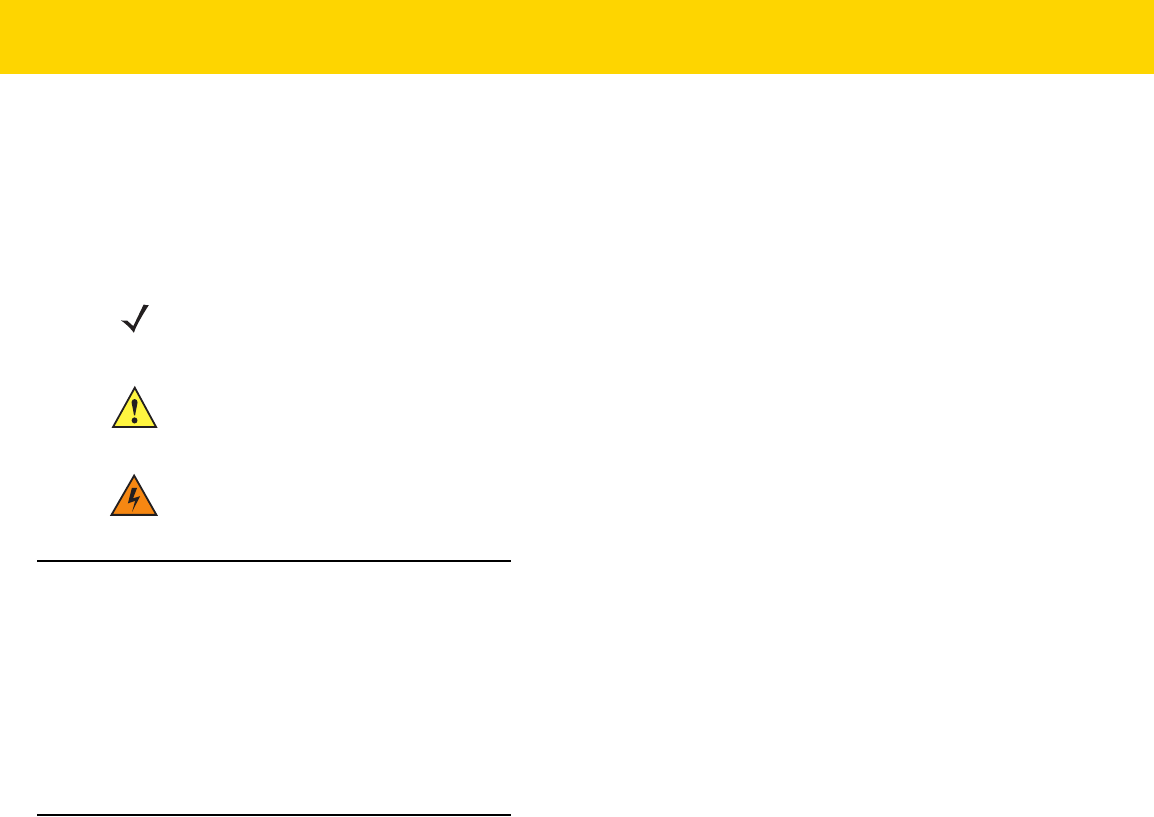
About This Guide xiii
•
Bullets (•) indicate:
•Action items
•Lists of alternatives
•Lists of required steps that are not necessarily sequential
•Sequential lists (e.g., those that describe step-by-step procedures) appear as numbered lists.
Related Documents and Software
The following documents provide more information about the TC8000 touch computers.
•
TC8000 Regulatory Guide, p/n MN002270Axx
•
TC8000 Integrator Guide, p/n MN002411Axx
For the latest version of this guide and all guides, go to: http://www.zebra.com/support
Service Information
If you have a problem with your equipment, contact Customer Support for your region. Contact information is
available at: http://www.zebra.com/support.
When contacting Customer Support, please have the following information available:
•
Serial number of the unit
•
Model number or product name
•
Software type and version number.
We respond to calls by E-mail, or telephone within the time limits set forth in support agreements.
If your problem cannot be solved by Zebra Support, you may need to return your equipment for servicing and will
be given specific directions. Zebra is not responsible for any damages incurred during shipment if the approved
shipping container is not used. Shipping the units improperly can possibly void the warranty.
If you purchased your business product from a business partner, contact that business partner for support.
NOTE This symbol indicates something of special interest or importance to the reader. Failure to read the note will
not result in physical harm to the reader, equipment or data.
CAUTION This symbol indicates that if this information is ignored, the possibility of data or material
damage may occur.
WARNING!This symbol indicates that if this information is ignored the possibility that serious personal
injury may occur.
Review Copy

xiv TC8000 User Guide
Review Copy

CHAPTER 1 GETTING STARTED
Introduction
This chapter describes the features of the TC8000 and explains how to install and charge the battery and how to
reset the TC8000.
Unpacking
Carefully remove all protective material from the TC8000 and save the shipping container for later storage and
shipping.
Verify that box contains all the equipment listed below:
•
TC8000
•
Battery
•
Regulatory Guide.
Inspect the equipment for damage. If you are missing any equipment or if you find any damaged equipment,
contact Support immediately. See Service Information on page xiii for contact information.
Removing the Screen Protection Film
A screen protection film is applied to the TC8000 screen to protect the screen during shipping. To remove the
screen protector, carefully lift the thin film off the display.
Review Copy
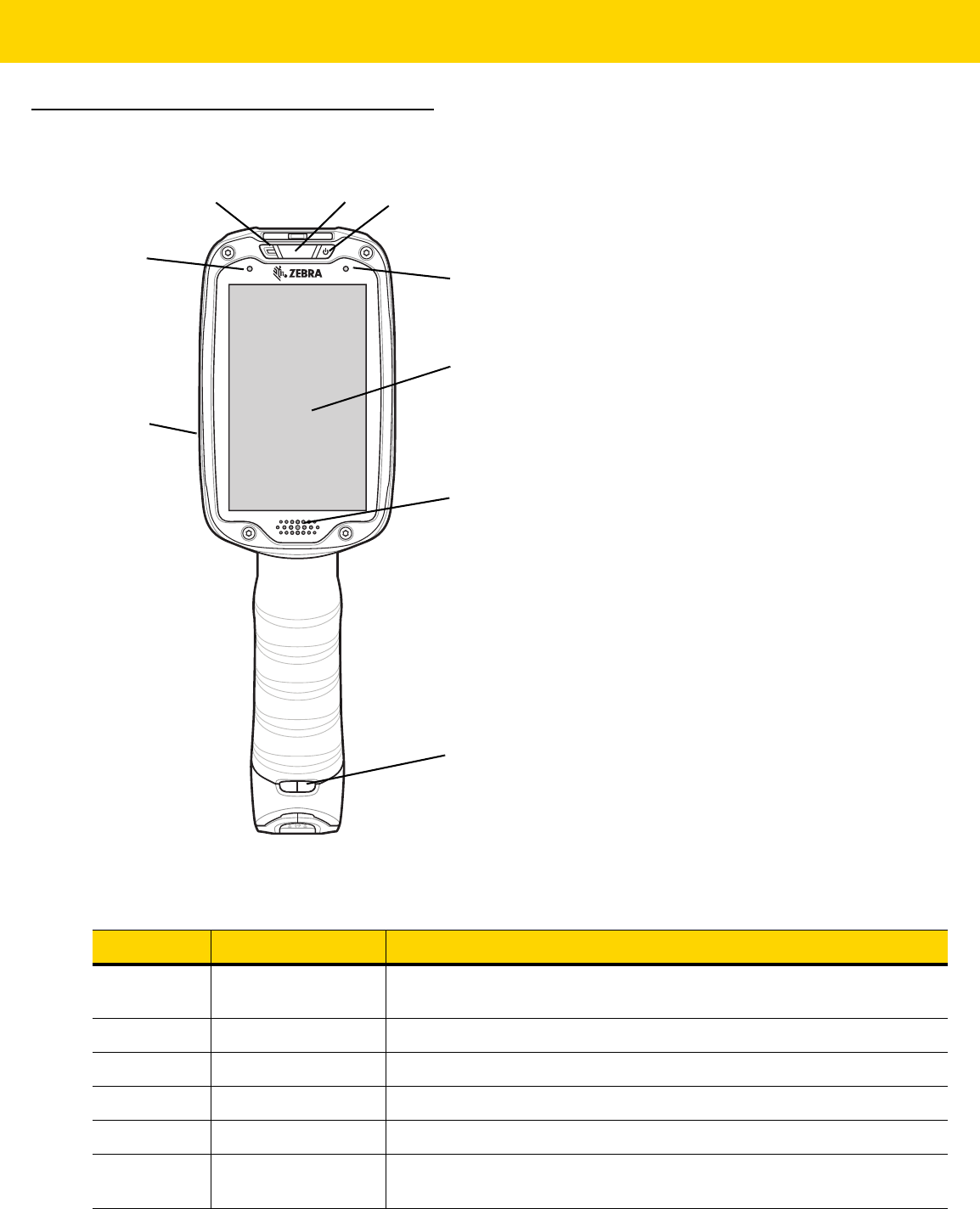
1 - 2 TC8000 User Guide
Features
Figure 1-1 Front View
Table 1-1 Front View Descriptions
Number Item Function
1 Charging/Scan LED Indicates battery charging status while charging, good decode indication
during data capture and application generated notifications.
2 Power Button
3 Blue Indication LED User programmable LED.
4 Display Displays all information needed to operate the TC8000.
5 Touch Button Press to select items or
6 Hand Strap Mounting
Point
5
7
4
91
3
8
6
2
Review Copy
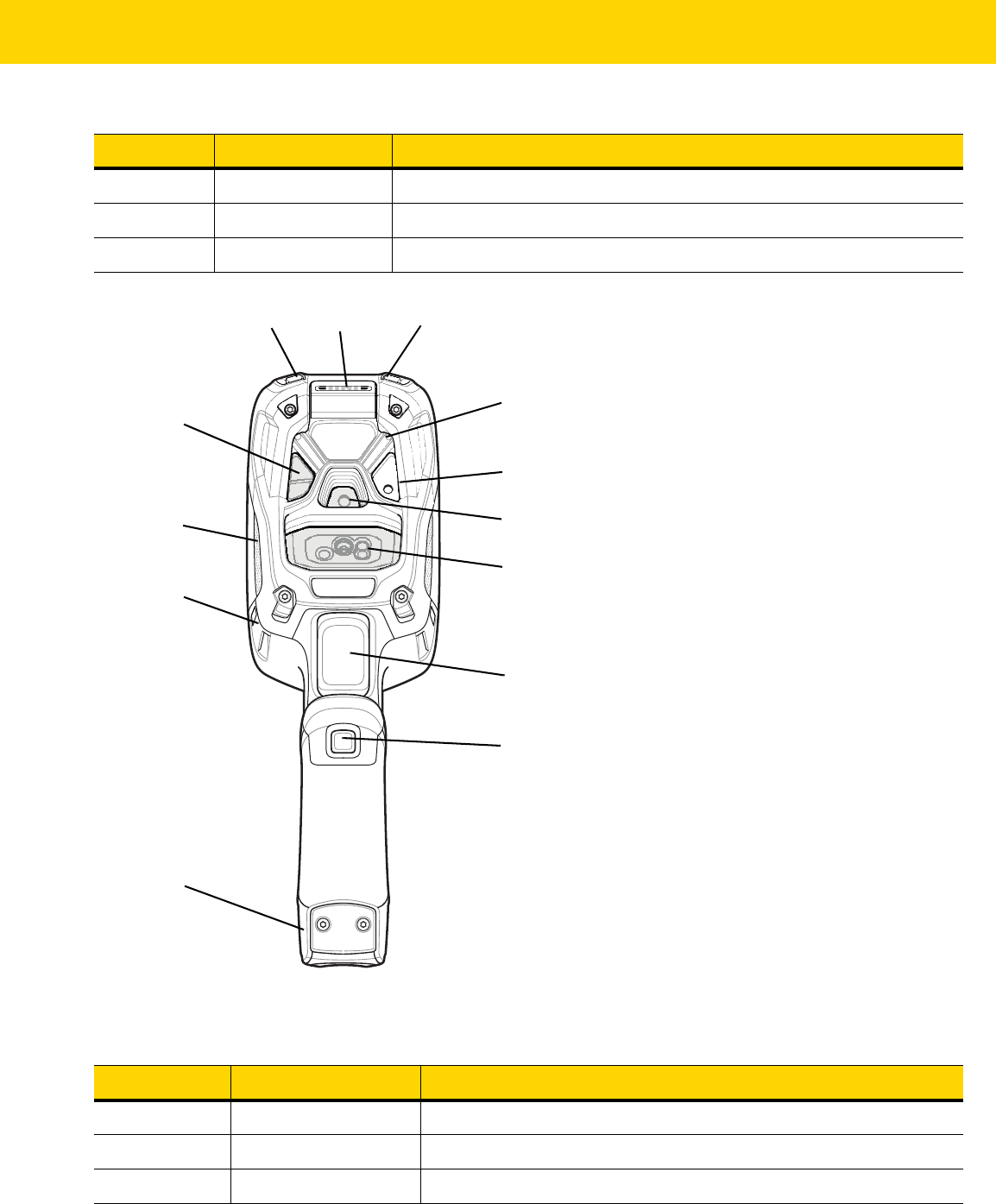
Getting Started 1 - 3
Figure 1-2 Back View
7 Speakers Provides audio output for video and music playback.
8 Ambient Light Sensor
9 Microphone Use for communication in handset mode.
Table 1-2 Back View Descriptions
Number Item Function
1 Rear Microphone Use during video recording and noise cancellation.
2 Camera Flash Provides illumination for the camera.
3 Camera Takes photos and videos.
Table 1-1 Front View Descriptions (Continued)
Number Item Function
1
2
3
4
5
7
8
10
6
11 12 13
9
Review Copy
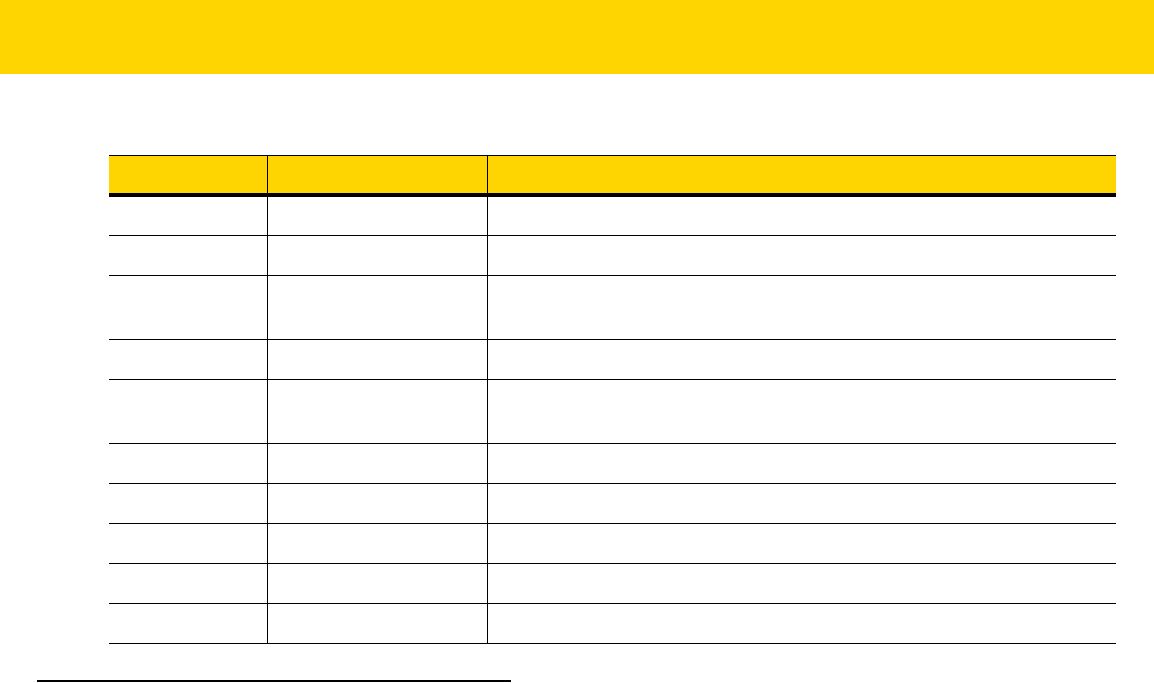
1 - 4 TC8000 User Guide
Setup
Perform these procedures to start using the TC8000 for the first time.
1. Install the battery.
2. Charge the TC8000.
3. Power on the TC8000.
Installing the Battery
To install the battery:
1. Slide the battery into the handle of the device.
4 Scanner Provides data capture using the imager or laser scanner.
5 Trigger Initiates data capture.
6 Push -To-Talk (PTT)
Button
7 Battery Pack Provides power to the device.
8 Hand Strap Mounting
Point
9 Speaker
10 Proximity Sensor Long range proximity sensor (optional).
11 Volume Up Button Decreases audio volume.
12 I/O Connector
13 Volume Up Button Increases audio volume.
Table 1-2 Back View Descriptions (Continued)
Number Item Function
Review Copy
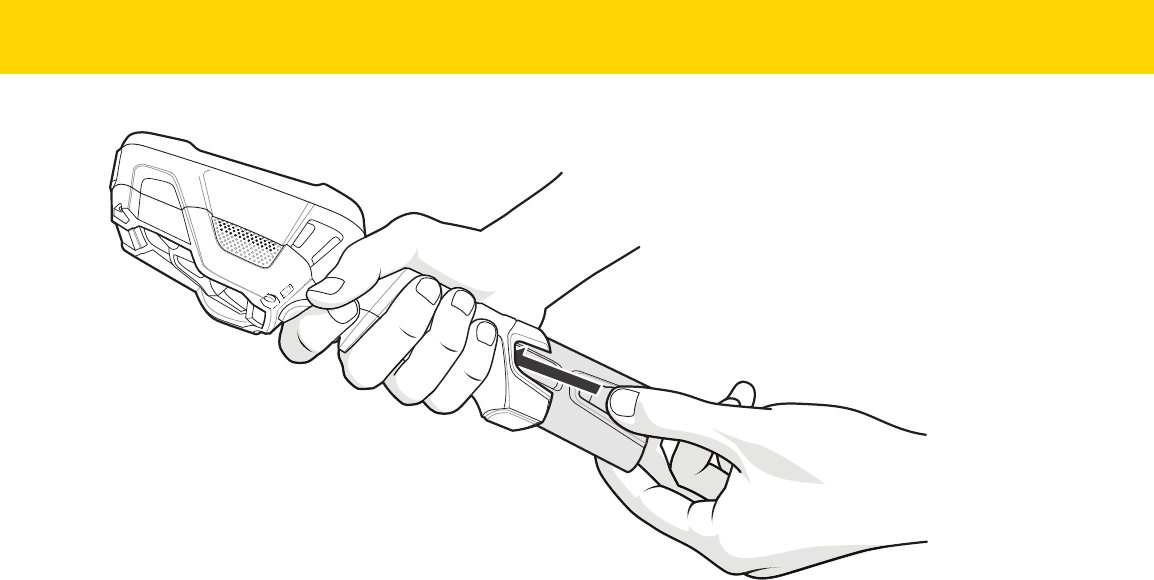
Getting Started 1 - 5
Figure 1-3 Battery Installation
2. Snap battery into place.
Charging the Battery
Before using the TC8000 for the first time, charge the battery using a cable or a cradle with the appropriate power
supply. For information about the accessories available for the TC8000, see Chapter 6, Accessories.
•
4-Slot Battery Charger
•
2-Slot USB Charge Cradle
•
5-Slot Charge Only Cradle
•
5-Slot Ethernet Cradle
•
5-Slot Charge Only Cradle with 4-Slot Battery Charger
•
5-Slot Charge Only Cradle with 4-Slot Battery Charger.
The 6,400 mAh battery fully charges in approximately six hours at room temperature.
Charge batteries in temperatures from 0 °C to 40 °C (32 °F to 104 °F). The TC8000 or accessory always performs
battery charging in a safe and intelligent manner. At higher temperatures (e.g. approximately +37 °C (+98 °F)) the
TC8000 or accessory may for small periods of time alternately enable and disable battery charging to keep the
battery at acceptable temperatures. The TC8000 or accessory indicates when charging is disabled due to
abnormal temperatures via its LED.
1. To charge the main battery, connect the charging accessory to the appropriate power source.
2. Insert the TC8000 into a cradle or attach to a cable. The TC8000 turns on and begins charging. The
Charging/Scan LED blinks amber while charging, then turns solid green when fully charged.
Review Copy
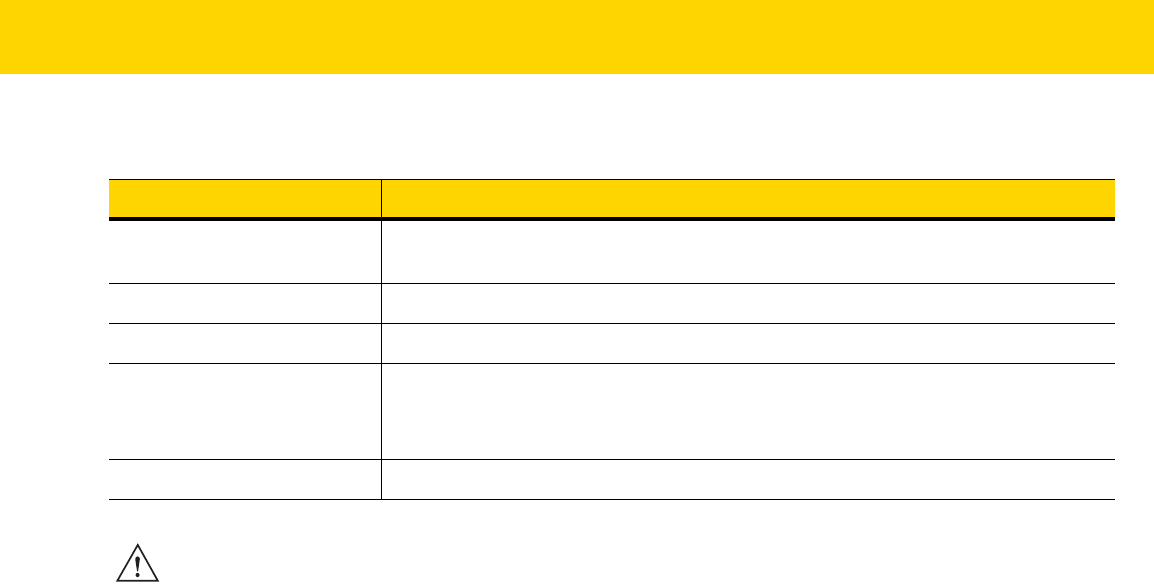
1 - 6 TC8000 User Guide
Starting the TC8000
The TC8000 starts automatically as soon as power is applied; either with a charged battery installed or when
inserted into a cradle.
If charged battery is installed and the TC8000 is turned off, press the Power button to turn on.
When the TC8000 is powered on for the first time, it initializes its system. The splash screen appears for a short
period of time.
Figure 1-4 Splash Screen
The splash screen is followed by the boot animation screen and then the Home Screen.
Table 1-3 Charging/Scan LED Charging Indicators
State Indication
Off TC8000 is not charging. TC8000 is not inserted correctly in the cradle or connected
to a power source. Charger/cradle is not powered.
Solid Amber TC8000 is charging.
Solid Green Charge complete.
Fast Blinking Red
(2 blinks/second) Charging error, e.g.:
- Temperature is too low or too high.
- Charging has gone on too long without completion (typically eight hours).
Solid Red Battery hot swap mode.
IMPORTANT
When trying to power on the device, a quick blink of the charging LED indicates that it does not have
enough battery power to turn on. You will need to charge the battery or replace it.
NEED DRAWING
Review Copy
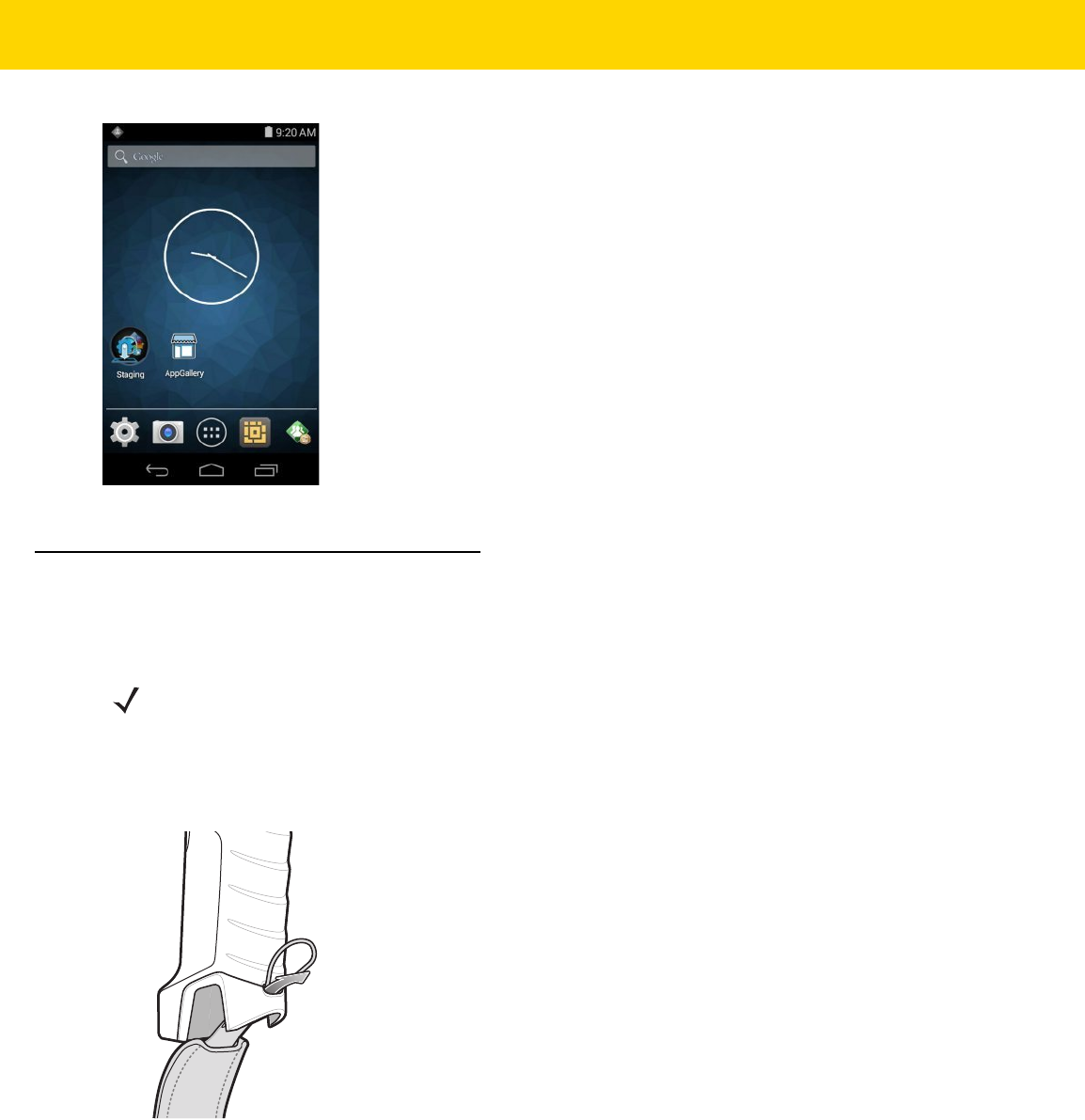
Getting Started 1 - 7
Figure 1-5 Home Screen
Installing the Hand Strap
To install the hand strap:
1. Remove battery if installed.
2. Thread the lanyard loop through the opening near the base of the handle.
Figure 1-6 Insert Loop through Handle Slot
3. Insert the top end of the hand strap through the loop.
NOTE
Installation of the hand strap is optional. Skip this section if not installing the hand strap.
Review Copy
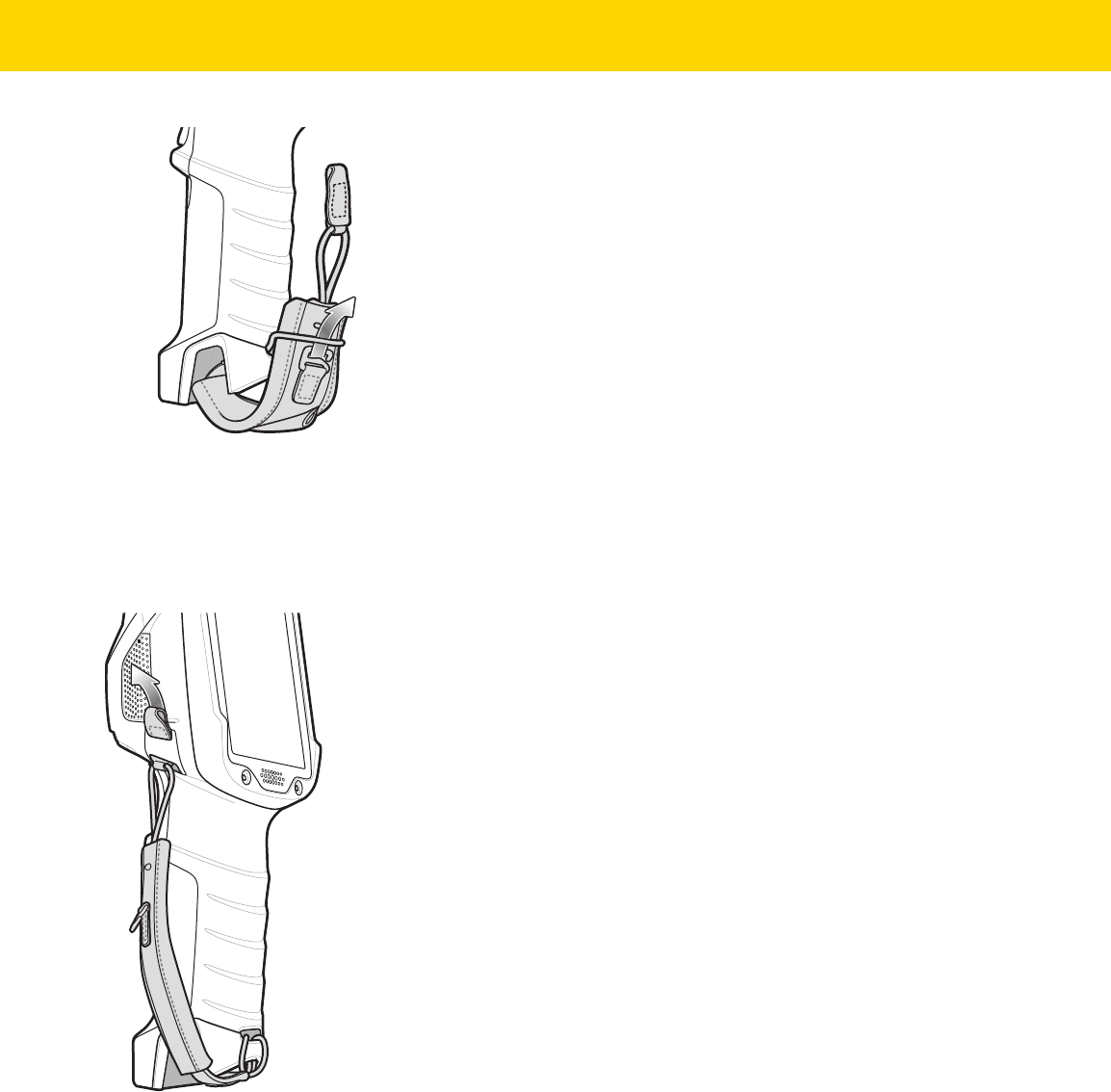
1 - 8 TC8000 User Guide
Figure 1-7 Thread Hand Strap Through Loop
4. Thread the hand-strap through the lanyard.
5. Pull the hand strap through the loop.
6. Thread the lanyard through the slot on the left or right side of the unit, depending on your preference.
Figure 1-8 Tread Tab Through Side Slot
7. Slide the tab onto the clip.
Review Copy
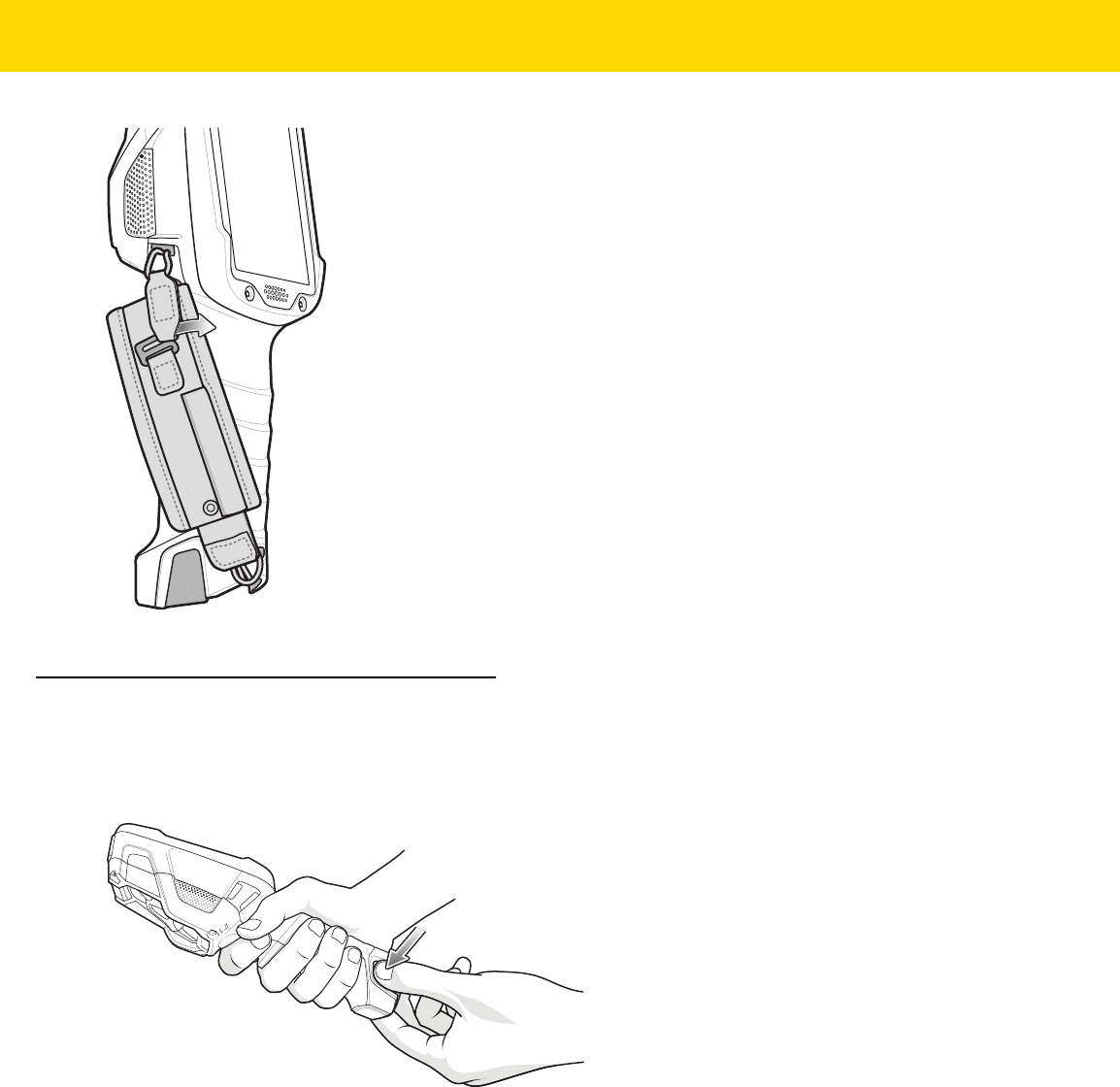
Getting Started 1 - 9
Figure 1-9 Slide Tab onto Clip
Replacing the Battery
To remove the battery:
1. Press the two battery release latches in.
Figure 1-10 Battery Removal
2. Pull the battery out of the device.
Review Copy
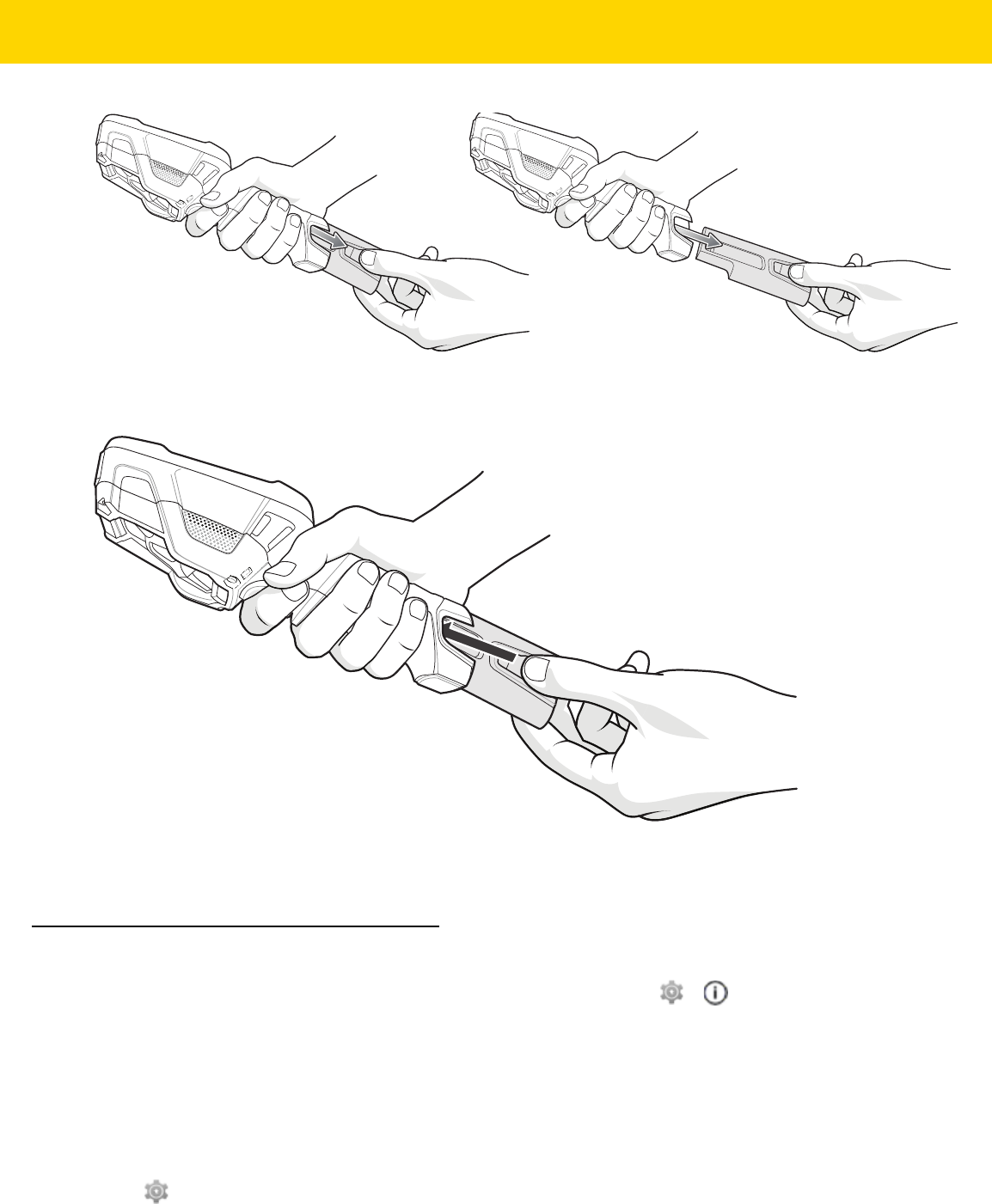
1 - 10 TC8000 User Guide
Figure 1-11 Battery Removal
3. Slide the replacement battery into the handle.
Figure 1-12 Battery Installation
4. Press the battery into the handle until it snaps into place.
Battery Management
To check the charge status of the main battery, on the Home screen touch > About device > Status.
Battery status indicates that the battery is discharging (not charging) and Battery level lists the battery charge (as
a percentage of fully charged).
Monitor Battery Usage
The Battery screen lists which applications consume the most battery power. Also use it to turn off applications that
were downloaded if they are consuming too much power.
Touch > Battery.
Review Copy
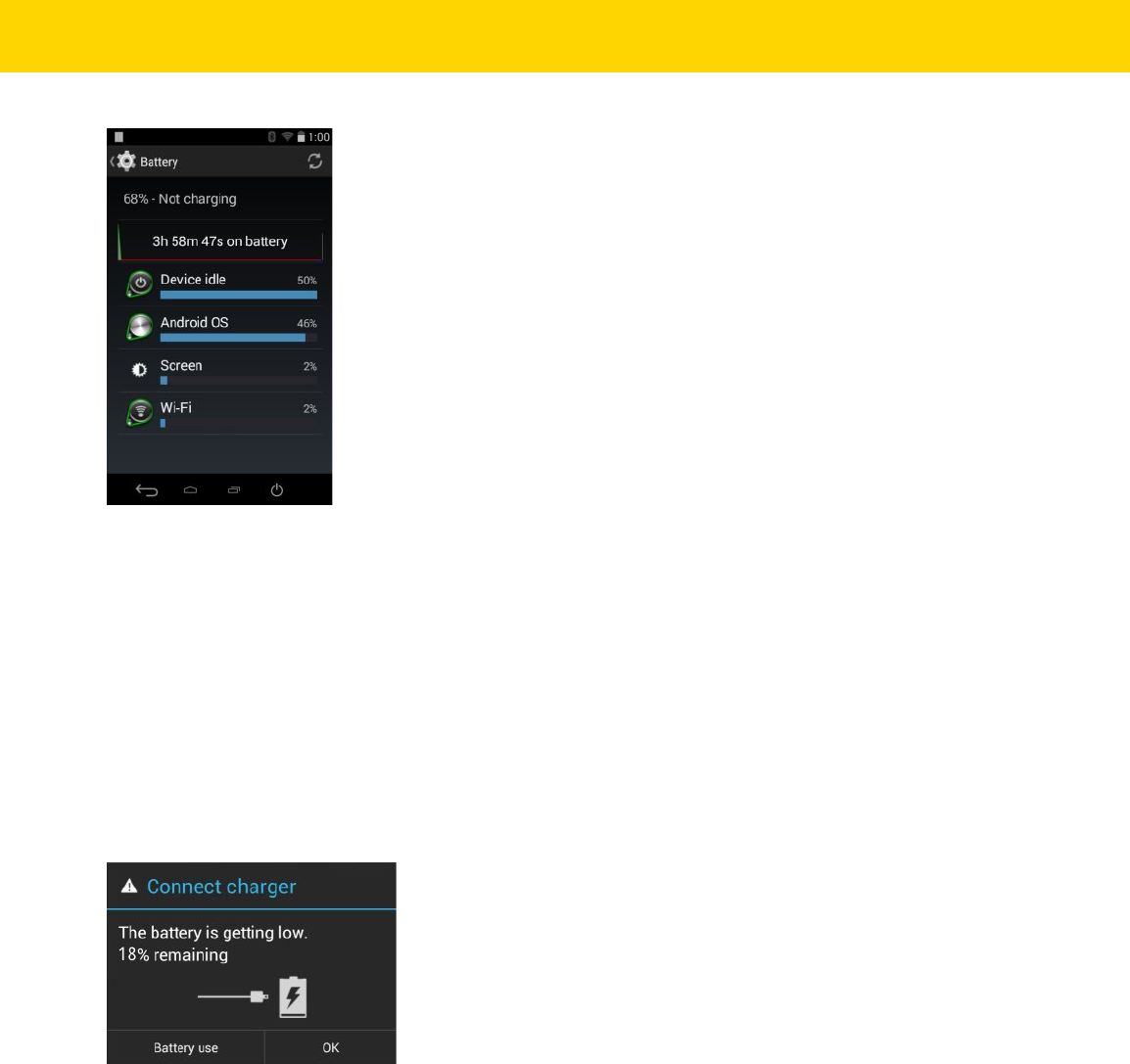
Getting Started 1 - 11
Figure 1-13 Battery Screen
The Battery screen lists the applications using the battery. The discharge graph at the top of the screen shows the
rate of the battery discharge since last charged (short periods of time when connected to a charger are shown as
thin green lines at the bottom of the chart), and how long it has been running on battery power.
Touch an application in the Battery screen to display details about its power consumption. Different applications
display different information. Some applications include buttons that open screens with settings to adjust power
use.
Low Battery Notification
When the battery charge level drops below 15%, the TC8000 displays a notice to connect the TC8000 to power.
Place the TC8000 into a cradle to charge the battery.
Figure 1-14 Low Battery Notification
When the battery charge drops below 10%, the TC8000 displays a notice to connect the TC8000 to power. The
user must charge the battery using one of the charging accessories.
When the battery charge drops below 5%, the TC8000 turns off.
TC8000Place the TC8000 into a cradle to charge the battery.
Battery Optimization
Observe the following battery saving tips:
•
Set the screen to turn off after a short period of non-use. See Setting Screen Timeout Setting on page 1-13.
Review Copy
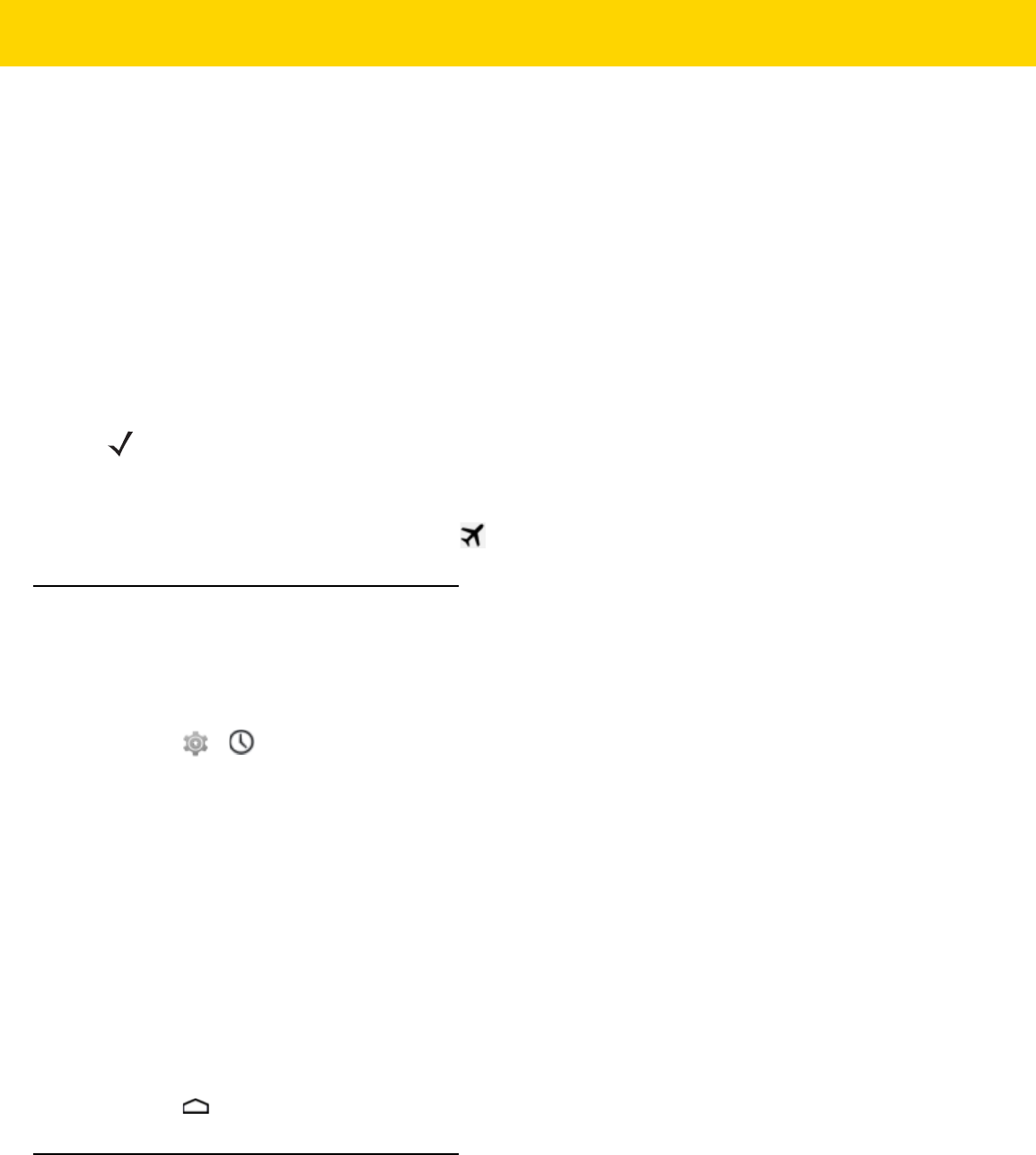
1 - 12 TC8000 User Guide
•
Reduce screen brightness. See Setting the Screen Brightness on page 1-13.
•
Turn off all wireless radios when not in use.
•
Turn off automatic syncing for Email, Calendar, Contacts and other applications.
•
Use the Power Control widget to check and control the status of radios, the screen brightness, and syncing.
•
Minimize use of applications that keep the TC8000 from suspending, for example, music and video
applications.
Turning Off the Radios
To turn off all the radios:
1. Press the power button until the menu appears.
2. Touch Airplane mode. The airplane icon appears in the Status bar indicating that all the radios are off.
Setting the Date and Time
The date and time is automatically synchronized using a NITZ server when the TC8000 is connected to a cellular
network. The user is only required to set the time zone or set the date and time when not connected to a cellular
network.
1. Touch > Date & time.
2. Touch Automatic date & time to disable automatic date and time synchronization.
3. Touch Set date.
4. Move the sliders up and down to select the month, date and year.
5. Touch Done.
6. Touch Set time.
7. Move the sliders up and down to select the hour, minutes and part of the day.
8. Touch Done.
9. Touch Select time zone.
10. Select the current time zone from the list.
11. Touch .
Display Setting
Use Display settings to change the screen brightness, set sleep time and change font size.
NOTE
Alternately, you can place the device into Airplane mode using the Quick Settings option.
Review Copy
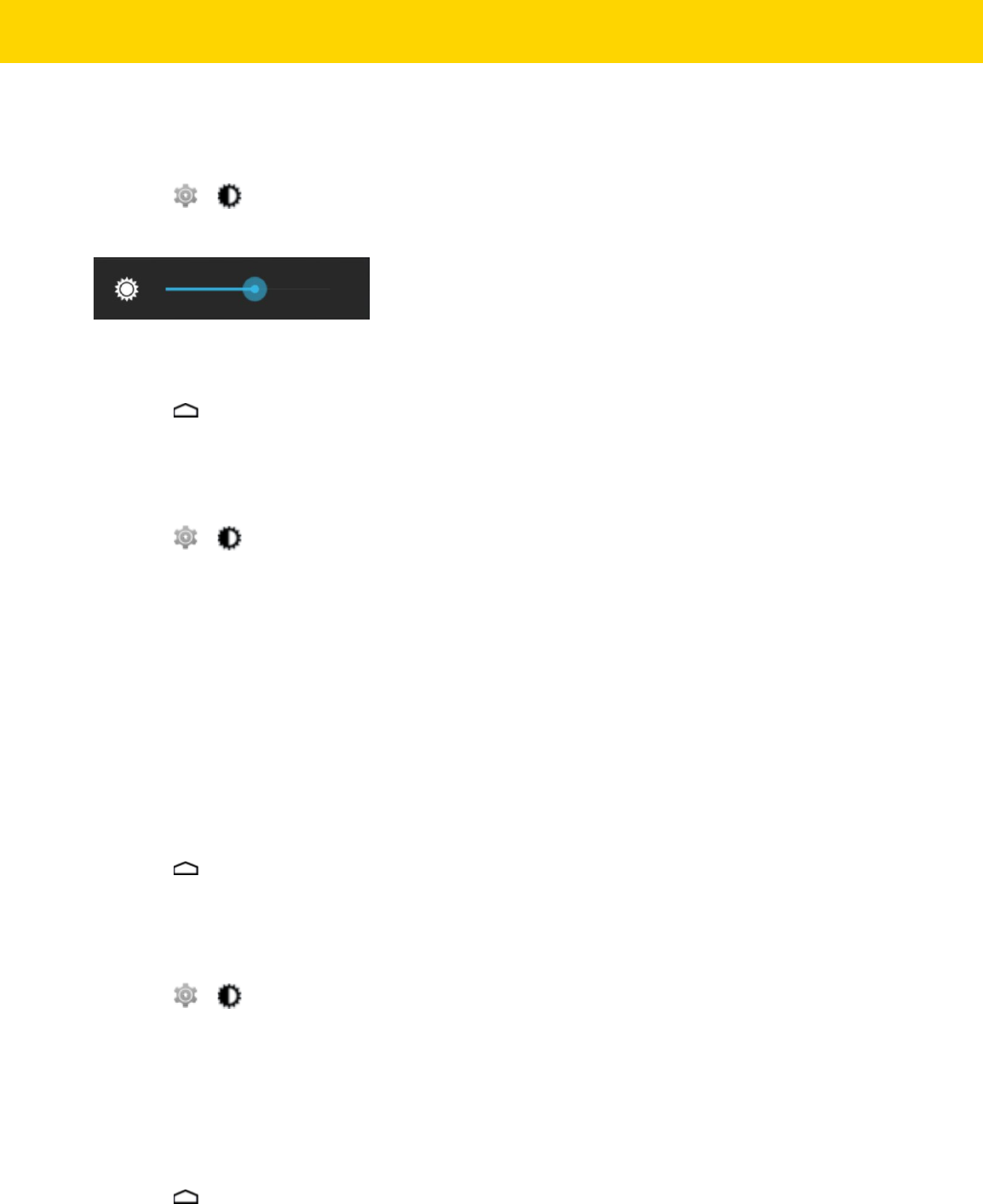
Getting Started 1 - 13
Setting the Screen Brightness
To set the screen brightness:
1. Touch > Display.
2. Touch Brightness.
Figure 1-15 Brightness Dialog Box
3. In the Brightness dialog box, use the slider to set a brightness level.
4. Touch .
Setting Screen Timeout Setting
To set the screen sleep time:
1. Touch > Display > Sleep.
2. Select one of the sleep values.
•
15 seconds
•
30 seconds
•
1 minute
•
2 minutes
•
5 minutes (default)
•
10 minutes
•
30 minutes
•
Never.
3. Touch .
Setting Font Size
To set the size of the font is system applications:
1. Touch > Display > Font size.
2. Select one of the font size values.
•
Small
•
Normal (default)
•
Large
•
Huge.
3. Touch .
Review Copy
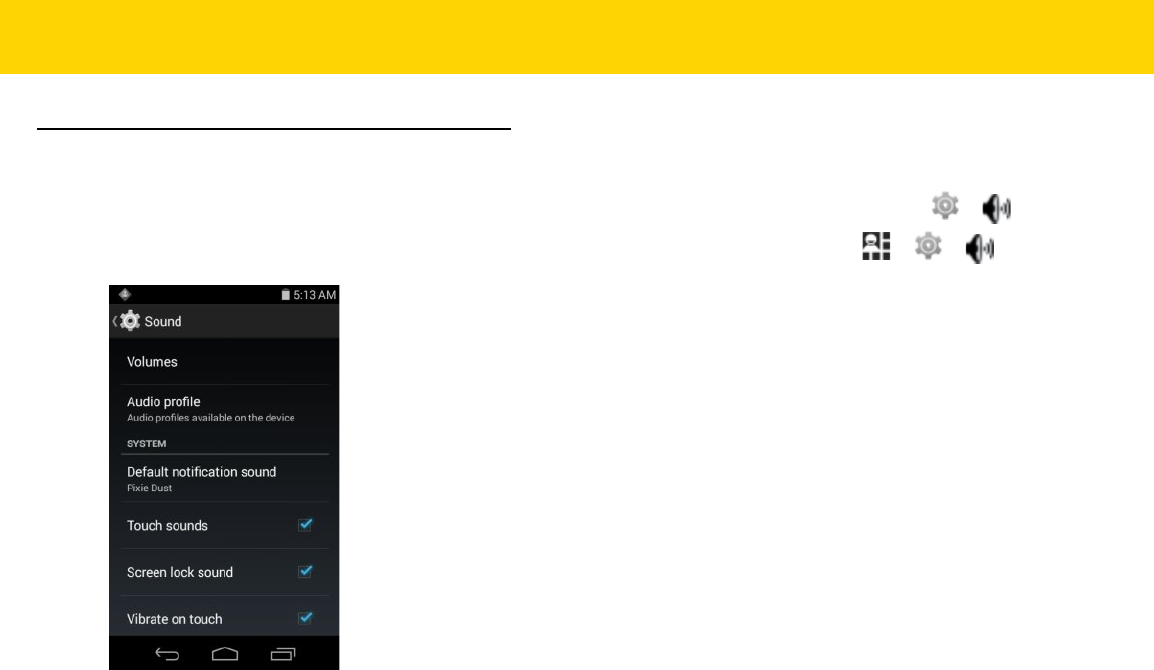
1 - 14 TC8000 User Guide
General Sound Setting
Use the Sounds settings to configure media and alarm volumes. On the Home screen, touch > Sounds.
Alternately, touch the Status bar and drag down to open the Notification panel. Touch > > Sounds.
Figure 1-16 Sounds Screen
•
Volumes – Use to change the volume of media, ringtones, notifications and alarms.
Review Copy
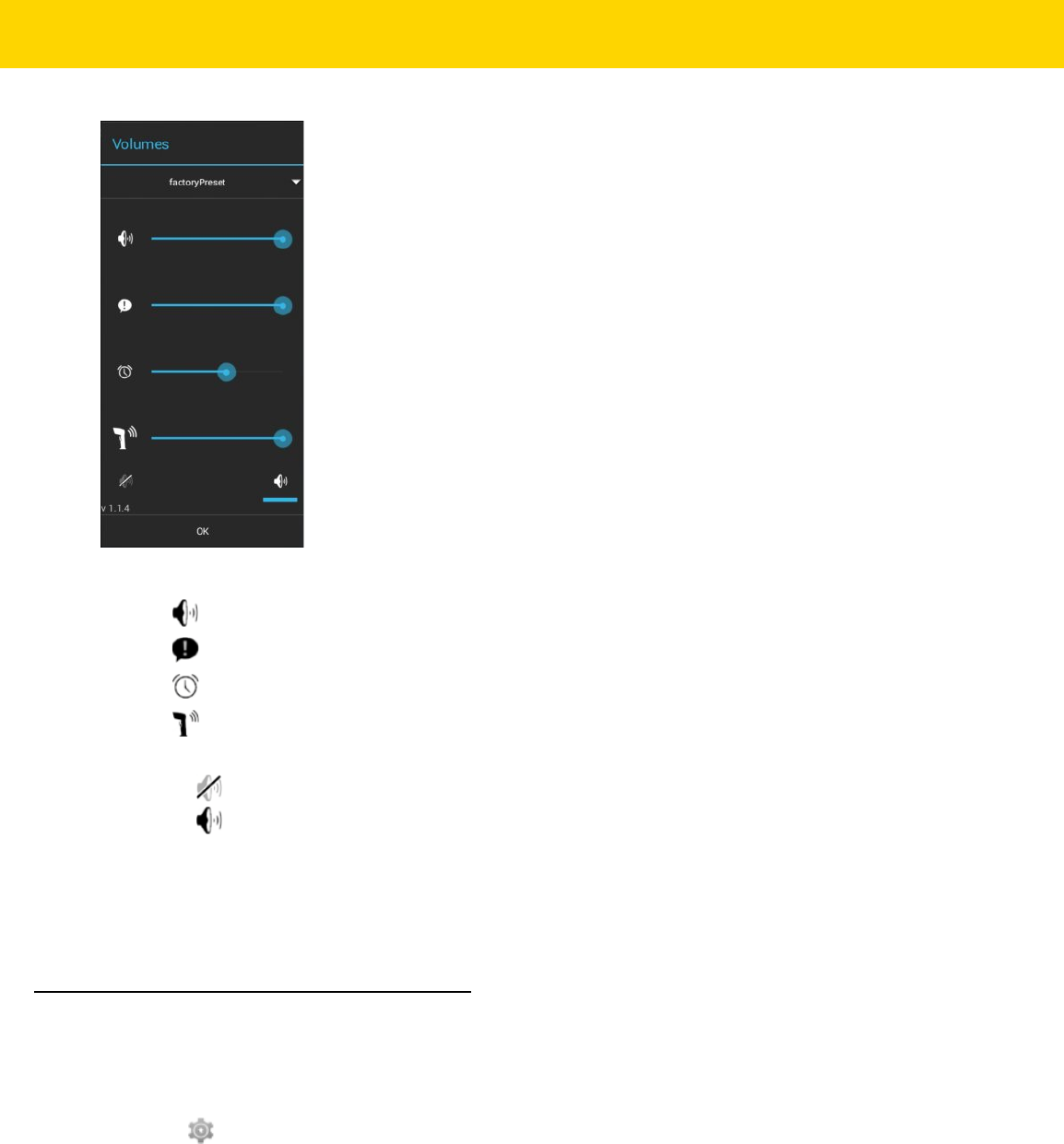
Getting Started 1 - 15
Figure 1-17 Volumes Dialog Box
• - Controls the music and media volume.
• - Controls the system notification volume.
• - Controls the alarm clock volume.
• - Controls the scan good decode beep volume.
•Bottom row icons:
• - Places the system notification in silent mode.
• - Places the system notification in sound mode.
•
System
• Default notification sound - Touch to select a sound to play for all system notifications.
• Touch sounds - Check to play a sound when making screen selections (default – enabled).
• Screen lock sounds- Check to play a sound when locking and unlocking the screen (default – disabled).
Wake-Up Sources
By default the TC8000 wakes from suspend mode when one of the activities in the screen below occurs. The user
can disable any of these wake-up sources.
1. Touch > Wake-Up Sources.
2. Touch a checkbox to enable or disable the source.
Review Copy
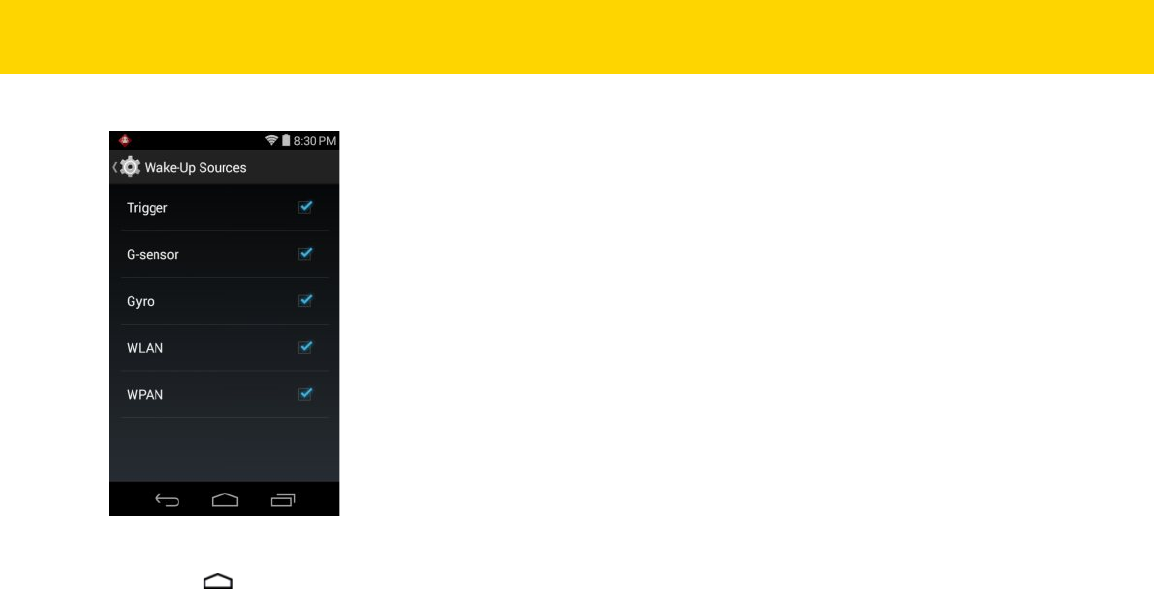
1 - 16 TC8000 User Guide
Figure 1-18 Wake-Up Sources Dialog Box
3. Touch .
Review Copy
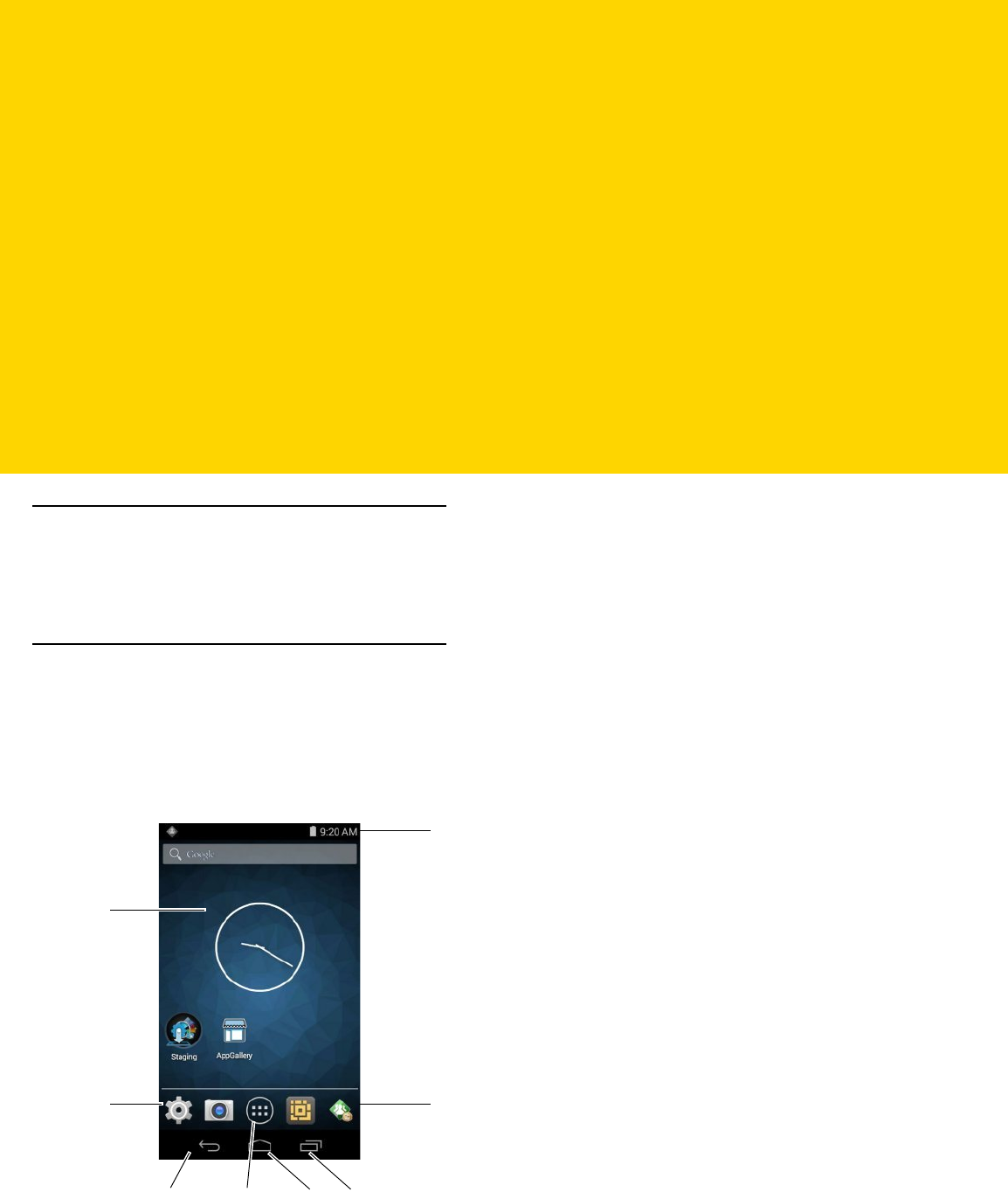
CHAPTER 2 USING THE TC8000
Introduction
This chapter describes the screens, status and notification icons, and controls on the TC8000, and provides basic
instructions for using the TC8000.
Home Screen
The Home screen displays when the TC8000 turns on. Depending upon the configuration, the Home screen might
appear different. Contact your system administrator for more information.
After a suspend or screen time-out, the Home screen displays with the lock sliders. Slide to the right toward to
unlock the screen. For screen locking information see Un-Locking the Screen on page 2-11.
Figure 2-1 Home Screen
1
2
346 5
7
8
Review Copy
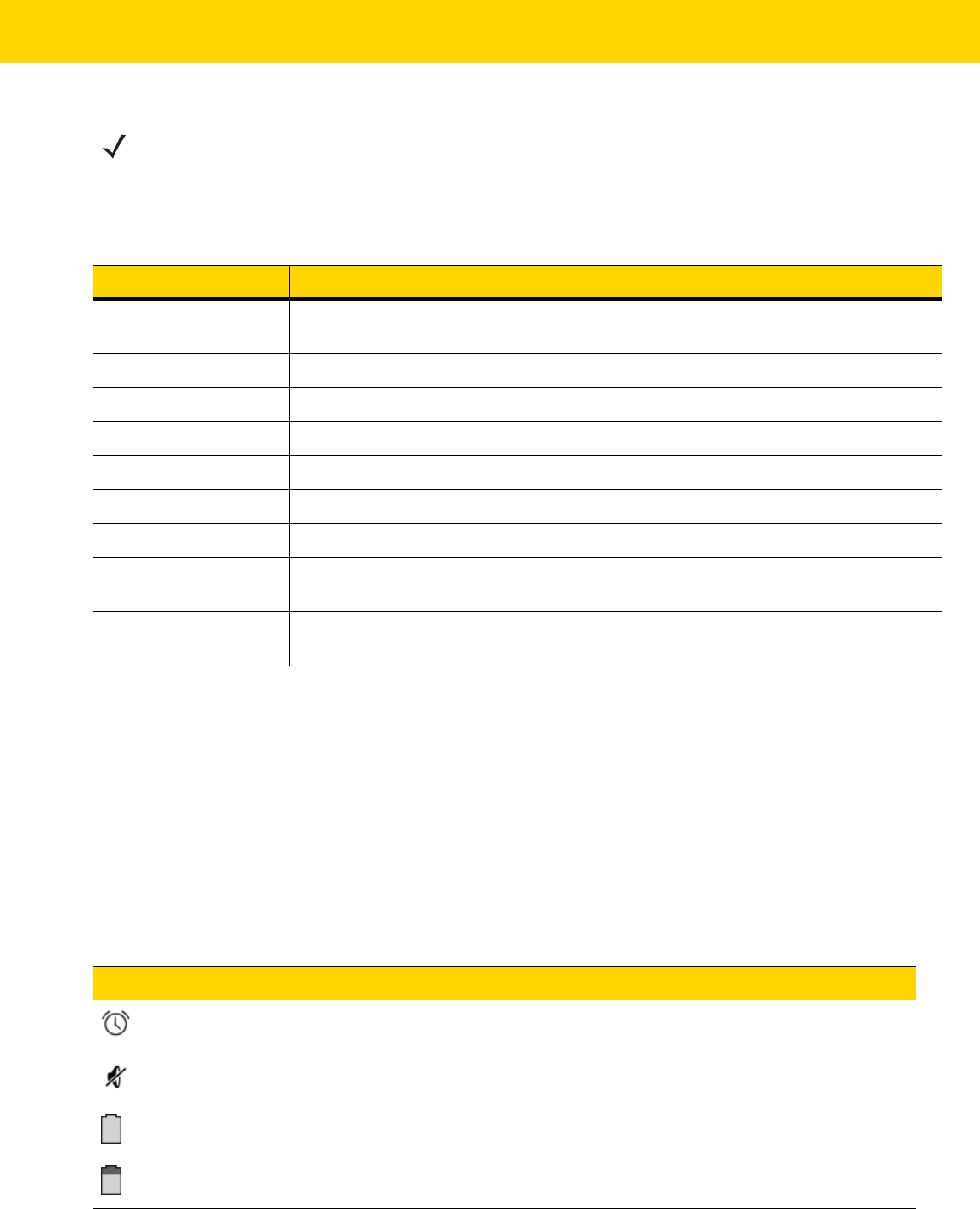
2 - 2 TC8000 User Guide
The Home screen consists of the following:
The Home screen provides four additional screens for placement of widgets and shortcuts. Swipe the screen left or
right to view the additional screens.
Status Bar
The Status bar displays the time, notification icons (left side) and status icons (right side).
If there are more notifications than can fit in the Status bar, displays indicating that more notifications exist. Open
the Notifications panel to view all notifications and status.
Status Icons
NOTE
The Home screen icons can be configured by the user and may look different than shown.
Table 2-1 Home Screen Items
Item Description
1 — Status Bar Displays the time, status icons (right side), and notification icons (left side). For more
information see
Status Icons on page 2-2
and
Managing Notifications on page 2-4
.
2 — PTT Express Icon Opens the PTT Express Client application.
3 — Menu Icon Displays running applications.
4 — Home Icon Displays the Home screen.
5 — All Apps Icon Opens the APPS window.
6 — Back Icon Displays the previous screen.
7 — Settings Icon Opens the Settings window.
8 — Shortcut Icons Opens applications installed on the TC8000. See
Application Shortcuts and Widgets
on page 2-5
for more information.
9 — Widgets Launches stand-alone applications that run on the Home screen. See
Application
Shortcuts and Widgets on page 2-5
for more information.
Table 2-2 Status Icons
Icon Description
Indicates that the Alarm is active.
Indicates that the ringer is silenced.
Indicates that the battery is fully charged.
Indicates that the battery is partially drained.
Review Copy
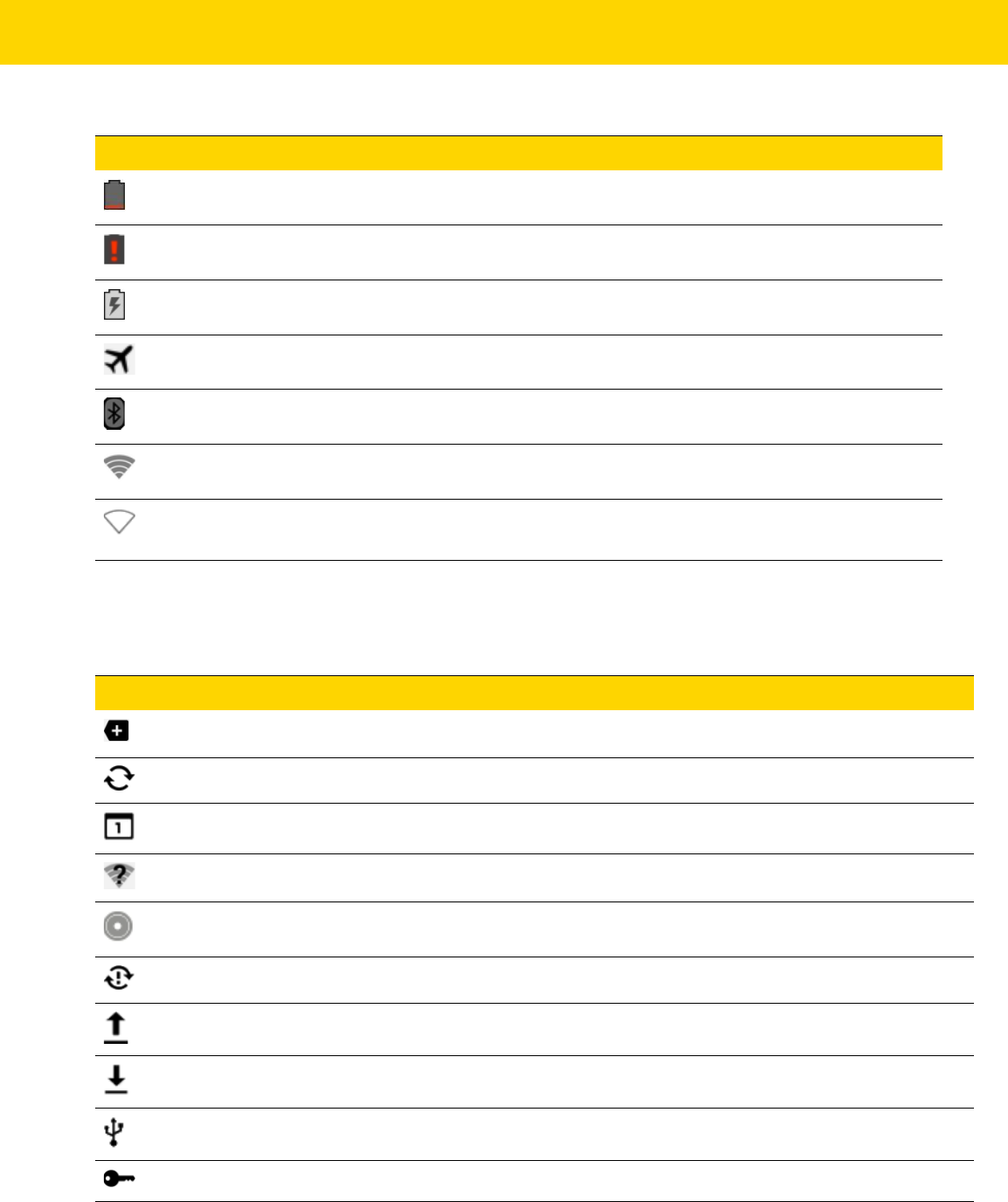
Using the TC8000 2 - 3
Notification Icons
Indicates that the battery charge is low.
Indicates that the battery charge is very low.
Indicates that the battery is charging.
Indicates that the Airplane Mode is active. All radios are turned off.
Indicates that Bluetooth is on.
Connected to a Wi-Fi network.
No Wi-Fi signal.
Table 2-2 Status Icons (Continued)
Icon Description
Table 2-3 Notification Icons
Icon Description
Indicates that more notifications are available for viewing.
Indicates that data is syncing.
Indicates an upcoming event.
Indicates that an open Wi-Fi network is available.
Indicates that a song is playing.
Indicates that a problem with sign-in or sync has occurred.
Indicates that the TC8000 is uploading data.
Indicates that the TC8000 is downloading data when animated and download is complete when static.
Indicates that the TC8000 is connected via USB cable.
Indicates that the TC8000 is connected to or disconnected from virtual private network (VPN).
Review Copy
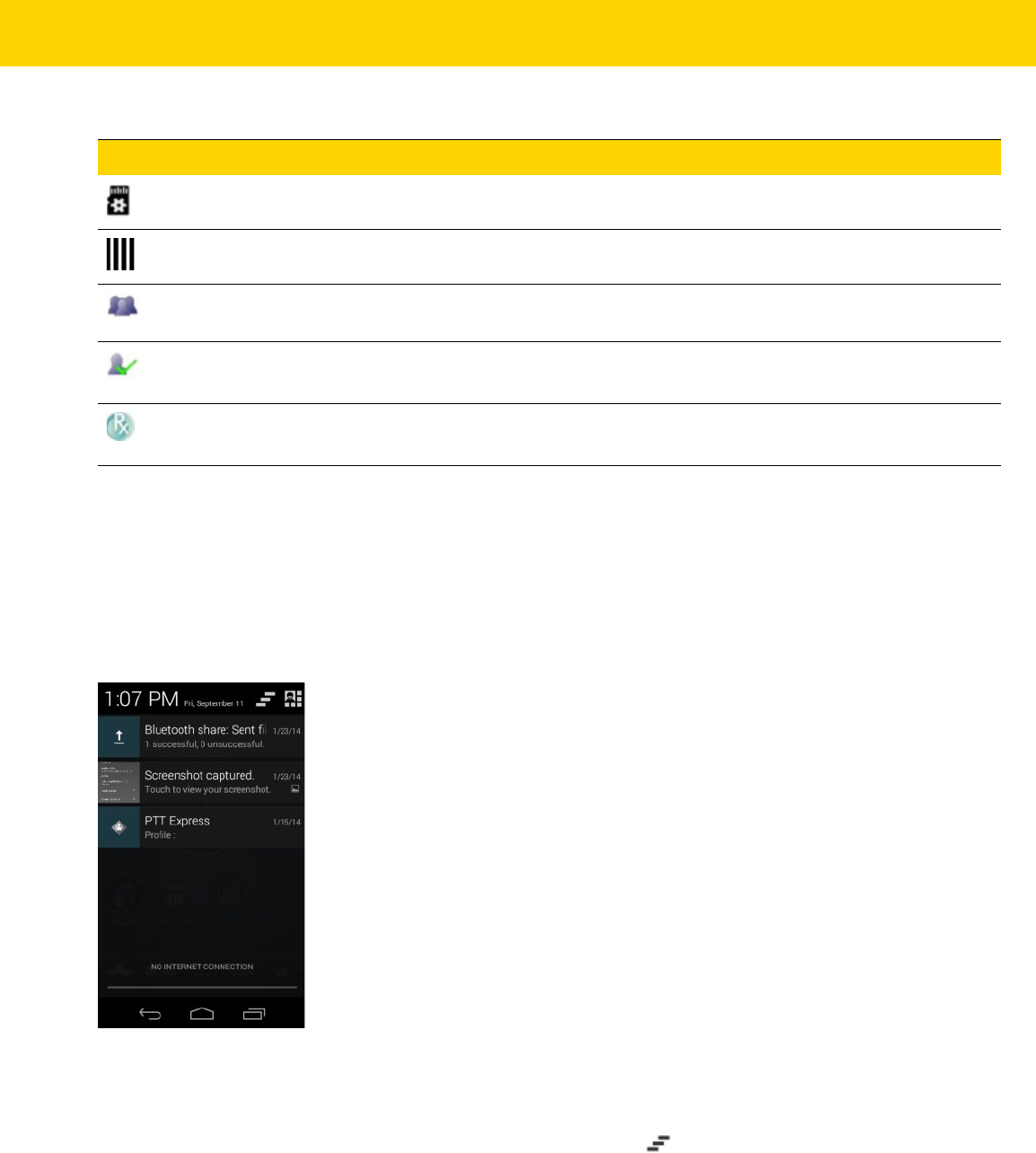
2 - 4 TC8000 User Guide
Managing Notifications
Notification icons report the arrival of new messages, calendar events, and alarms, as well as ongoing events.
When a notification occurs, an icon appears in the Status bar with a brief description. See Notification Icons on
page 2-3 for a list of possible notification icons and their description. Open the Notifications panel to view a list of all
the notifications.
To open the Notification panel, drag the Status bar down from the top of the screen.
Figure 2-2 Notification Panel
To respond to a notification, open the Notifications Panel and then touch a notification. The Notifications Panel
closes and the subsequent activity is dependent on the notification.
To clear all notifications, open the Notifications Panel and then touch . All event-based notifications are
removed.
Ongoing notifications remain in the list.
To close the Notification Panel, drag the bottom of the Notifications Panel to the top of the screen or press.
Preparing Internal Storage.
Indicates that USB debugging is enabled on the TC8000.
Indicates that the MultiUser feature is enabled. Appears only when MultiUser Administrator application
is installed.
Indicates that a new user is logging in. Appears only when MultiUser Administrator application is
installed.
Indicates that the RxLogger application is running and capturing data.
Table 2-3 Notification Icons (Continued)
Icon Description
Review Copy
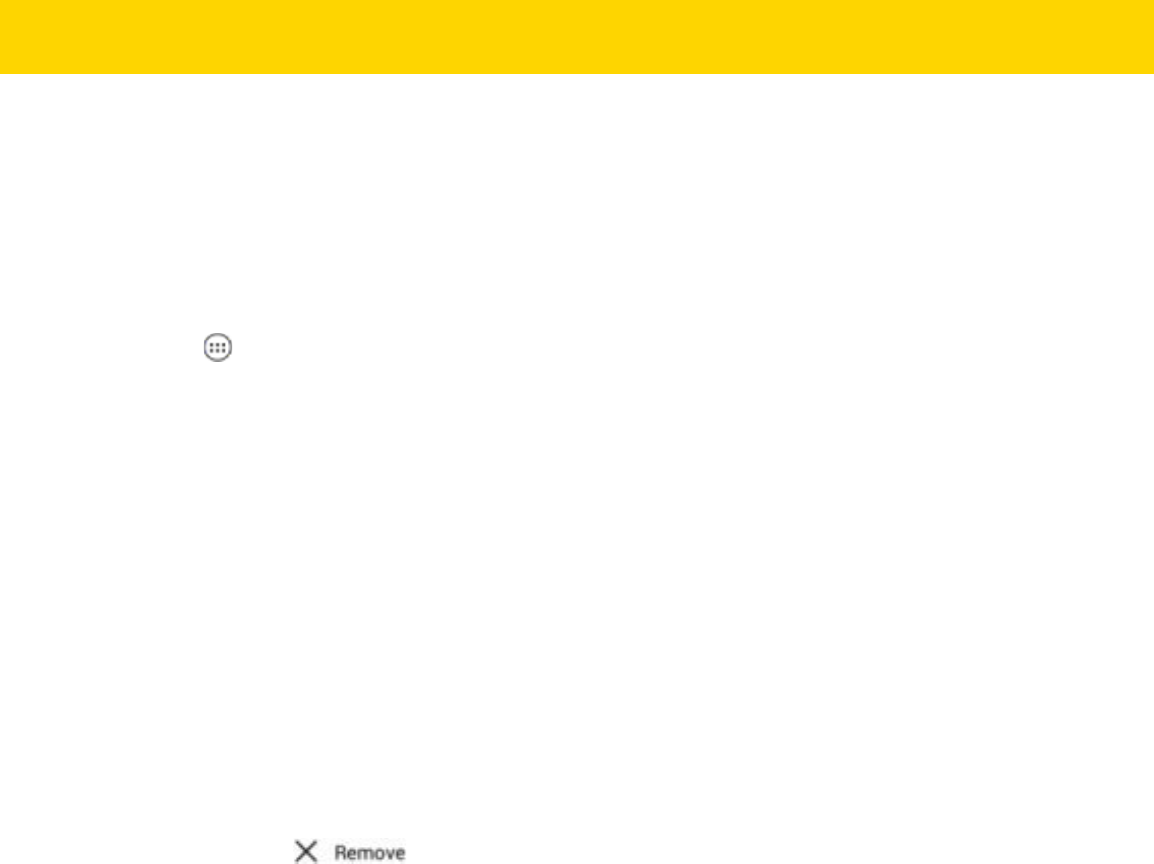
Using the TC8000 2 - 5
Application Shortcuts and Widgets
Application shortcuts placed on the Home screen allow quick and easy access to applications. Widgets are
self-contained applications placed on the Home screen to access frequently used features.
Adding an Application or Widget to the Home Screen
1. Go to the desired Home screen.
2. Touch .
3. Swipe right, if necessary, to find the application icon or widget.
4. Touch and hold the icon or widget until the Home screen appears.
5. Position the icon on the screen and then release.
Moving Items on the Home Screen
1. Touch and hold the item until it floats on the screen.
2. Drag the item to a new location. Pause at the edge of the screen to drag the item onto an adjacent Home
screen.
3. Lift finger to place the item on the Home screen.
Removing an App or Widget from the Home Screen
1. Go to the desired Home screen.
2. Touch and hold the application shortcut or widget icon until it floats on the screen.
3. Drag the icon to on the top of the screen and then release.
Folders
Use Folders to organize similar applications together. Tap the folder to open and display items in the folder.
Creating a Folder
To create a folder, there must be at least two app icons on the Home screen.
1. Go to the desired Home screen.
2. Touch and hold on one application icon.
3. Drag the icon and stack on top of another icon.
4. Lift and release.
Naming Folders
1. Touch the folder.
Review Copy
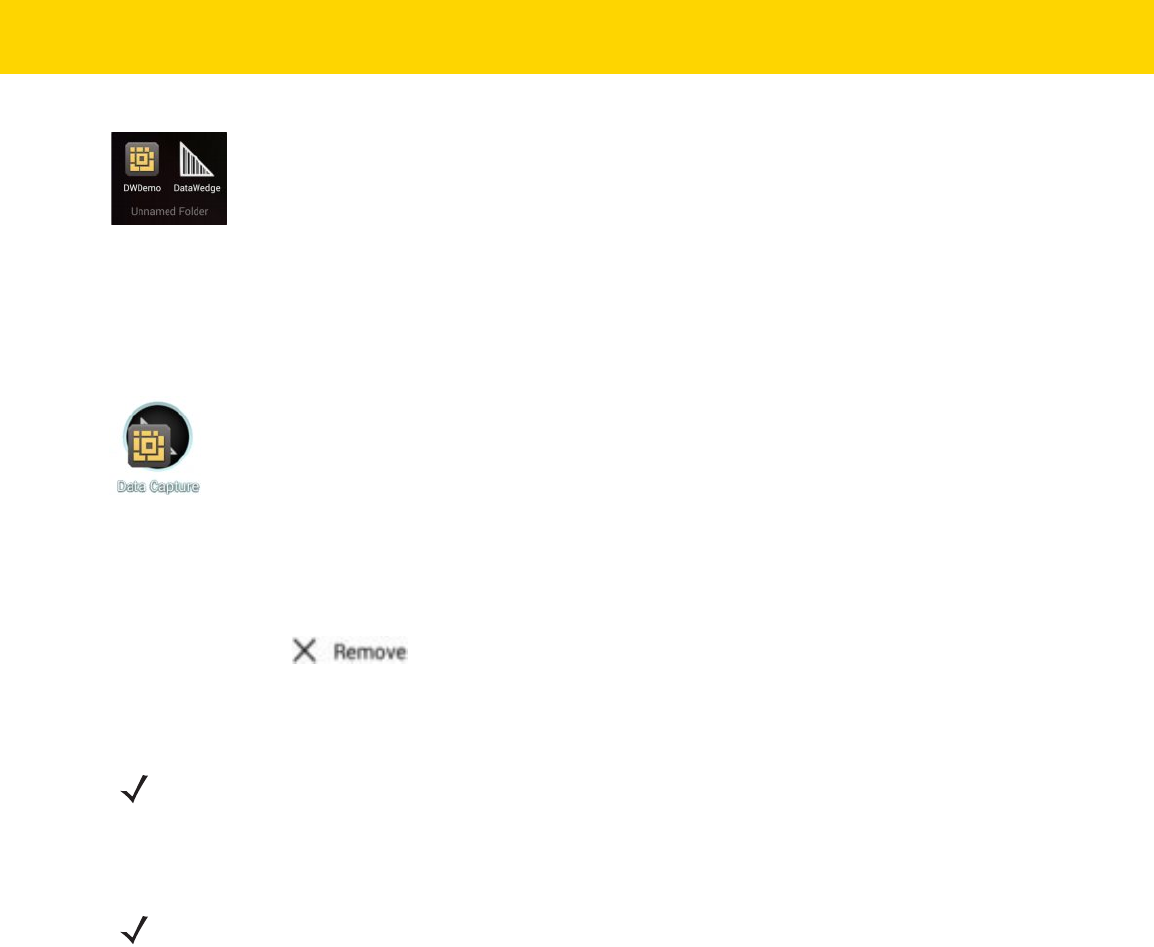
2 - 6 TC8000 User Guide
Figure 2-3 Open Folder
2. Touch the title area and enter a folder name using the keyboard.
3. Touch Done.
4. Touch anywhere on the Home screen to close the folder. The folder name appears under the folder.
Figure 2-4 Renamed Folder
Removing a Folder
1. Touch and hold the folder icon until it enlarges.
2. Drag the icon to and release.
Home Screen Wallpaper
Changing the Home Screen Wallpaper
1. Touch and hold the desktop until the menu appears.
2. From the Choose wallpaper from menu, touch Gallery, Live wallpapers or Wallpapers.
•
Gallery - Select to use an image stored on the device.
•
Live wallpapers - Select to use an animated wallpaper image.
•
Wallpapers - Select to use a wallpaper image.
3. Touch Save or Set wallpaper.
Using the Touchscreen
Use the multi-tap sensitive screen to operate the device.
•
Tap -Tap to:
•select items on the screen
•type letters and symbols using the on-screen keyboard
•press on-screen buttons.
NOTE
Use of Live Wallpaper may reduce battery life.
NOTE
Use of Live Wallpaper may reduce battery life.
Review Copy
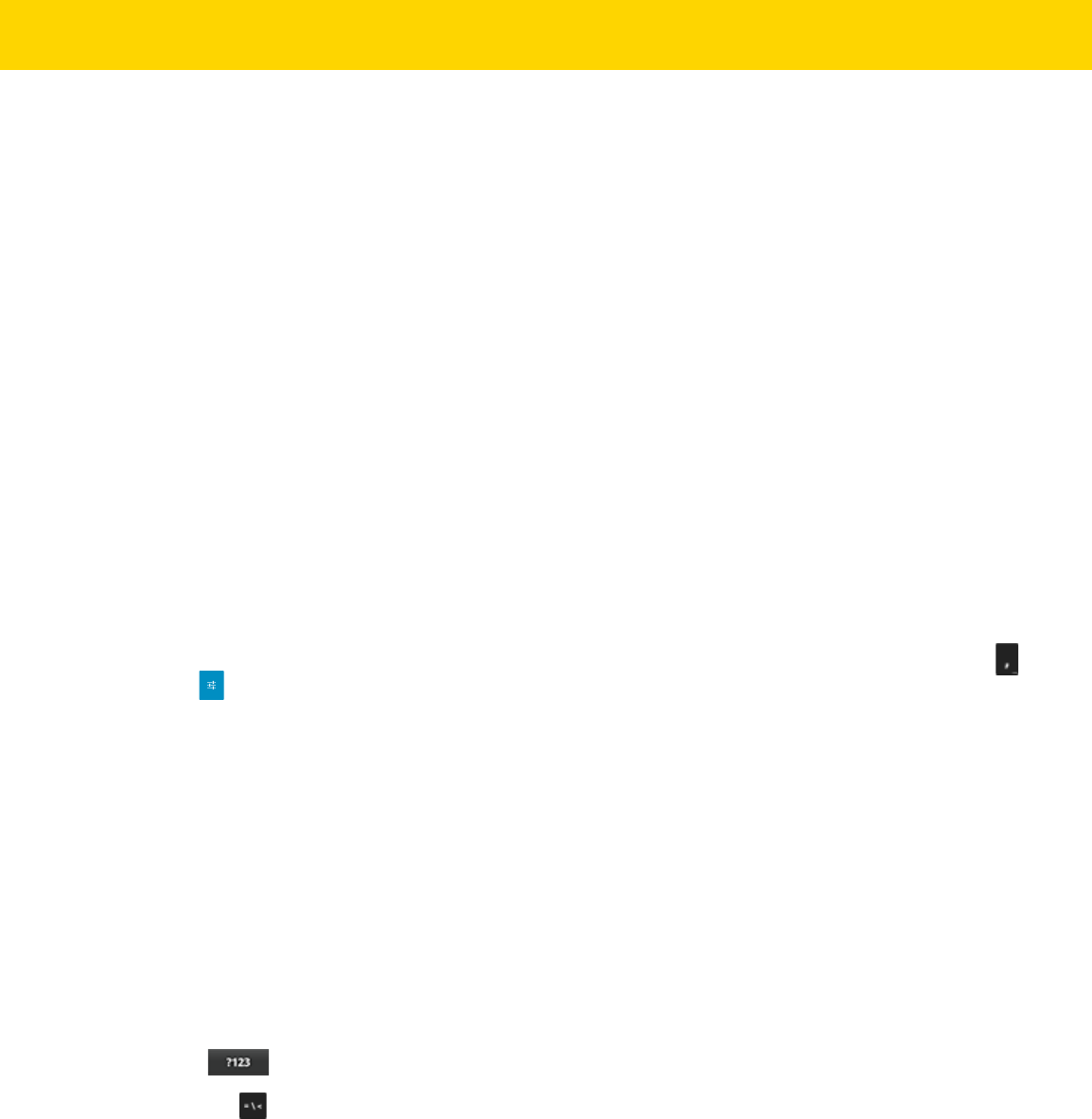
Using the TC8000 2 - 7
•
Tap and Hold - Tap and hold:
•an item on the Home screen to move it to a new location or to the trash.
•an item in Apps to create a shortcut on the Home screen.
•the Home screen to open a menu for customizing the Home screen.
•an empty area on the Home screen until the menu appears.
•
Drag - Tap and hold an item for a moment and then move finger on the screen until reaching the new
position.
•
Swipe - Move finger up and down or left and right on the screen to:
•unlock the screen
•view additional Home screens
•view additional application icons in the Launcher window
•view more information on an application’s screen.
•
Double-tap - Tap twice on a web page, map, or other screen to zoom in and out.
•
Pinch - In some applications, zoom in and out by placing two fingers on the screen and pinching them
together (to zoom out) or spreading them apart (to zoom in).
Using the On-screen Keyboard
Use the on-screen keyboard to enter text in a text field. To configure the keyboard settings, touch and hold
(comma) > and then select Android keyboard settings.
Editing Text
Edit entered text and use menu commands to cut, copy, and paste text within or across applications. Some
applications do not support editing some or all of the text they display; others may offer their own way to select text.
Entering Numbers, Symbols and Special Characters
To enter numbers and symbols:
•
Touch and hold one of the top-row keys until a menu appears then select a number. Keys with alternate
characters display an ellipsis ( ... ) below the character.
•
Touch and hold the Shift key with one finger, touch one or more capital letters or symbols to enter them, and
then lift both fingers to return to the lowercase keyboard.
•
Touch to switch to the numbers and symbols keyboard.
•
Touch the key on the numbers and symbols keyboard to view additional symbols.
To enter special characters, touch and hold a number or symbol key to open a menu of additional symbols.
•
A larger version of the key displays briefly over the keyboard.
•
Keys with alternate characters display an ellipsis ( ... ) below the character.
Review Copy
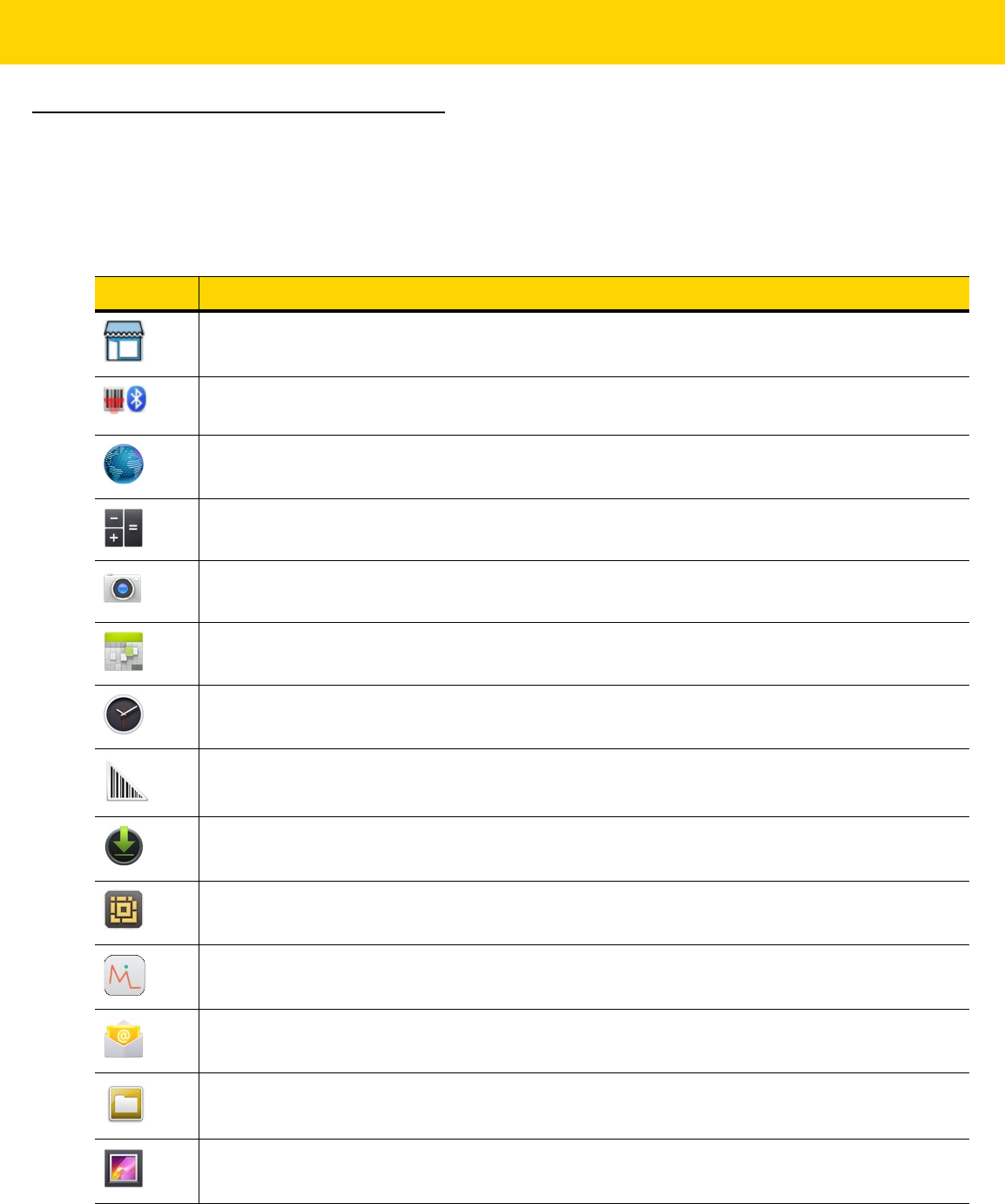
2 - 8 TC8000 User Guide
Applications
The APPS screen displays icons for all installed applications. The table below lists the applications installed on the
TC8000. Refer to the TC8000 Integrator Guide for information on installing and uninstalling application.
Table 2-4 Applications
Icon Description
App Gallery
- Provides links to utilities and demonstration applications that can be installed on the
TC8000.
Bluetooth Pairing Utility
– Use to pair the RS507 Hans-free Imager with the TC8000 by scanning a
bar code.
Browser
- Use to access the Internet or intranet.
Calculator
- Provides the basic and scientific arithmetic functions.
Camera
- Take photos or record videos.
Calendar
- Use to manage events and appointments.
Clock
- Use to schedule alarms for appointments or as a wake-up.
DataWedge
- Enables data capture using the imager.
Downloads
- Lists all downloads files.
DWDemo
- Provides a way to demonstrate the data capture features using the imager. See
DataWedge Demonstration on page 5-18
for more information.
elemez
- Use to provide diagnostic information. See
Elemez on page 5-22
for more information.
Email
- Use to send and receive email.
File Browser
- Organize and manage files on the TC8000. See
File Browser on page 5-1
for more
information.
Gallery
- Use to view photos stored on the device. For more information, see
Gallery on page 5-12
for more information.
Review Copy
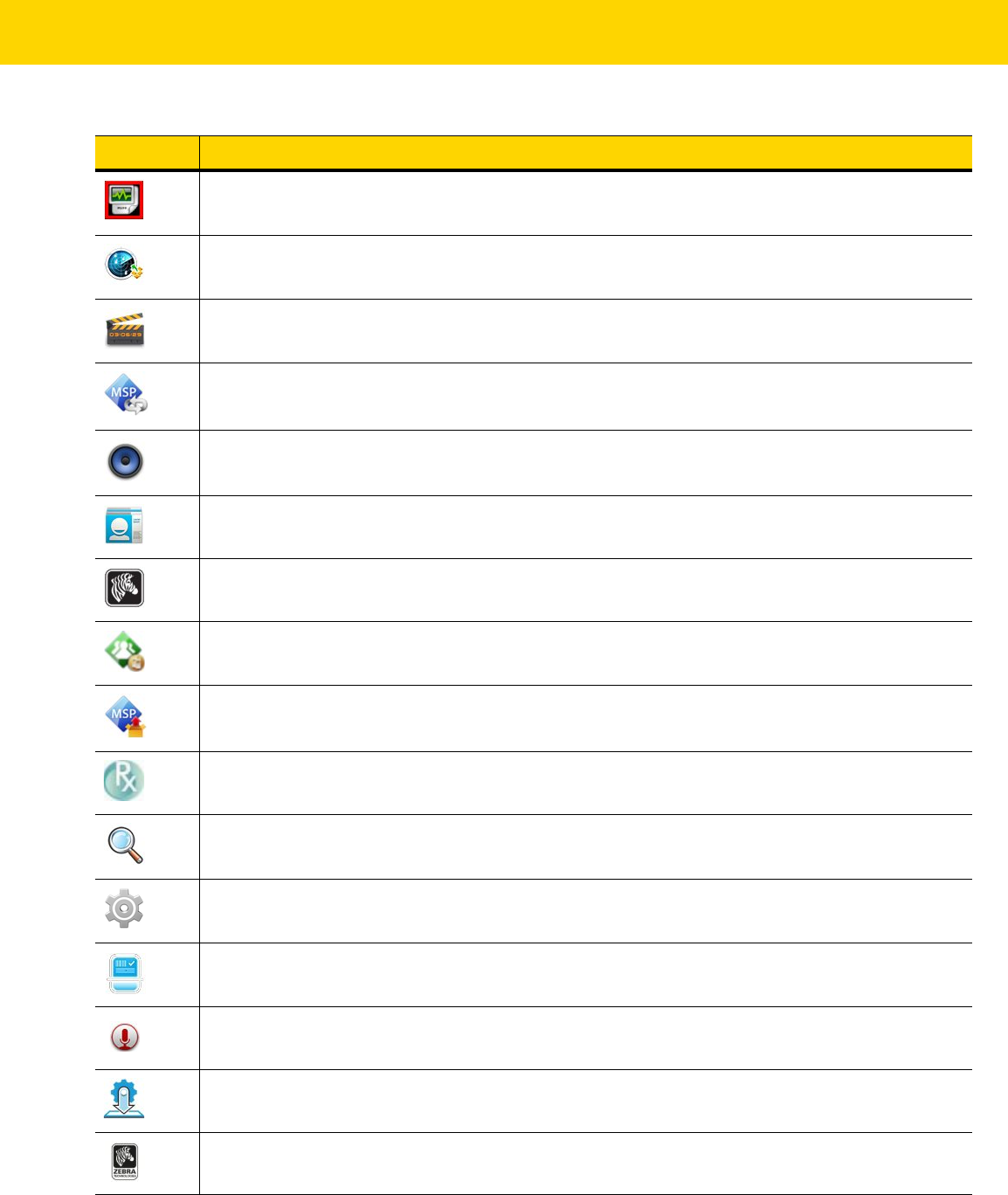
Using the TC8000 2 - 9
MLog Manager
- Use to capture log files for diagnostics. See
MLog Manager on page 5-19
for more
information.
Mobi Control Stage
– Opens the
Mobi Control Stage
application to stage the device.
Movie Studio
- Create movie videos.
MSP Agent
- Enables management of the TC8000 from an MSP server. Requires the purchase of an
appropriate MSP client license per device to suit the level of management functionality required.
Music
- Play music stored on the device.
People
- Use to manage contact information.
People on page 5-3
for more information.
Print Station
- Use to print labels and receipts directly to a Zebra ZPL printer via USB, Bluetooth or
WLAN.
PTT Express
- Use to launch PTT Express client for VoIP communication.
Rapid Deployment
- Allows the TC8000 to stage a device for initial use by initiating the deployment of
settings, firmware and software. Requires the purchase of an MSP client license per device.
RxLogger
- Use to diagnose device and application issues. See the TC8000 Integrator Guide for
more information.
Search
- Use the Google search engine to search the Internet and the TC8000.
Settings
- Use to configure the TC8000.
SimulScan Demo
- Use to demonstrate the document capture feature of the TC8000.
Sound Recorder
- Use to record audio.
StageNow
- Allows the TC8000 to stage a device for initial use by initiating the deployment of
settings, firmware and software.
Zebra Tap & Pair
- Use to pair the TC8000 with a Zebra Bluetooth printer.
Table 2-4 Applications (Continued)
Icon Description
Review Copy
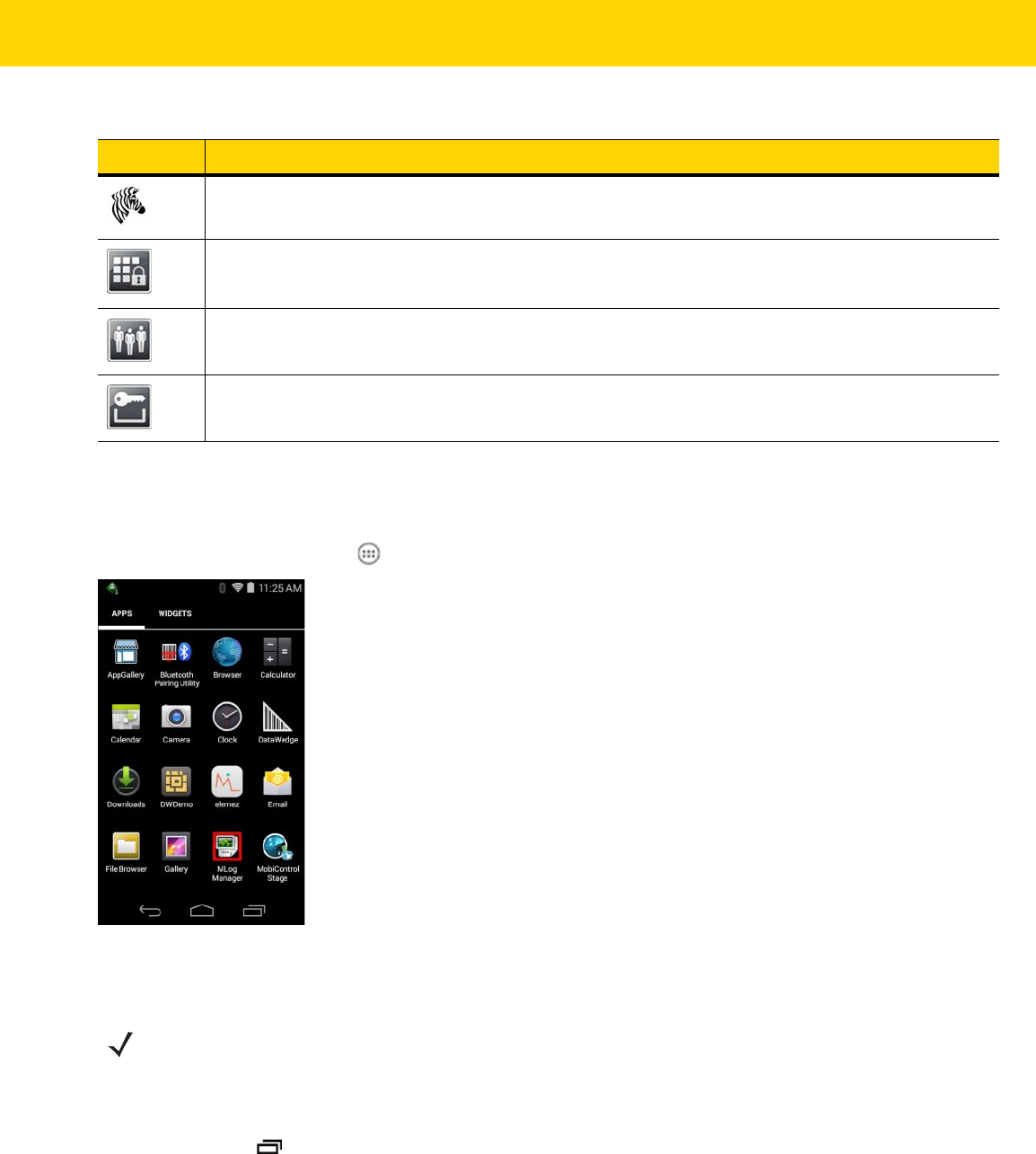
2 - 10 TC8000 User Guide
Accessing Applications
All applications installed on the device are accessed using the APPS window.
1. On the Home screen, touch .
Figure 2-5 APPS Window
2. Slide the APPS window left or right to view more application icons. Touch an icon to open the application.
Switching Between Recent Applications
1. Touch and hold . A window appears on the screen with icons of recently used applications.
Zebra Utilities
- Use to print bar code labels and receipts directly to a Zebra printer via Bluetooth or
WLAN.
AppLock Administrator
- Use to configure the Application Lock feature. This icon appears after the
optional application is installed.
MultiUser Administrator
- Use to configure the MultiUser feature. This icon appears after the
optional application is installed.
Secure Storage Administrator
- Use to configure the Secure Storage feature. This icon appears
after the optional application is installed.
Table 2-4 Applications (Continued)
Icon Description
NOTE
See Application Shortcuts and Widgets on page 2-5 for information on creating a shortcut on
the Home screen.
Review Copy
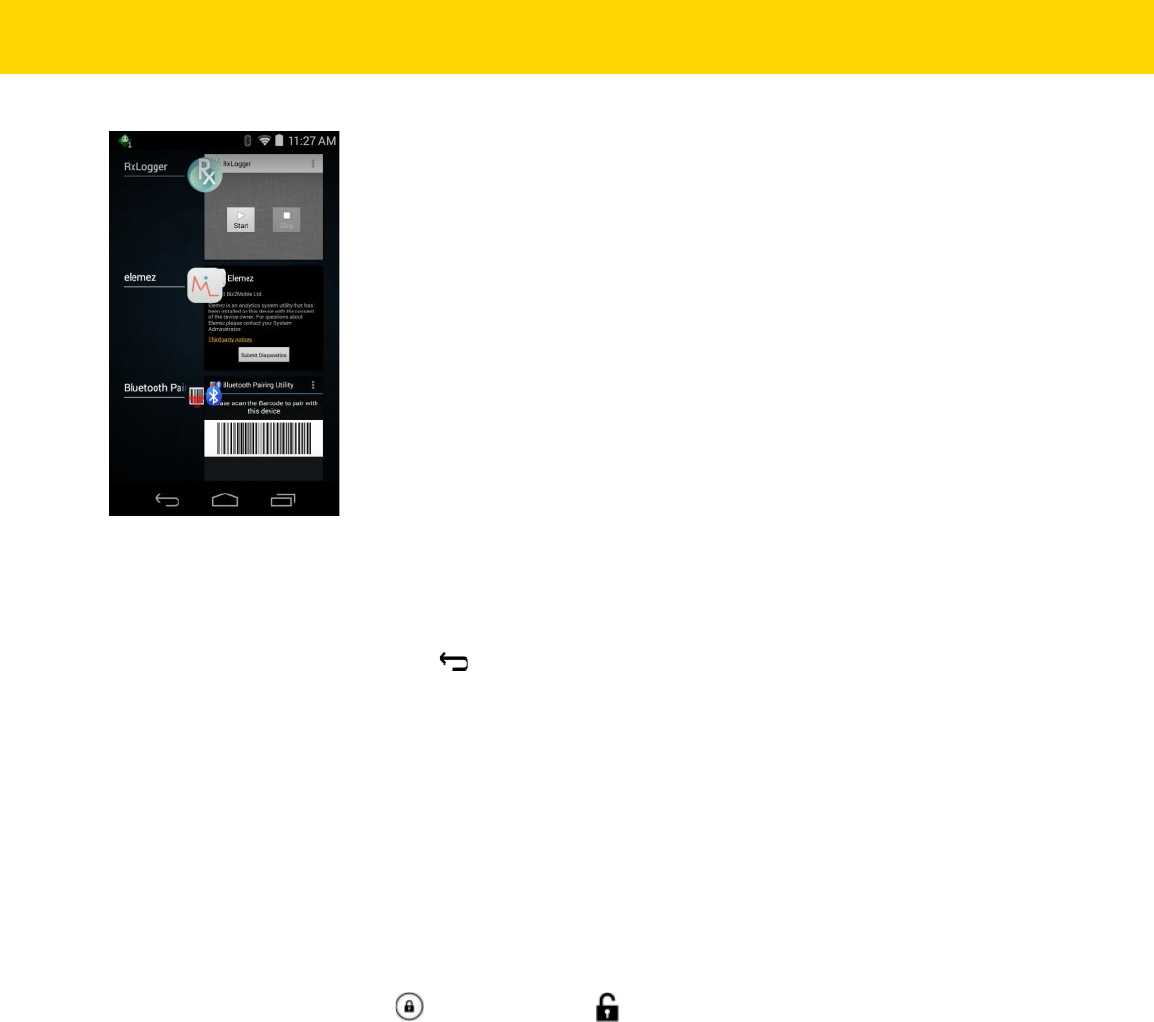
Using the TC8000 2 - 11
Figure 2-6 Recently Used Applications
2. Slide the window up and down to view all recently used applications.
3. Swipe left or right to remove application from the list and force close the application.
4. Touch an icon to open it or touch to return to the current screen.
Un-Locking the Screen
Use the Lock screen to protect access to data on the TC8000. Some email account require locking the screen. See
Chapter 11, Settings for information on setting up the locking feature. The Locking feature functions differently in
Single User mode or Multiple User mode.
Single User Mode
When locked, a pattern, PIN or password is required to unlock the device. Press the Power button to lock the
screen. The device also locks after a pre-defined time-out.
Press and release the Power button to wake the device.
The Lock screen displays. Slide to the right toward to unlock the screen.
If the Pattern screen unlock feature is enabled, the Pattern screen appears instead of the Lock screen.
If the PIN or Password screen unlock feature is enabled, enter the PIN or password after unlocking the screen.
Review Copy
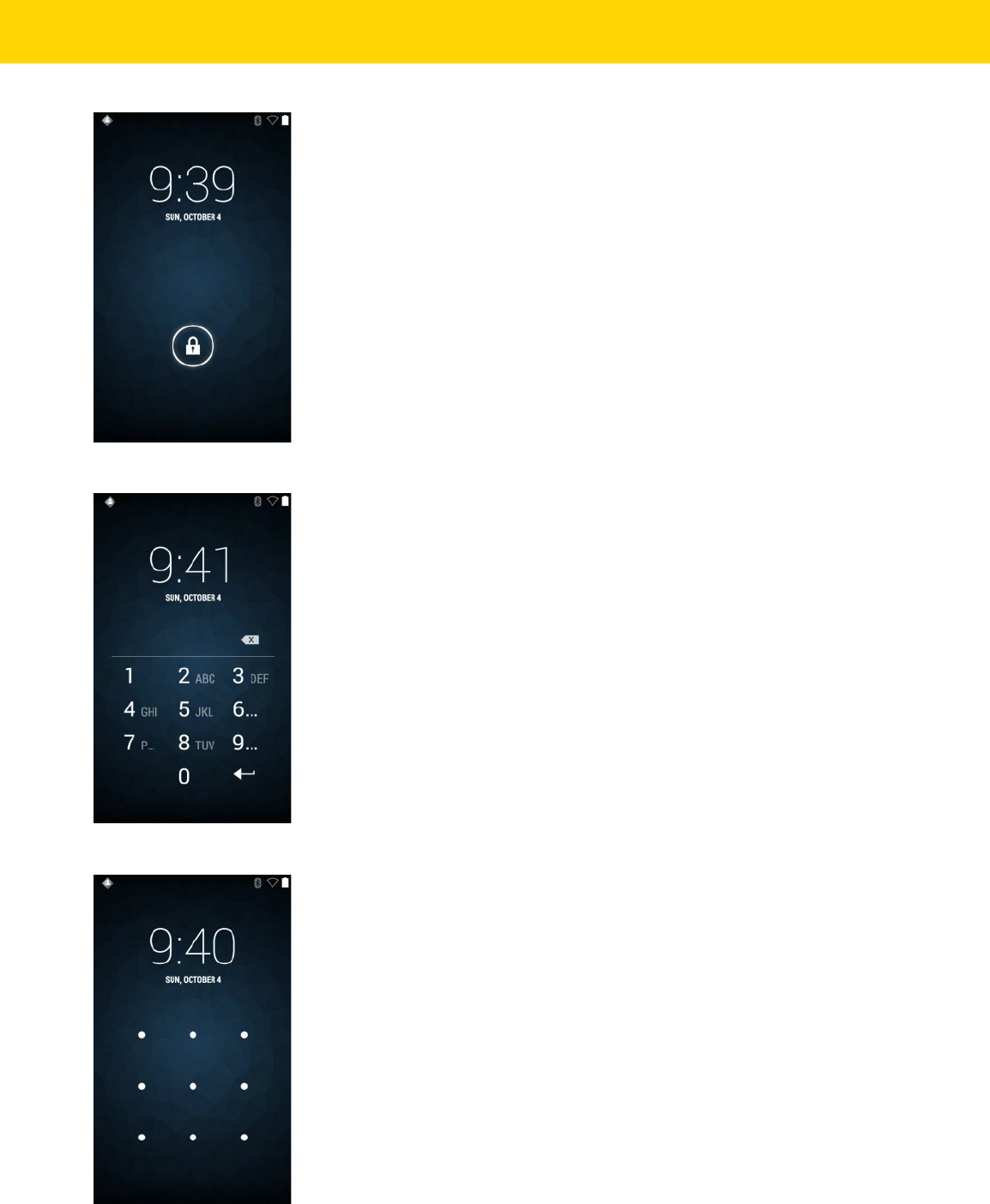
2 - 12 TC8000 User Guide
Figure 2-7 Lock Screen
Figure 2-8 PIN Screen
Figure 2-9 Pattern Screen
Review Copy
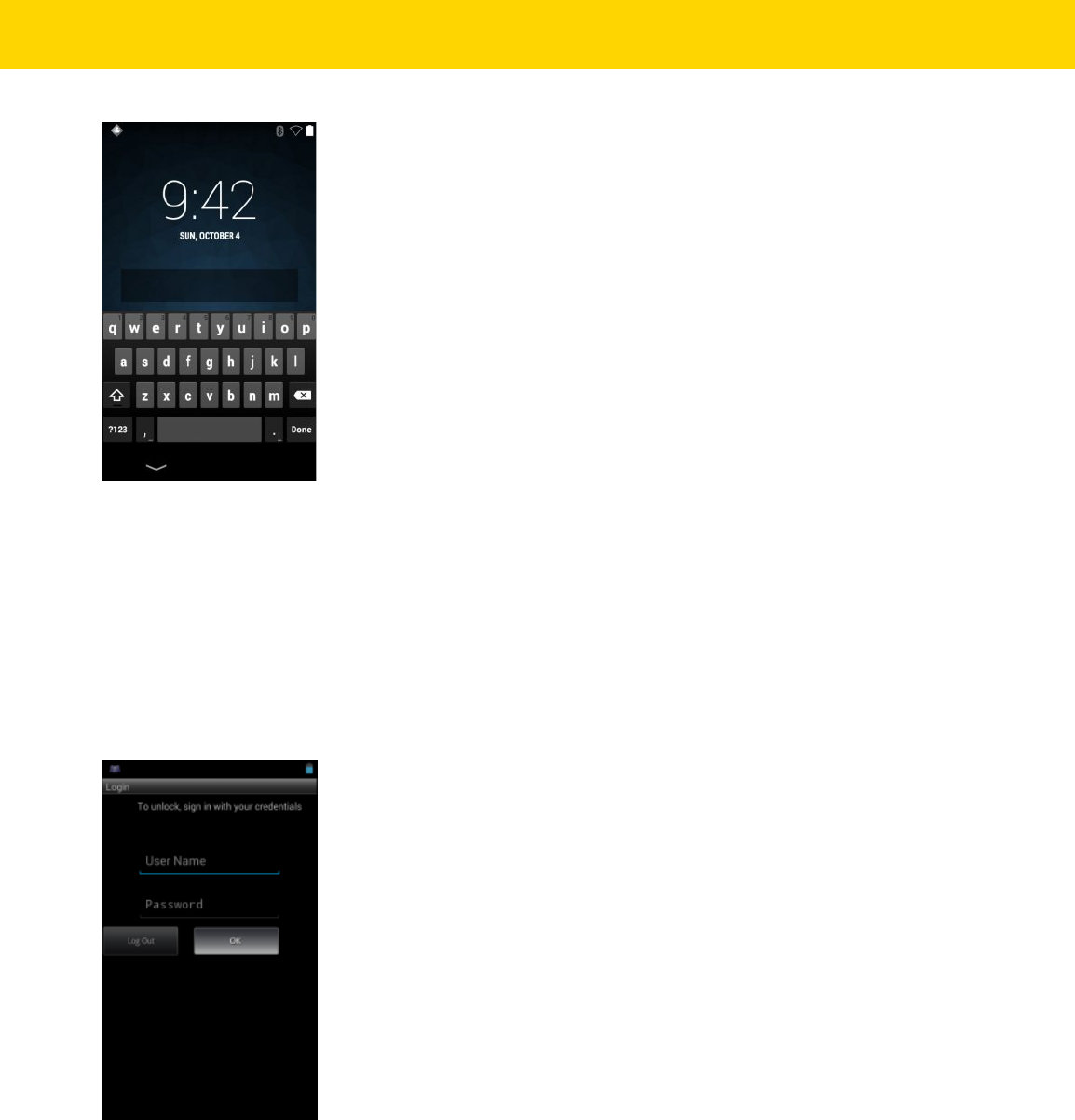
Using the TC8000 2 - 13
Figure 2-10 Password Screen
MultiUser Mode
With MultiUser login, multiple users can log on to the device with each user having access to various applications
and features. When enabled, the Login screen appears after powering on, resetting or after the device wakes from
suspend mode.
MultiUser Login
1. In the Login text field, enter the username.
Figure 2-11 Multiple User Log In Screen
2. In the Password text field, enter the password.
3. Touch OK. After a resume from suspend, the user must enter the password.
MultiUser Logout
1. Drag the Status Bar down from the top of the screen.
Review Copy
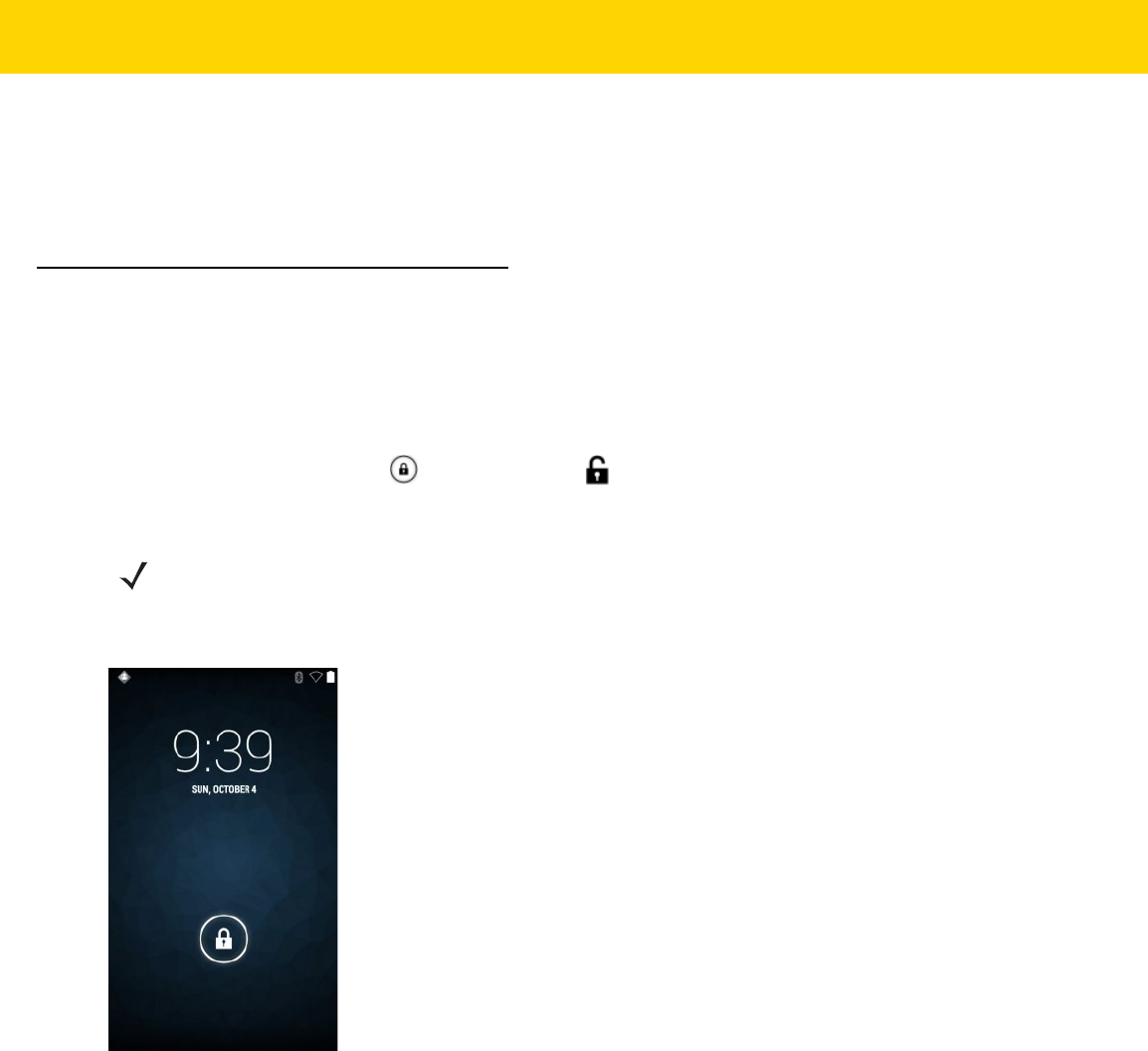
2 - 14 TC8000 User Guide
2. Touch MultiUser is active.
3. Touch Logout.
4. The Login screen appears.
Suspend Mode
The TC8000 goes into suspend mode when the user presses the Power button or after a period of inactivity (set in
the Display settings window).
To wake the TC8000 from Suspend mode, press the Power button. Alternately, press the Trigger button to wake
the device.
The Lock screen displays. Slide to the right toward to unlock the screen. If the Pattern screen unlock feature
is enabled, the Pattern screen appears instead of the Lock screen. See Un-Locking the Screen on page 2-11.
If the user forgets the PIN, password or pattern contact the system administrator.
Figure 2-12 Lock Screen
NOTE
If the user enters the PIN, password or pattern incorrectly five times, they must wait 30 seconds before
trying again.
Review Copy
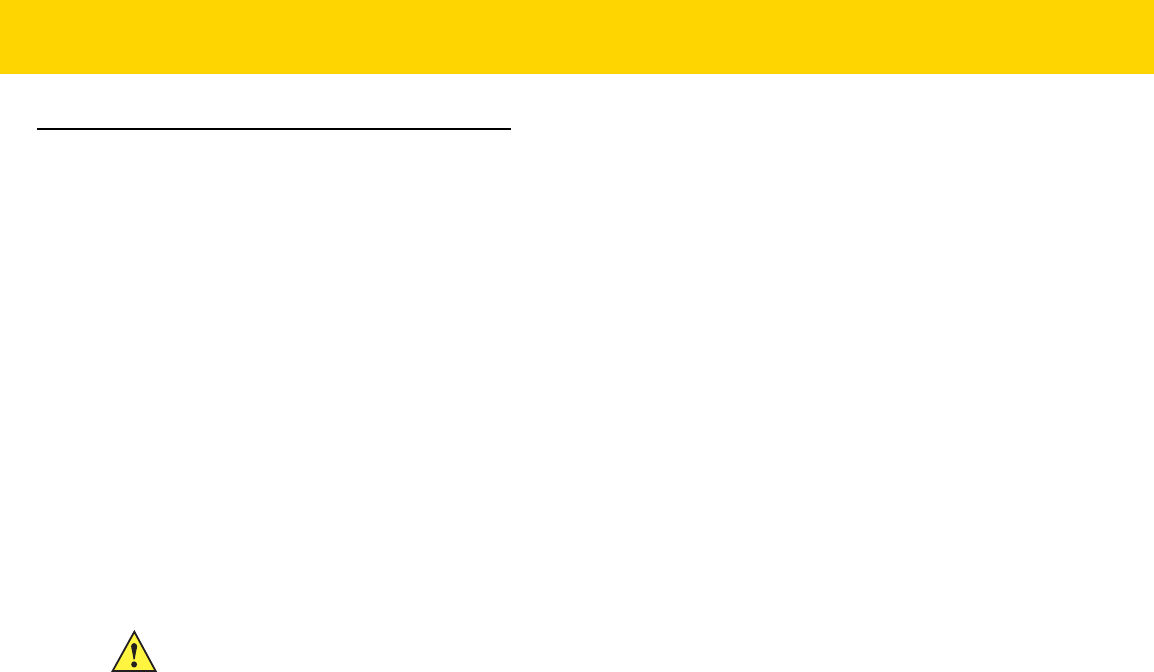
Using the TC8000 2 - 15
Resetting the TC8000
There are four reset functions:
•
Soft reset
•
Hard reset.
Performing a Soft Reset
Perform a soft reset if applications stop responding.
1. Press the power button until the menu appears.
2. Touch Reset.
3. The device reboots.
Performing a Hard Reset
To perform a hard reset, simultaneously press and hold the power button, trigger and PTT button for five seconds.
When the device reboots, release the buttons and trigger.
CAUTION
Perform a hard reset only if the TC8000 stops responding.
Review Copy

2 - 16 TC8000 User Guide
Review Copy
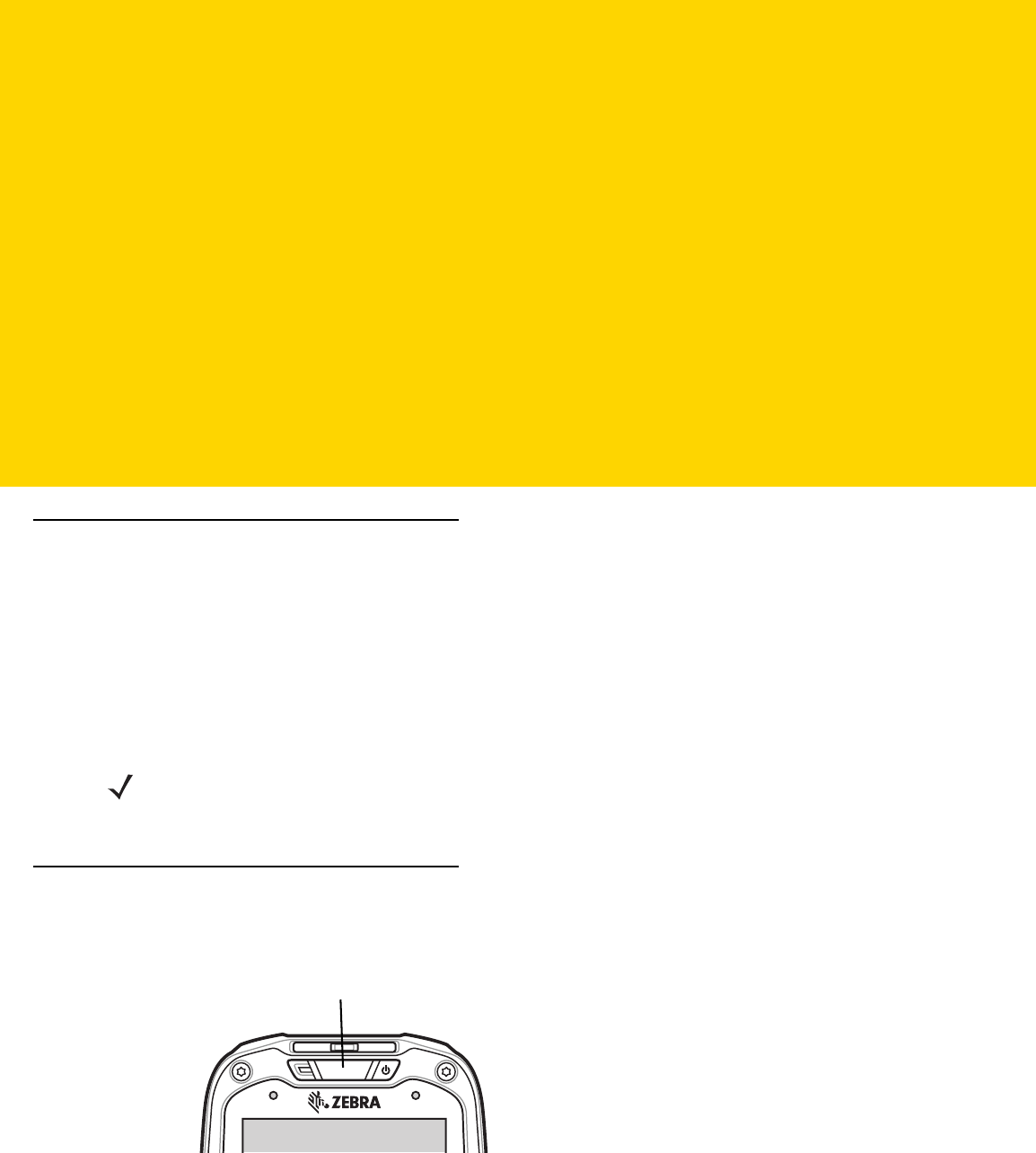
CHAPTER 3 DATA CAPTURE
Introduction
The TC8000 has the following data capture options.
•
integrated SE-965 Standard Range Laser
•
integrated SE-4750-SR Standard Range Imager
•
integrated digital camera
•
optional RS507.
Status LED
The Charing/Scan LED indicates data capture status. Table 3-1 describes the Status LED indications.
Figure 3-1 Charging/Scan LED
NOTE
By default, the good decode beep is set to system volume (Notifications). The good decode beep can be set to
another sound (Ringer, Music and Media or Alarms) and the volume can be independently controlled. See the
DataWedge section in the TC8000 Integrator Guide for more information.
Charging/Scan LED
Review Copy
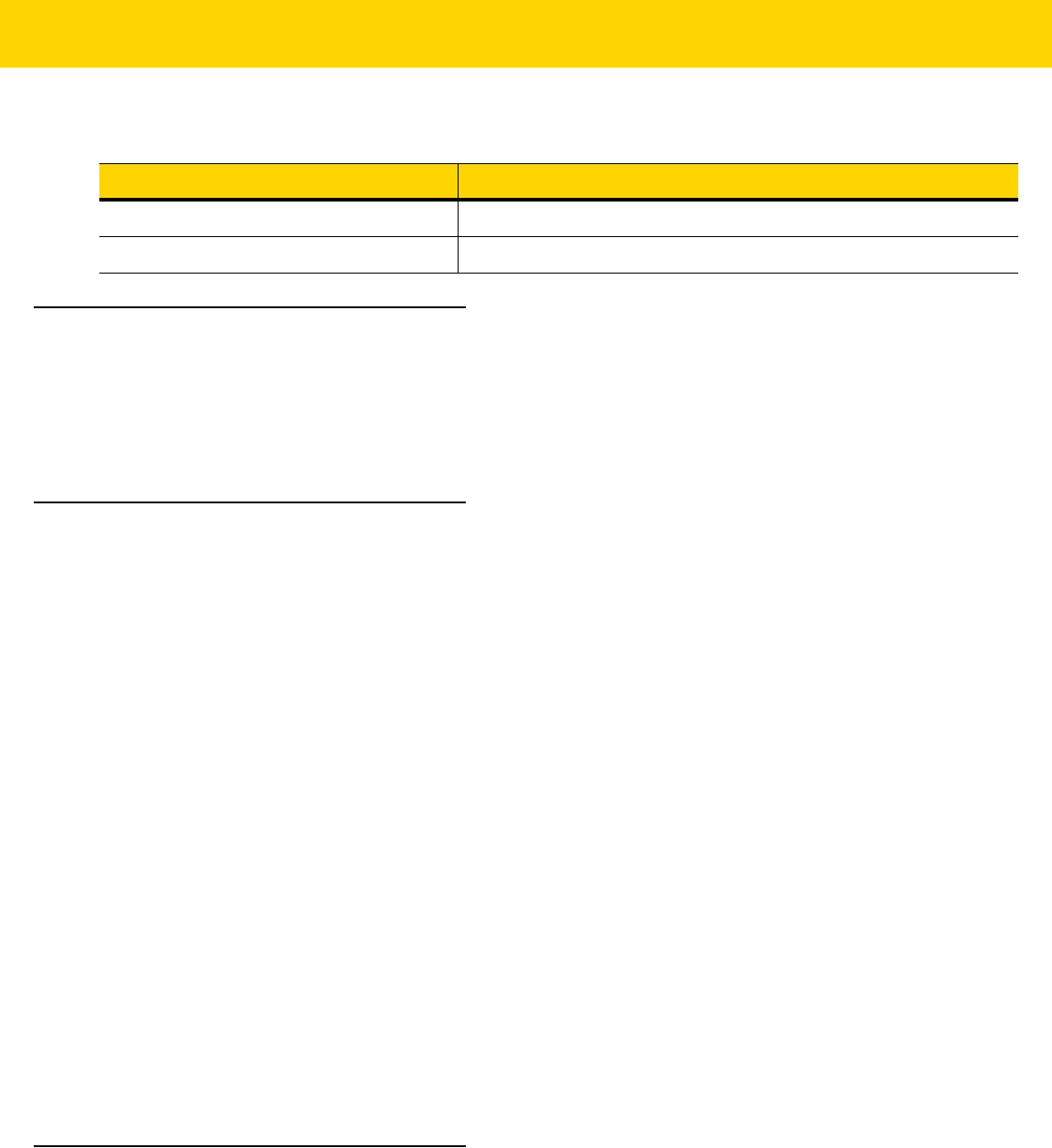
3 - 2 TC8000 User Guide
Laser Scanning
The TC8000 with laser scanner has the following features:
•
Reading of a variety of bar code symbologies, including the most popular linear, postal, and 1-D code types.
•
Intuitive aiming for easy point-and-shoot operation.
Imaging
The TC8000 with an integrated imager has the following features:
•
Omnidirectional (360°) reading of a variety of bar code symbologies, including the most popular linear, postal,
PDF417, and 2D matrix code types.
•
The ability to capture and download images to a host for a variety of imaging applications.
•
Advanced intuitive laser aiming for easy point-and-shoot operation.
The imager uses digital camera technology to take a digital picture of a bar code, stores the resulting image in its
memory, and executes state-of-the-art software decoding algorithms to extract the data from the image.
Operational Modes
The TC8000 with an integrated imager supports three modes of operation, listed below. Activate each mode
pressing the Scan button.
•
Decode Mode: In this mode, the TC8000 attempts to locate and decode enabled bar codes within its field of
view. The imager remains in this mode as long as you hold the scan button, or until it decodes a bar code.
•
Pick List Mode: This mode allows you to selectively decode a bar code when more than one bar code is in
the TC8000’s field of view. To accomplish this, move the aiming crosshair center dot over the required bar
code to decode only that bar code. This feature is ideal for pick lists containing multiple bar codes and
manufacturing or transport labels containing more than one bar code type (either 1D or 2D).
•
Image Capture Mode: Use this mode to capture an image within the TC8000’s field of view. This is useful for
capturing signatures or images of items like damaged boxes.
Digital Camera
The device with an integrated camera based bar code scanning solution has the following features:
•
Omnidirectional reading of a variety of bar code symbologies, including the most popular linear, postal, QR,
PDF417, and 2D matrix code types.
Table 3-1 Charging/Scan LED Indicators
LED Status Indication
Off Not scanning.
Solid Green Successful decode.
Review Copy
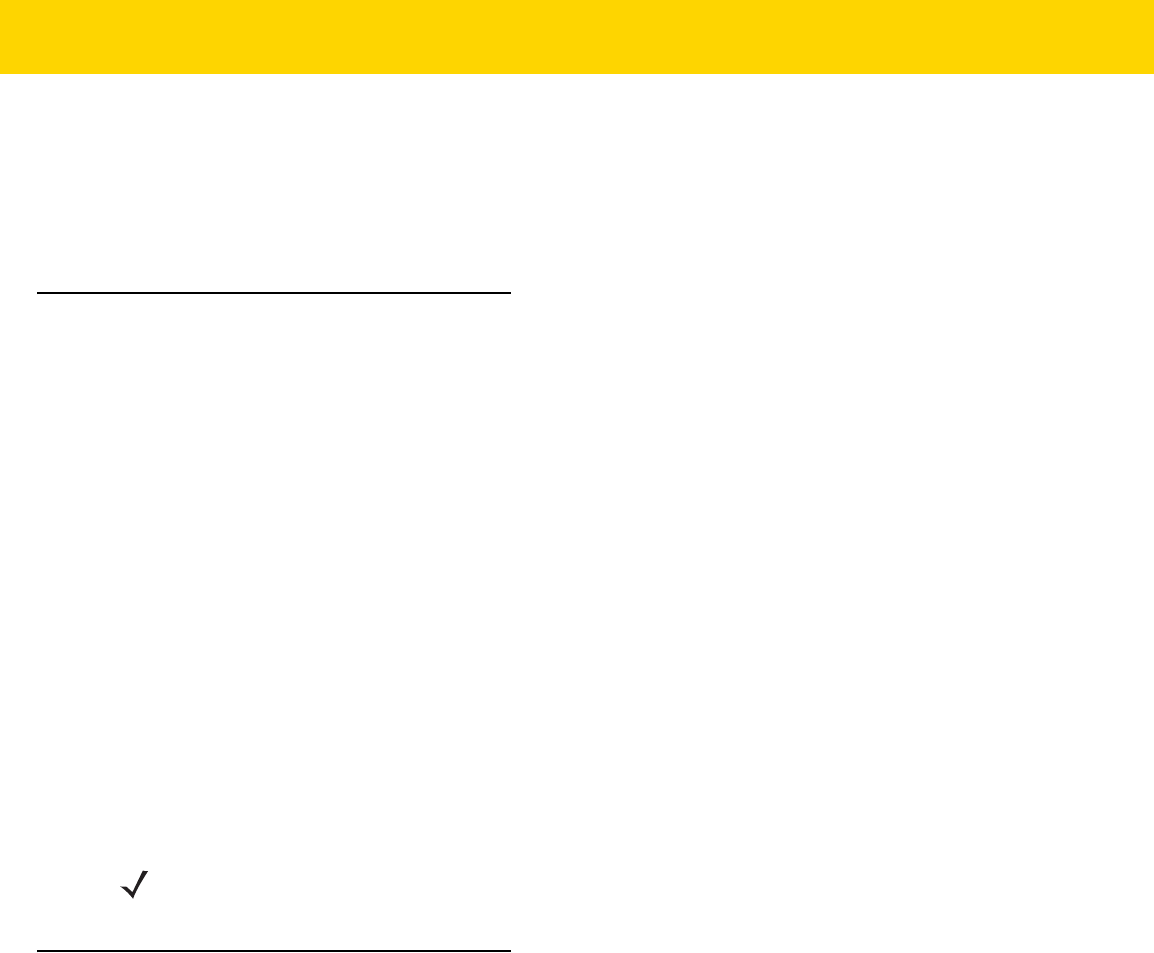
Data Capture 3 - 3
•
Cross-hair reticle for easy point-and-shoot operation.
•
Picklist mode to decode a particular bar code from many in the field of view.
The solution uses the advanced camera technology to take a digital picture of a bar code, and executes
state-of-the-art software decoding algorithms to extract the data from the image.
Scanning Considerations
Scanning consists of; aim, scan and decode. Scanning performance can be optimized by considering the range
and the scanning angle:
•
Range
Any scanning device decodes well over a particular working range (minimum and maximum distances from
the bar code). This range varies according to bar code density and scanning device optics.
Scanning within range brings quick and constant decodes; scanning too close or too far away prevents
decodes. Move the scanner closer and further away to find the right working range for the bar codes being
scanned. However, the situation is complicated by the availability of various integrated scanning modules.
The best way to specify the appropriate working range per bar code density is through a chart called a
decode zone for each scan module. A decode zone simply plots working range as a function of minimum
element widths of bar code symbols.
•
Angle
The scan angle is important for optimizing decode performance. When laser beams reflect directly back into
the scanner from the bar code, this specular reflection can “blind” the scanner.
To avoid this, scan the bar code so that the beam does not bounce directly back. But do not scan at too sharp
an angle; the scanner needs to collect scattered reflections from the scan to make a successful decode.
Practice quickly shows what tolerances to work within.
Bar Code Capture with Laser Scanner
To read a bar code, a scan-enabled application is required. The TC8000 contains the DataWedge application that
allows the user to enable the scanner to decode bar code data and display the bar code content. See DataWedge
on page 3-14 for information on enabling DataWedge.
1. Launch a scanning application.
2. Point the exit window at a bar code.
NOTE
Contact the Zebra Support if chronic scanning difficulties develop. Decoding of properly printed bar codes
should be quick and effortless.
Review Copy
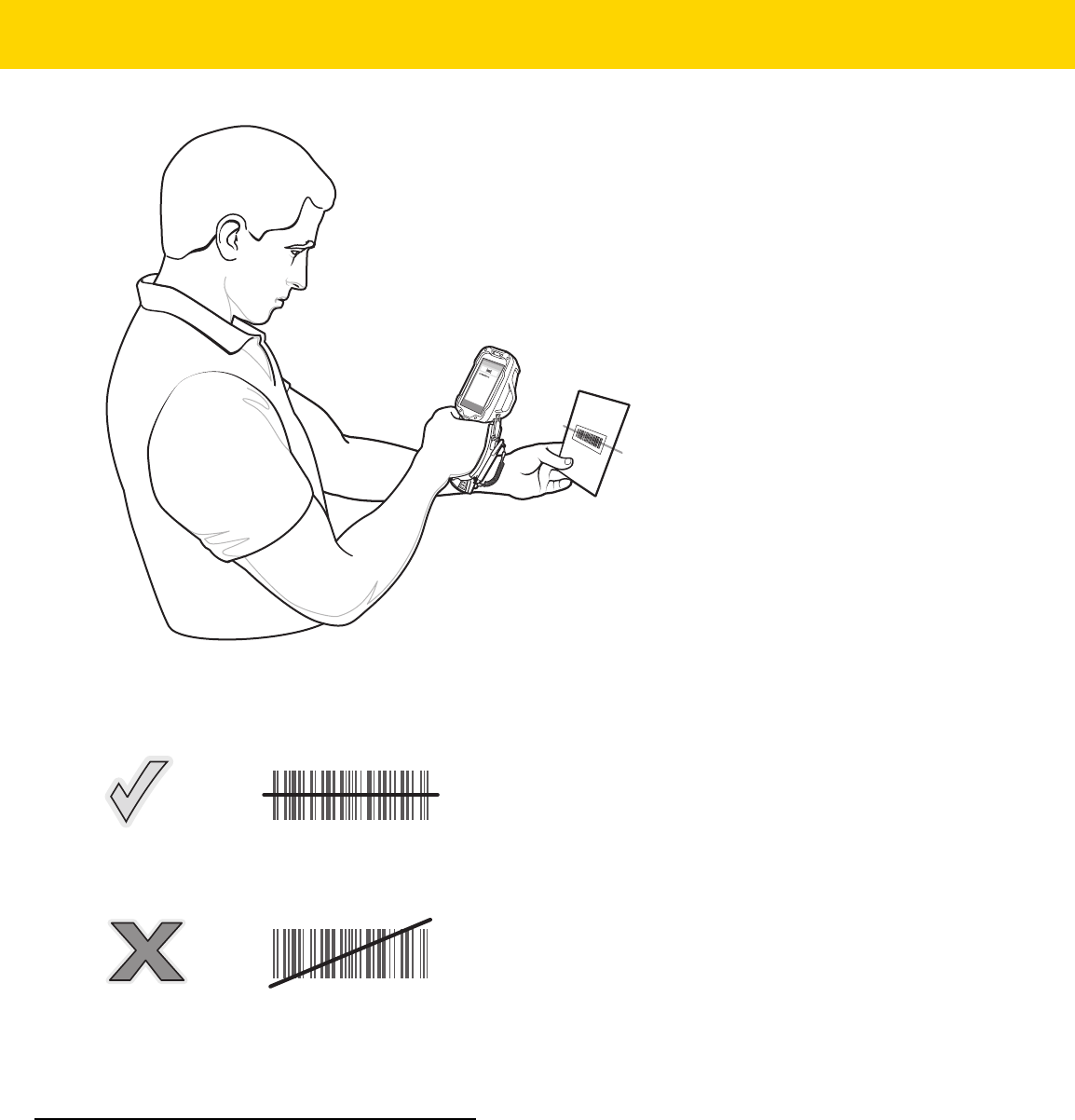
3 - 4 TC8000 User Guide
Figure 3-2 Laser Scanning
3. Press the trigger button. Ensure the red scan beam covers the entire bar code. The Charging/Scan LED
Indicators illuminate green and a beep sounds to indicate a successful decode.
Figure 3-3 Laser Aiming
4. Release the trigger or scan button.
Bar Code Capture with Imager
To read a bar code, a scan-enabled application is required. The TC8000 contains the DataWedge application that
allows the user to enable the scanner to decode bar code data and display the bar code content. See DataWedge
on page 14 for more information on launching DataWedge.
1. Launch a scanning application.
2. Point the exit window at a bar code.
Review Copy
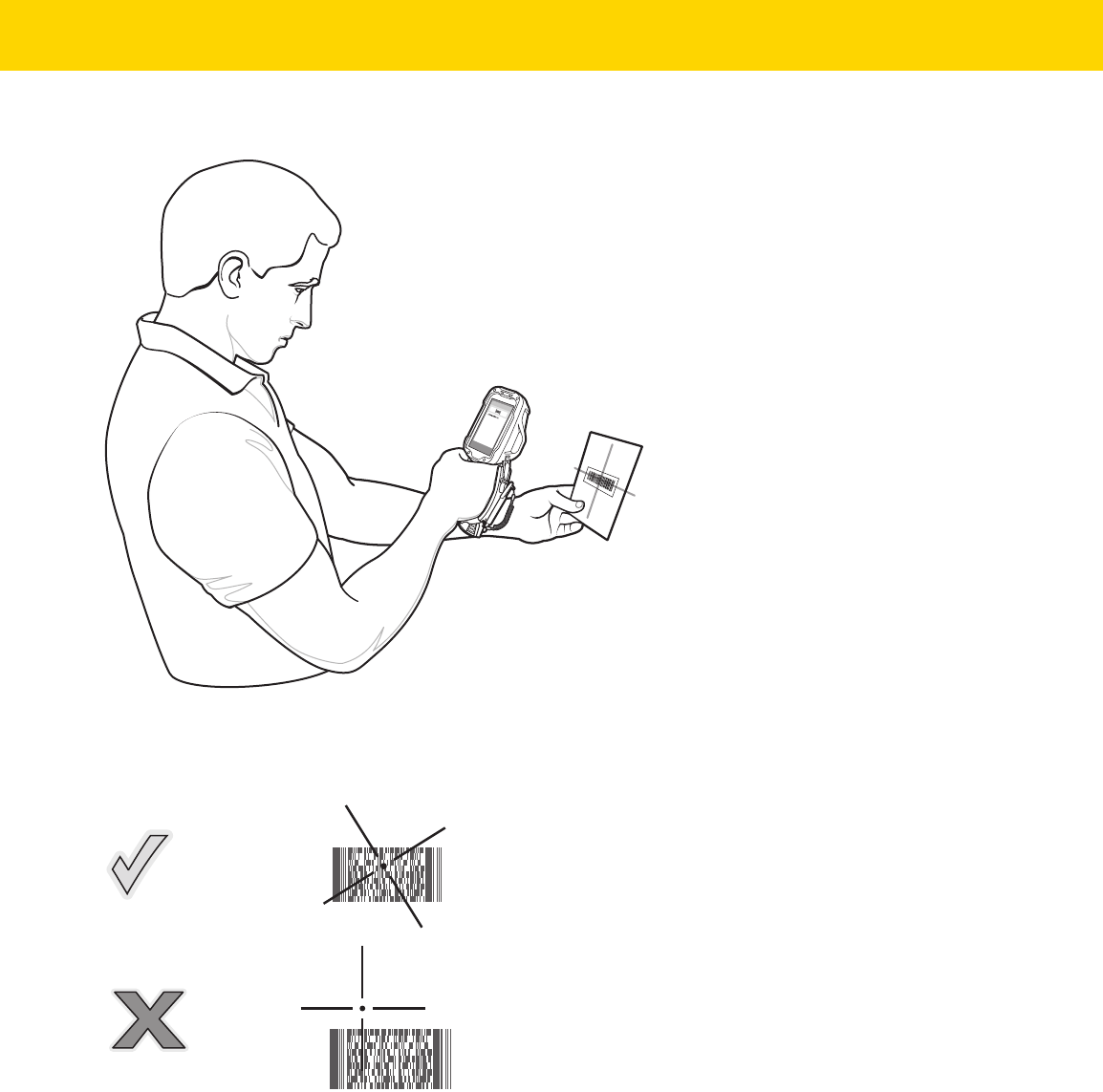
Data Capture 3 - 5
3. Press the trigger button.
Figure 3-4 Imager Scanning
4. Ensure the red scan beam covers the entire bar code. The Charging/Scan LED Indicators illuminate green and
a beep sounds to indicate a successful decode.
Figure 3-5 Imager Aiming Pattern
Review Copy
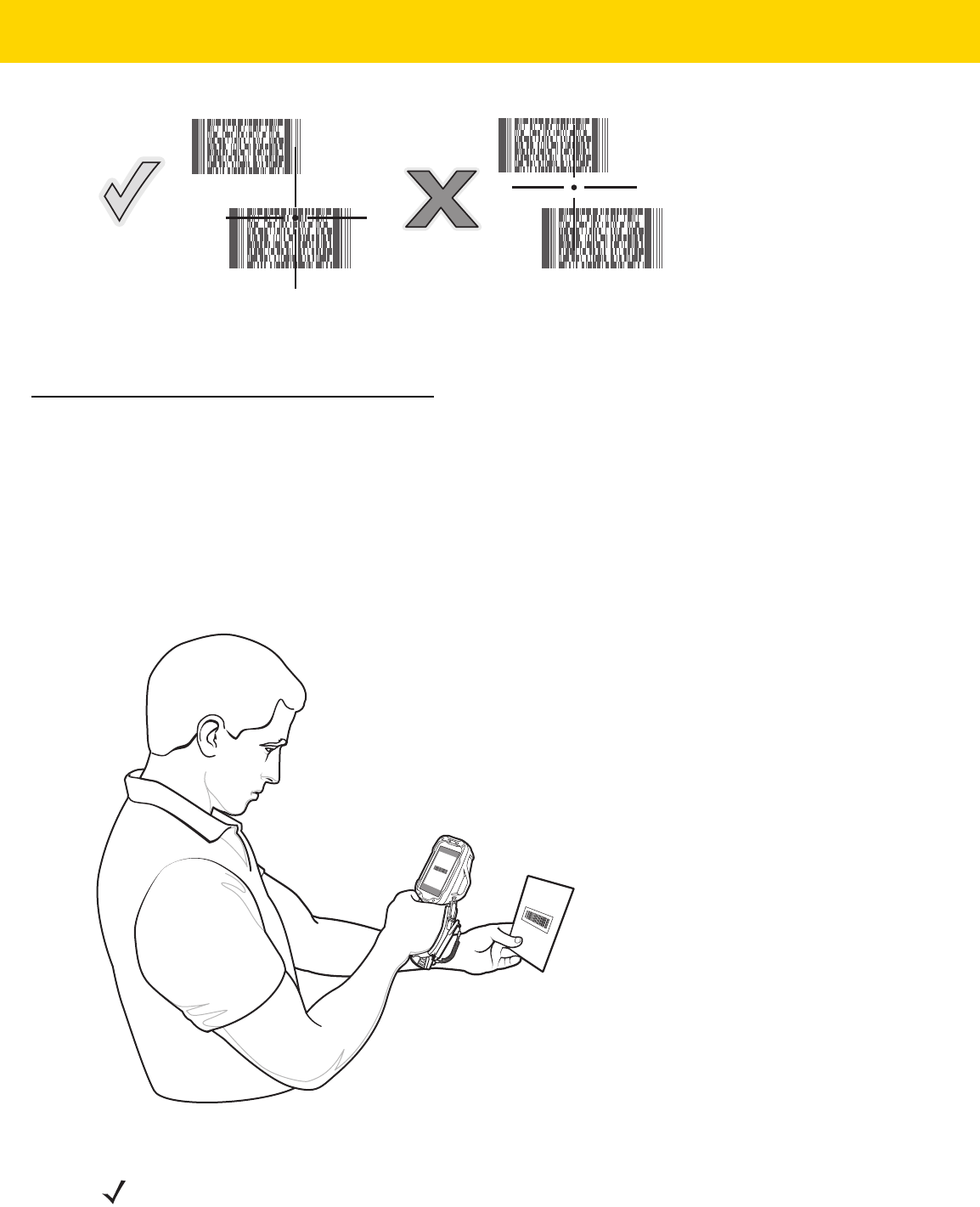
3 - 6 TC8000 User Guide
Figure 3-6 Imager Pick List Mode with Multiple Bar Codes
5. Release the trigger.
Bar Code Capture with Camera
To read a bar code, a scan-enabled application is required. The TC8000 contains the DataWedge application that
allows the user to enable the scanner to decode bar code data and display the bar code content. See DataWedge
on page 3-14 for more information on launching DataWedge.
1. Launch a scanning application.
2. Point the camera window at a bar code.
3. Press and hold the trigger. By default, a preview window appears on the screen.
Figure 3-7 Camera Scanning
NOTE
When Picklist mode is enabled, move the TC8000 until the bar code is centered under the red target on
the screen.
Review Copy
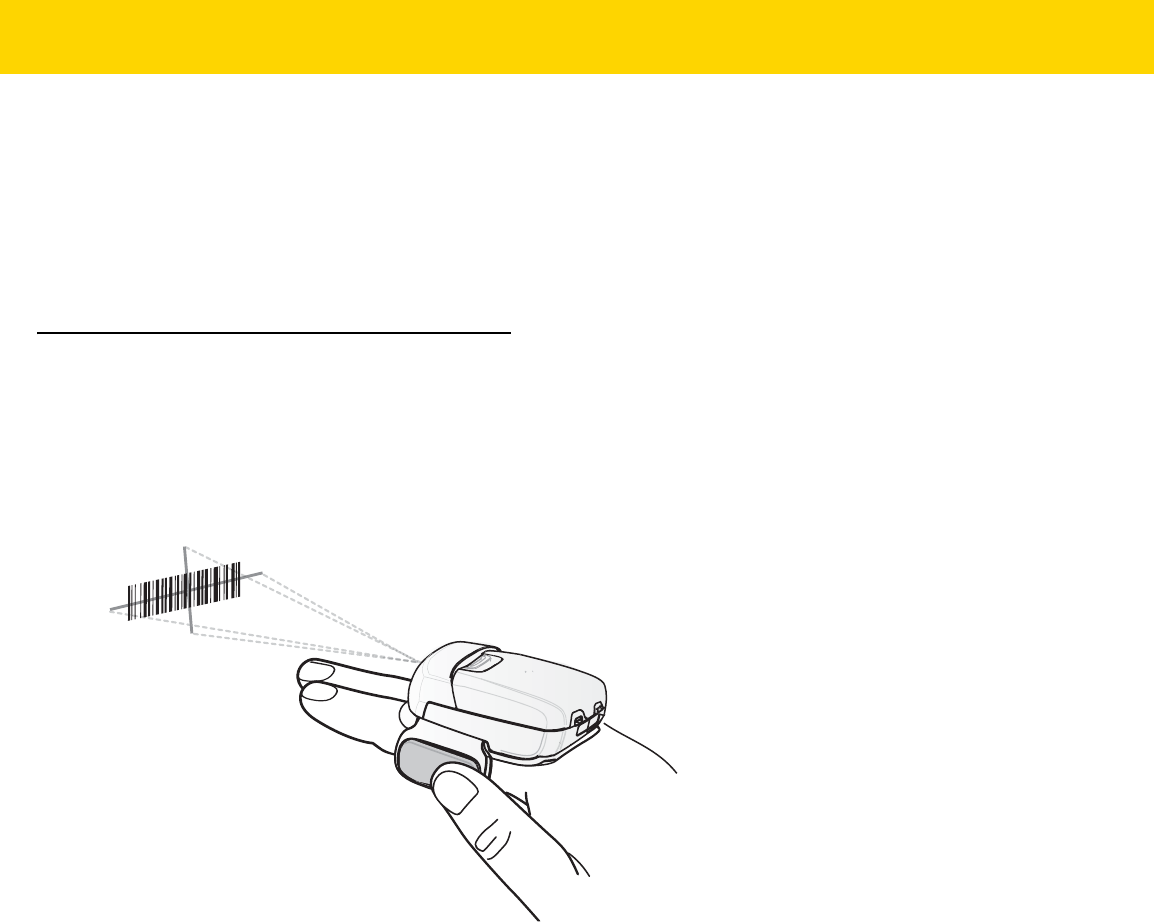
Data Capture 3 - 7
4. Move the TC8000 until the bar code is visible on the screen.
5. The Decode LED lights green, a beep sounds and the device vibrates, by default, to indicate the bar code was
decoded successfully.
6. The captured data appears in the text field.
7. Release the trigger.
Bar Code Capture with RS507 Hands-Free Imager
Pair the RS507 with the TC8000. See Pairing the RS507 Hands-Free Imager Using SSI on page 3-8 or Pairing the
RS507 Hands-Free Imager Using Bluetooth HID on page 3-9 for more information.
1. Ensure that an application is open on the device and a text field is in focus (text cursor in text field).
2. Point the RS507 at a bar code.
Figure 3-8 Bar Code Scanning with RS507
3. Press and hold the trigger.
The red laser aiming pattern turns on to assist in aiming. Ensure the bar code is within the area formed by the
cross-hairs in the aiming pattern. The aiming dot is used for increased visibility in bright lighting conditions.
The RS507 LEDs light green, a beep sounds to indicate the bar code was decoded successfully. Note that
when the RS507 is in Pick List Mode, the RS507 does not decode the bar code until the center of the crosshair
touches the bar code.
Review Copy
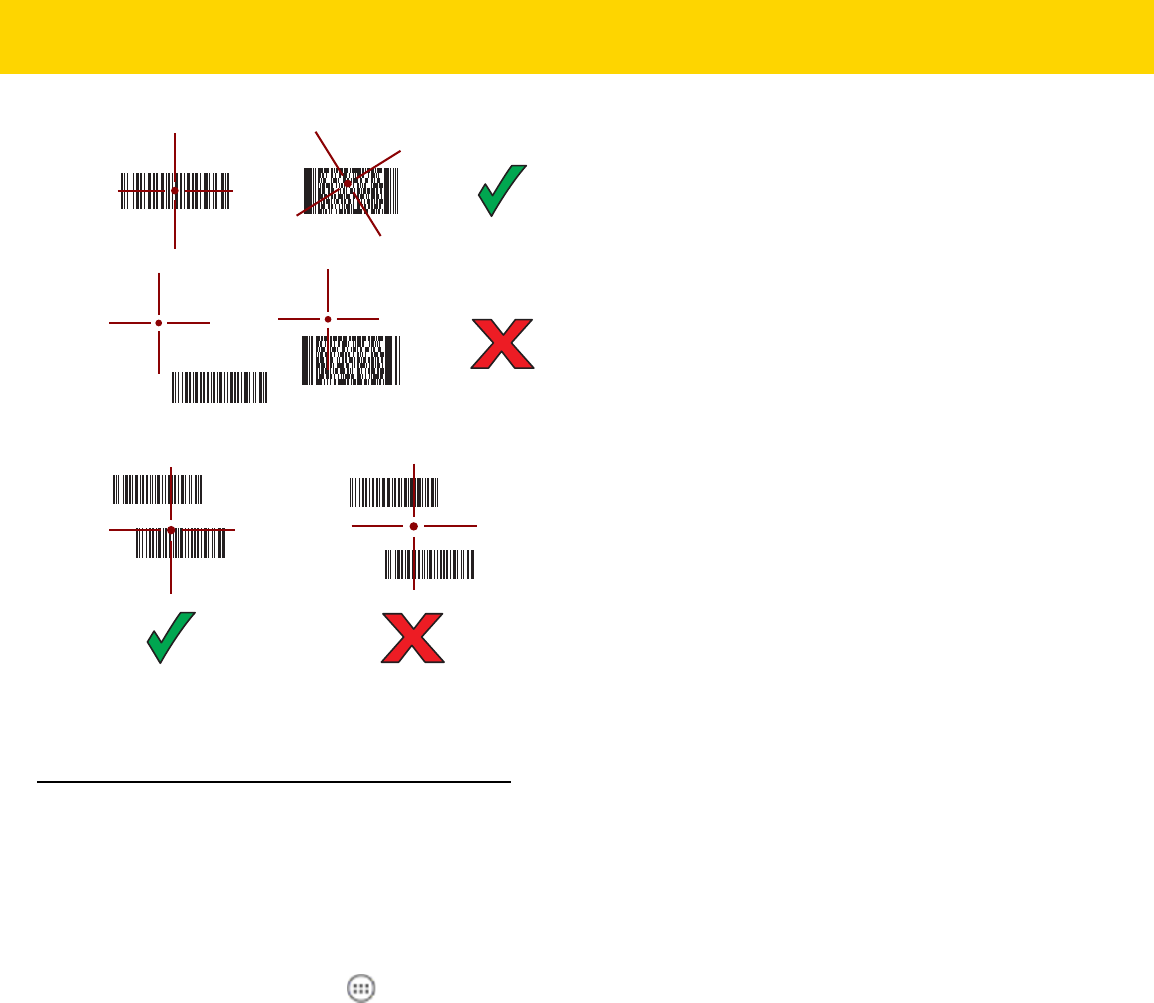
3 - 8 TC8000 User Guide
Figure 3-9 Aiming Pattern
Figure 3-10 Pick List Mode with Multiple Bar Codes in Aiming Pattern
4. The captured data appears in the text field.
Pairing the RS507 Hands-Free Imager Using SSI
An RS507 Hands-free Imager can be used with the device to capture bar code data.
1. Ensure that the two devices are within 10 meters (32.8 feet) of one another.
2. Install the battery into the RS507.
3. On the TC8000, touch .
4. Touch (Bluetooth pairing Utility icon).
Review Copy
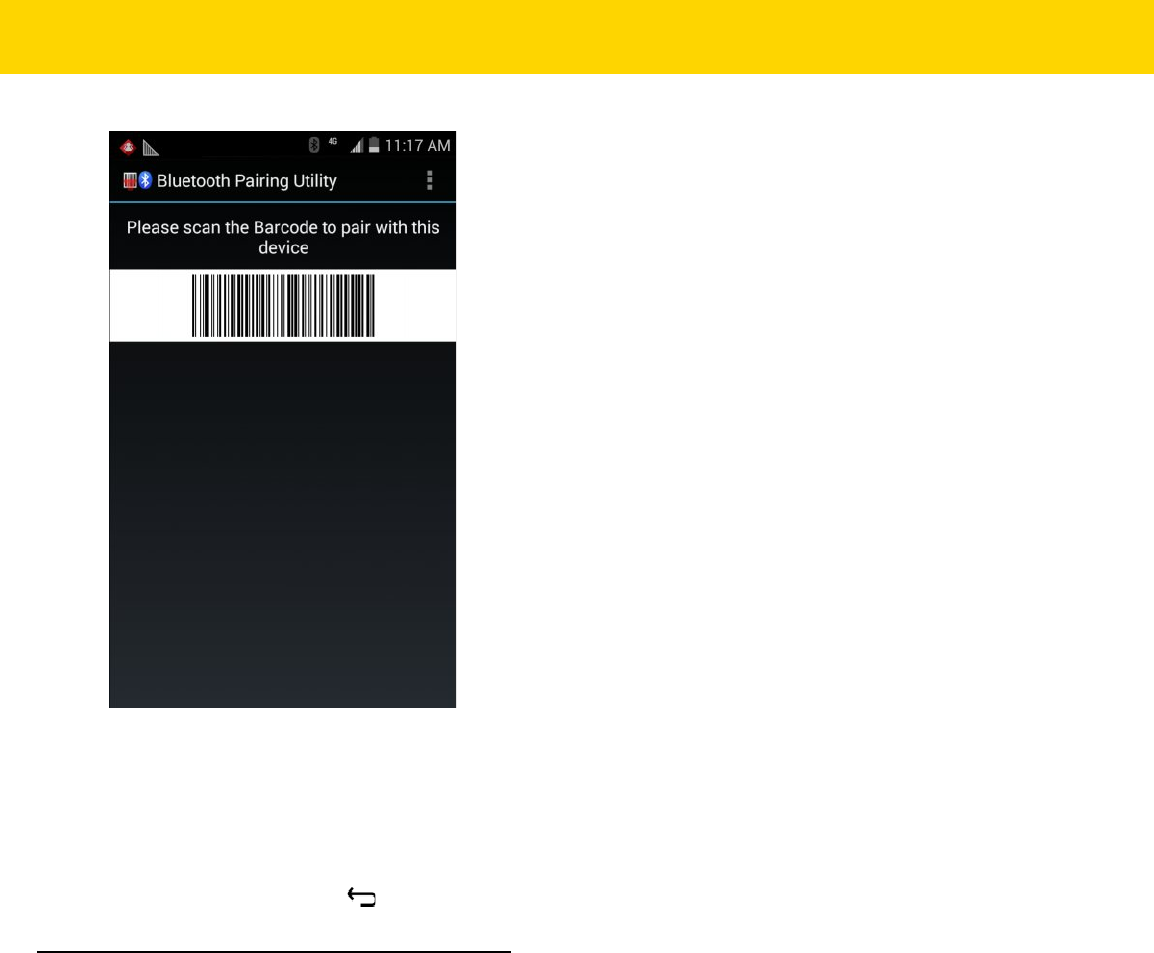
Data Capture 3 - 9
Figure 3-11 Bluetooth Pairing Utility
5. Using the RS507, scan the bar code on the screen.
The RS507 emits a high/low/high/low beeps. The Scan LED flashes green indicating that the RS507 is
attempting to establish connection with the TC8000. When connection is established, the Scan LED turns off
and the RS507 emits one string of low/high beeps.
6. On the TC8000, touch .
Pairing the RS507 Hands-Free Imager Using Bluetooth HID
An RS507 Hands-free Imager can be used with the device to capture bar code data.
1. Ensure that Bluetooth is enabled on both devices.
2. Ensure that the Bluetooth device to discover is in discoverable mode.
3. Ensure that the two devices are within 10 meters (32.8 feet) of one another.
4. Place the RS507 in Human Interface Device (HID) mode. If the RS507 is already in HID mode, skip to step 5.
a. Remove the battery from the RS507.
b. Press and hold the Restore key.
c. Install the battery onto the RS507.
d. Keep holding the Restore key for about five seconds until a chirp is heard and the Scan LEDs flash green.
e. Scan the bar code below to place the RS507 in HID mode.
Review Copy
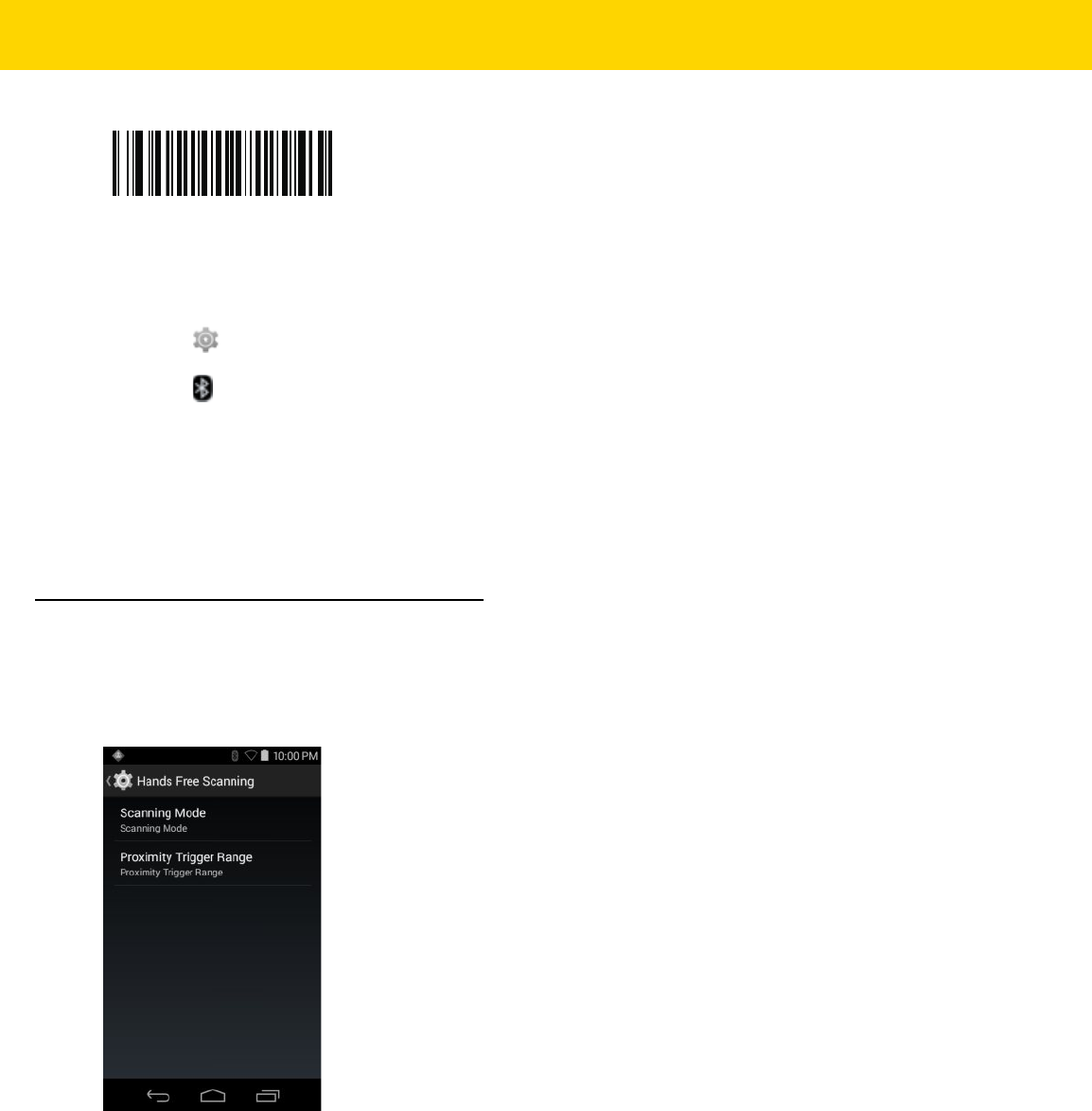
3 - 10 TC8000 User Guide
Figure 3-12 RS507 Bluetooth HID Bar Code
5. Remove the battery from the RS507.
6. Re-install the battery into the RS507.
7. Touch .
8. Touch Bluetooth.
9. Touch SCAN FOR DEVICES. The device begins searching for discoverable Bluetooth devices in the area and
displays them under AVAILABLE DEVICES.
10. Scroll through the list and select RS507.
The device connects to the RS507 and Connected appears below the device name. The Bluetooth device is
added to the Bluetooth devices list and a trusted (“paired”) connection is established.
Hands Free Scanning
Figure 3-13 Hands Free Scanning Settings
Scanning Mode
Review Copy
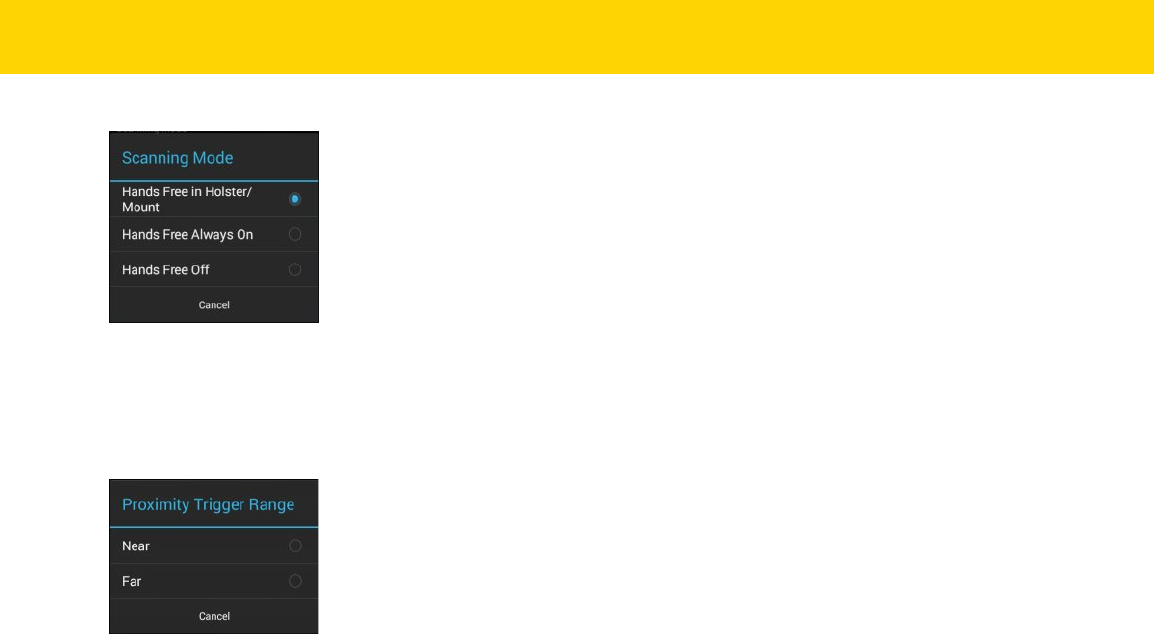
Data Capture 3 - 11
Figure 3-14 Scanning Mode Dialog Box
Proximity Range
Figure 3-15 Proximity Trigger Range Dialog Box
Review Copy
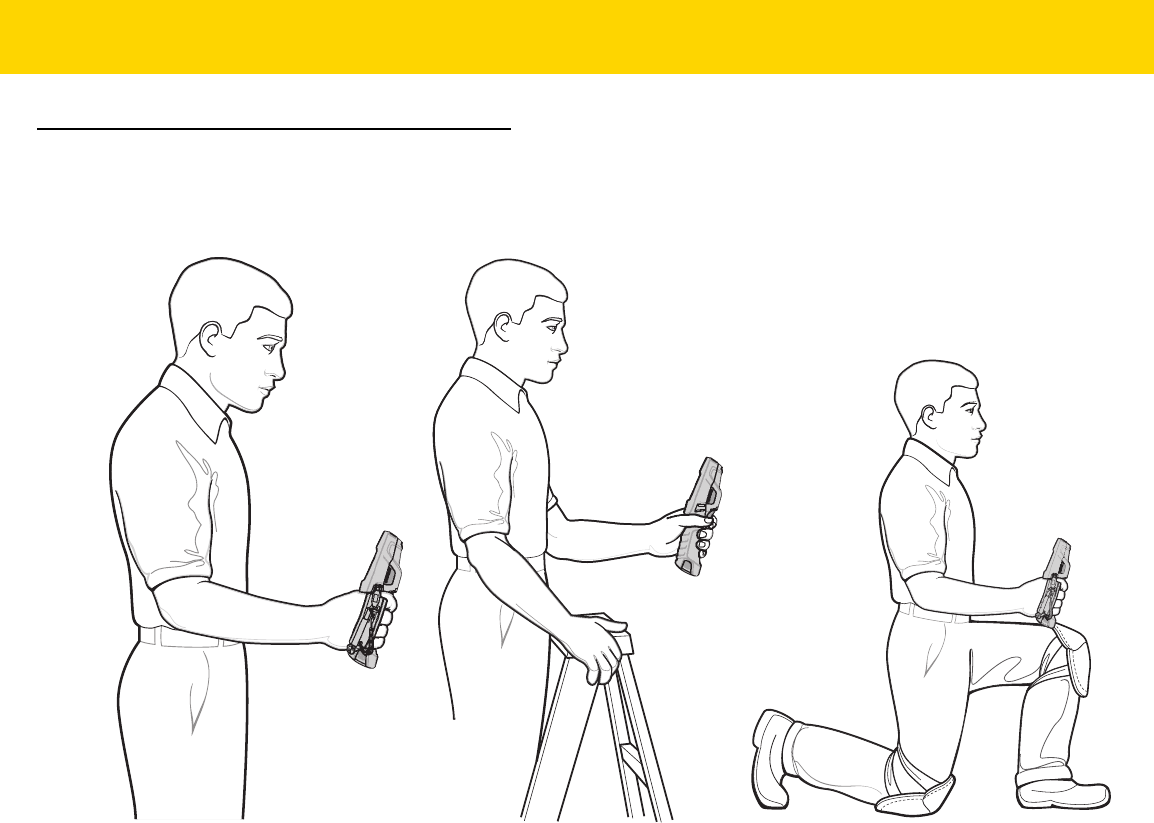
3 - 12 TC8000 User Guide
Ergonomic Recommendations During Scanning
Proper Scanning
Figure 3-16 Proper Scanning Position
Standing High Scanning Low Scanning
Review Copy
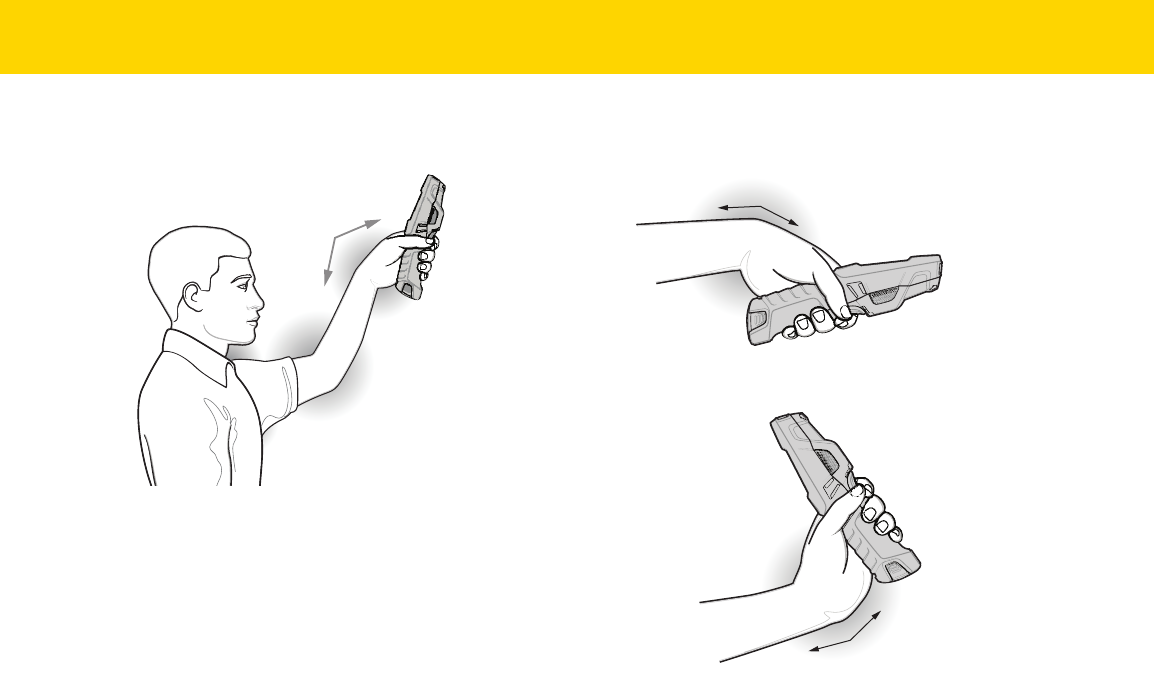
Data Capture 3 - 13
Improper Scanning
Figure 3-17 Do Not Bend Wrist Excessively
Review Copy
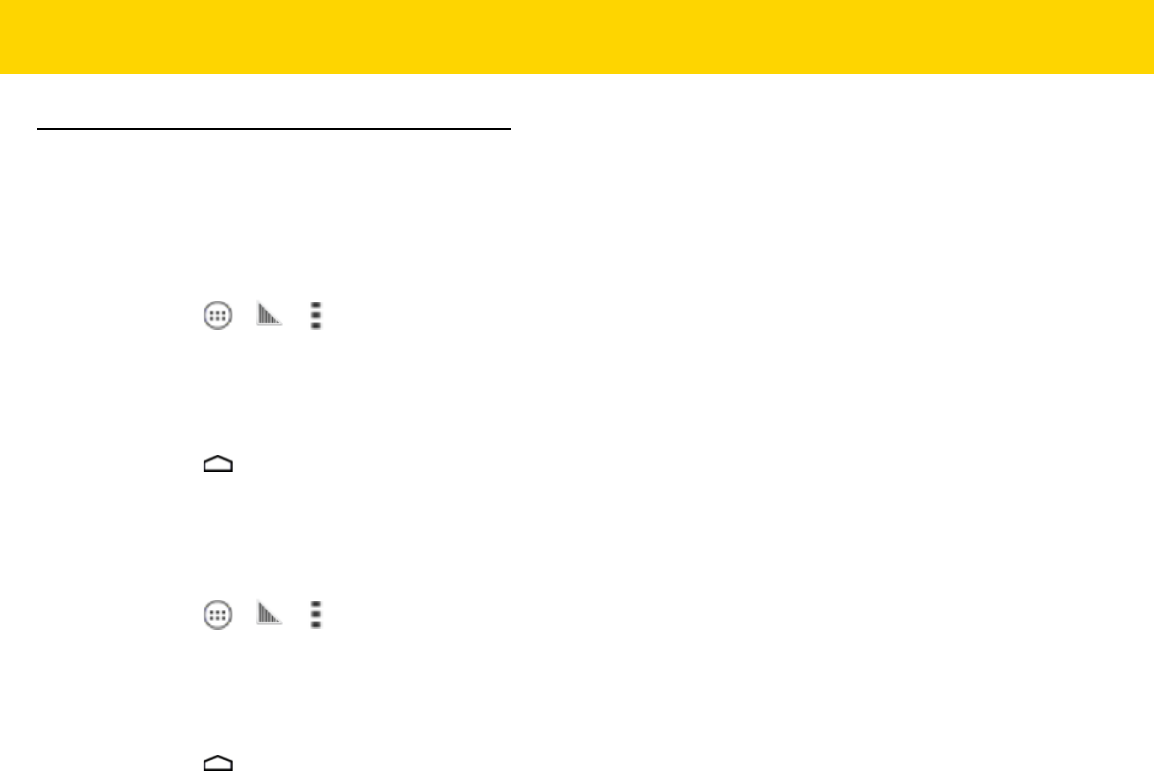
3 - 14 TC8000 User Guide
DataWedge
Enable DataWedge
To enable DataWedge:
1. Touch > > .
2. Touch Settings.
3. Touch the DataWedge enabled checkbox. A blue checkmark appears in the checkbox indicating that
DataWedge is enabled.
4. Touch .
Disable DataWedge
To disable DataWedge:
1. Touch > > .
2. Touch Settings.
3. Touch the DataWedge enabled checkbox. The blue checkmark disappears from the checkbox indicating that
DataWedge is disabled.
4. Touch .
Review Copy
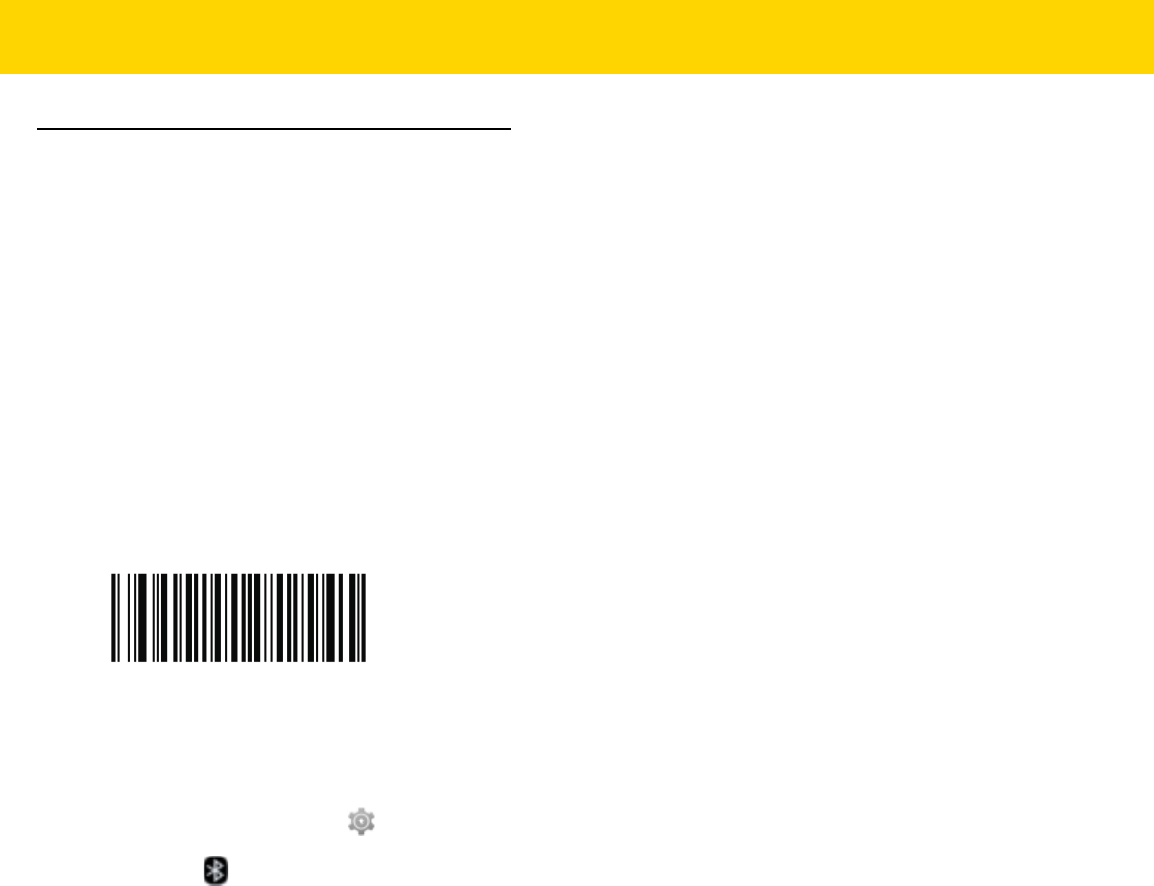
Data Capture 3 - 15
Pairing the RS507 Hands-Free Imager using HID
An RS507 Hands-free Imager can be used with the device to capture bar code data.
1. Ensure that Bluetooth is enabled on both devices.
2. Ensure that the Bluetooth device to discover is in discoverable mode.
3. Ensure that the two devices are within 10 meters (32.8 feet) of one another.
4. Place the RS507 in Human Interface Device (HID) mode. If the RS507 is already in HID mode, skip to step 5.
a. Remove the battery from the RS507.
b. Press and hold the Restore key.
c. Install the battery onto the RS507.
d. Keep holding the Restore key for about five seconds until a chirp is heard and the Scan LEDs flash green.
e. Scan the bar code below to place the RS507 in HID mode.
Figure 3-18 RS507 Bluetooth HID Bar Code
5. Remove the battery from the RS507.
6. Re-install the battery into the RS507.
7. On the TC8000, touch .
8. Touch Bluetooth.
9. Touch SCAN FOR DEVICES. The device begins searching for discoverable Bluetooth devices in the area and
displays them under AVAILABLE DEVICES.
10. Scroll through the list and select RS507.
The device connects to the RS507 and Connected appears below the device name. The Bluetooth device is
added to the Bluetooth devices list and a trusted (“paired”) connection is established.
Review Copy
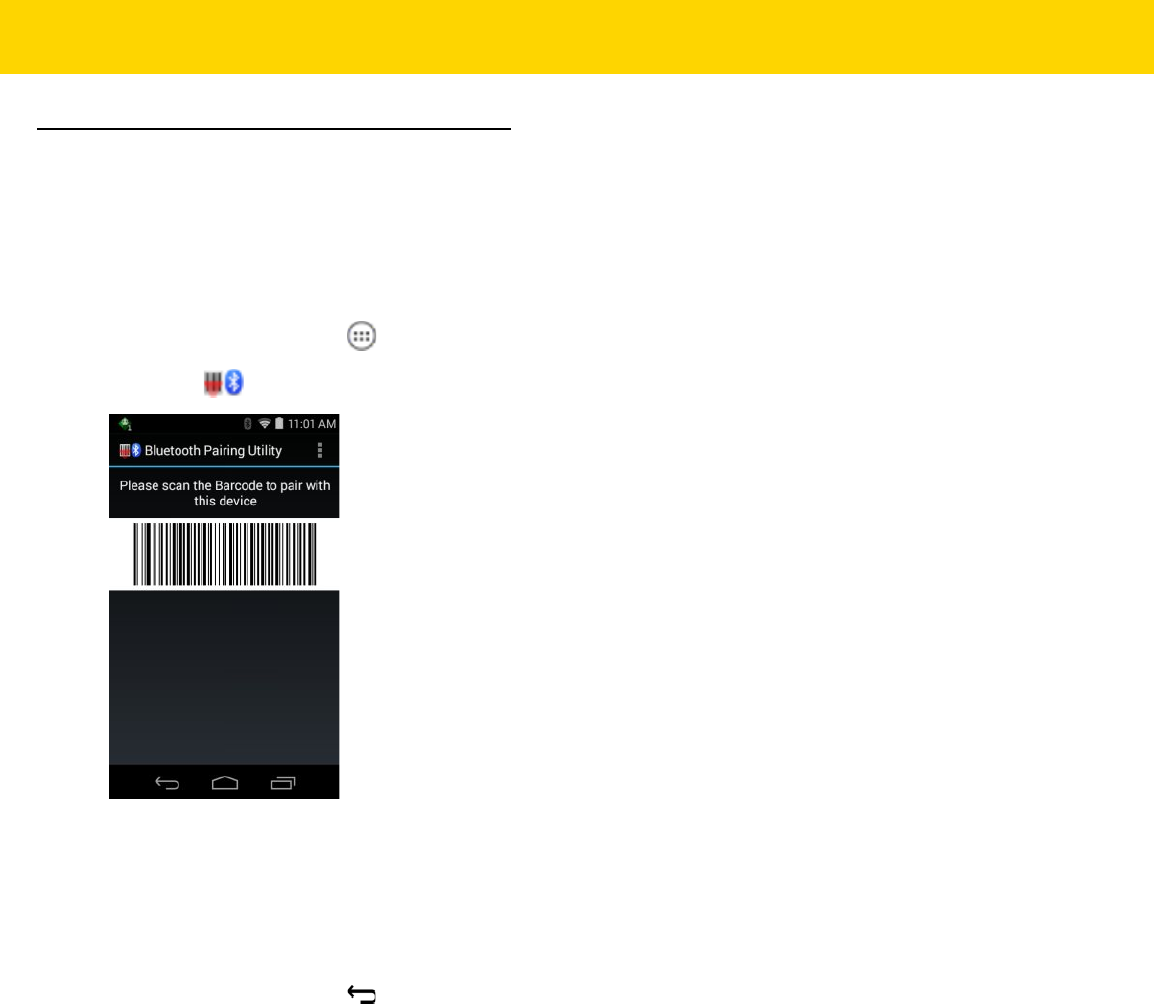
3 - 16 TC8000 User Guide
Pairing the RS507 Hands-Fee Imager Using SSI
An RS507 Hands-free Imager can be used with the device to capture bar code data.
1. Ensure that the two devices are within 10 meters (32.8 feet) of one another.
2. Install the battery into the RS507.
3. On the TC8000, touch .
4. Touch .
Figure 3-19 Bluetooth Pairing Utility
5. Using the RS507, scan the bar code on the screen.
The RS507 emits a high/low/high/low beeps. The Scan LED flashes green indicating that the RS507 is
attempting to establish connection with the TC8000. When connection is established, the Scan LED turns off
and the RS507 emits one string of low/high beeps.
6. On the TC8000, touch .
Review Copy

CHAPTER 4 WIRELESS
Wireless Local Area Networks
Wireless local area networks (WLANs) allow the TC8000 to communicate wirelessly inside a building. Before using
the TC8000 on a WLAN, the facility must be set up with the required hardware to run the WLAN (sometimes known
as infrastructure). The infrastructure and the TC8000 must both be properly configured to enable this
communication.
Refer to the documentation provided with the infrastructure (access points (APs), access ports, switches, Radius
servers, etc.) for instructions on how to set up the infrastructure.
Once the infrastructure is set up to enforce the chosen WLAN security scheme, use the Wireless & networks
settings configure the TC8000 to match the security scheme.
The TC8000 supports the following WLAN security options:
•
Open
•
Wireless Equivalent Privacy (WEP).
•
Wi-Fi Protected Access (WPA/WPA2) Personal (PSK).
•
Extensible Authentication Protocol (EAP).
•Protected Extensible Authentication Protocol (PEAP) - with MSCHAPV2 and GTC authentication.
•Transport Layer Security (TLS)
•TTLS - with Password Authentication Protocol (PAP), MSCHAP and MSCHAPv2 authentication.
•LEAP
•EAP-FAST - with MSCHAPV2 and GTC authentication.
The Status bar displays icons that indicate Wi-Fi network availability and Wi-Fi status. See Status Bar on page 2-2
for more information.
NOTE
Turn off Wi-Fi when not using it, to extend the life of the battery.
Review Copy
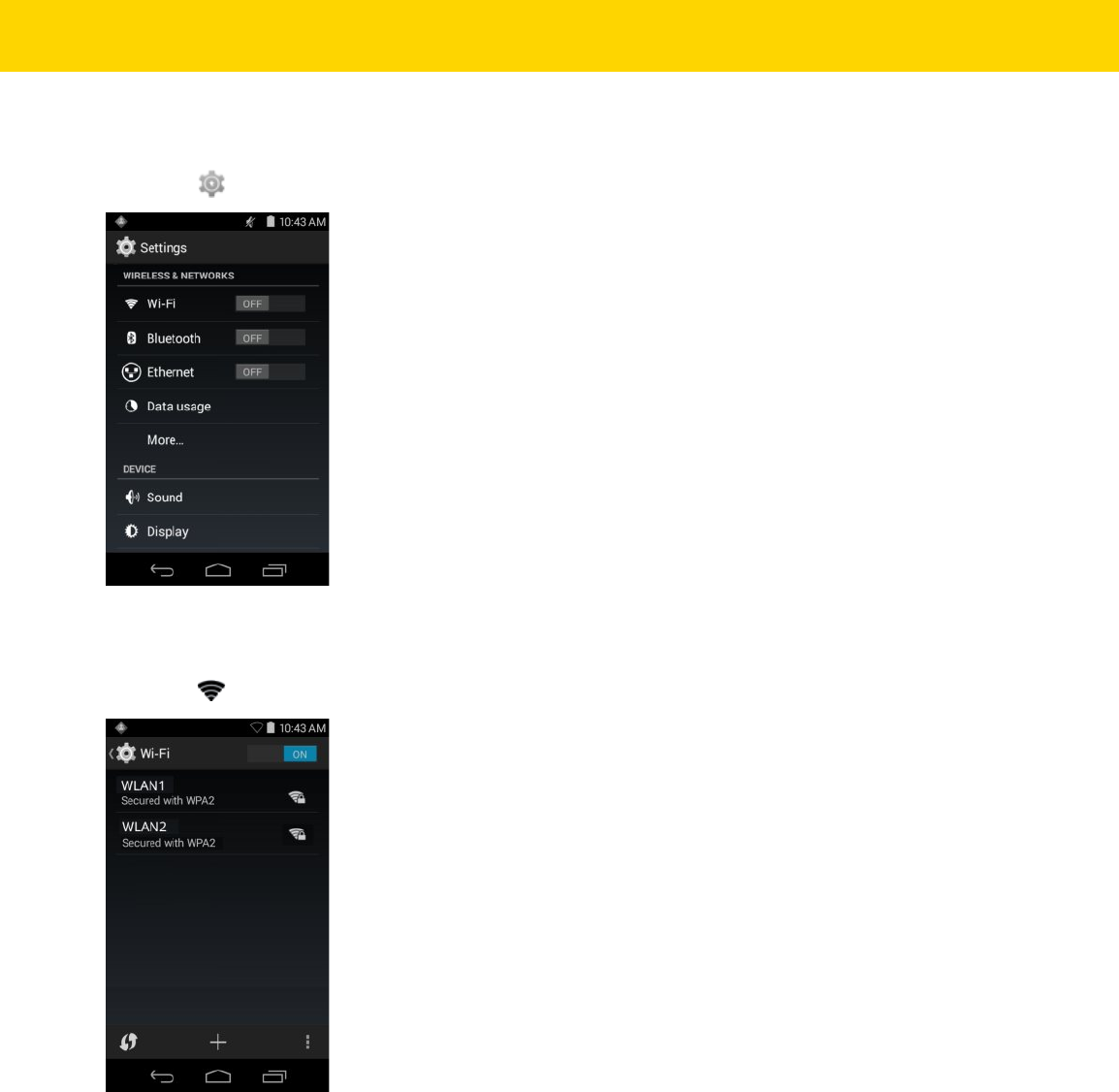
4 - 2 TC8000 User Guide
Scan and Connect to a Wi-Fi Network
1. Touch .
Figure 4-1 Settings Screen
2. Slide the Wi-Fi switch to the ON position.
3. Touch Wi-Fi. The TC8000 searches for WLANs in the area and lists them.
Figure 4-2 Wi-Fi Screen
4. Scroll through the list and select the desired WLAN network.
5. For open networks, touch profile once or press and hold and then select Connect to network or for secure
networks enter the required password or other credentials then touch Connect. See the system administrator
for more information.
6. The TC8000 obtains a network address and other required information from the network using the dynamic
host configuration protocol (DHCP) protocol. To configure the TC8000 with a fixed internet protocol (IP)
address, See Configuring the Device to Use a Static IP Address on page 4-6.
7. In the Wi-Fi setting field, Connected appears indicating that the TC8000 is connected to the WLAN.
Review Copy
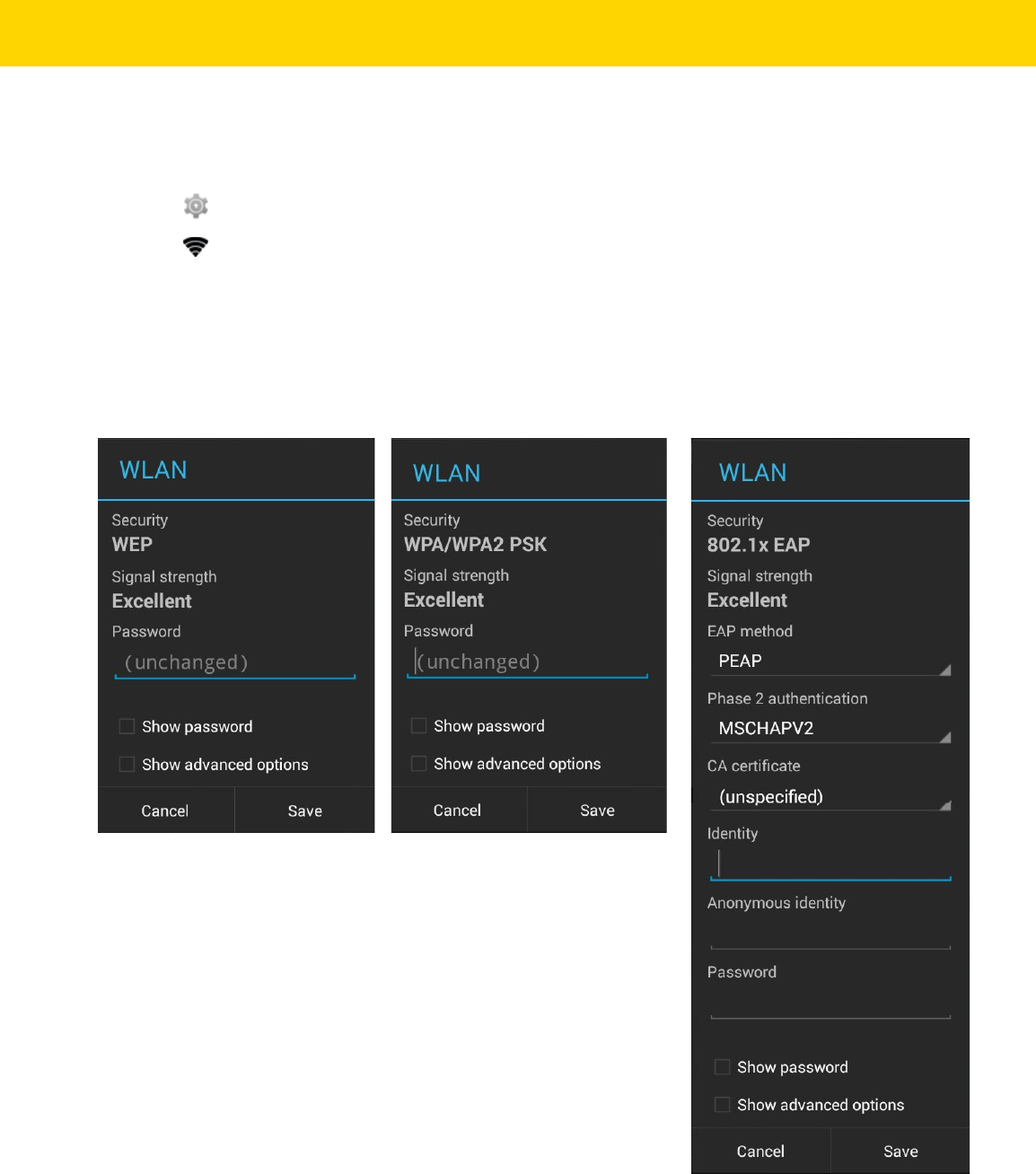
Wireless 4 - 3
Configuring a Wi-Fi Network
To set up a Wi-Fi network:
1. Touch .
2. Touch Wi-Fi.
3. Slide the switch to the ON position.
4. The device searches for WLANs in the area and lists them on the screen.
5. Scroll through the list and select the desired WLAN network.
6. Touch the desired network. If the network security is Open, the device automatically connects to the network.
For all other network security a dialog box appears.
Figure 4-3 WLAN Network Security Dialog Box
7. If the network security is WEP or WPA/WPS2 PSK, enter the required password and then touch Connect.
8. If the network security is 802.1x EAP:
Review Copy
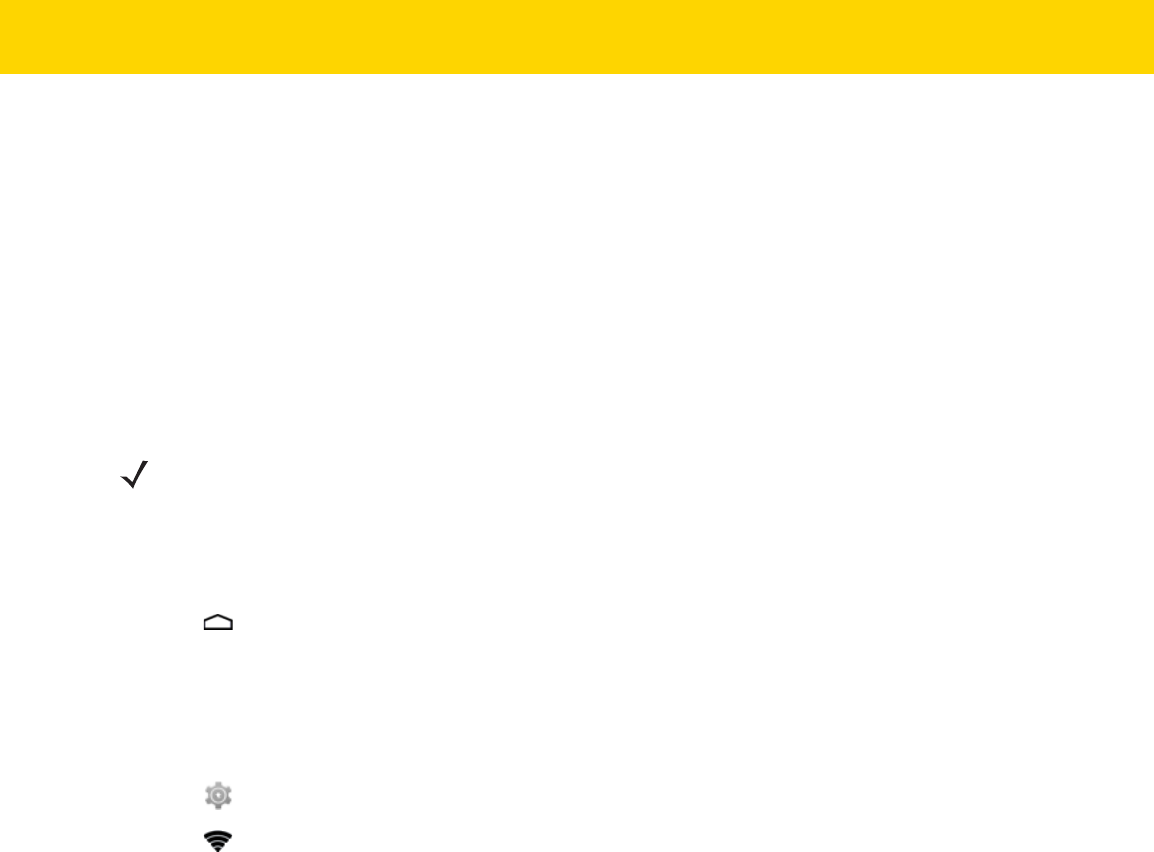
4 - 4 TC8000 User Guide
•
Touch the EAP method drop-down list and select PEAP, TLS, TTLS, LEAP or FAST.
•
Touch the Phase 2 authentication drop-down list and select an authentication method.
•
If required, touch CA certificate and select a Certification Authority (CA) certificate. Note: Certificates are
installed using the Security settings.
•
If required, touch User certificate and select a user certificate. Note: User certificates are installed using
the Location & security settings.
•
If required, in the Identity text box, enter the username credentials.
•
If desired, in the Anonymous identity text box, enter an anonymous identity username.
•
If required, in the Password text box, enter the password for then given identity.
9. Touch Connect.
10. Touch .
Manually Adding a Wi-Fi Network
Manually add a Wi-Fi network if the network does not broadcast its name (SSID) or to add a Wi-Fi network when
out of range.
1. Touch .
2. Touch Wi-Fi.
3. Slide the Wi-Fi switch to the On position.
4. Touch + in the bottom left corner of the screen.
5. In the Network SSID text box, enter the name of the Wi-Fi network.
6. In the Security drop-down list, select the type of security. Options:
•
None
•
WEP
•
WPA/WPA2 PSK
•
802.1x EAP.
7. If the network security is None, touch Save.
8. If the network security is WEP or WPA/WPA2 PSK, enter the required password and then touch Save.
9. If the network security is 802.1x EAP:
•
Touch the EAP method drop-down list and select PEAP, TLS, TTLS, LEAP or FAST.
•
Touch the Phase 2 authentication drop-down list and select an authentication method.
•
If required, touch CA certificate and select a Certification Authority (CA) certificate. Note: Certificates are
installed using the Security settings.
NOTE
By default, the network Proxy is set to None and the IP settings is set to DHCP. See
Configuring for a Proxy Server on page 4-5 for setting connection to a proxy server and see
Configuring the Device to Use a Static IP Address on page 4-6 for setting the device to use a
static IP address.
Review Copy
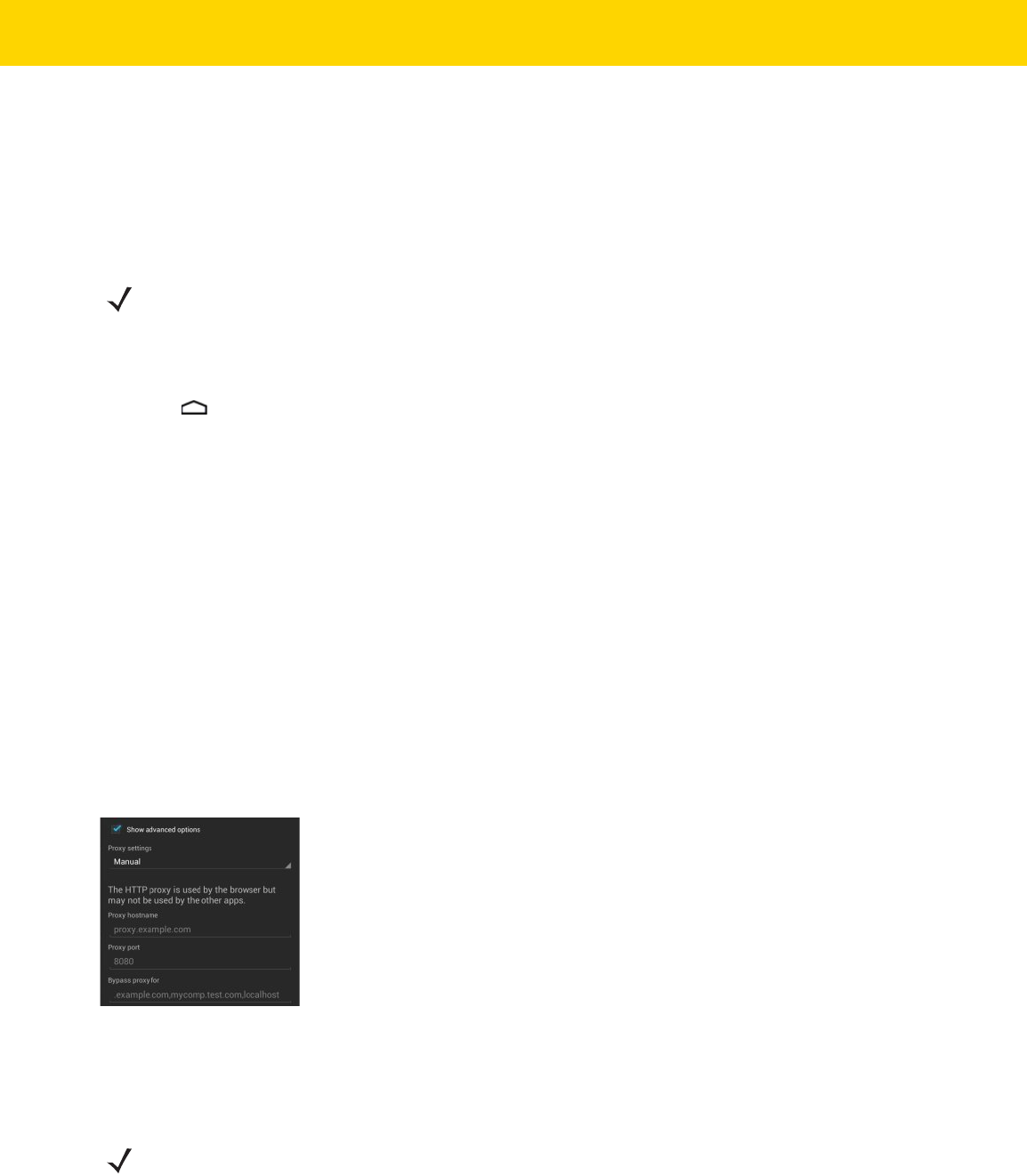
Wireless 4 - 5
•
If required, touch User certificate and select a user certificate. Note: User certificates are installed using
the Security settings.
•
If required, in the Identity text box, enter the username credentials.
•
If desired, in the Anonymous identity text box, enter an anonymous identity username.
•
If required, in the Password text box, enter the password for then given identity.
1. Touch Connect.
2. Touch .
Configuring for a Proxy Server
A proxy server is a server that acts as an intermediary for requests from clients seeking resources from other
servers. A client connects to the proxy server, requesting some service, such as a file, connection, web page, or
other resource, available from a different server. The proxy server evaluates the request according to its filtering
rules. For example, it may filter traffic by IP address or protocol. If the request is validated by the filter, the proxy
provides the resource by connecting to the relevant server and requesting the service on behalf of the client.
It is important for enterprise customers to be able to set up secure computing environments within their companies,
and proxy configuration is an essential part of doing that. Proxy configuration acts as a security barrier ensuring
that the proxy server monitors all traffic between the Internet and the intranet. This is normally an integral part of
security enforcement in corporate firewalls within intranets.
1. In the Wi-Fi list, touch a network.
2. Touch Show advanced options checkbox.
3. Touch Proxy settings and select Manual.
Figure 4-4 Proxy Settings
4. In the Proxy hostname text box, enter the address of the proxy server.
5. In the Proxy port text box, enter the port number for the proxy server.
6. In the Bypass proxy for text box, enter addresses for web sites that do not require to go through the proxy
server. Use the separator “|” between addresses.
By default, the network Proxy is set to None and the IP settings is set to DHCP. See Configuring for a
Proxy Server on page 4-5 for setting connection to a proxy server and see Configuring the Device to
Use a Static IP Address on page 4-6 for setting the device to use a static IP address.
NOTE
When entering proxy addresses the Bypass proxy for field, do not use spaces or carriage returns between
addresses.
Review Copy
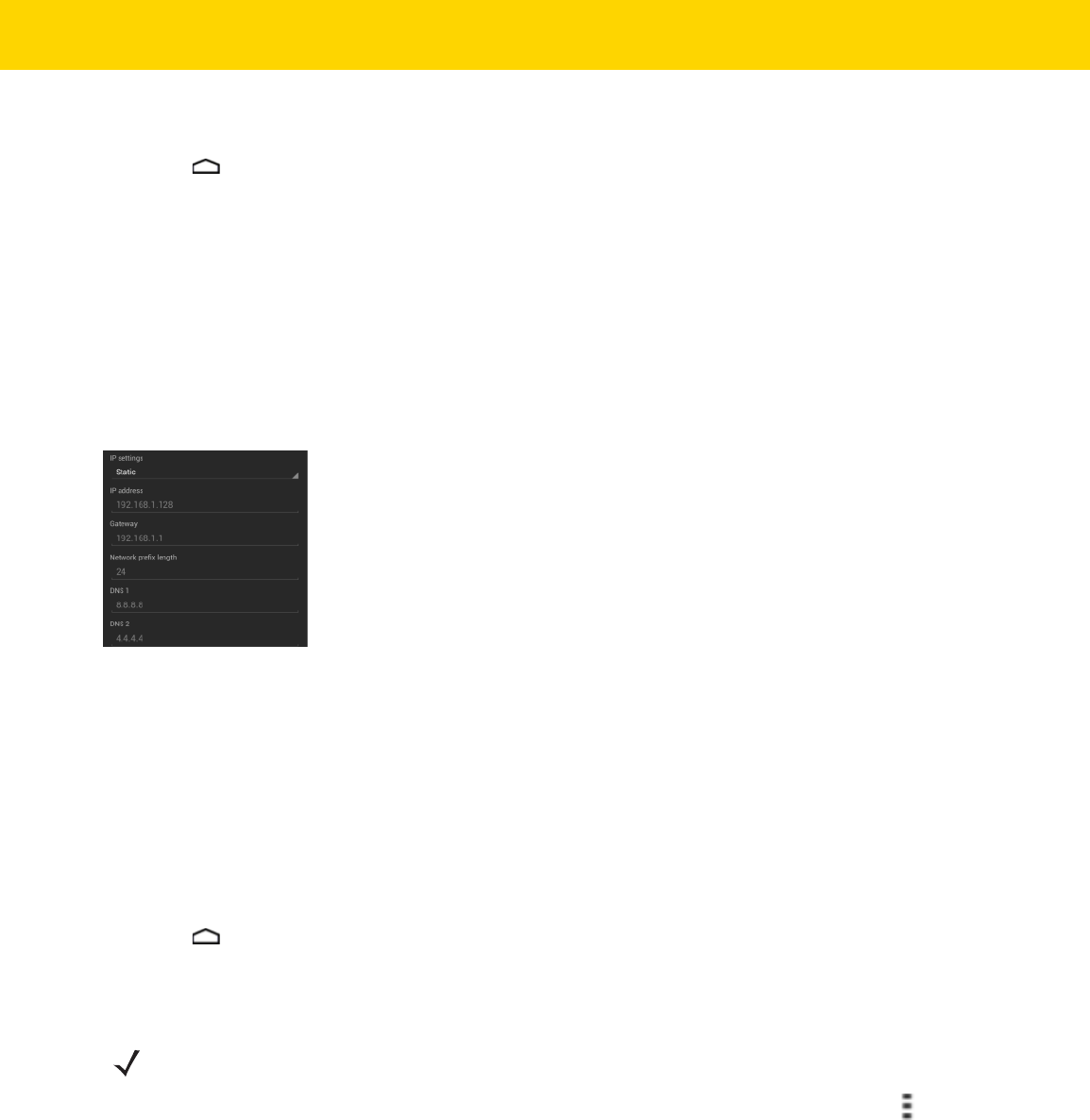
4 - 6 TC8000 User Guide
7. Touch Connect.
8. Touch .
Configuring the Device to Use a Static IP Address
By default, the device is configured to use Dynamic Host Configuration Protocol (DHCP) to assign an Internet
protocol (IP) address when connecting to a wireless network. To configure the device to connect to a network using
a static IP address:
1. In the Wi-Fi list, touch a network.
2. Touch Show advanced options checkbox.
3. Touch IP settings and select Static.
Figure 4-5 Static IP Settings
4. In the IP address text box, enter an IP address for the device.
5. If required, in the Gateway text box, enter a gateway address for the device.
6. If required, in the Network prefix length text box, enter a the prefix length.
7. If required, in the DNS 1 text box, enter a Domain Name System (DNS) address.
8. If required, in the DNS 2 text box, enter a DNS address.
9. Touch Connect.
10. Touch .
Advanced Wi-Fi Settings
Use the Advanced settings to configure additional Wi-Fi settings. From the Wi-Fi screen, touch > Advanced to
view the advanced settings.
•
General
• Network notification - When enabled, notifies the user when an open network is available.
• Keep Wi-Fi on during sleep - Opens a menu to set whether and when the Wi-Fi radio turns off.
•Always On - The radio stays on when the device enters suspend mode.
•Only when plugged in - The radio stays on while the device is connected to external power.
NOTE
Advanced Wi-Fi settings are for the device not for a specific wireless network.
Review Copy
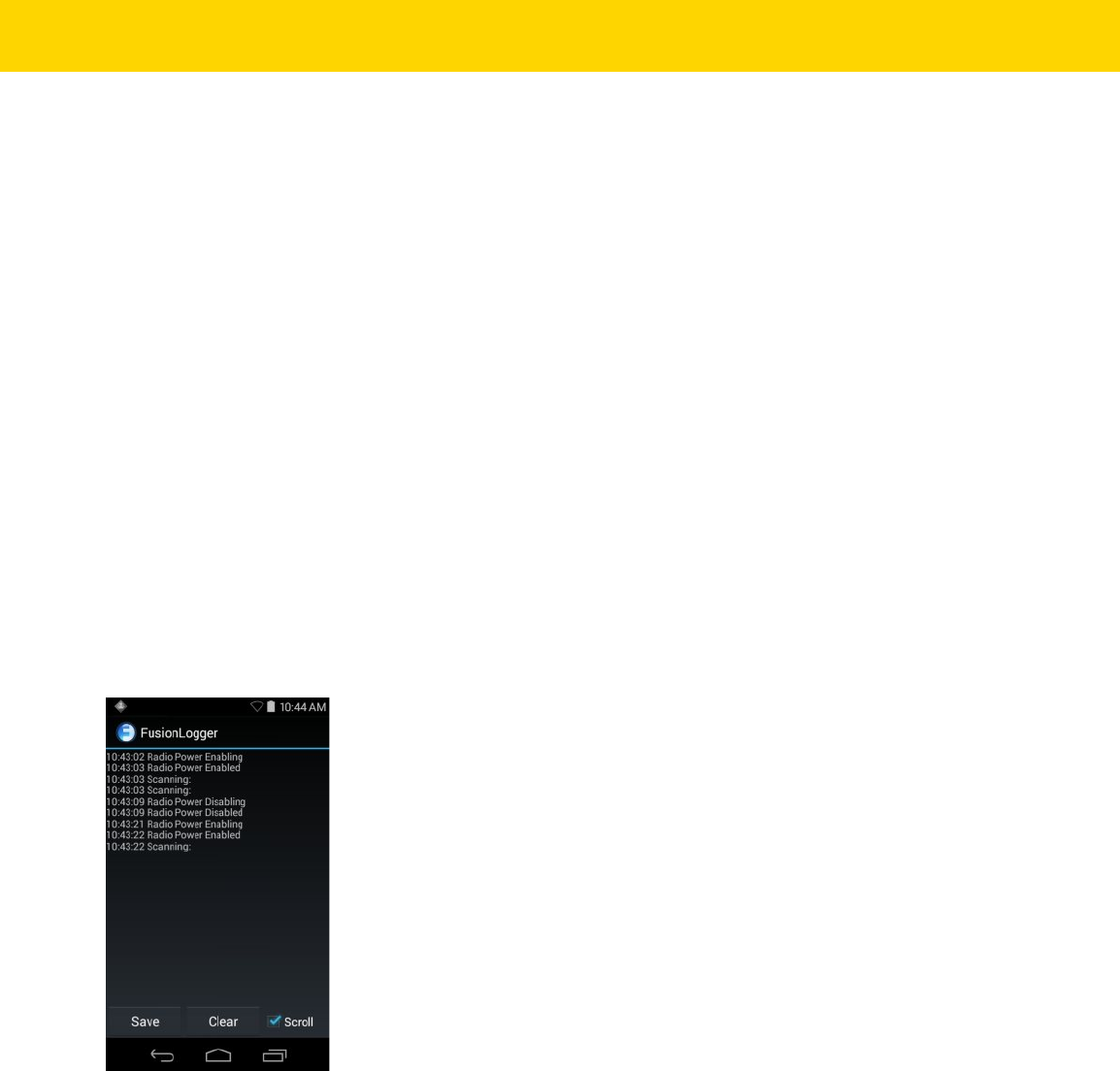
Wireless 4 - 7
•Never On - The radio turns off when the device enters suspend mode (default).
• Install Certificates – Touch to install certificates.
• MAC address - Displays the Media Access Control (MAC) address of the device when connecting to
Wi-Fi networks.
•
Regulatory
• Country selection - Displays the acquired country code if Auto is selected else displays the selected
country code. Default: Auto.
• Region code - Displays the configured region code for the device.
•
Band and Channel Selection
• Wi-Fi frequency band - Use to select the frequency band. Options: Auto (default), 5 GHz only or 2.4
GHz only.
• Available channels (2.4 GHz) - Use to select specific channels. Touch to display the Available channels
menu. Select specific channels. Touch OK.
• Available channels (5 GHz) - Use to select specific channels. Touch to display the Available channels
menu. Select specific channels. Touch OK.
•
Logging
• Advanced Logging – Touch to enable advanced logging.
• Wireless logs - Use to capture Wi-Fi log files.
•Fusion Logger - Touch to open the Fusion Logger application. This application maintains a history of
high level WLAN events which helps to understand the status of connectivity.
Figure 4-6 Fusion Logger Screen
•Fusion Status - Touch to display live status of WLAN state. Also provides information of device and
connected profile.
Review Copy
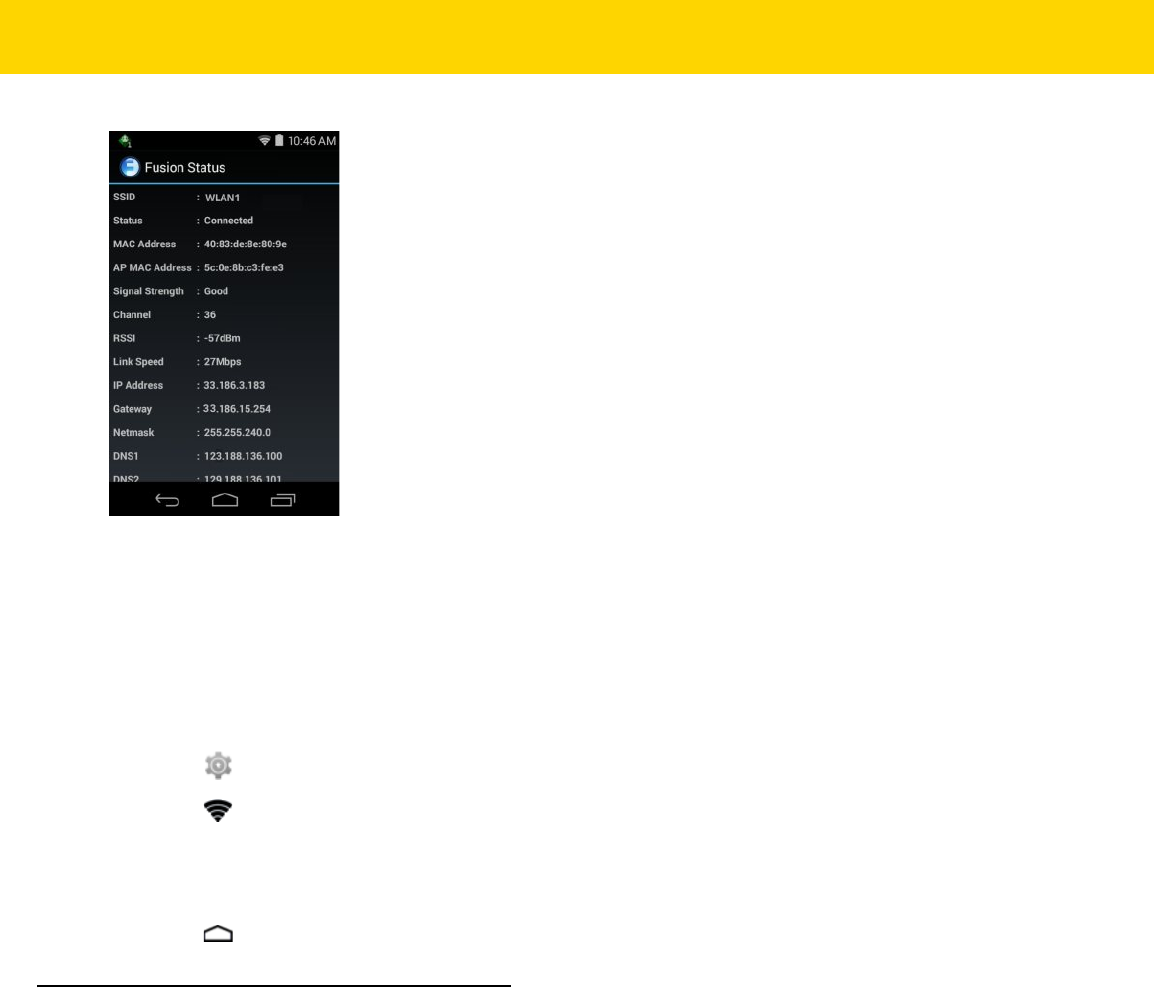
4 - 8 TC8000 User Guide
Figure 4-7 Fusion Status Screen
•
About
•Version - Displays the current Fusion information.
Remove a Wi-Fi Network
To remove a remembered or connected network:
1. Touch .
2. Touch Wi-Fi.
3. In the Wi-Fi networks list, touch and hold the name of the network.
4. In the menu, touch Forget network.
5. Touch .
Wi-Fi Advanced Features
Some additional Wi-Fi settings cannot be accessed from the User Interface. They can be configured by using Wi-Fi
(CSP). Refer to EMDK documentation for the details on the Wi-Fi settings configuration using the Wi-Fi CSP.
•
Auto Time Config - Using this feature, the device can sync up its time with Zebra WLAN infrastructure. This
feature works only when the device is connected to Zebra WLAN infrastructure and the feature is enabled on
the WLAN infrastructure side. Default: disabled.
•
PMKID Caching - Allows the device to skip 802.1x authentication during roaming if it had previously
connected to that AP with a full 802.1x authentication. Default: disabled. Note: disable OKC when enabling
PMKID Caching.
•
Opportunistic Key Caching - Use this feature to skip 802.1x authentication during roaming. The device will
go for full 802.1x authentication for the first time it connects to the network. For subsequent roaming, the
device skips 802.1x authentication. Default: enabled.
Review Copy

Wireless 4 - 9
•
Cisco Centralized Key Management - Allows the device to skip 802.1x and key-handshake phases during
roaming. This feature is available only when the device is connected to a Cisco infrastructure that supports
Cisco Centralized Key Management (CCKM). Default: enabled.
•
Fast Transition - Fast Transition (FT) is the fast roaming standard, 802.11r. With this feature, the device can
skip 802.1x and key-handshake phases during roam. Default: enabled.
•
Fast Transition Resource Information Container - Allows the device to request TSPEC as part of
reassociation frame exchange. This helps to avoid sending a separate resource request after roaming is
completed. Default: disabled.
•
Power Save - The device can be configured to work in different power save modes:
i. Active - Keeps the WLAN radio always in active mode (i.e. power save mode disabled).
ii. Power save using WMM-PS - This is the default power save mode. Device uses WMM-PS power
save method if the AP is configured to use this. If the AP is not supporting WMM-PS, the device will
use PS-Poll power save method.
iii. Power save using PS-Poll - In this method, the device will use PS-Poll frames to retrieve buffered
frames from the AP.
iv. Null Data Power Save - In Null Data Power Save (NDP), the device will stay awake for 100 ms after
the last frame is sent or received. The device will send a Null Data packet with power management bit
cleared to retrieve buffered frames from the AP.
•
FIPS - The device supports FIPS 140-2 Level 1. In this mode, the device will not support TKIP and WEP
encryption modes. When Wi-Fi is enabled, the stack will run predefined tests to make sure that the
encryption engine is working correctly and the firmware and firmware loader modules are correct.
•
802.11k - Using 802.11k, the device can discover neighbor APs and adds support for different types of radio
resource measurements. Default: enabled.
•
Band Preference - The device can be configured to prefer one band over another. By default, device prefers
5 GHz frequency band over 2.4 GHz.
•
Subnet Roaming - When the device roams between different sub networks, if it detects that it is roaming to
a different subnet, the device will request a fresh IP address. Default: disabled.
Zebra Mobility Extensions
Zebra Mobility Extensions make use 802.11 specifications and Zebra proprietary extensions to achieve the highest
level of performance, efficiency and reliability. The TC8000 adds support for the following Zebra Mobility
Extensions.
•
Coverage Hole Detection - The TC8000 includes enhancements to the IEEE 802.11k standard. These
improvements will report gaps in signal coverage to the Zebra wireless LAN infrastructure. Network
administrators can detect and mitigate coverage gaps present in the network for greater reliability. Default:
enabled.
•
• Aggregated Fast Transition - Aggregated FT improves on IEEE 802.11r, Over-the-DS fast roaming. In
conjunction with Zebra wireless LAN infrastructure, the TC8000 will achieve more reliable and consistent fast
roaming. Default: enabled.
•
• Scan Assist - The TC8000 monitors neighbor access points and retrieves roaming related information from
the Zebra wireless LAN infrastructure without doing scans. Using this Scan Assist feature, the TC8000
improves roaming. Default: enabled.
Review Copy
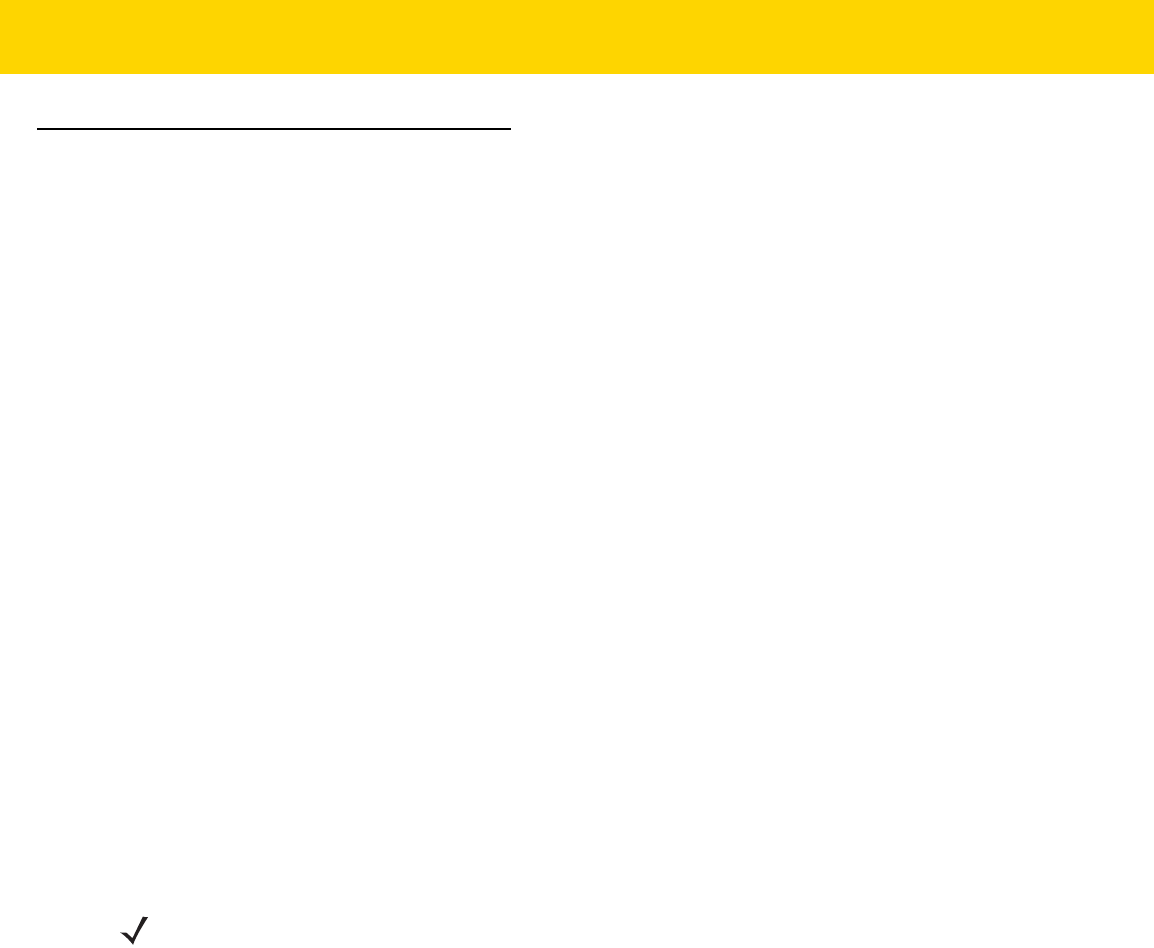
4 - 10 TC8000 User Guide
Bluetooth
Bluetooth-equipped devices can communicate without wires, using frequency-hopping spread spectrum (FHSS)
radio frequency (RF) to transmit and receive data in the 2.4 GHz Industry Scientific and Medical (ISM) band
(802.15.1). Bluetooth wireless technology is specifically designed for short-range (10 meters (32.8 feet))
communication and low power consumption.
Devices with Bluetooth capabilities can exchange information (e.g., files, appointments, and tasks) with other
Bluetooth enabled devices such as printers, access points, and other mobile devices.
Adaptive Frequency Hopping
Adaptive Frequency Hopping (AFH) is a method of avoiding fixed frequency interferers, and can be used with
Bluetooth voice. All devices in the piconet (Bluetooth network) must be AFH-capable in order for AFH to work.
There is no AFH when connecting and discovering devices. Avoid making Bluetooth connections and discoveries
during critical 802.11b communications. AFH for Bluetooth consists of four main sections:
•
Channel Classification - A method of detecting an interference on a channel-by-channel basis, or
pre-defined channel mask.
•
Link Management - Coordinates and distributes the AFH information to the rest of the Bluetooth network.
•
Hop Sequence Modification - Avoids interference by selectively reducing the number of hopping channels.
•
Channel Maintenance - A method for periodically re-evaluating the channels.
When AFH is enabled, the Bluetooth radio “hops around” (instead of through) the 802.11b high-rate channels. AFH
coexistence allows Enterprise devices to operate in any infrastructure.
The Bluetooth radio in this device operates as a Class 2 device power class. The maximum output power is 2.5
mW and the expected range is 10 meters (32.8 ft.). A definition of ranges based on power class is difficult to obtain
due to power and device differences, and whether one measures open space or closed office space.
Security
The current Bluetooth specification defines security at the link level. Application-level security is not specified. This
allows application developers to define security mechanisms tailored to their specific need. Link-level security
occurs between devices, not users, while application-level security can be implemented on a per-user basis. The
Bluetooth specification defines security algorithms and procedures required to authenticate devices, and if needed,
encrypt the data flowing on the link between the devices. Device authentication is a mandatory feature of Bluetooth
while link encryption is optional.
Pairing of Bluetooth devices is accomplished by creating an initialization key used to authenticate the devices and
create a link key for them. Entering a common personal identification number (PIN) in the devices being paired
generates the initialization key. The PIN is never sent over the air. By default, the Bluetooth stack responds with no
key when a key is requested (it is up to user to respond to the key request event). Authentication of Bluetooth
devices is based-upon a challenge-response transaction. Bluetooth allows for a PIN or passkey used to create
other 128-bit keys used for security and encryption. The encryption key is derived from the link key used to
authenticate the pairing devices. Also worthy of note is the limited range and fast frequency hopping of the
Bluetooth radios that makes long-distance eavesdropping difficult.
Recommendations are:
NOTE
It is not recommended to perform Bluetooth wireless technology inquiry when high rate 802.11b
operation is required.
Review Copy

Wireless 4 - 11
•
Perform pairing in a secure environment
•
Keep PIN codes private and do not store the PIN codes in the device
•
Implement application-level security.
Bluetooth Profiles
The device supports the following Bluetooth services:
•
Service Discovery Protocol (SDP) - Handles the search for known and specific services as well as general
services.
•
Serial Port Profile (SPP) - Allows use of RFCOMM protocol to emulate serial cable connection between two
Bluetooth peer devices. For example, connecting the device to a printer.
•
Generic Access Profile (GAP) - Controls connections in Bluetooth. Makes device visible and determines
how two devices communicate.
•
GATT -
•
Advanced Audio Distribution Profile (A2DP) - Allows the device to stream stereo-quality audio to a
wireless headset or wireless stereo speakers.
•
Audio/Video Remote Control Profile (AVRCP) - Allows the device to control A/V equipment to which a user
has access. It may be used in concert with A2DP.
•
Human Interface Device Profile (HID) - Allows Bluetooth keyboards, pointing devices, gaming devices and
remote monitoring devices to connect to the device.
•
FTP -
•
Object Push Profile (OPP) - Allows the device to push and pull objects to and from a push server.
Bluetooth Power States
The Bluetooth radio is off by default.
•
Suspend - When the TC8000 goes into suspend mode, the Bluetooth radio stays on.
•
Airplane Mode - When the TC8000 is placed in Airplane Mode, the Bluetooth radio turns off. When Airplane
mode is disabled, the Bluetooth radio returns to the prior state. When in Airplane Mode, the Bluetooth radio
can be turned back on if desired.
Bluetooth Radio Power
Turn off the Bluetooth radio to save power or if entering an area with radio restrictions (e.g., an airplane). When the
radio is off, other Bluetooth devices cannot see or connect to the device. Turn on the Bluetooth radio to exchange
information with other Bluetooth devices (within range). Communicate only with Bluetooth radios in close proximity.
Enabling Bluetooth
1. Touch .
NOTE
To achieve the best battery life turn off radios when not in use.
Review Copy
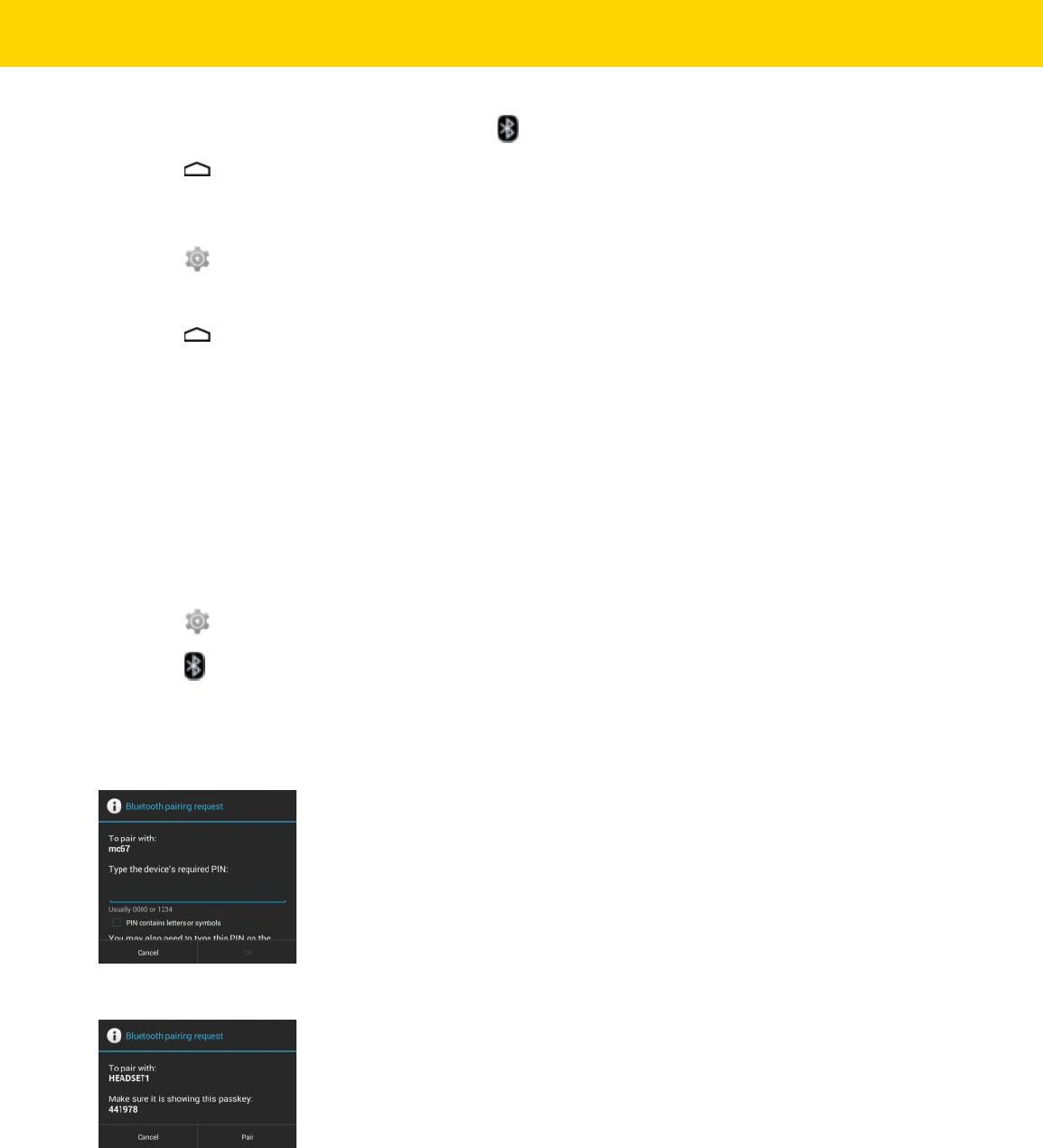
4 - 12 TC8000 User Guide
2. Slide the Bluetooth switch to the ON position. also appears in the Status bar.
3. Touch .
Disabling Bluetooth
1. Touch .
2. Slide the Bluetooth switch to the OFF position.
3. Touch .
Discovering Bluetooth Device(s)
The TC8000 can receive information from discovered devices without pairing. However, once paired, the TC8000
and a paired device exchange information automatically when the Bluetooth radio is on. To find Bluetooth devices
in the area:
1. Ensure that Bluetooth is enabled on both devices.
2. Ensure that the Bluetooth device to discover is in discoverable mode.
3. Ensure that the two devices are within 10 meters (32.8 feet) of one another.
4. Touch .
5. Touch Bluetooth.
6. Touch SCAN FOR DEVICES. The TC8000 begins searching for discoverable Bluetooth devices in the area
and displays them under AVAILABLE DEVICES.
7. Scroll through the list and select a device. The Bluetooth pairing request dialog box appears.
Figure 4-8 Bluetooth Pairing - Enter PIN
Figure 4-9 Bluetooth Pairing - Smart Pairing
8. Enter a PIN in the text box and touch OK. Enter the same PIN on the other device.
9. For Simple Pairing, touch Pair on both devices.
10. The Bluetooth device is added to the Bluetooth devices list and a trusted (“paired”) connection is established.
Review Copy
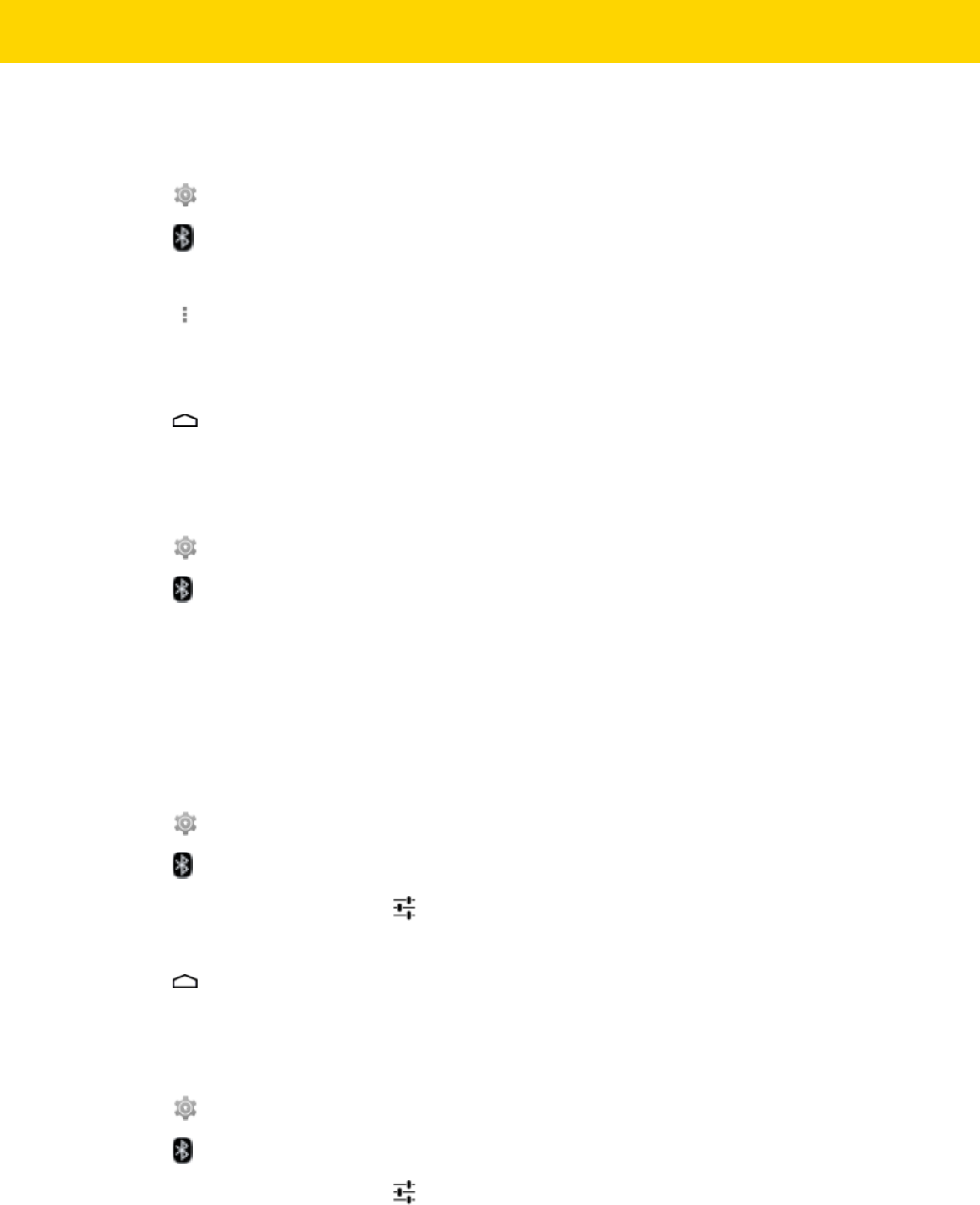
Wireless 4 - 13
Changing the Bluetooth Name
By default, the TC8000 has a generic Bluetooth name that is visible to other devices when connected.
1. Touch .
2. Touch Bluetooth.
3. If Bluetooth is not on, slide the switch to the ON position.
4. Touch .
5. Touch Rename device.
6. Enter a name and touch Done.
7. Touch .
Connecting to a Bluetooth Device
Once paired, connect to a Bluetooth device.
1. Touch .
2. Touch Bluetooth.
3. If Bluetooth is not on, slide the switch to the ON position.
4. In the PAIRED DEVICES list, touch and hold on a unconnected Bluetooth device until a menu appears.
5. Touch Connect. When connected, the device is displayed as connected in the list.
Selecting Profiles on the Bluetooth Device
Some Bluetooth devices have multiple profiles. To select a profile:
1. Touch .
2. Touch Bluetooth.
3. In the PAIRED DEVICES list, touch next to the device name.
4. Under PROFILES, check or uncheck a profile to allow the device to use that profile.
5. Touch .
Unpairing a Bluetooth Device
To unpair a Bluetooth device and erase all pairing information:
1. Touch .
2. Touch Bluetooth.
3. In the PAIRED DEVICES list, touch next to the device name.
Review Copy

4 - 14 TC8000 User Guide
4. Touch Unpair.
5. Touch .
Near Field Communications
NFC/HF RFID is a short-range wireless connectivity technology standard that enables secure transaction between
a reader and a contactless smartcard. The technology is based on ISO/IEC 14443 type A and B (proximity) and
ISO/IEC 15693 (vicinity) standards, using the HF 13.56 MHz unlicensed band. The TC8000 support 3 operating
modes:
•
Reader mode
•
Peer-to-Peer communication
•
Card Emulation mode.
Using NFC, the TC8000 can:
•
Read contactless cards such as contactless tickets, ID cards and ePassport.
•
Read and write information to contactless cards such as SmartPosters and tickets, as well as devices with
NFC interface such as vending machines.
•
Read information from supported medical sensors.
•
Pair with supported Bluetooth devices such as printers and headsets.
•
Exchange data with another NFC device.
•
Emulate contactless card such as payment, ticket or SmartPoster.
The TC8000 NFC antenna is uniquely positioned to read NFC cards from the back of the device while being held in
the user's hand.
Reading NFC Cards
1. Launch an NFC enabled application.
2. Hold device as shown.
Review Copy

Wireless 4 - 15
Figure 4-10 Reading Cards
3. Move TC8000 close to the NFC card until the TC8000 detects the card.
4. Hold the card steadily until the transaction is complete (usually indicated by the application).
Sharing Information Using NFC
You can beam content like a web page, contact cards, pictures, YouTube links or location information from the
screen to another device by bringing the devices together back to back.
Make sure both devices are unlocked, support NFC, and have both NFC and Android Beam turned on.
1. Open a screen that contains a web page, video, photo or contact.
2. Move the back of the TC8000 toward the back of the other device.
When the devices connect, you hear a sound, the image on the screen reduces in size, the message Touch to
beam appears.
3. Touch anywhere on the screen. The transfer begins.
Enterprise NFC Settings
The Enterprise NFC Settings provides advanced configuration of the NFC radio.
To configure the NFC settings, touch Settings > More ... > Enterprise NFC Settings.
Review Copy
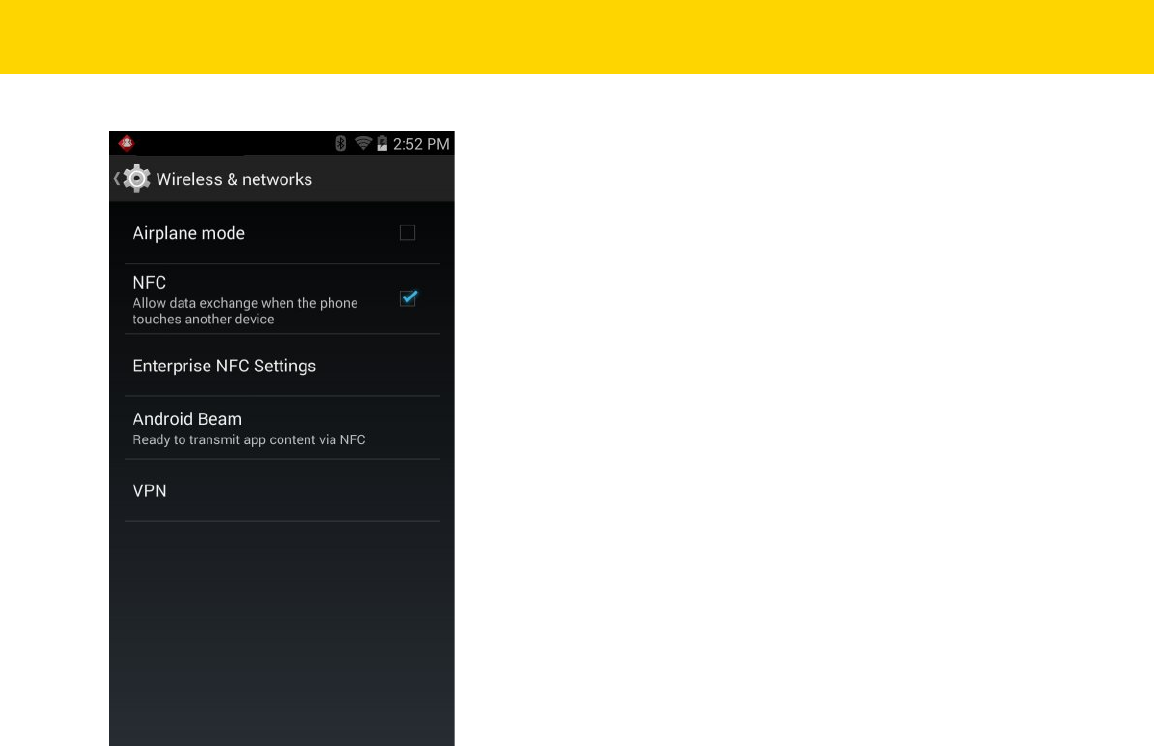
4 - 16 TC8000 User Guide
Figure 4-11 Wireless & Networks Screen
Review Copy
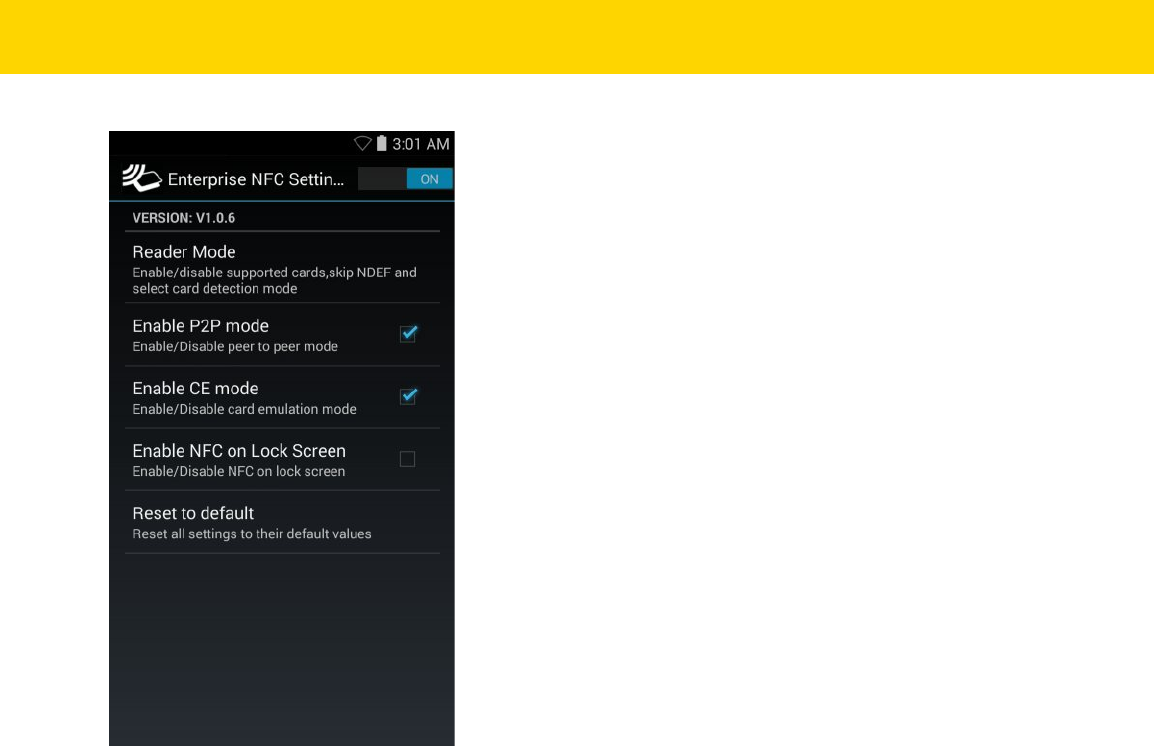
Wireless 4 - 17
Figure 4-12 Enterprise NFC Settings Screen
•
Reader Mode – Touch to open the Reader Mode setting screen.
•
Enable P2P mode – Enable or disable peer to peer mode. Default: Enabled.
•
Enable CE mode – Touch to enable or disable card emulation mode. Default: Enabled.
•
Enable NFC on Lock Screen – Enable or disable NFC on lock screen. Default: Disabled.
•
Reset to Default – Reset all NFC settings to factory default settings.
Reader Mode
Use the Reader Mode settings to configure the NFC radio.
Review Copy
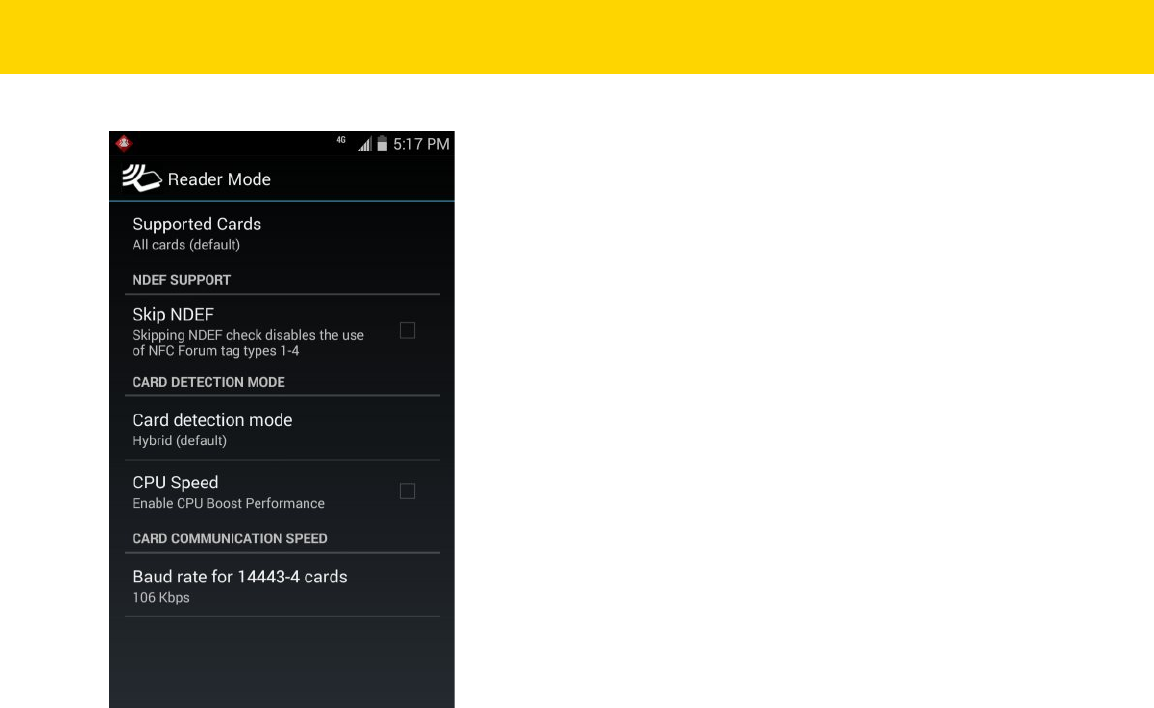
4 - 18 TC8000 User Guide
Figure 4-13 Reader Mode Settings
•
Supported Cards – Touch to select the type of NFC cards to support. Options: All Cards (default), Type A,
Type B, Type F or Type V.
•
NDEF Support
•Skip NDEF – Enables or disables the use of NFC Forum tag types 1 through 4. Default: Disabled.
•
Card Detection Mode
• Card detection mode – Touch to select the card detection mode. Options: Low power, Standard or
Hybrid (default).
•CPU Speed – Touch to enhance NFC transaction performance while reading small amounts data. Default:
Disabled.
• Card Communication speed – Touch to set the baud rate for type A and type B cards. Options: 106
kbps (default for Type A), 212 kbps, 424 kbps or No restrictions (default for Type B).
•
Card Communication Speed
• Baud rate for 14443–4 cards - Options: 106 kbps (default), 212 kbps, 424 kbps or 848 kbps.
Review Copy
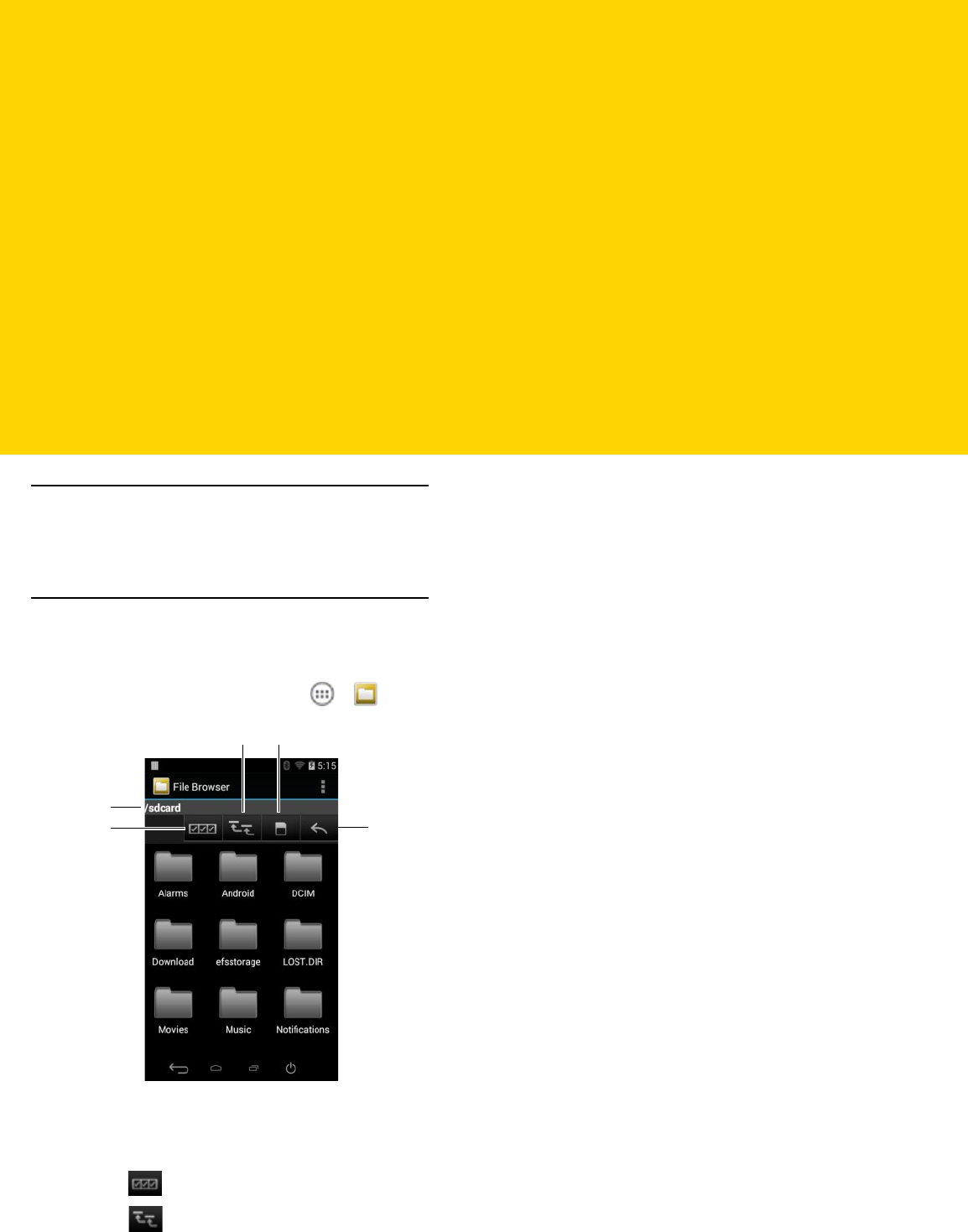
CHAPTER 5 APPLICATIONS
Introduction
This chapter describes the applications installed on the device.
File Browser
Use the File Browser application to view and mange files on the device.
To open File Browser, touch > .
Figure 5-1 File Browser Screen
The address bar (1) indicates the current folder path. Touch the current folder path to manually enter a path and
folder name.
Use (2) to select multiple files/folder.
Use (3) to view the internal storage root folder.
1
2
3 4
5
Review Copy
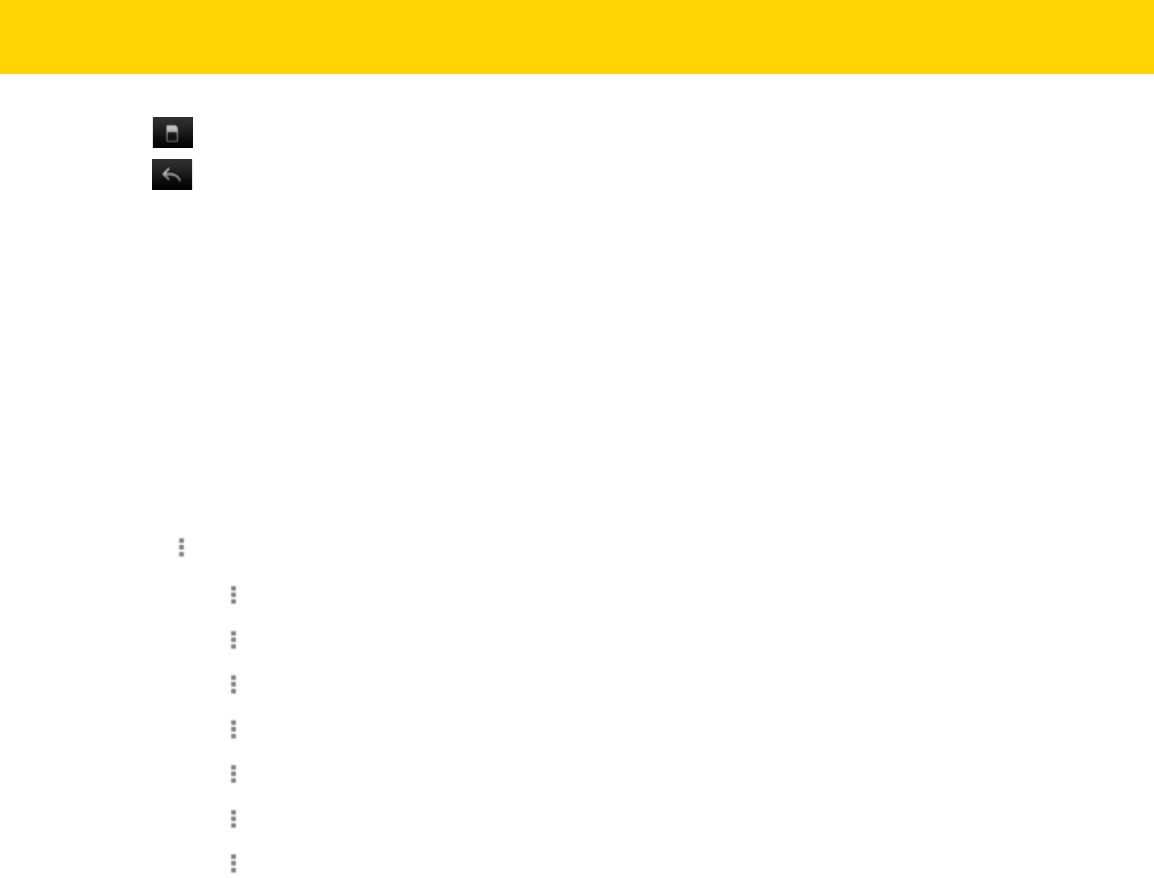
5 - 2 TC8000 User Guide
Use (4) to view the Internal Storage root folder.
Use (5) to view the previous folder or to exit the application.
Touch and hold an item to perform an operation on that item. Select one of the options from the File Operations
menu:
•
Information - View detailed information about the file or folder.
•
Move - Move the file or folder to a new location.
•
Copy - Copy the select file.
•
Delete - Delete the selected file.
•
Rename - Rename the select file.
•
Open as - Open the selected file as a specific file type.
•
Share - Share the file with other devices.
Touch to open additional functionality:
•
Touch > New Folder to create a new folder in the current folder.
•
Touch > Search to search for a file or folder.
•
Touch > Sort to sort the list by name, by type, by size or by date.
•
Touch > Refresh to re-display the contents of the current folder.
•
Touch > List View to change the folder view from tile to list format.
•
Touch > Change Size to change the size of the icons: Large, Normal or Small.
•
Touch > About File Browser to view the application version information.
Review Copy
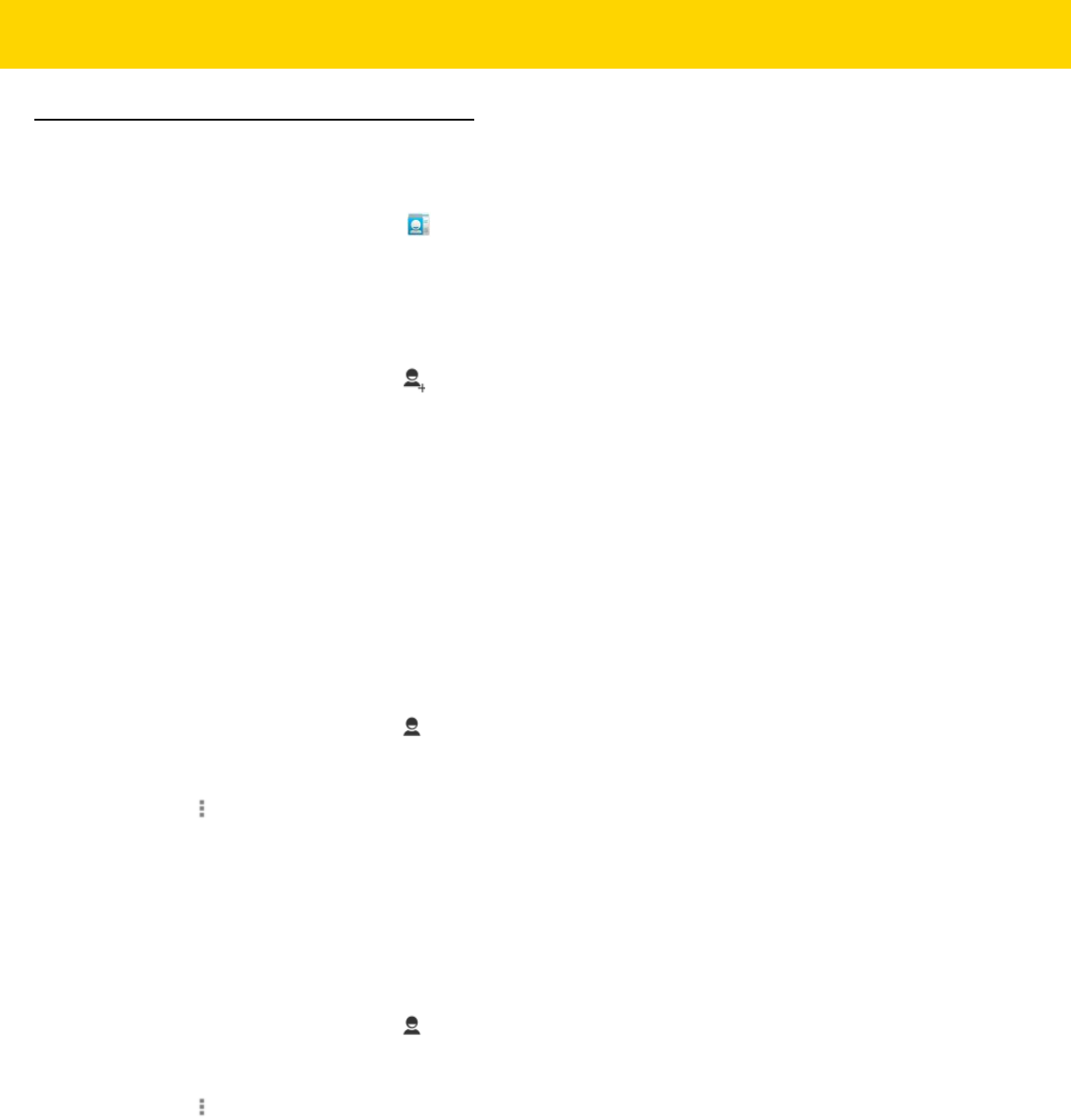
Applications 5 - 3
People
Use the People application to manage contacts.
From a Home or Apps screen, touch . People opens to the main list of contacts. View contacts in three ways at
the top of the screen: Groups, All contacts, and Favorites. Touch the tabs to change how to view the contacts.
Swipe up or down to scroll through the lists.
Adding People
1. In the People application, touch .
2. If there are more than one account with contacts, touch the one to use.
3. Type the contact’s name and other information. Touch a field to start typing, and swipe down to view all
categories.
4. To add more than one entry for a category – for example, to add a work address after typing a personal
address – touch Add new for that field. To open a menu with preset labels, such as Home or Work for an email
address, touch the label to the right of the item of contact information. Or, to create your own label, touch
Custom in the menu.
5. Touch Done.
Editing People
1. In the People application, touch tab.
2. Touch a person to edit.
3. Touch .
4. Touch Edit.
5. Edit the contact information.
6. Touch Done.
Deleting People
1. In the People application, touch tab.
2. Touch a person to edit.
3. Touch .
4. Touch Delete.
5. Touch OK to confirm.
Review Copy
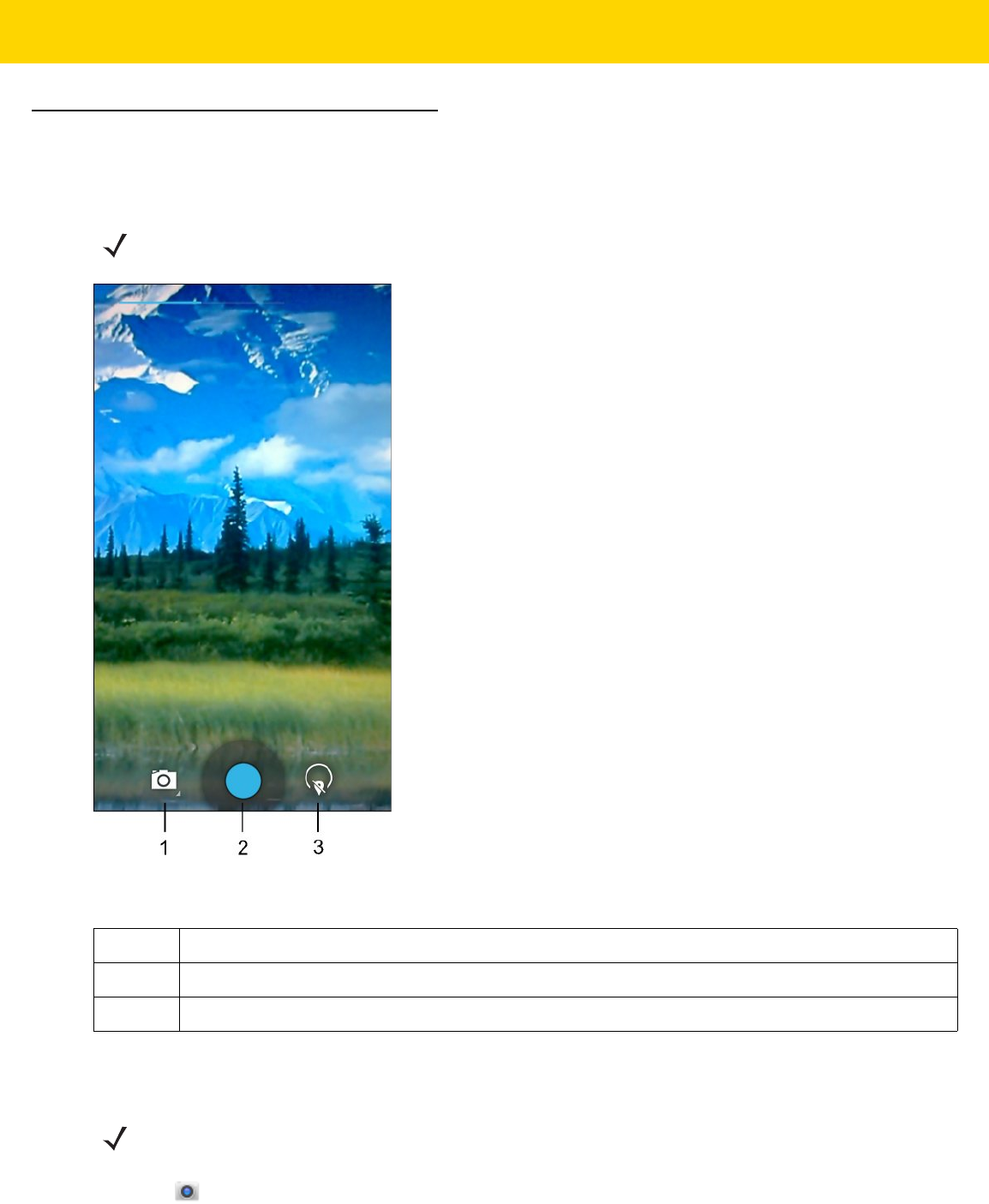
5 - 4 TC8000 User Guide
Camera
This section provides information for taking photos and recording videos using the integrated digital cameras.
Figure 5-2 Camera Photo Screen
Taking Photos
1. Touch .
NOTE
If a microSD card is installed, The TC8000 saves photos and videos on the microSD card. If a microSD
card is not installed, the TC8000 saves photos and videos on the internal storage.
1 Camera Options — Touch to select Camera, Video or Panorama mode.
2 Shutter button - Touch to take a photo, a panoramic photo or to record a video.
3 Photo Settings – Touch to select camera settings.
NOTE
Camera settings are described in Photo Settings on page 5-9.
Review Copy
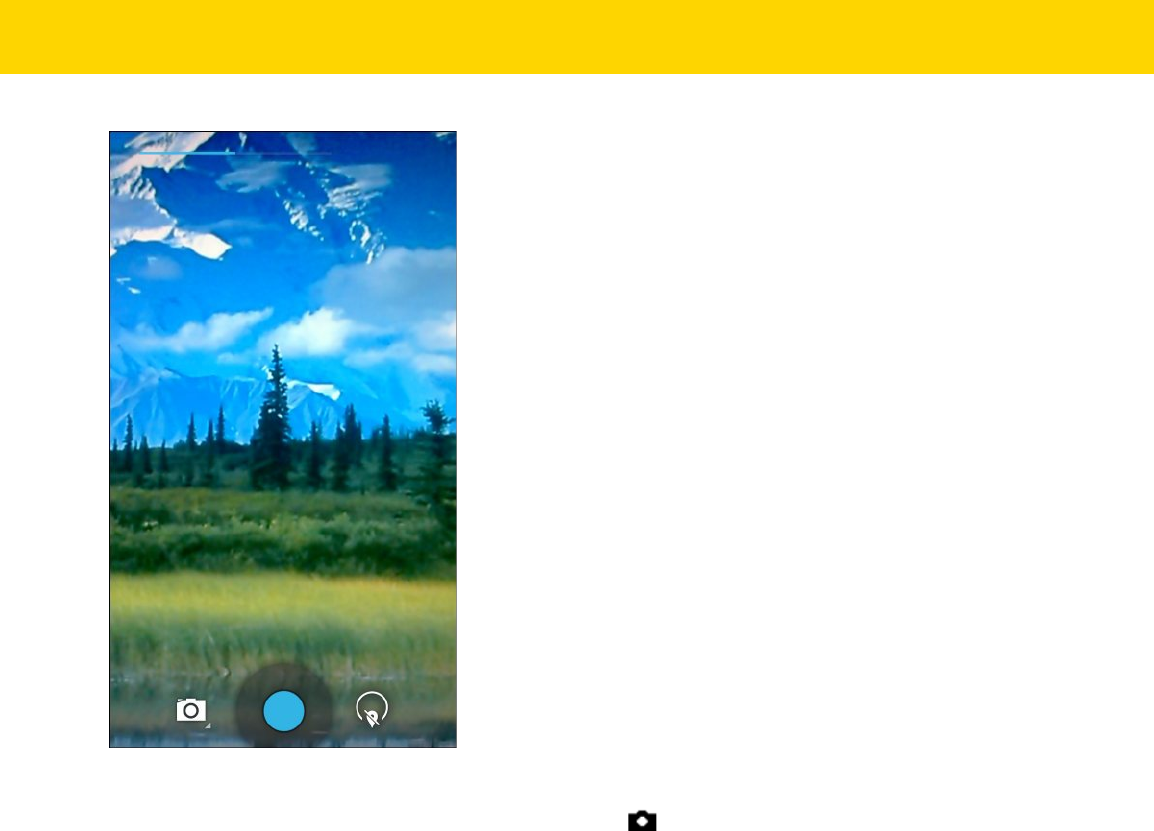
Applications 5 - 5
Figure 5-3 Camera Mode
2. If necessary, touch the camera options icon and touch .
3. Frame the subject on the screen.
4. To zoom in or out, press two fingers on the display and pinch or expand fingers. The zoom controls appear on
the screen.
Review Copy
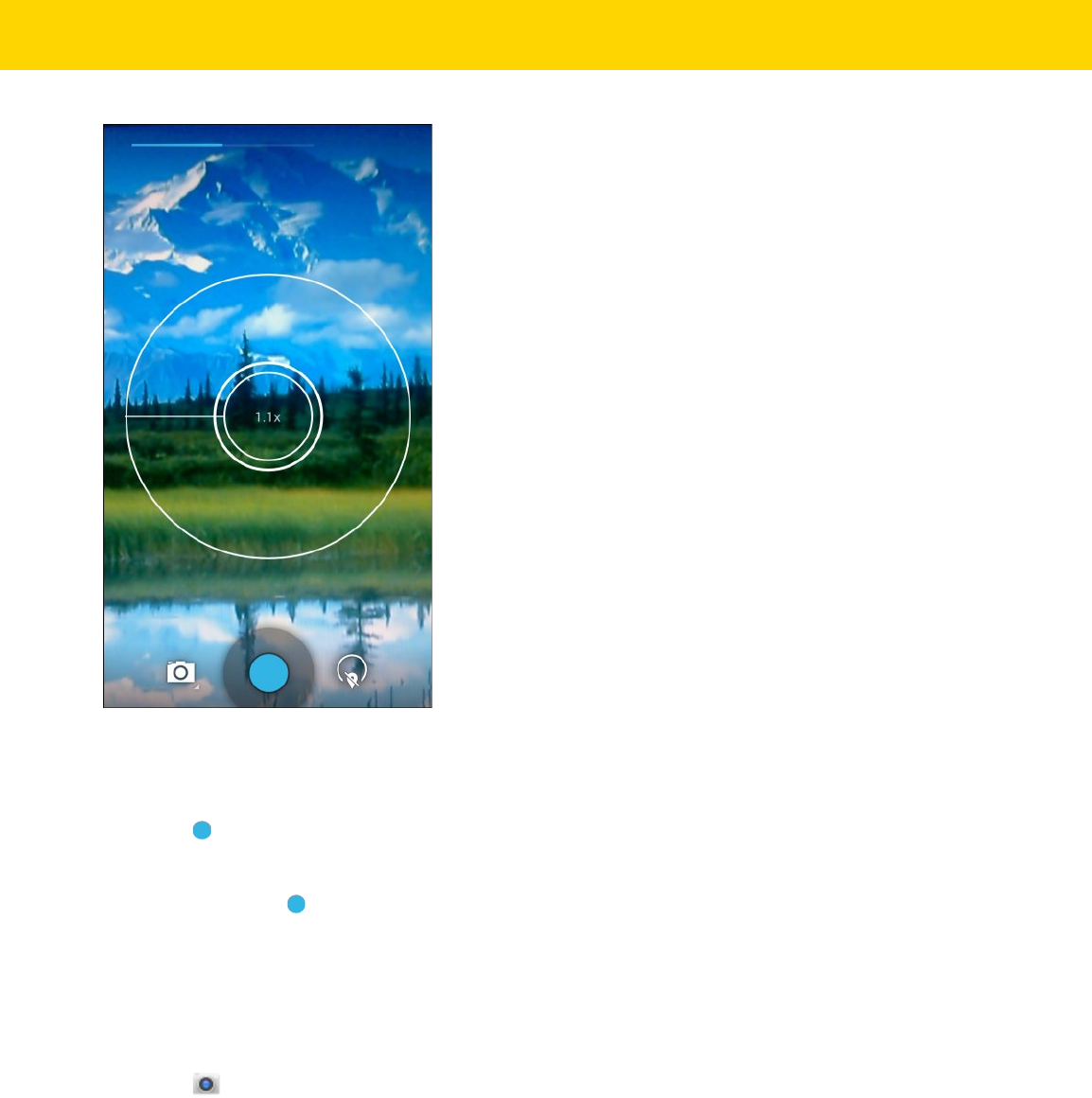
5 - 6 TC8000 User Guide
Figure 5-4 Camera Zoom
5. Touch an area on the screen to focus. The focus circle appears on the screen. The two horizontal bars turn
green when in focus.
6. Touch .
The camera takes a photo and a shutter sound plays.
Alternately, touch and hold to focus first, before taking a photo; then release to take a focused photo.
The photo momentarily displays as a thumbnail in the upper right corner.
Taking a Panoramic Photo
Panorama mode lets the user create a single wide image by panning slowly across a scene.
1. Touch .
Review Copy
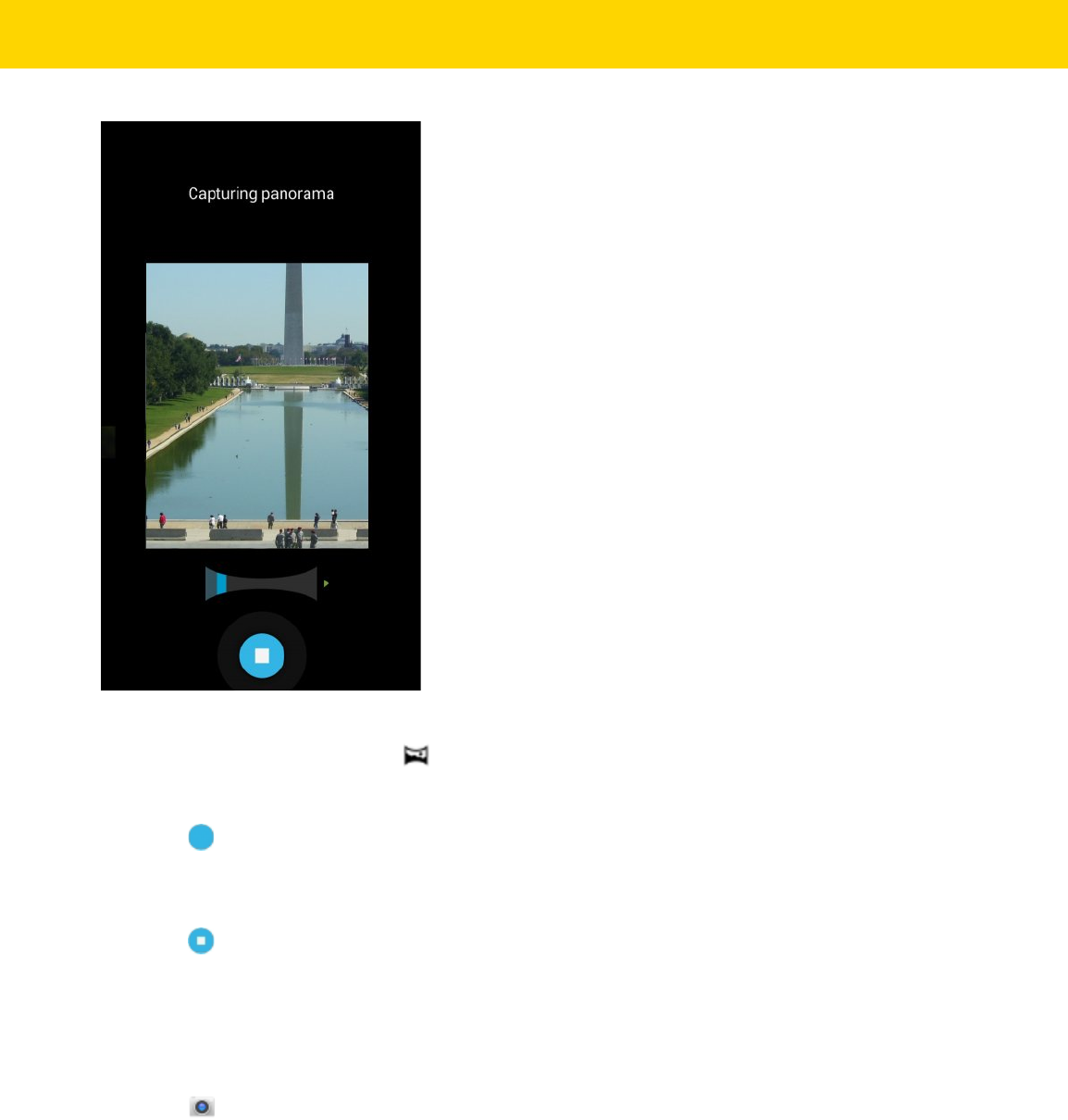
Applications 5 - 7
Figure 5-5 Panoramic Mode
2. Touch the options bar and touch .
3. Frame one side of the scene to capture.
4. Touch and slowly start panning across the area to capture. A small white square appears inside the button
indicating the capture is in progress.
If panning too quickly, the message Too fast appears.
5. Touch to end the shot. The panorama appears immediately and a progress indicator displays while it saves
the image.
Recording Videos
To record a video:
1. Touch .
Review Copy
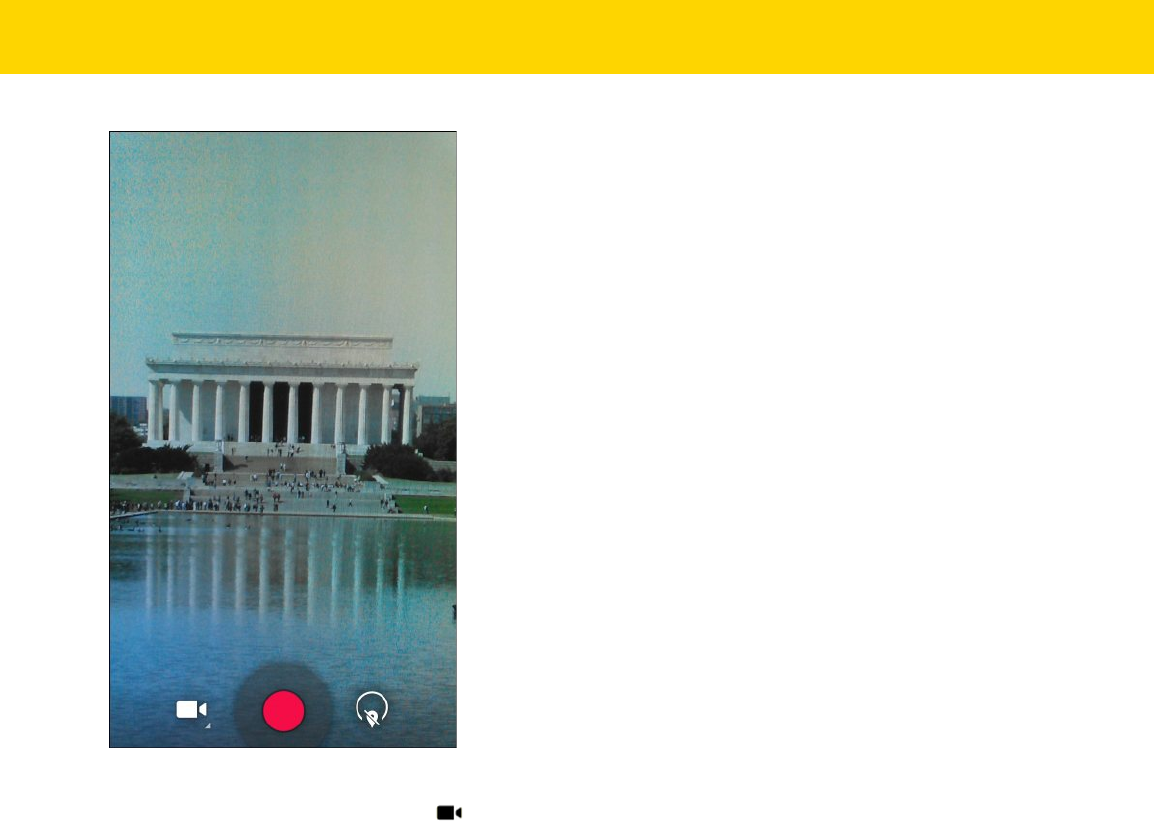
5 - 8 TC8000 User Guide
Figure 5-6 Video Mode
2. Touch the options bar and touch .
3. Point the camera and frame the scene.
4. To zoom in or out, press two fingers on the display and pinch or expand fingers. The zoom controls appear on
the screen.
Review Copy
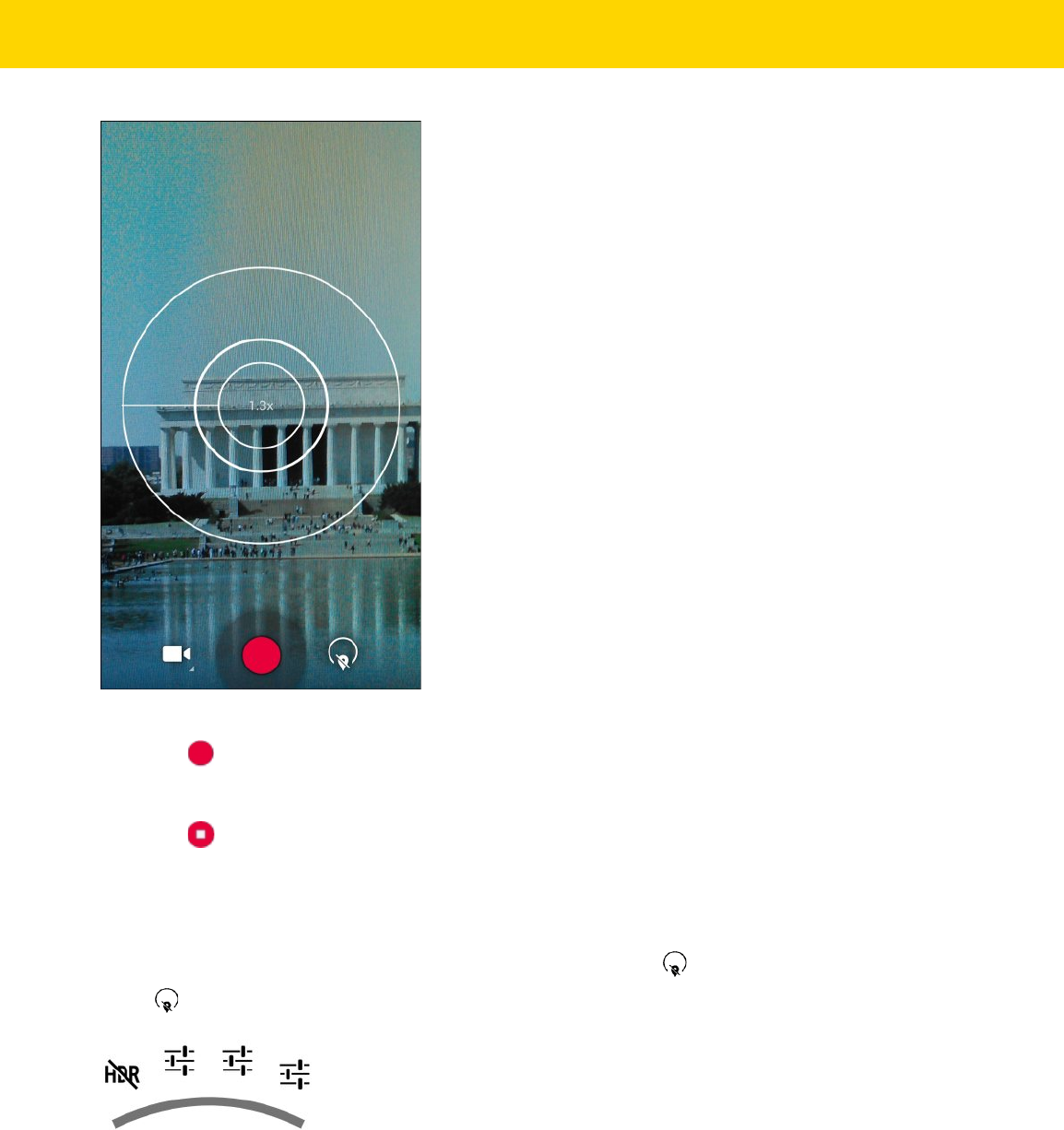
Applications 5 - 9
Figure 5-7 Camera Zoom
5. Touch to start recording.
The device starts recording the video. The video time appears in the top left of the screen.
6. Touch to end recording.
The video momentarily displays as a thumbnail in the upper right corner.
Photo Settings
When in Photo mode, photo settings are displayed on screen. Touch to display the photo settings options.
Touch to display the photo setting options.
Figure 5-8 Photo Setting Options
•
HDR – Touch to enable High Dynamic Range (HDR) imaging. HDR adds more dynamic range to
photographs (the ratio of light to dark). HDR uses three photos, taken at different exposures to create the
photo (default - disabled).
Review Copy
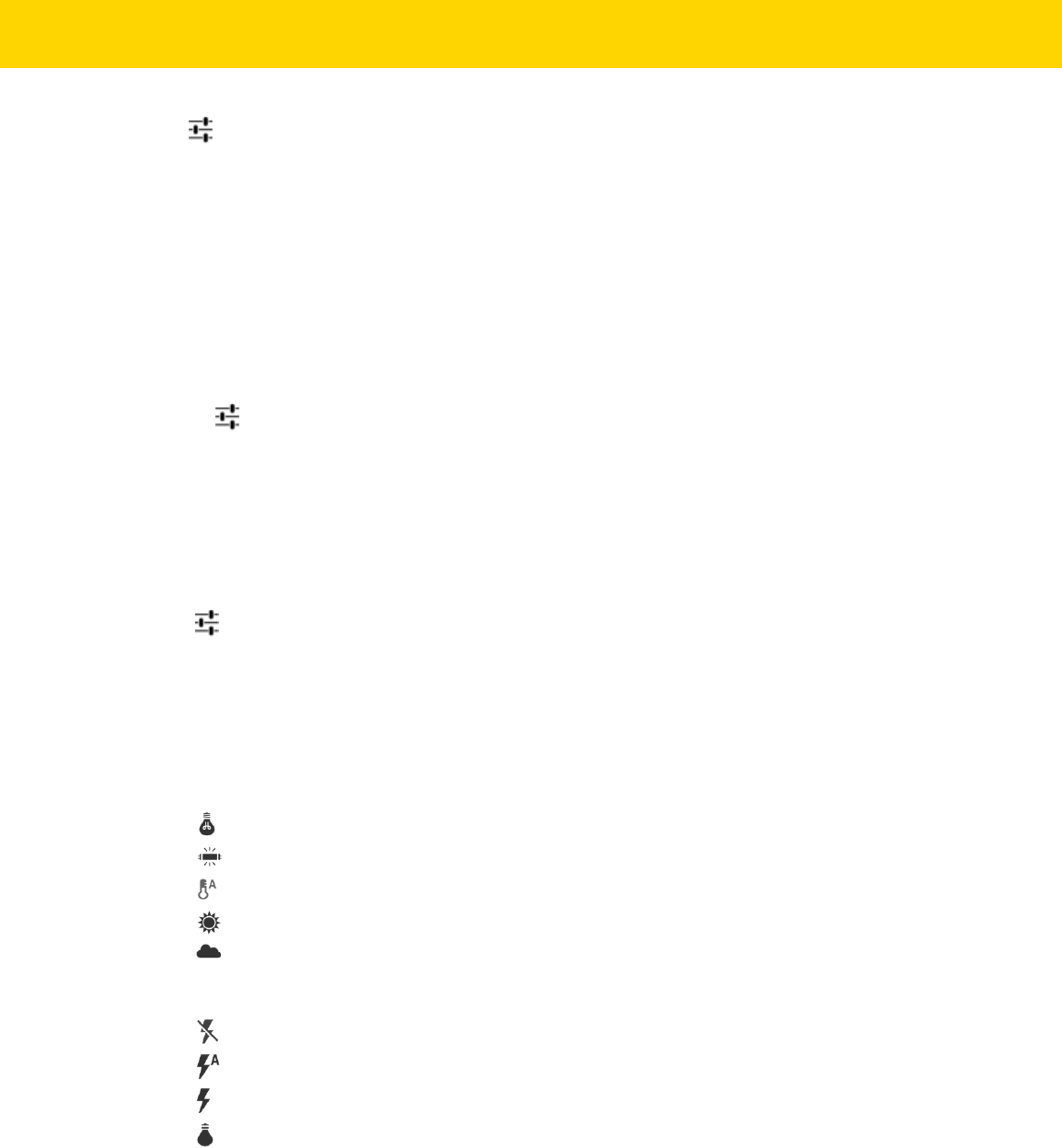
5 - 10 TC8000 User Guide
•
First :
• Scene mode - Touch to select a preset combination of camera settings designed for specific scenes.
Options: Auto (default), Night, Portrait, Landscape, Steady Photo, Sports or Document capture.
• Picture size - Touch to set the size (in pixels) of the photo. Options: 8M pixels (default), 5M pixels, 3M
pixels, HD 1080p, 2M pixels, 1.3M pixels, HD720, 1M pixels, WVGA, VGA or QVGA.
• Picture quality - Touch to select picture quality setting. Options: Super fine (default), Fine or Normal.
•ZSL - Set the camera to immediately take a picture when the button is pressed (default – disabled)
• Countdown timer - Options: Off (default), 1 second, 2 seconds, 3 seconds, 4 seconds, 5 seconds, 10
seconds, 15 seconds, 20 seconds, 30 seconds or 60 seconds.
• Beep during countdown - Select to play a beep tone during countdown (default – enabled).
•
Second :
• Face detection - Select to enable face detection (default – enabled).
• Touch AF/AEC - Select to enable auto focus (default – enabled).
• Sharpness - Touch to select a sharpness level. Options: Level 0, Level 1, Level 2, Level 3 (default),
Level 4, Level 5 or Level 6.
• Select Auto Exposure - Touch to select auto exposure setting. Options: Frame Average (default),
Center Weighted or Spot Metering.
•
Third :
• Anti Banding - Options: Off, 50 Hz, 60 Hz or Auto (default).
•Select ISO - Set how sensitive the camera is to light. Options: Auto (default), ISO Auto (HJR), ISO100,
ISO200, ISO400, ISO800 or ISO1600.
• Exposure - Touch to adjust the exposure settings. Options: +2, +1, 0(default), -1 or -2.
• White balance - Touch to select how Camera adjusts colors in different kinds of light, to achieve the most
natural-looking colors.
• Incandescent - Adjust the white balance for incandescent lighting.
• Fluorescent - Adjust the white balance for florescent lighting.
• Auto - Adjust the white balance automatically (default).
• Daylight - Adjust the white balance for daylight.
• Cloudy - Adjust the white balance for a cloudy environment.
• Flash mode - Touch to set whether Rear-facing Camera relies on its light meter to decide whether a flash
is necessary, or to turn it on or off for all shots.
• Off - Disable flash.
• Auto - Camera adjusts flash automatically depending upon light meter (default).
• On - Enable flash upon taking a photo.
• Torch - Turn flash on continuously.
• Focus Mode - Touch to select the camera focus setting. Options: Auto, Infinity, Macro or Continuous
Auto Focus (CAF) (default).
• AE-Bracket - Touch to set Automatic Exposure Bracketing (default – disabled).
Review Copy
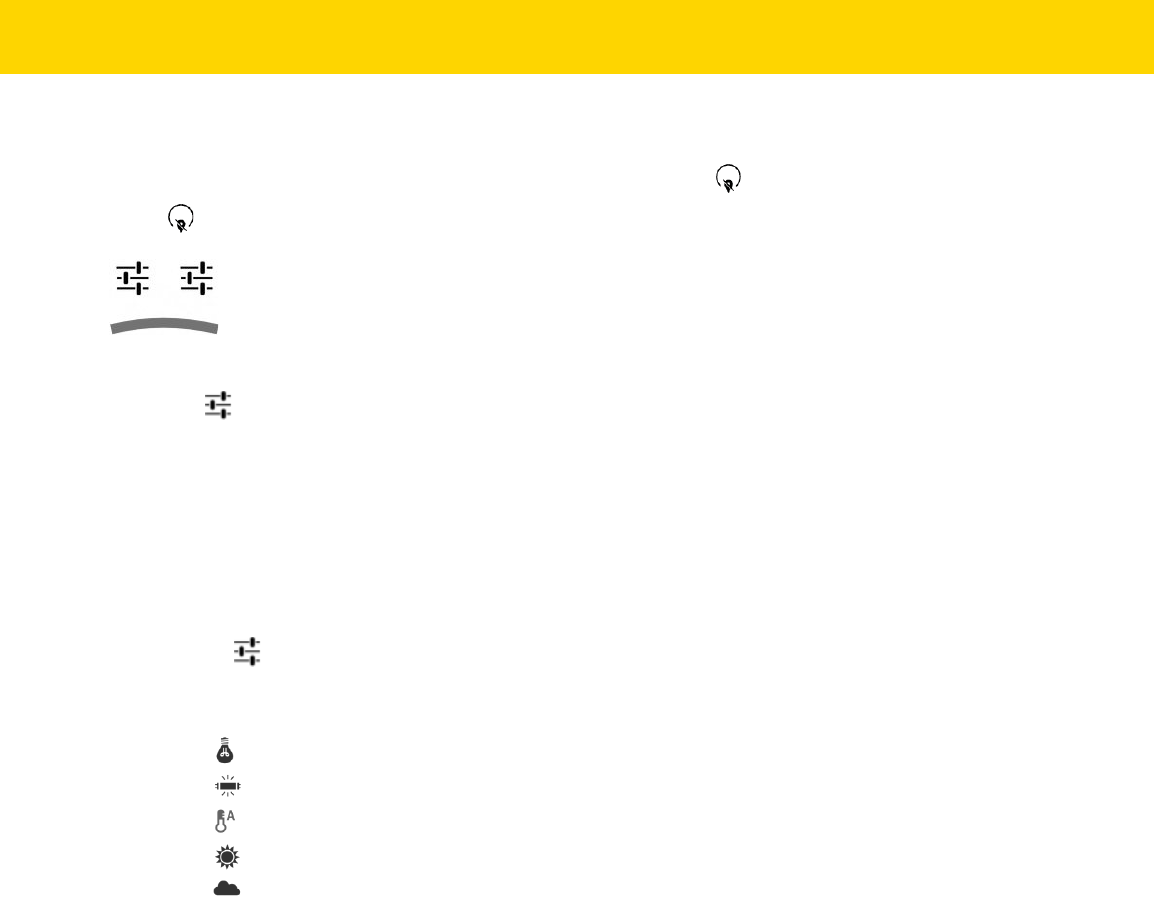
Applications 5 - 11
Video Settings
When in Video mode, video settings are displayed on screen. Touch to display the video settings options.
Touch to display the photo setting options.
Figure 5-9 Video Setting Options
•
First
•Time lapse - Touch to select a time interval to set the frame rate for time lapse photography. Options: Off
(default), Slide switch to ON and then set time interval.
• Video quality - Touch to select video quality:
•HD 1080p - High definition 1080p (default).
•HD 720p - High definition 720p.
•SD 480p - Standard definition 480p.
•Video duration - Options: 30 seconds (MMS) or 30 minutes (default).
•
Second
• White balance - Touch to select how Camera adjusts colors in different kinds of light, to achieve the most
natural-looking colors.
• Incandescent - Adjust the white balance for incandescent lighting.
• Fluorescent - Adjust the white balance for florescent lighting.
• Auto - Adjust the white balance automatically (default).
• Daylight - Adjust the white balance for daylight.
• Cloudy - Adjust the white balance for a cloudy environment.
• Flash mode - Select to turn on flash (default – disabled).
Review Copy
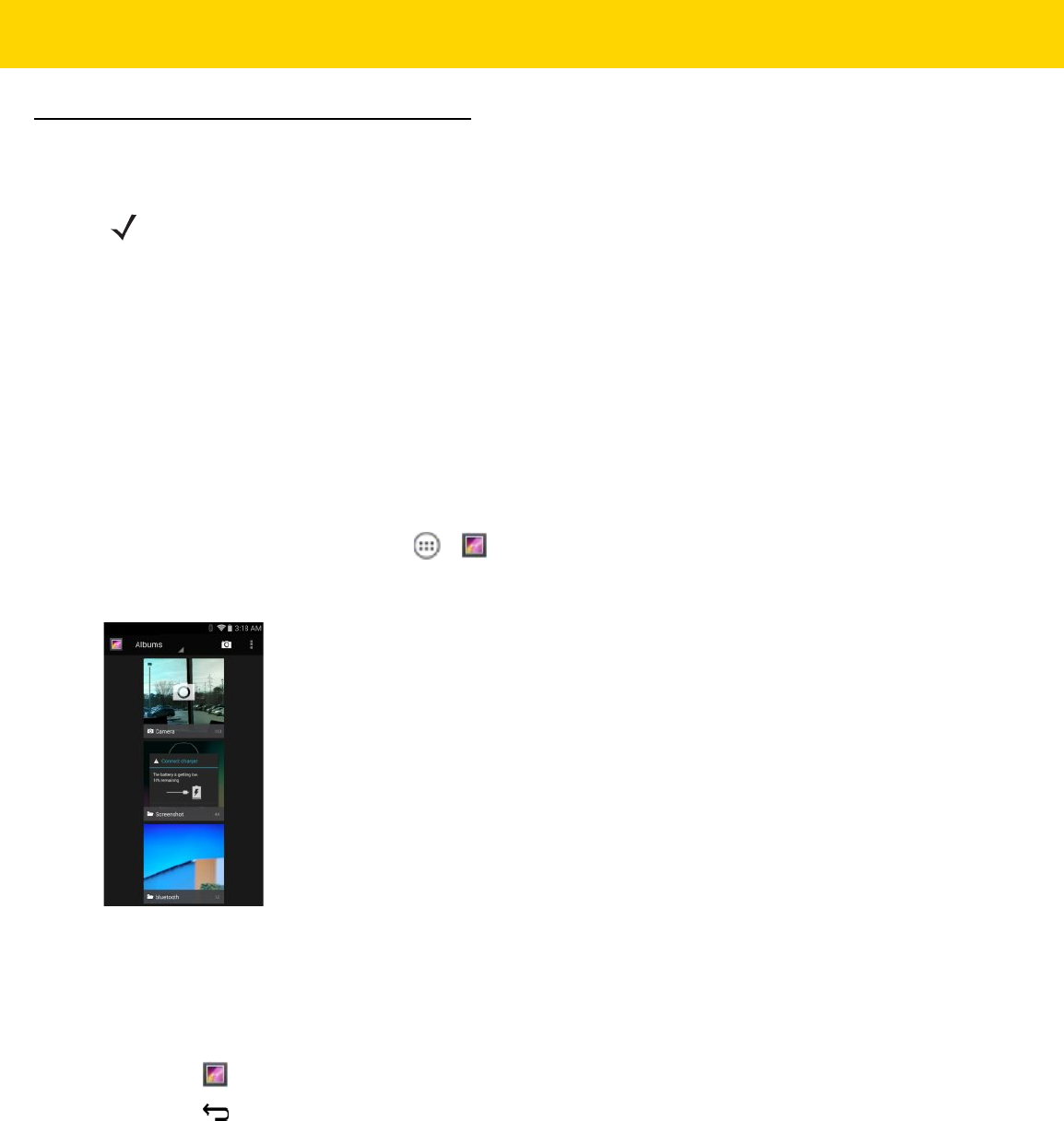
5 - 12 TC8000 User Guide
Gallery
Use Gallery to:
•
view photos
•
play videos
•
perform basic editing of photos
•
set photos as wallpaper
•
set photos as a contact photo
•
share photos and videos.
To open the Gallery application, touch > .
Gallery presents all photos and videos stored in memory.
Figure 5-10 Gallery — Albums
•
Touch an album to open it and view its contents. The photos and videos in the album are displayed in
chronological order.
•
Touch a photo or video in an album to view it.
•
Touch icon (top left corner) to return to the main Gallery screen.
•
Touch to return to the main Gallery screen.
Working with Albums
Albums are groups of images and videos in folders. Touch an album to open it. The photos and videos are listed in
a chronologically ordered grid. The name of the album displays at the top of the screen.
NOTE
The device supports the following image formats: jpeg, gif, png and bmp.
The device supports the following video formats: H.263, H.264 and MPEG4 Simple Profile.
Review Copy
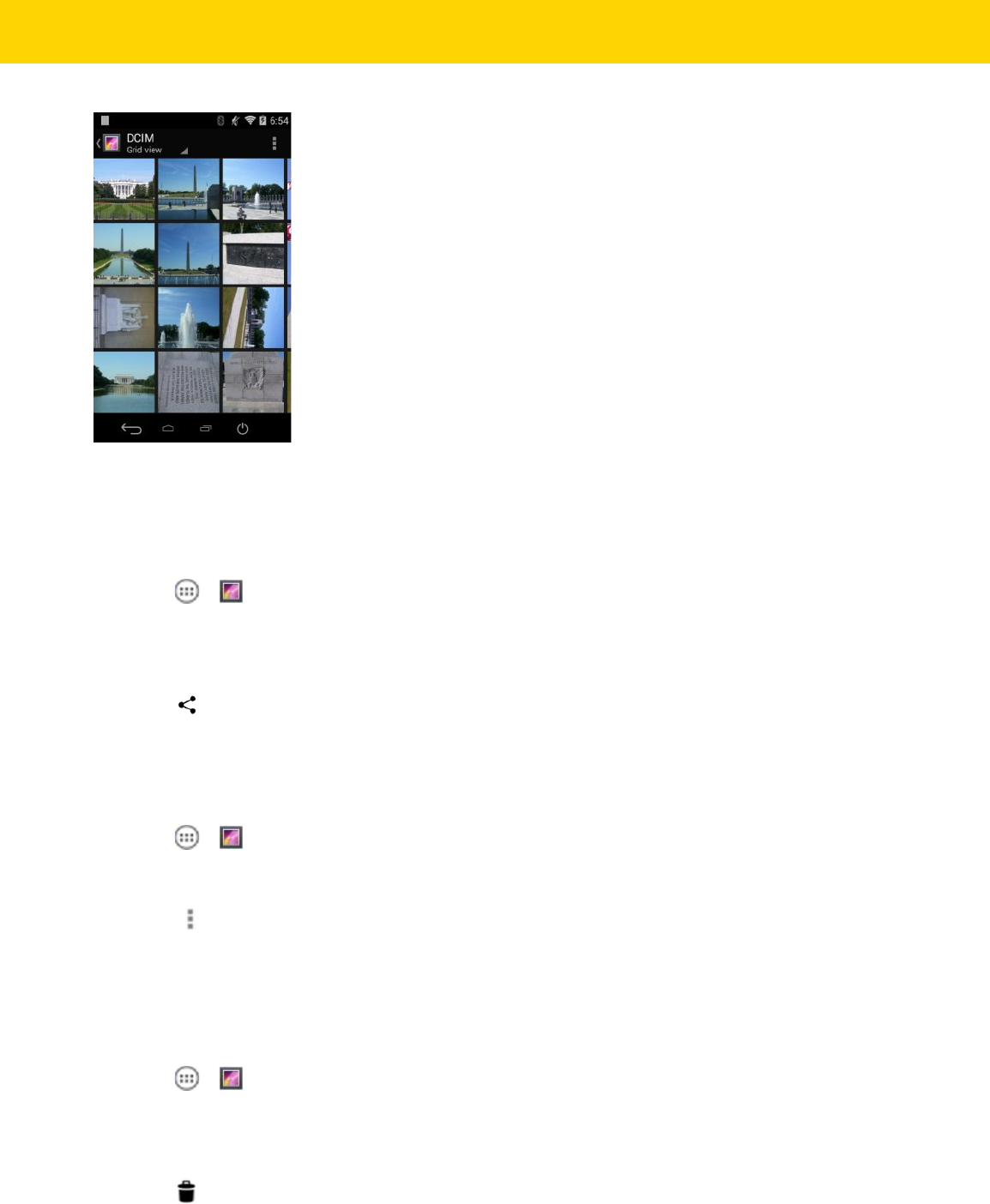
Applications 5 - 13
Figure 5-11 Photos Inside an Album
Swipe left or right to scroll images across the screen.
Share an Album
1. Touch > .
2. Touch and hold an album until it highlights.
3. Touch other albums as required.
4. Touch . The Share menu opens. Touch the application to use to share the selected albums.
5. Follow the instructions within the selected application.
Get Album Information
1. Touch > .
2. Touch and hold an album until it highlights.
3. Touch .
4. Touch Details.
Deleting an Album
To delete an album and its contents:
1. Touch > .
2. Touch and hold an album until it highlights.
3. Check other albums to delete. Ensure that other albums are selected.
4. Touch .
Review Copy
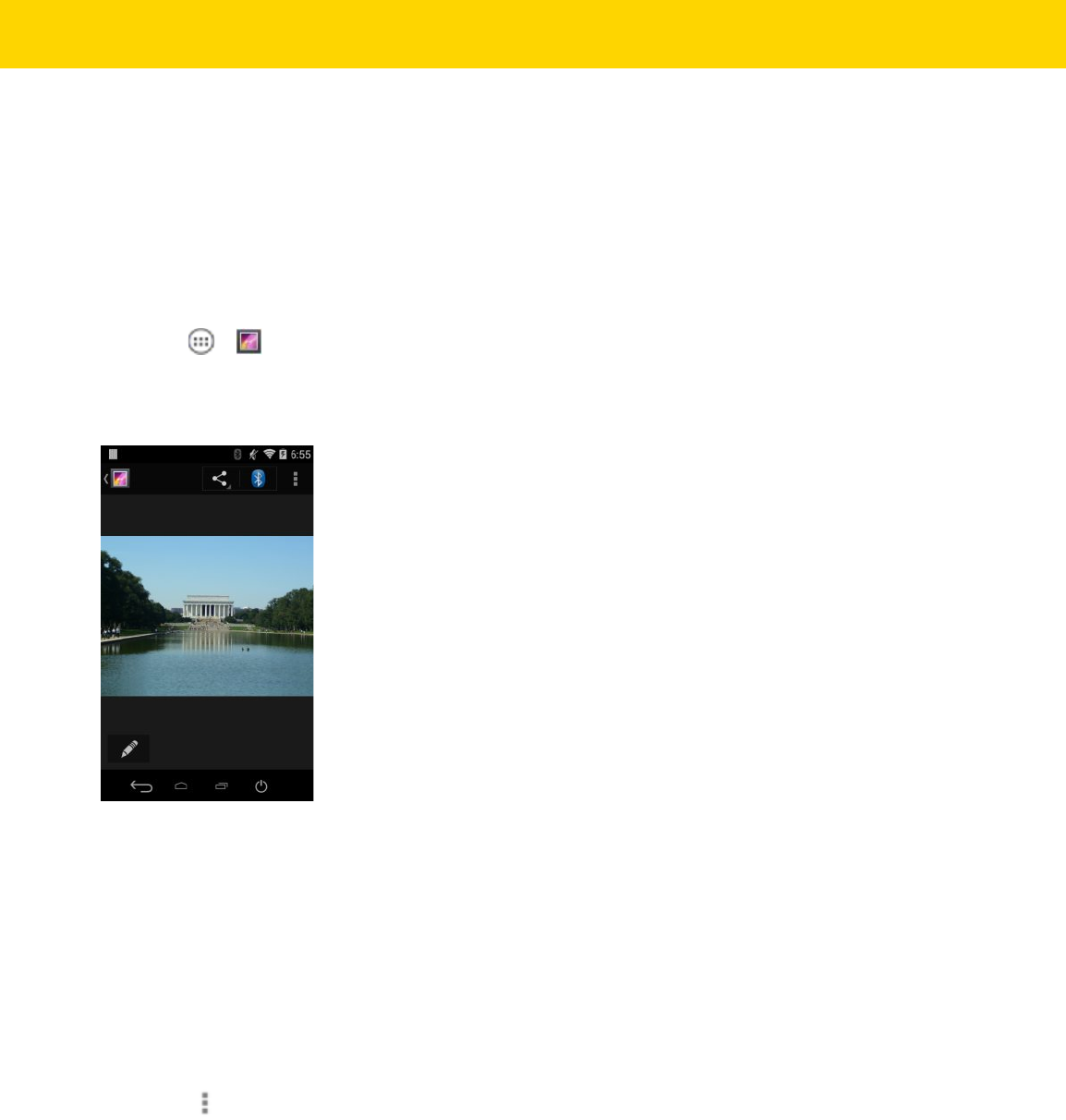
5 - 14 TC8000 User Guide
5. In the Delete selected item? menu, touch OK to delete the album.
Working with Photos
Use Gallery to view photos and edit and share photos.
Viewing and Browsing Photos
To view a photo:
1. Touch > .
2. Touch an album to open it.
3. Touch a photo.
Figure 5-12 Photo Example
4. Swipe left or right to view the next or previous photo in the album.
5. Touch the photo to view the controls.
6. Double-tap the screen to zoom in or pinch two fingers together or spread them apart to zoom in or out.
7. Drag the photo to view parts that are not in view.
Cropping a Photo
1. In Gallery, touch a photo to view the controls.
2. Touch .
3. Touch Crop. The white cropping tool appears.
4. Use the cropping tool to select the portion of the photo to crop.
•
Drag from the inside of the cropping tool to move it.
•
Drag an edge of the cropping tool to resize it to any proportion.
•
Drag a corner of the cropping tool to resize it with fixed proportions.
Review Copy
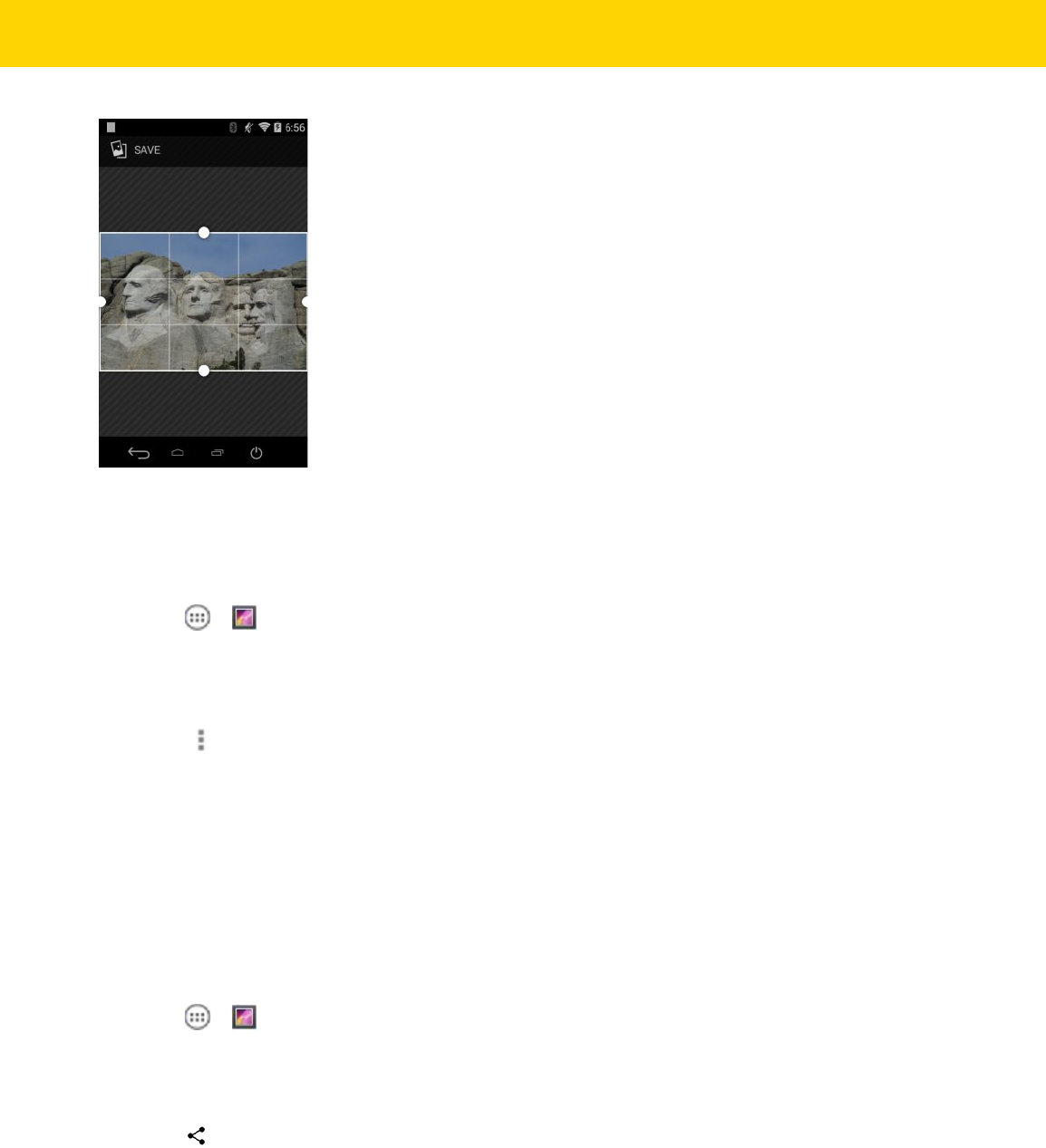
Applications 5 - 15
Figure 5-13 Cropping Tool
5. Touch SAVE to save a copy of the cropped photo. The original version is retained.
Setting a Photo as a Contact Icon
1. Touch > .
2. Touch an album to open it.
3. Touch the photo to open it.
4. Touch .
5. Touch Set picture as.
6. Touch Contact photo.
7. In the People application, touch a contact.
8. Touch the white box and crop the photo accordingly.
9. Touch OK.
Share a Photo
1. Touch > .
2. Touch an album to open it.
3. Touch a photo to open it.
4. Touch .
5. Touch the application to use to share the selected photo. The application selected opens with the photo
attached to a new message.
Review Copy
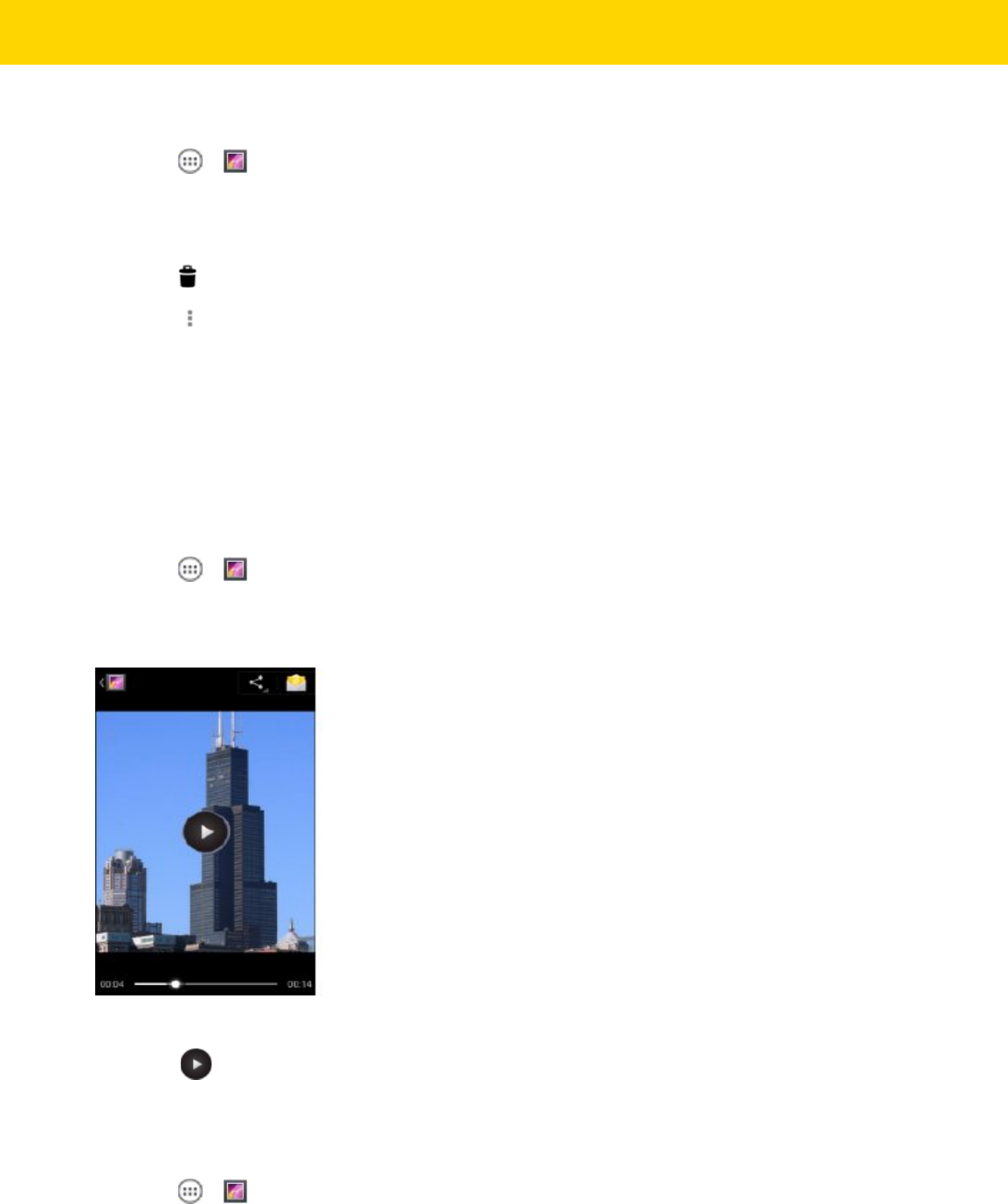
5 - 16 TC8000 User Guide
Deleting a Photo
1. Touch > .
2. Touch an album to open it.
3. Touch a photo to open it.
4. Touch .
5. Touch .
6. Touch Delete.
7. Touch OK to delete the photo.
Working with Videos
Use Gallery to view videos and share videos.
Watching Videos
1. Touch > .
2. Touch an album to open it.
3. Touch a video.
Figure 5-14 Video Example
4. Touch . The video begins to play.
5. Touch the screen to view the playback controls.
Sharing a Video
1. Touch > .
2. Touch an album to open it.
Review Copy
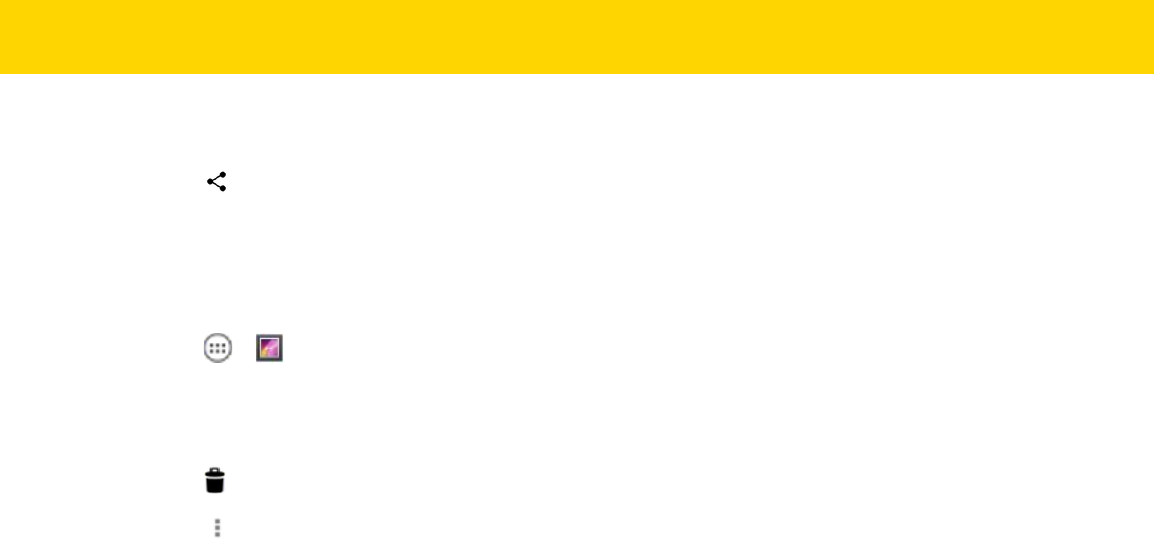
Applications 5 - 17
3. Touch a video to open it.
4. Touch . The Share menu appears.
5. Touch the application to use to share the selected video. The application selected opens with the video
attached to a new message.
Deleting a Video
1. Touch > .
2. Touch an album to open it.
3. Touch a video to open it.
4. Touch .
5. Touch .
6. Touch Delete.
7. Touch OK.
Review Copy
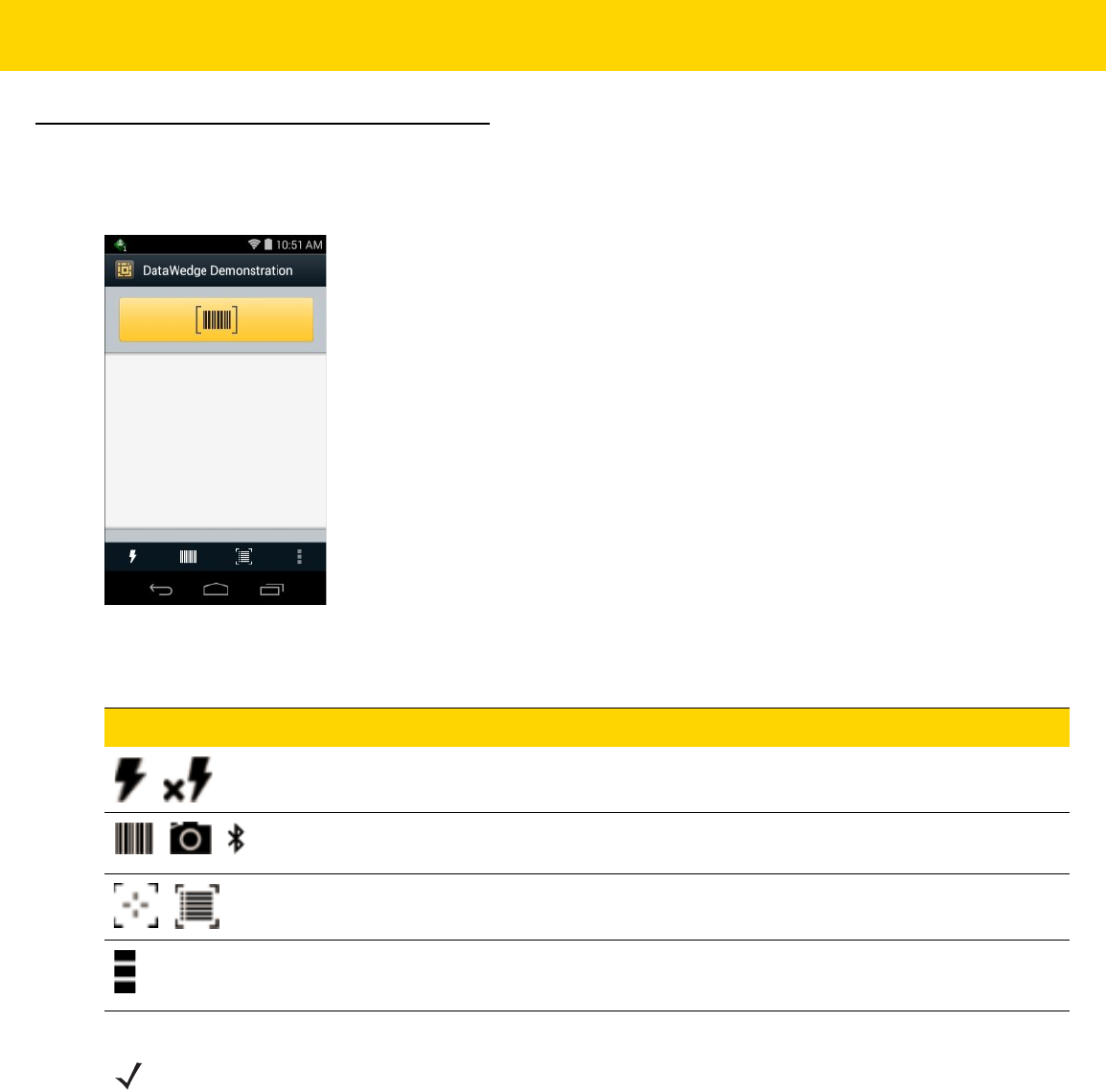
5 - 18 TC8000 User Guide
DataWedge Demonstration
Use DataWedge Demonstration to demonstrate data capture functionality.
Figure 5-15 DataWedge Demonstration Window
Either press the Scan key or touch the yellow scan button in the application to enable data capture. The captured
data appears in the text field below the yellow button.
Table 5-1 DataWedge Demonstration Icons
Icon Description
/
Toggles the flash on and off when using the camera to capture bar code data. Use the flash in
dimly lit areas.
/ / Toggles the data capture function between the internal imager/scanner, internal camera or
RS507 Hands-free Bluetooth imager (if connected).
/ Toggles between normal scan mode and picklist mode when capturing bar code data.
Opens a menu to view the application information or to set the application DataWedge profile.
NOTE
See Chapter 9, DataWedge for information on DataWedge configuration.
Review Copy
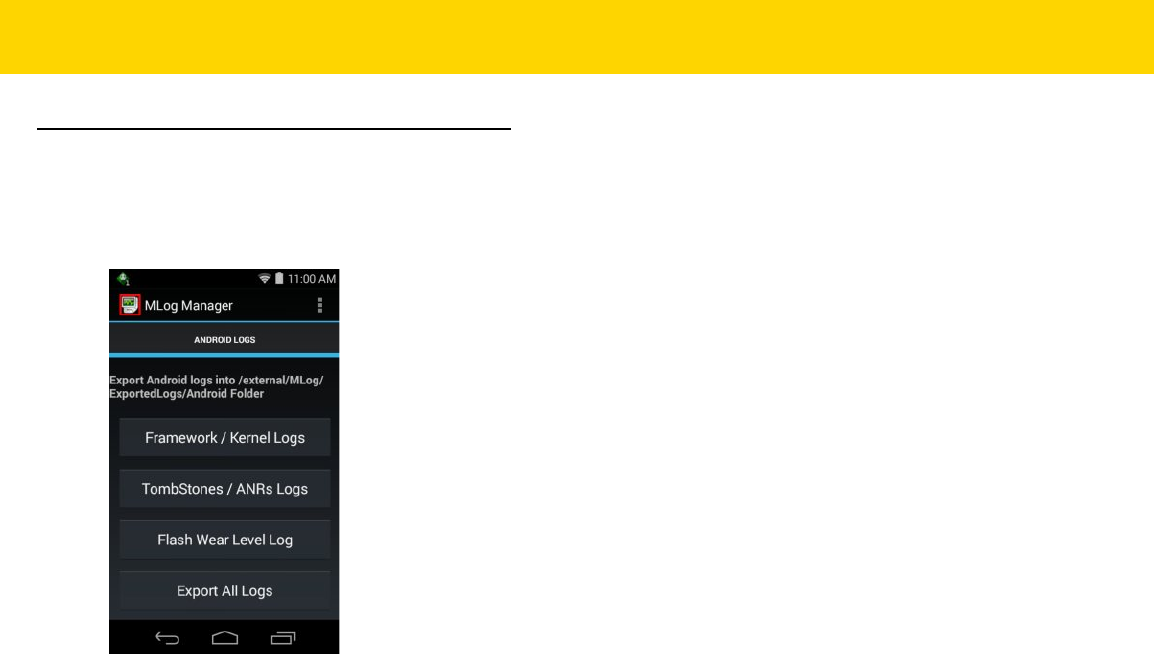
Applications 5 - 19
MLog Manager
Use MLog Manager to capture log files for diagnostics. See the TC8000 Integrator Guide for detailed information
on configuring the application.
Figure 5-16 MLog Manager
Review Copy
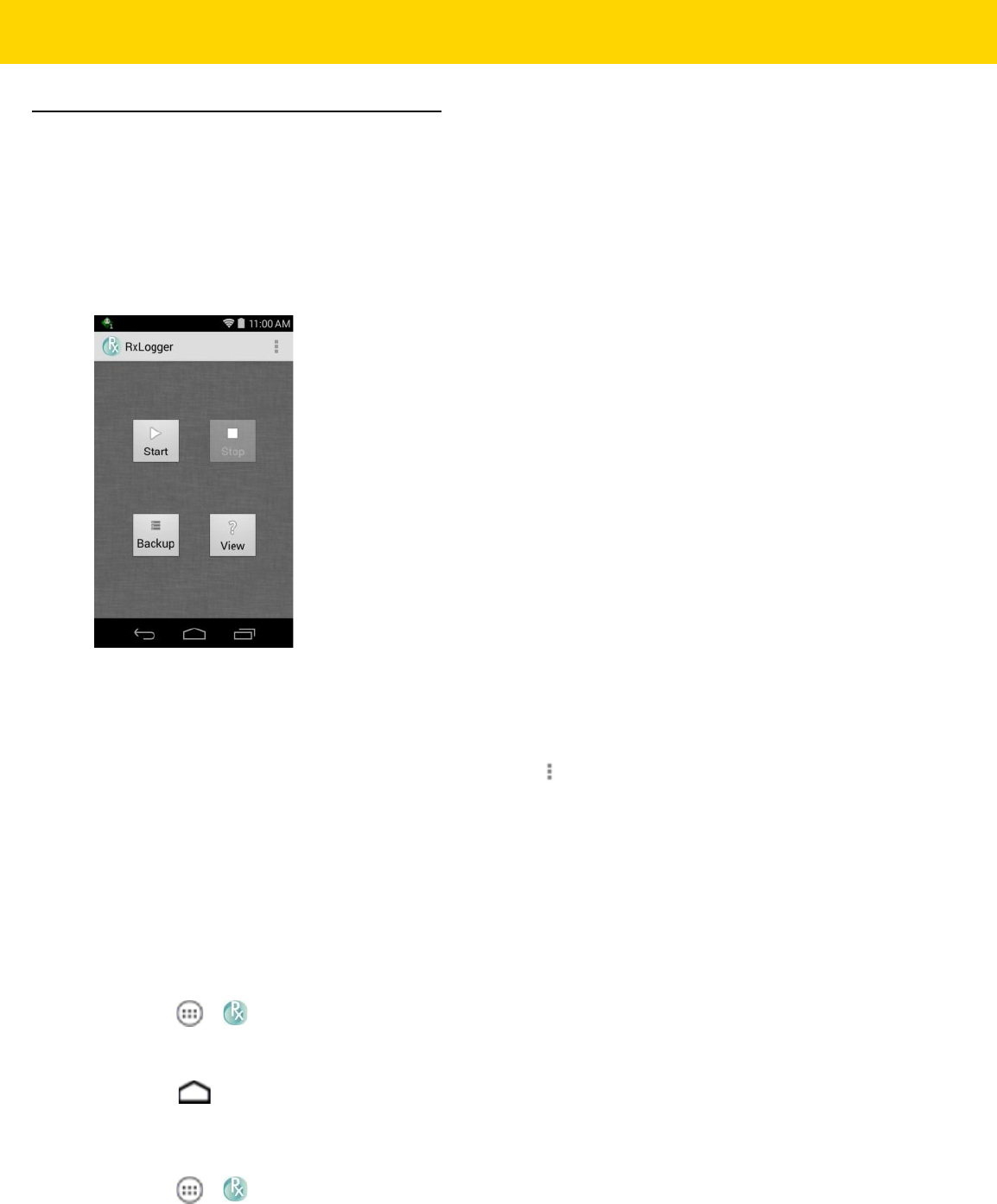
5 - 20 TC8000 User Guide
RxLogger
RxLogger is a comprehensive diagnostic tool that provides application and system metrics. It allows for custom
plug-ins to be created and work seamlessly with this tool. RxLogger is used to diagnose device and application
issues. Its information tracking includes the following: CPU load, memory load, memory snapshots, battery
consumption, power states, wireless logging, cellular logging, TCP dumps, Bluetooth logging, GPS logging, logcat,
FTP push/pull, ANR dumps, etc. All logs and files generated are saved onto flash storage on the device (internal or
external).
Figure 5-17 RxLogger
RxLogger Configuration
RxLogger is built with an extensible plug-in architecture and comes packaged with a number of plugins already
built-in. The included plug-ins are described below. Touch > Settings to open the configuration screen.
Configuration File
RxLogger configuration can be set using an XML file. The config.xml configuration file is located on the Enterprise
storage in the RxLogger\config folder. Copy the file from the device to a host computer using a USB connection.
Edit the configuration file and the replace the .XML file on the device. There is no need to stop and restart the
RxLogger service since the file change is automatically detected.
Enabling Logging
1. Touch > .
2. Touch Start.
3. Touch .
Disabling Logging
1. Touch > .
2. Touch Stop.
Review Copy

Applications 5 - 21
3. Touch .
Extracting Log Files
1. Connect the device to a host computer using an USB connection.
2. Using a file explorer, navigate to the On Device Storage in the /RxLogger folder.
3. Copy the file from the device to the host computer.
4. Disconnect the device from the host computer.
Review Copy
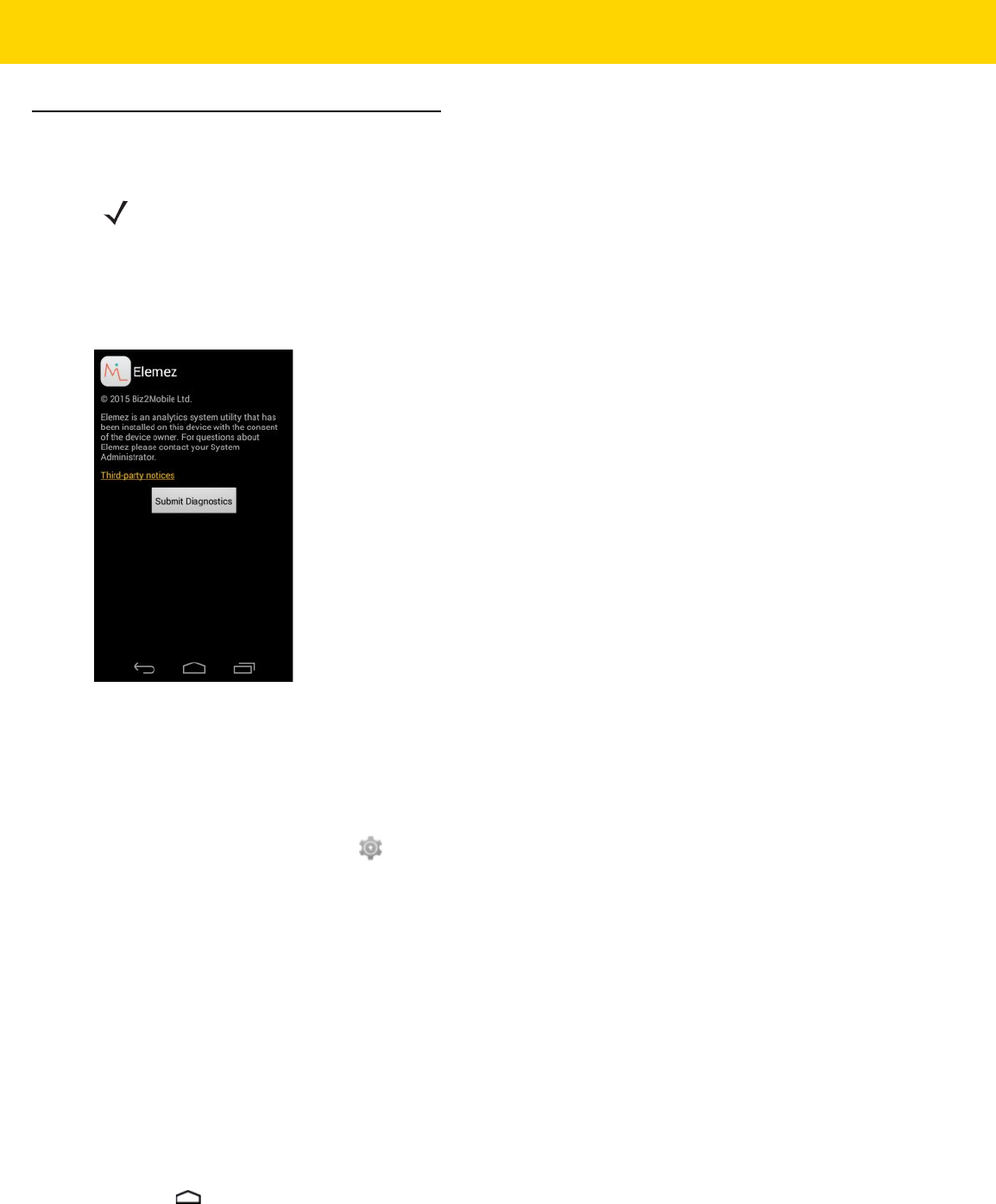
5 - 22 TC8000 User Guide
Elemez
Use Elemez to provide diagnostics information to us. Touch Submit Diagnostics button to send the data.
Figure 5-18 Elemez Application
Disabling Elemez Data Collection
The user can disable the Elemez application from collection specific data in the background and sending it to Zebra
Technologies.
1. From the Home screen, touch > Apps.
2. Swipe left or right until the ALL tab displays.
3. Scroll through the list and touch Elemez.
4. In the App info screen, touch Uninstall updates.
5. In the Uninstall updates dialog box, touch OK.
6. Touch OK.
7. After uninstall is complete, touch OK.
8. In the All tab, scroll through the list and touch Elemez.
9. Touch Disable.
10. In the Disable built-in app? dialog box, touch OK.
11. Touch .
NOTE
Elemez collects specific device information in the background and sends this information to us to help
improve product functionality. This feature can be disabled.
See Disabling Elemez Data Collection. Ensure that the date, time and time zone are set correctly prior to
using Elemez.
Review Copy
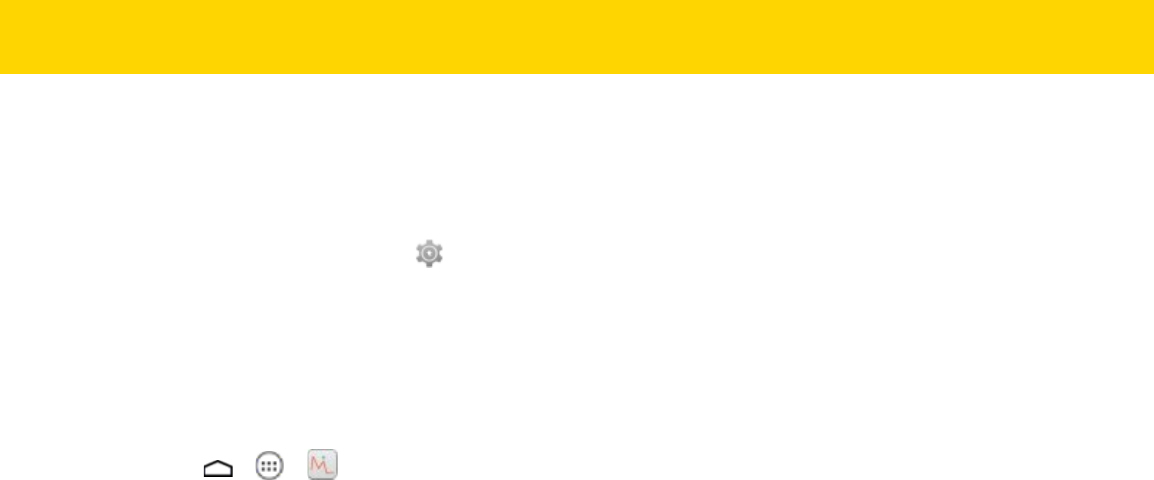
Applications 5 - 23
Enabling Elemez Data Collection
The user can re-enable the Elemez application for collection specific data in the background and sending it to
Zebra Technologies.
1. From the Home screen, touch .
2. Touch Manage Apps.
3. Swipe left or right until the ALL tab displays.
4. Scroll through the list and touch Elemez.
5. In the App info screen, touch Enable.
6. Touch > > .
7. Touch Enable Elemez.
Review Copy

5 - 24 TC8000 User Guide
Print Station
Use the Print Station app to print labels and receipts directly to a Zebra ZPL printer via USB, Bluetooth or WLAN.
Features include:
•
Discovering and pairing with Zebra printers via a Bluetooth, WLAN or USB connection.
•
Retrieving and displaying a list of document templates stored on the device and on the printer.
•
Using document templates to generate on-screen prompts allowing data entry at print time.
•
Using the camera on the device to scan bar codes for data entry.
•
Supports multiple Zebra printer models using the ZPL command language.
Review Copy

Applications 5 - 25
Zebra Tap & Pair
Use the Zebra Tap & Pair application to
Review Copy

5 - 26 TC8000 User Guide
Zebra Utilities
Use the Zebra Utilities app to print bar code labels and receipts directly to a Zebra printer via Bluetooth or WLAN.
Review Copy
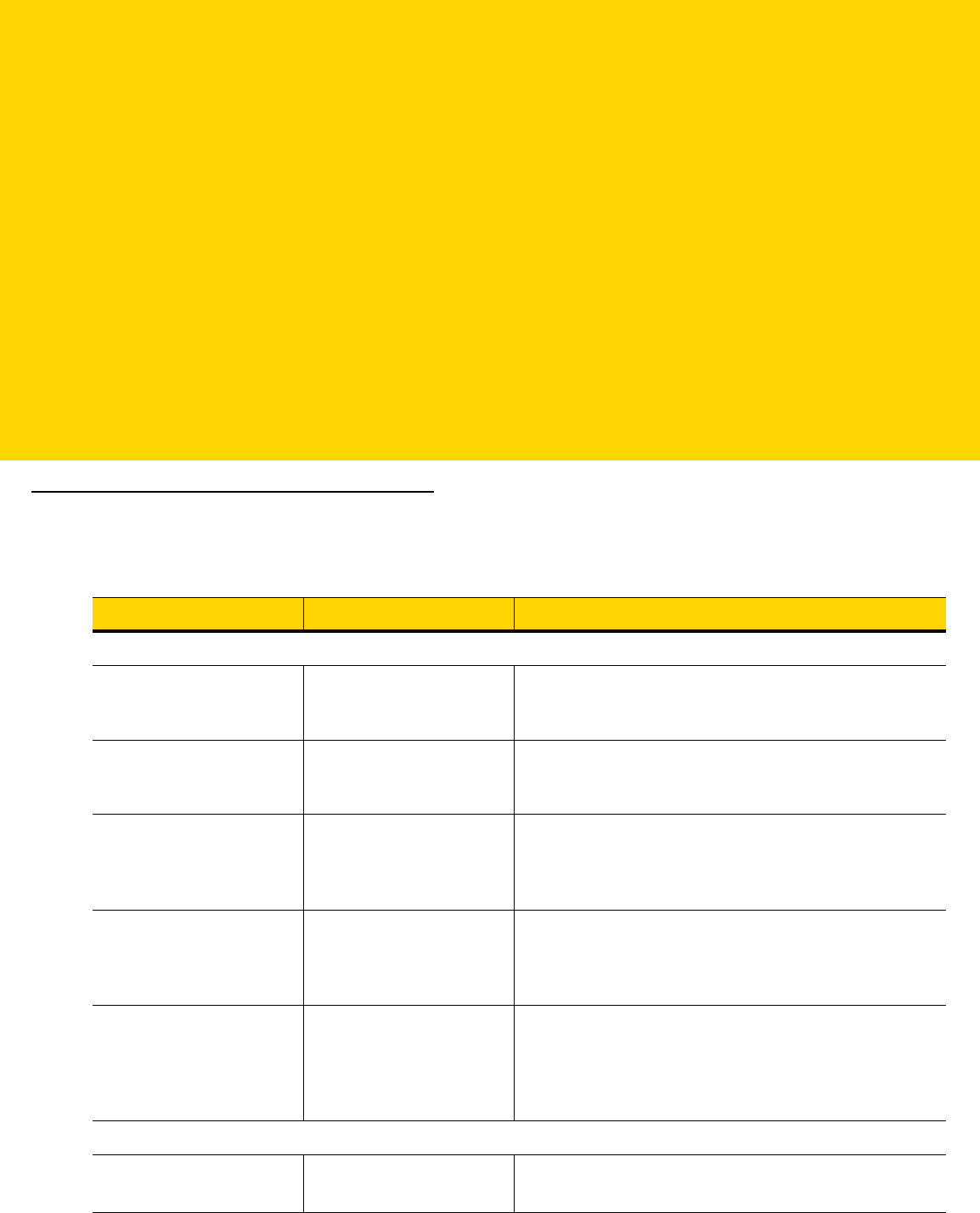
CHAPTER 6 ACCESSORIES
Accessories
Table 6-1 Accessories
Accessory Part Number Description
Cradles
2-Slot USB Charge Cradle CRD-TC8X-2SUCHG-01 Provides device and spare battery charging and USB
communication with a host computer. Use with power
supply, p/n PWRS-14000-148R.
5-Slot Charge Only Cradle CRD-TC8X-5SCHG-01 Charges up to five TC8000 devices. Use with power
supply, p/n PWRS-14000-241R and DC line cord, p/n
50-16002-029R.
5-Slot Ethernet Cradle CRD-TC8X-5SETH-01 Provides device charging and provides Ethernet
communication for up to five devices. Use with power
supply, p/n PWRS-14000-241R and DC line cord, p/n
50-16002-029R.
5-Slot Charge Only Cradle
with Battery Charger CRD-TC8X-5SC4BC-01 Charges up to four TC8000 devices and four spare
batteries. Use with power supply, p/n
PWRS-14000-241R and DC line cord, p/n
50-16002-029R.
5-Slot Ethernet Cradle
with Battery Charger CRD-TC8X-5SE4BC-01 Provides device charging and provides Ethernet
communication for up to four devices. Provides charging
for four spare batteries. Use with power supply, p/n
PWRS-14000-241R and DC line cord, p/n
50-16002-029R.
Batteries and Chargers
Battery BTRY-TC8X-67MA1-01
BTRY-TC8X-67MA1-10
Replacement battery (single pack).
Replacement battery (10–pack).
Review Copy
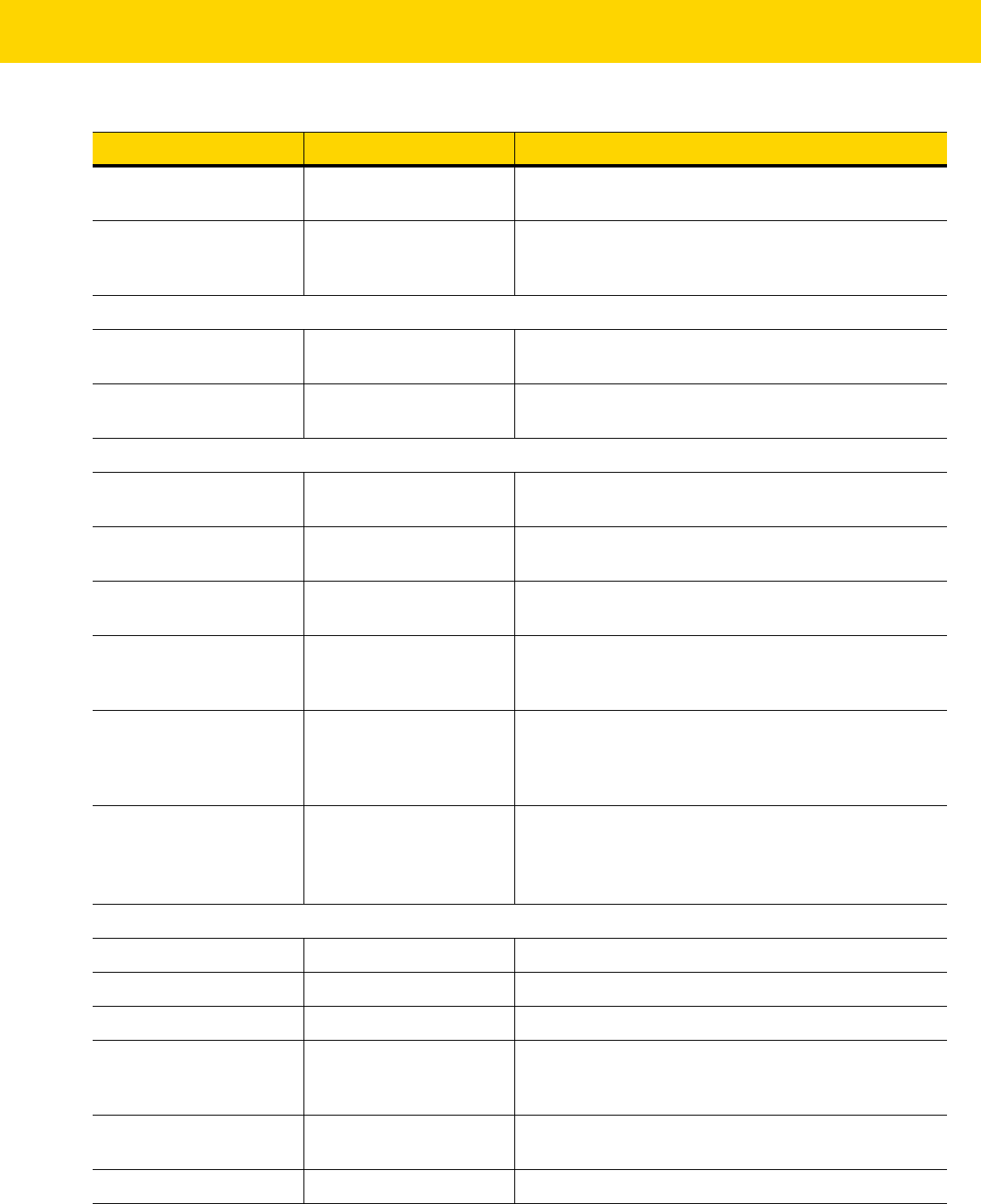
6 - 2 TC8000 User Guide
4-Slot Battery Charger SAC-TC8X-4SCHG-01 Charges up to four spare batteries. Requires power
supply, p/n PWRS-14000-148R.
USB and Charging Cable CBL-TC8X-USBCHG-01 Provides USB communication and power to the device.
Requires power supply PWRS-14000-249R and country
specific un-grounded AC line cord.
Audio Accessories
Quick Disconnect Audio
Cable CBL-TC8X-AUDQD-01 Snaps onto the device and provides audio to a wired
headset with Quick Disconnect connector.
3.5 mm Audio Cable CBL-TC8X-AUDBJ-01 Snaps onto the device and provides audio to a wired
headset with 3.5 mm plug.
Mounting Brackets
2-Slot Cradle Desktop
Stand BRKT-SCRD-SSDK-01 Use for mounting a 2-Slot cradle on a desk.
5-Slot Cradle Desktop
Stand BRKT-SCRD-MSDK-01 Use for mounting a 5-Slot cradle on a desk.
Rack Mount Bracket BRKT-SCRD-SMRK-01 Use for mounting a 5-Slot cradle or four 4-Slot Battery
Chargers on a rack.
Desktop Stand MNT-TC8X-DKPH-01 Un-powered desktop presentation stand. Allows to use
the device on a flat surface (i.e. desktop) for hands-free
scanning.
Cart Mount MNT-TC8X-CMKT-01 Allows to install the device on carts with up to 2” diameter
rail/bar and allows to use the device on free-hand
scanning mode. Includes: Includes RAM Mount required
for installation.
Forklift Mount MNT-TC8X-FMKT-01 Un-powered forklift mount. Allows to install the device on
a roll bar or square surface of a forklift and allows to use
the device on landscape or portrait mode.
Includes Proclip Mount required for installation.
Carrying Solutions
Hand Strap SG-TC8X-HDSTP-01 Replacement hand strap.
Wrist Lanyard 50-12500-006
Quick Draw Soft Holster SG-TC8X-QDHLST-01 Use to hold the device. Requires the Universal Belt.
Presentation Soft Holster SG-TC8X-PMHLST-01 Use to hold the device and scan while in presentation
mode. Requires the Universal Shoulder Strap or
Universal Belt.
Universal Belt 11-08062-02R Use to hold the Quick Draw Soft Holster or the
Presentation Soft Holster.
Universal Shoulder Strap WA6010
Table 6-1 Accessories (Continued)
Accessory Part Number Description
Review Copy
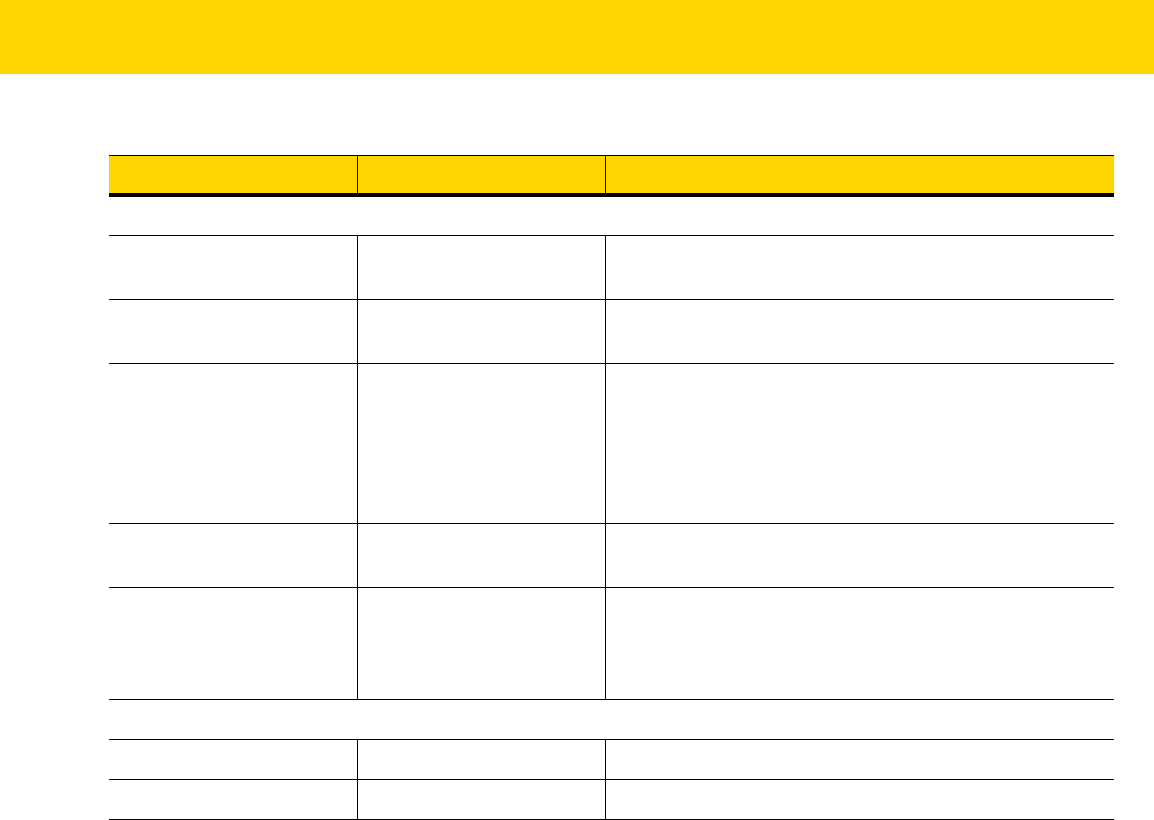
Accessories 6 - 3
Power Supplies
Power Supply PWRS-14000-249R Provides power to the device using the Snap-On USB
Cable or Charging Cable Cup. Requires AC line cord.
Power Supply PWRS-14000-148R Provides power to the 2–Slot cradles and 4-Slot Spare
Battery Charger. Requires AC line cord.
Power Supply PWRS-14000-241R Provides power to the 5-Slot Charge Only Cradle, 5-Slot
Ethernet Cradle, 5-Slot Charge Only Cradle with Battery
Charger and the 5-Slot Ethernet Cradle with Battery
Charger. Requires DC Line Cord, p/n 50-16002–029R
and country specific three wire grounded AC line cord
sold separately.
DC Y Cable 25-85993-01R Use to provide power from the PWRS-14000-241R
power supply to two 4-Slot Battery Chargers.
DC Line Cord 50-16002-029R Provides power from the power supply to the 5-Slot
Charge Only Cradle, 5-Slot Ethernet Cradle, 5-Slot
Charge Only Cradle with Battery Charge and 5-Slot
Ethernet Cradle with Battery Charger.
Miscellaneous
Stylus SG-TC7X-STYLUS-03 Stylus for use with the device (3-pack).
Screen Protectors MISC-TC8X-SCRN-01 Provides additional protection for display.
Table 6-1 Accessories (Continued)
Accessory Part Number Description
Review Copy
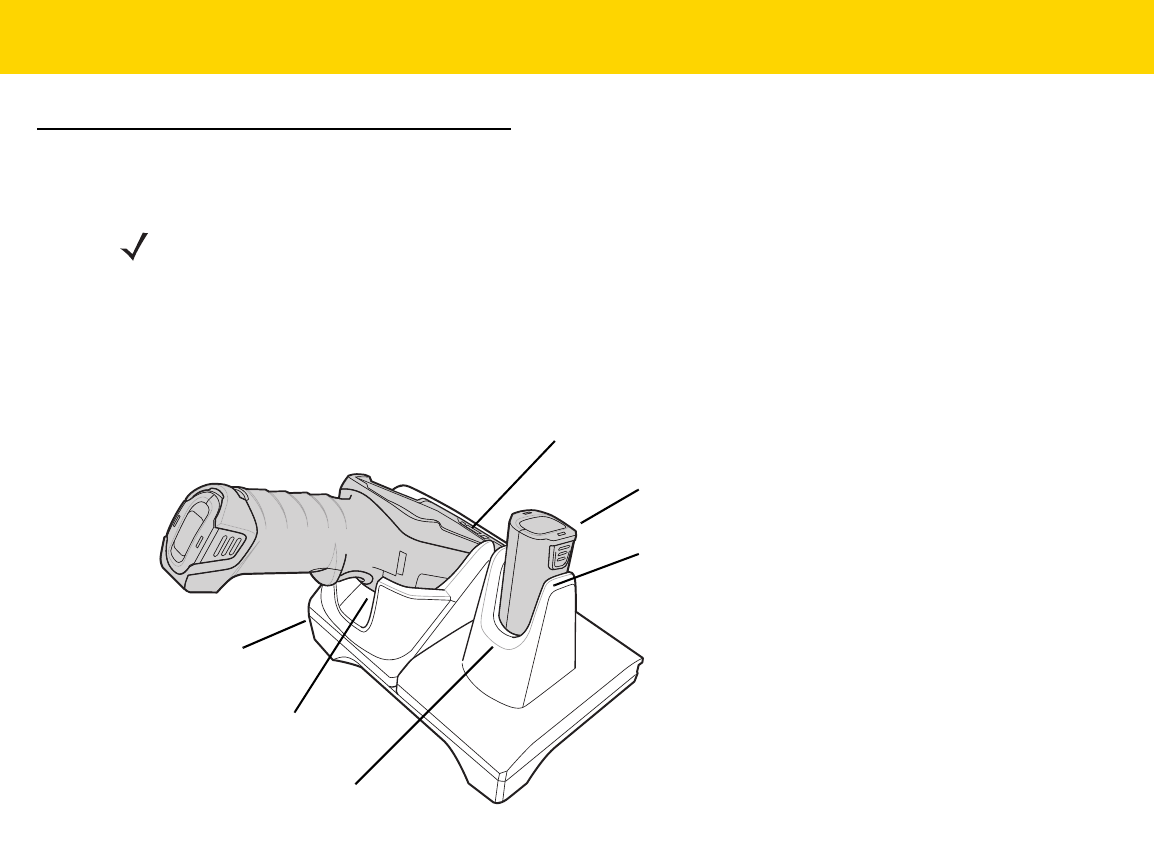
6 - 4 TC8000 User Guide
2-Slot Charge Only Cradle
The 2-Slot Charge Only Cradle:
•
provides 5 VDC power for operating the device
•
charges a spare battery.
1. Insert the device into the TC8000 charge well.
2. Insert a spare battery into the spare battery charge well.
Battery Charging
Main Battery Charging
The TC8000 Charging/Scan LED indicates the status of the battery charging in the device. See Table 1-3 on page
1-6.
The 6,400 mAh battery fully charges in less than six hours at room temperature.
Spare Battery Charging
The Spare Battery Charging LED indicates the status of the spare battery charging.
The 6,400 mAh battery fully charges in less than six hours at room temperature.
NOTE
Ensure that you follow the guidelines for battery safety described in Battery Safety Guidelines on page 7-1.
Spare Battery
Spare Battery Charging
LED
Spare Battery Slot
Power LED
TC8000 Charging Slot
Charging/Scan LED
Review Copy
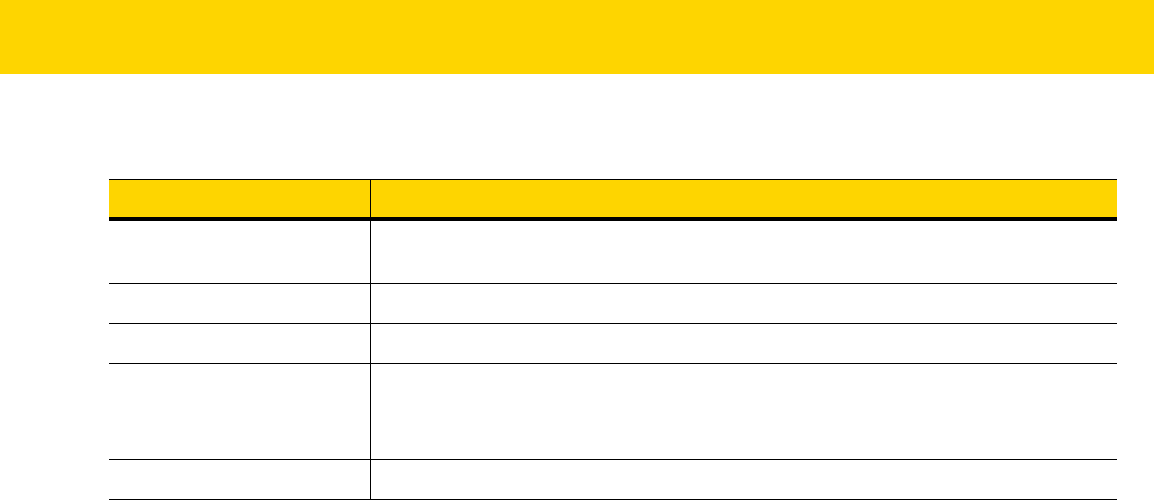
Accessories 6 - 5
Charging Temperature
Charge batteries in temperatures from 0 °C to 40 °C (32 °F to 104 °F). The device or cradle always performs
battery charging in a safe and intelligent manner. At higher temperatures (e.g. approximately +37 °C (+98 °F)) the
device or cradle may for small periods of time alternately enable and disable battery charging to keep the battery at
acceptable temperatures. The device and cradle indicates when charging is disabled due to abnormal
temperatures via its LED.
Table 6-2 Spare Battery Charging LED Indicators
State Indication
Off TC8000 is not charging. TC8000 is not inserted correctly in the cradle or connected
to a power source. Charger/cradle is not powered.
Solid Amber Battery is charging.
Solid Green Charging is complete.
Fast Blinking Red
(2 blinks/second) Charging error, e.g.:
- Temperature is too low or too high.
- Charging has gone on too long without completion (typically eight hours).
Solid Red Battery is at end of useful life.
Review Copy
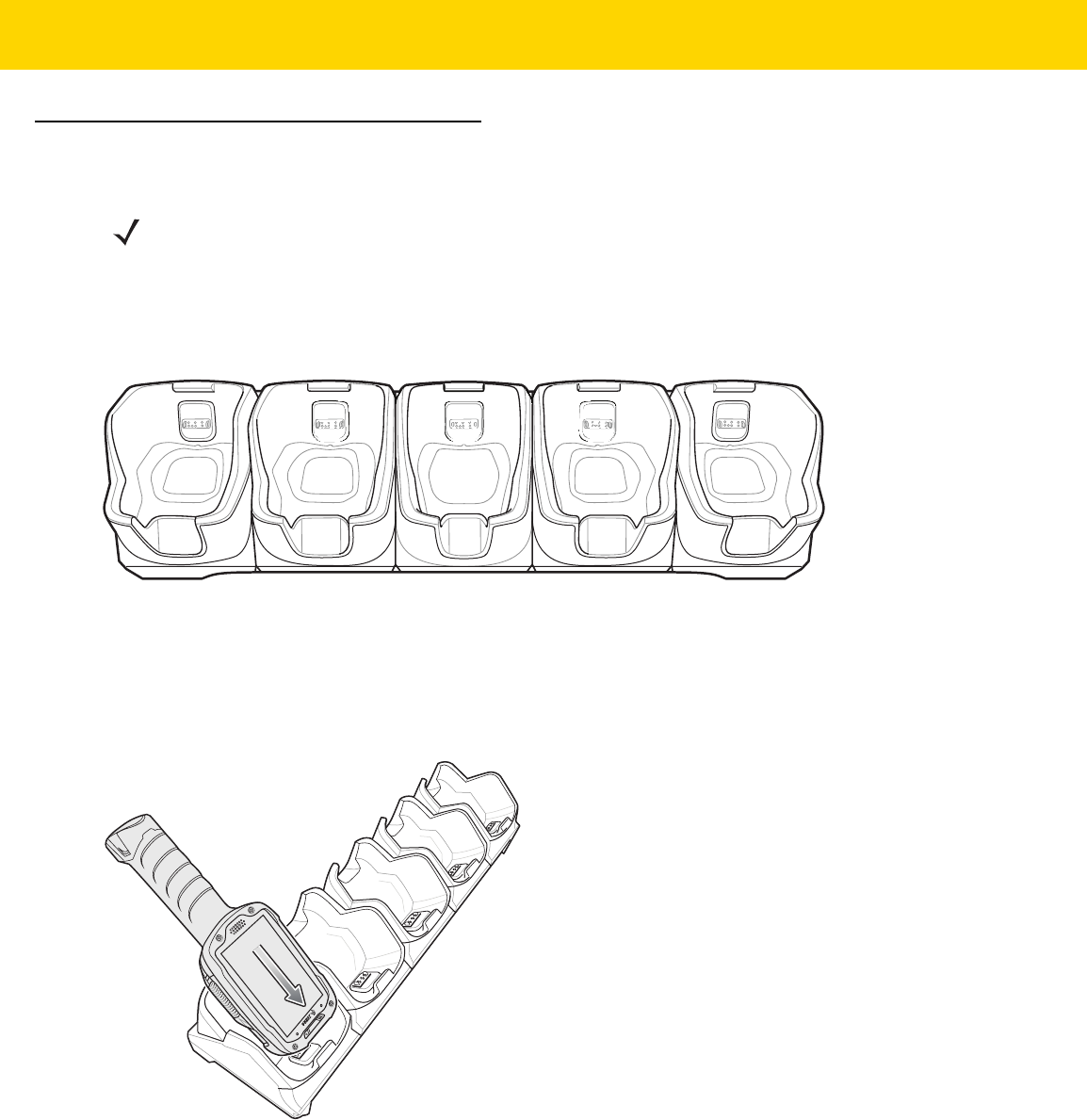
6 - 6 TC8000 User Guide
5-Slot Charge Only Cradle
The 5-Slot Charge Only Cradle:
•
Provides 5 VDC power for operating the TC8000.
•
Simultaneously charges up to five TC8000s.
Figure 6-1 5-Slot Charge Only Cradle
Charging the TC8000
To Charge the TC8000:
1. Insert the TC8000 in a charge well to begin charging.
Figure 6-2 TC8000 Battery Charging
2. Ensure that the TC8000 is properly seated in the charge well.
NOTE
Ensure that you follow the guidelines for battery safety described in Battery Safety Guidelines on page 7-1.
Review Copy
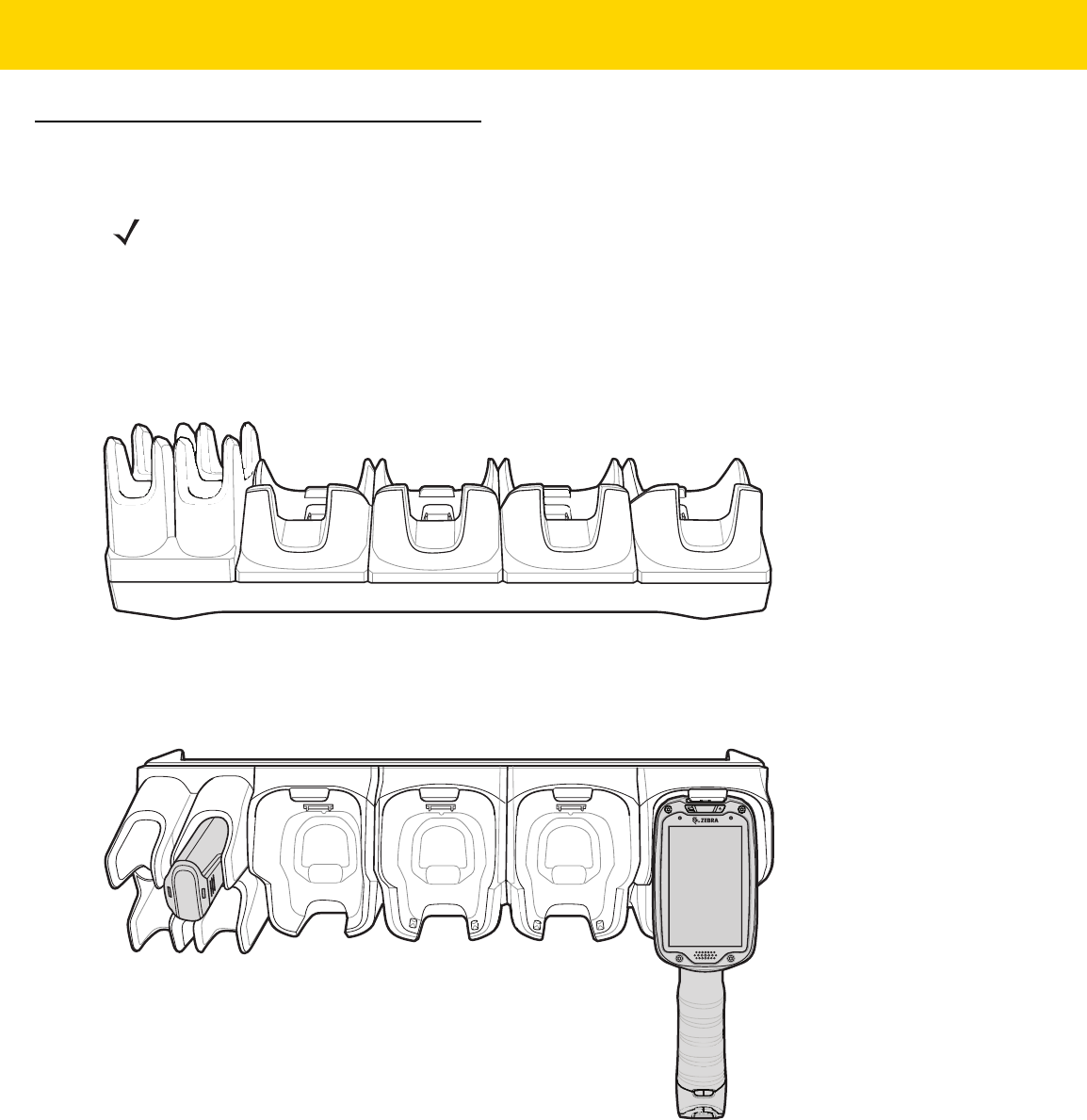
6 - 8 TC8000 User Guide
5-Slot Charge Only Cradle with Battery Charger
The 5-Slot Charge Only Cradle with Battery Charger:
•
Provides 5 VDC power for operating the TC8000.
•
Simultaneously charges up to four TC8000s.
•
Simultaneously charges up to four spare batteries.
Figure 6-3 5-Slot Charge Only Cradle with Battery Charger
To Charge the TC8000:
1. Insert the TC8000 in a charge well to begin charging.
Figure 6-4 TC8000 Battery Charging
2. Ensure that the TC8000 is properly seated in the charge well.
NOTE
Ensure that you follow the guidelines for battery safety described in Battery Safety Guidelines on page 7-1.
NEED DRAWING
Review Copy
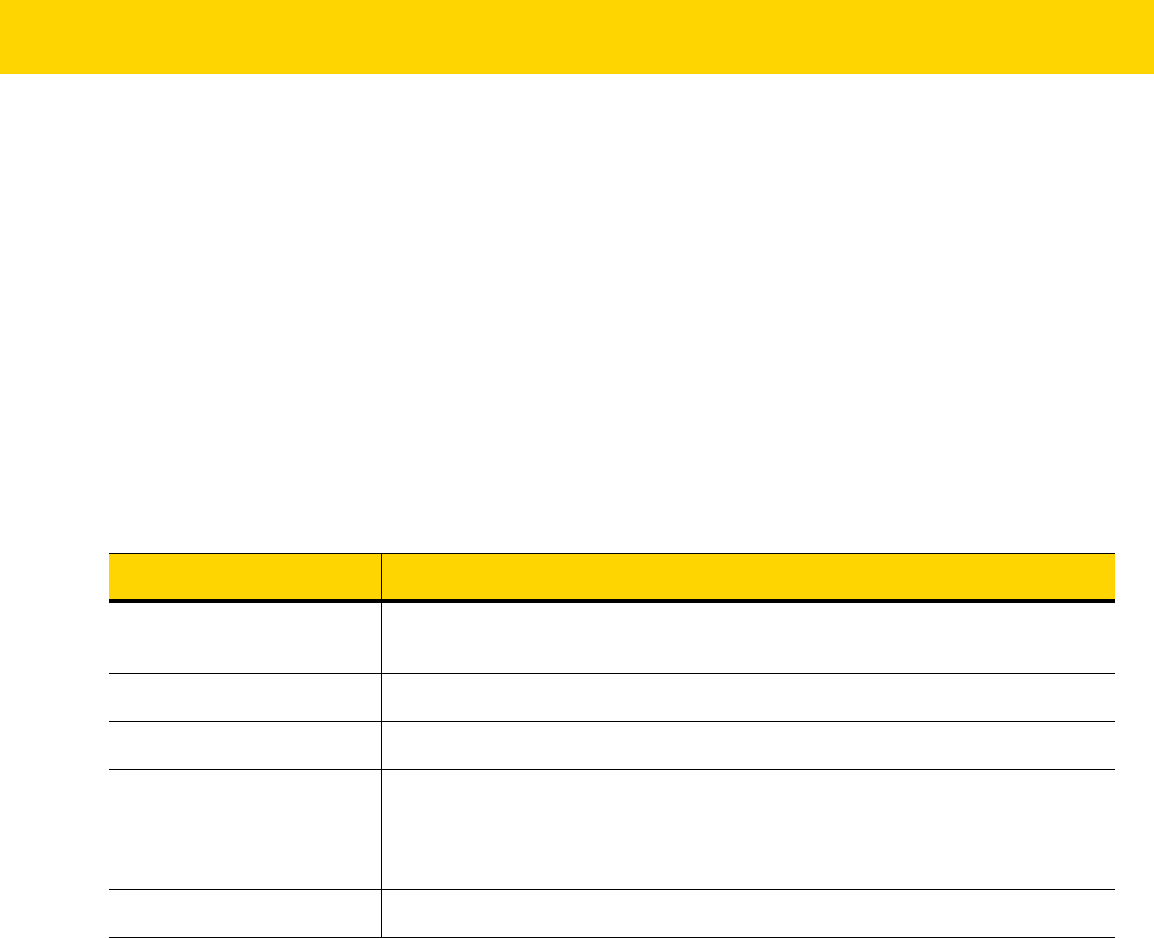
Accessories 6 - 9
Battery Charging
Main Battery Charging
The TC8000 Charging/Scan LED indicates the status of the battery charging in the device. See Table 1-3 on page
1-6.
The 6,400 mAh battery fully charges in less than six hours at room temperature.
Spare Battery Charging
Each Battery Charging LED indicates the status of the battery charging in each slot. The table below describes the
Battery Charging LED status.
The 6,400 mAh battery fully charges in less than six hours at room temperature.
Charging Temperature
Charge batteries in temperatures from 0 °C to 40 °C (32 °F to 104 °F). The battery charger always performs battery
charging in a safe and intelligent manner. At higher temperatures (e.g. approximately +37 °C (+98 °F)) the battery
charger may for small periods of time alternately enable and disable battery charging to keep the battery at
acceptable temperatures. The battery charger indicates when charging is disabled due to abnormal temperatures
via its LED.
Table 6-3 Battery Charging Indicators
State Indication
Off Battery is not charging. It is not inserted correctly in the cradle or connected to a
power source. Charge is not powered.
Solid Amber Battery is charging.
Solid Green Charging is complete.
Fast Blinking Red
(2 blinks/second) Charging error, e.g.:
- Temperature is too low or too high.
- Charging has gone on too long without completion (typically eight hours).
Solid Red Battery is at end of useful life.
Review Copy
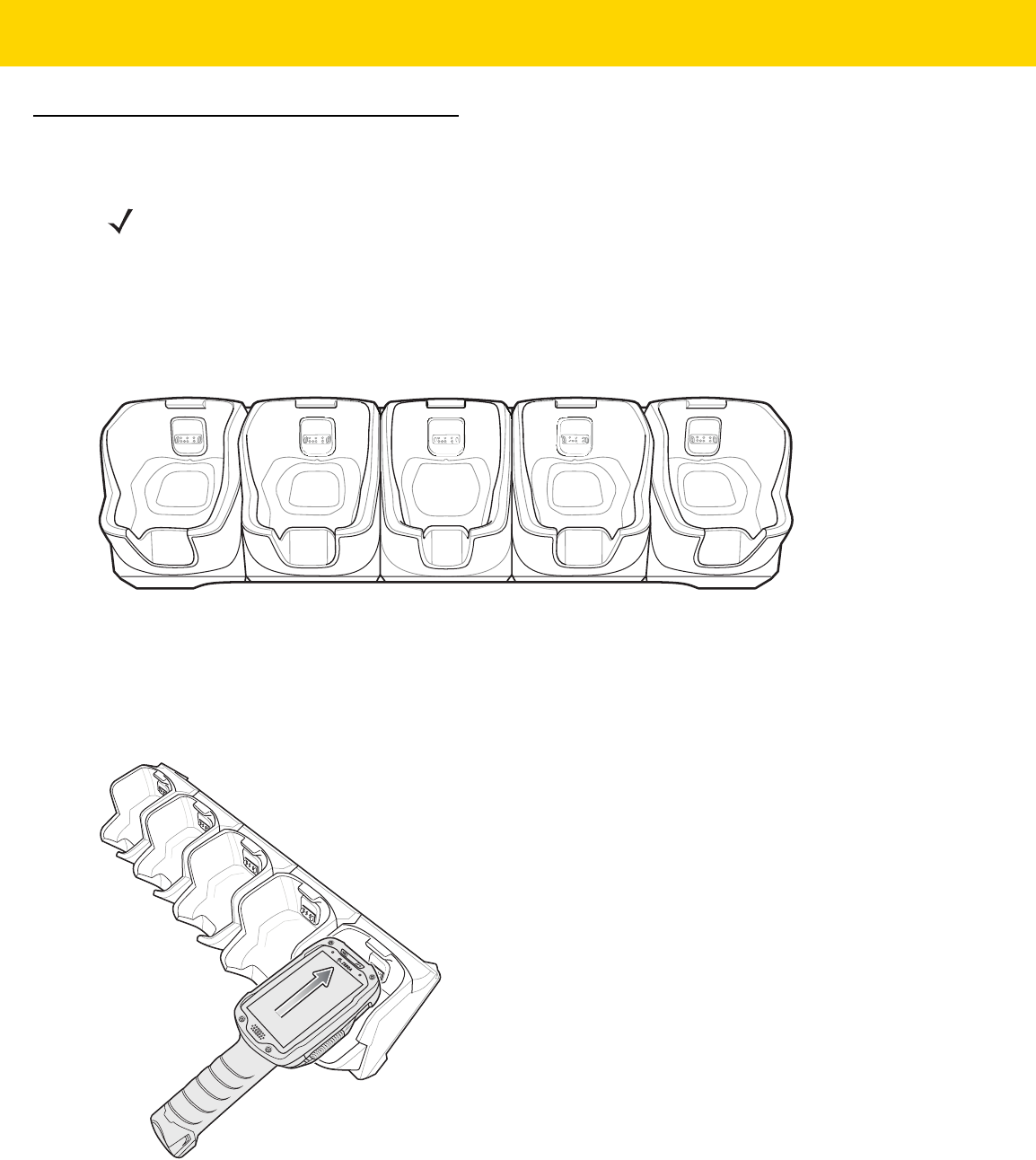
6 - 10 TC8000 User Guide
5-Slot Ethernet Cradle
The 5-Slot Ethernet Cradle:
•
Provides 5 VDC power for operating the TC8000.
•
Connects up to five TC8000s to an Ethernet network.
•
Simultaneously charges up to five TC8000s.
Figure 6-5 5-Slot Ethernet Cradle
Charging the TC8000
To charge the TC8000:
1. Insert the TC8000 in a charge well to begin charging.
Figure 6-6 TC8000 Battery Charging
2. Ensure that the TC8000 is properly seated in the charge well.
NOTE
Ensure that you follow the guidelines for battery safety described in Battery Safety Guidelines on page 7-1.
Review Copy
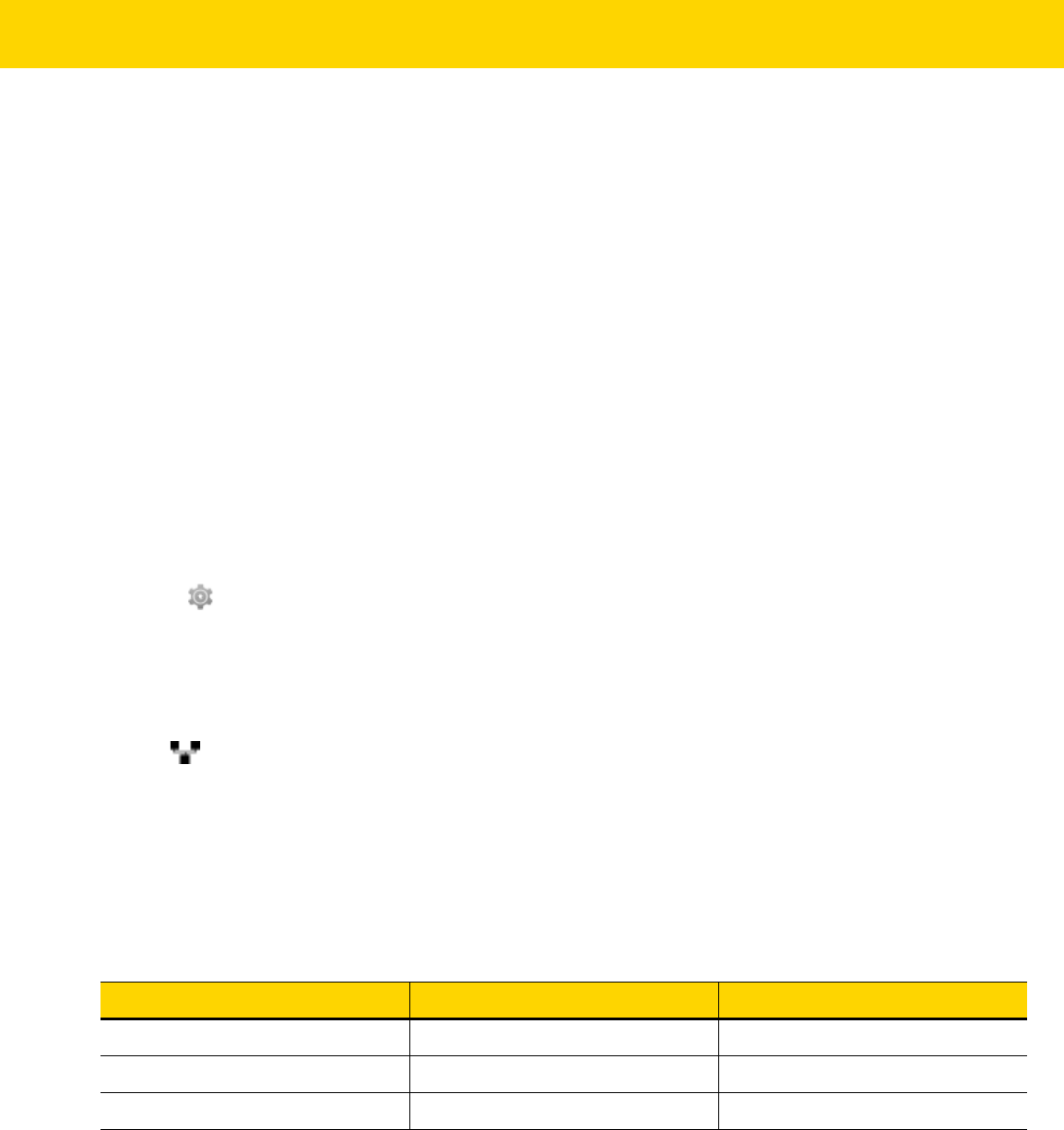
Accessories 6 - 11
Battery Charging
Main Battery Charging
The TC8000 Charging/Scan LED indicates the status of the battery charging in the device. See Table 1-3 on page
1-6.
The 6,400 mAh battery fully charges in less than six hours at room temperature.
Charging Temperature
Charge batteries in temperatures from 0 °C to 40 °C (32 °F to 104 °F). The battery charger always performs battery
charging in a safe and intelligent manner. At higher temperatures (e.g. approximately +37 °C (+98 °F)) the battery
charger may for small periods of time alternately enable and disable battery charging to keep the battery at
acceptable temperatures. The battery charger indicates when charging is disabled due to abnormal temperatures
via its LED.
Establishing Ethernet Communication
NOTE
Refer to the TC8000 Integrator Guide for information on configuring the Ethernet settings.
1. Touch .
2. Touch Ethernet.
3. Slide the Ethernet switch to the ON position.
4. Insert the device into a slot.
5. The icon appears in the Status bar.
6. Touch Eth0 to view Ethernet connection details.
Ethernet LED Indicators
There are two green LEDs on the side of the cradle. These green LEDs light and blink to indicate the data transfer
rate.
Table 6-4 LED Data Rate Indicators
Data Rate 1000 LED 100/10 LED
1 Gbps On/Blink Off
100 Mbps Off On/Blink
10 Mbps Off On/Blink
Review Copy
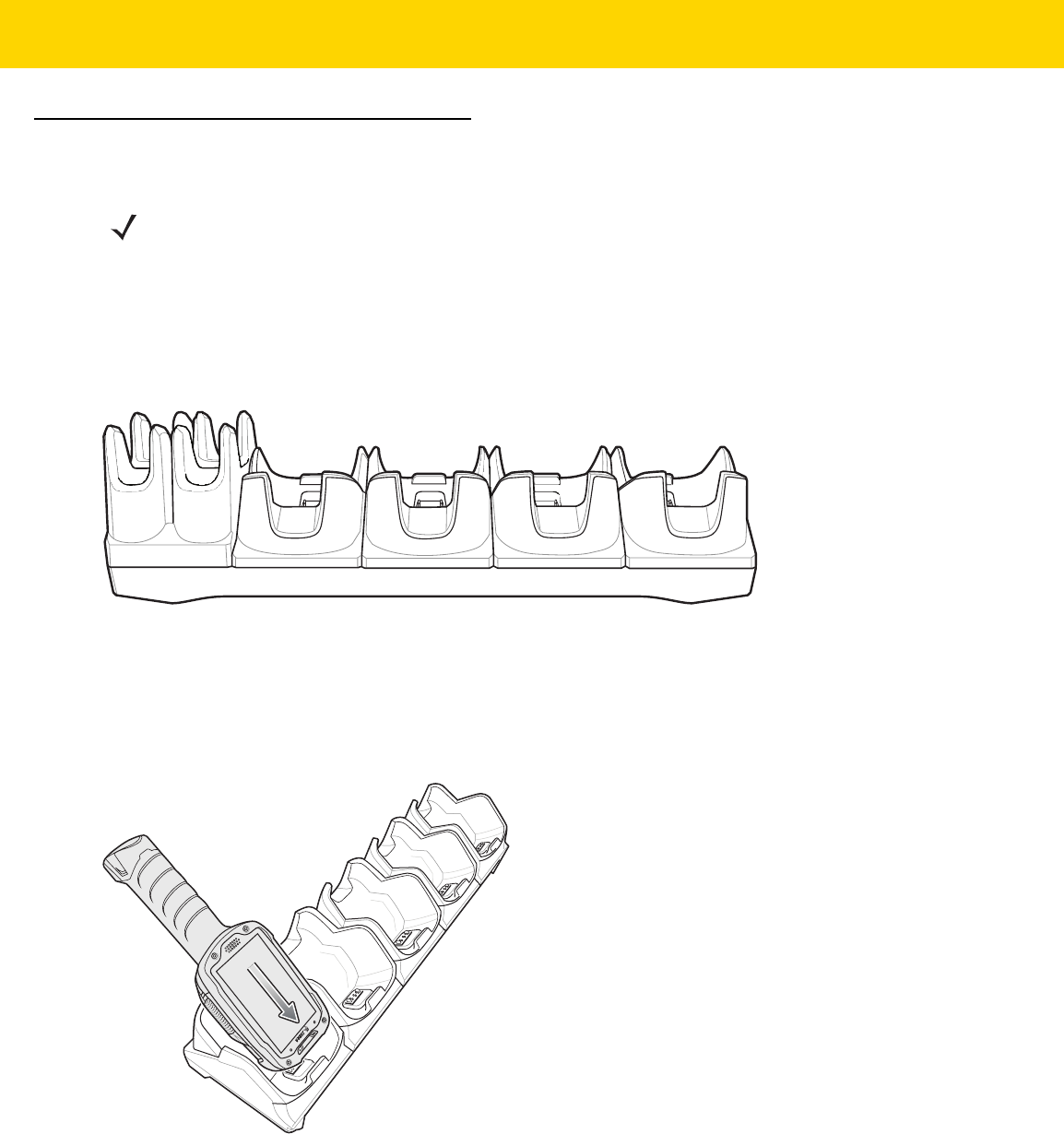
6 - 12 TC8000 User Guide
5-Slot Ethernet Cradle with Battery Charger
The 5-Slot Ethernet Cradle:
•
Provides 5 VDC power for operating the TC8000.
•
Connects up to four TC8000s to an Ethernet network.
•
Simultaneously charges up to four TC8000s.
Figure 6-7 5-Slot Ethernet Cradle
Charging the TC8000
To charge the TC8000:
1. Insert the TC8000 in a charge well to begin charging.
Figure 6-8 TC8000 Battery Charging
2. Ensure that the TC8000 is properly seated in the charge well.
NOTE
Ensure that you follow the guidelines for battery safety described in Battery Safety Guidelines on page 7-1.
NEED DRAWING
Review Copy
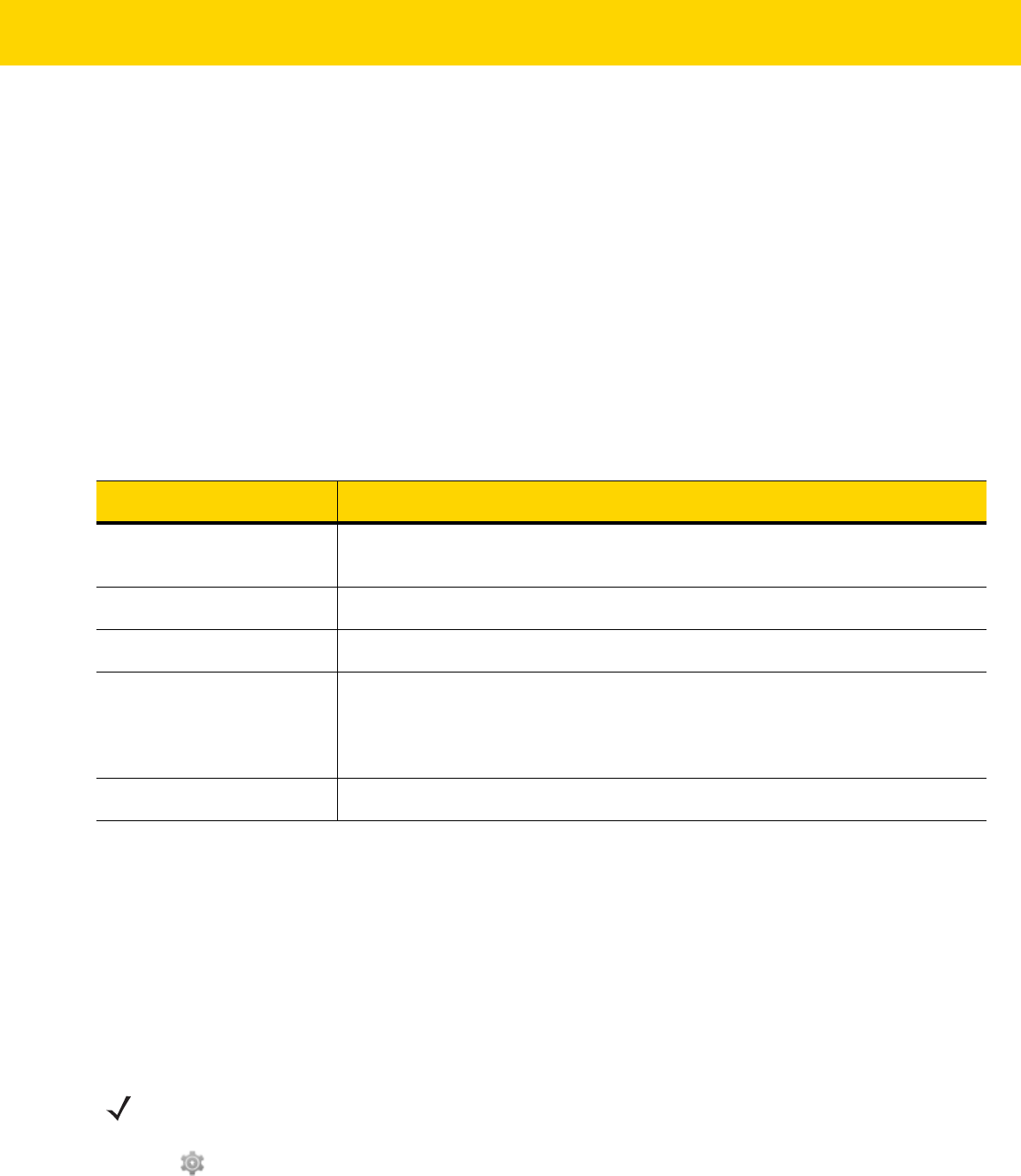
Accessories 6 - 13
Battery Charging
Main Battery Charging
The TC8000 Charging/Scan LED indicates the status of the battery charging in the device. See Table 1-3 on page
1-6.
The 6,400 mAh battery fully charges in less than six hours at room temperature.
Spare Battery Charging
Each Battery Charging LED indicates the status of the battery charging in each slot. The table below describes the
Battery Charging LED status.
The 6400 mAh battery fully charges in less than six hours at room temperature.
Charging Temperature
Charge batteries in temperatures from 0 °C to 40 °C (32 °F to 104 °F). The battery charger always performs battery
charging in a safe and intelligent manner. At higher temperatures (e.g. approximately +37 °C (+98 °F)) the battery
charger may for small periods of time alternately enable and disable battery charging to keep the battery at
acceptable temperatures. The battery charger indicates when charging is disabled due to abnormal temperatures
via its LED.
Establishing Ethernet Communication
1. Touch .
2. Touch Ethernet.
3. Slide the Ethernet switch to the ON position.
Table 6-5 Battery Charging Indicators
State Indication
Off Battery is not charging. It is not inserted correctly in the cradle or connected to a
power source. Charge is not powered.
Solid Amber Battery is charging.
Solid Green Charge complete.
Fast Blinking Red
(2 blinks/second) Charging error, e.g.:
- Temperature is too low or too high.
- Charging has gone on too long without completion (typically eight hours).
Solid Red Battery is at end of useful life.
NOTE
Refer to the TC8000 Integrator Guide for information on configuring the Ethernet settings.
Review Copy
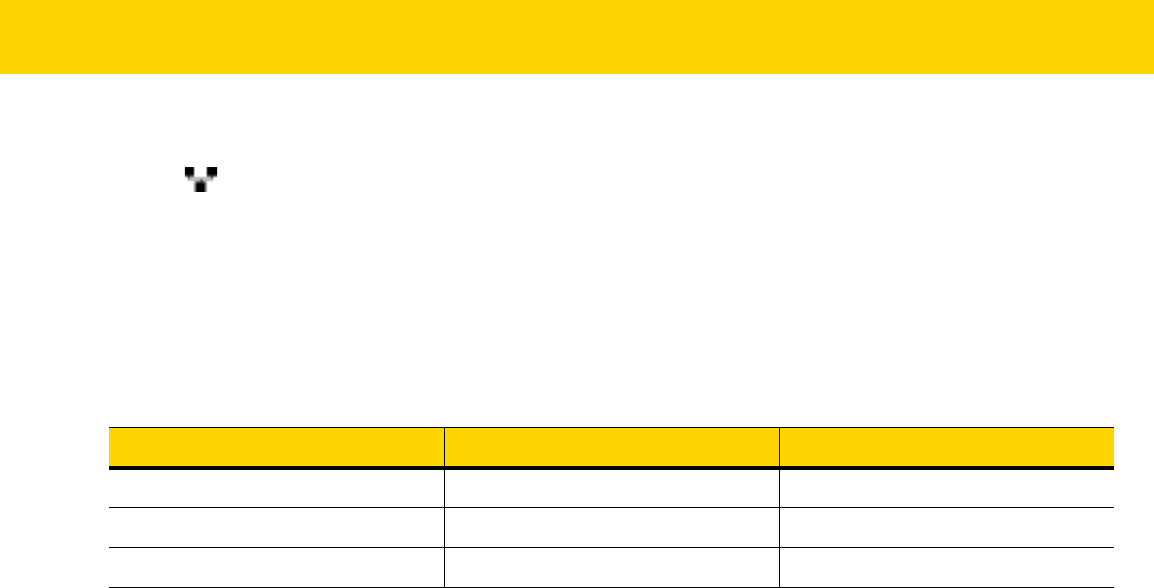
6 - 14 TC8000 User Guide
4. Insert the device into a slot.
5. The icon appears in the Status bar.
6. Touch Eth0 to view Ethernet connection details.
Ethernet LED Indicators
There are two green LEDs on the side of the cradle. These green LEDs light and blink to indicate the data transfer
rate.
Table 6-6 LED Data Rate Indicators
Data Rate 1000 LED 100/10 LED
1 Gbps On/Blink Off
100 Mbps Off On/Blink
10 Mbps Off On/Blink
Review Copy
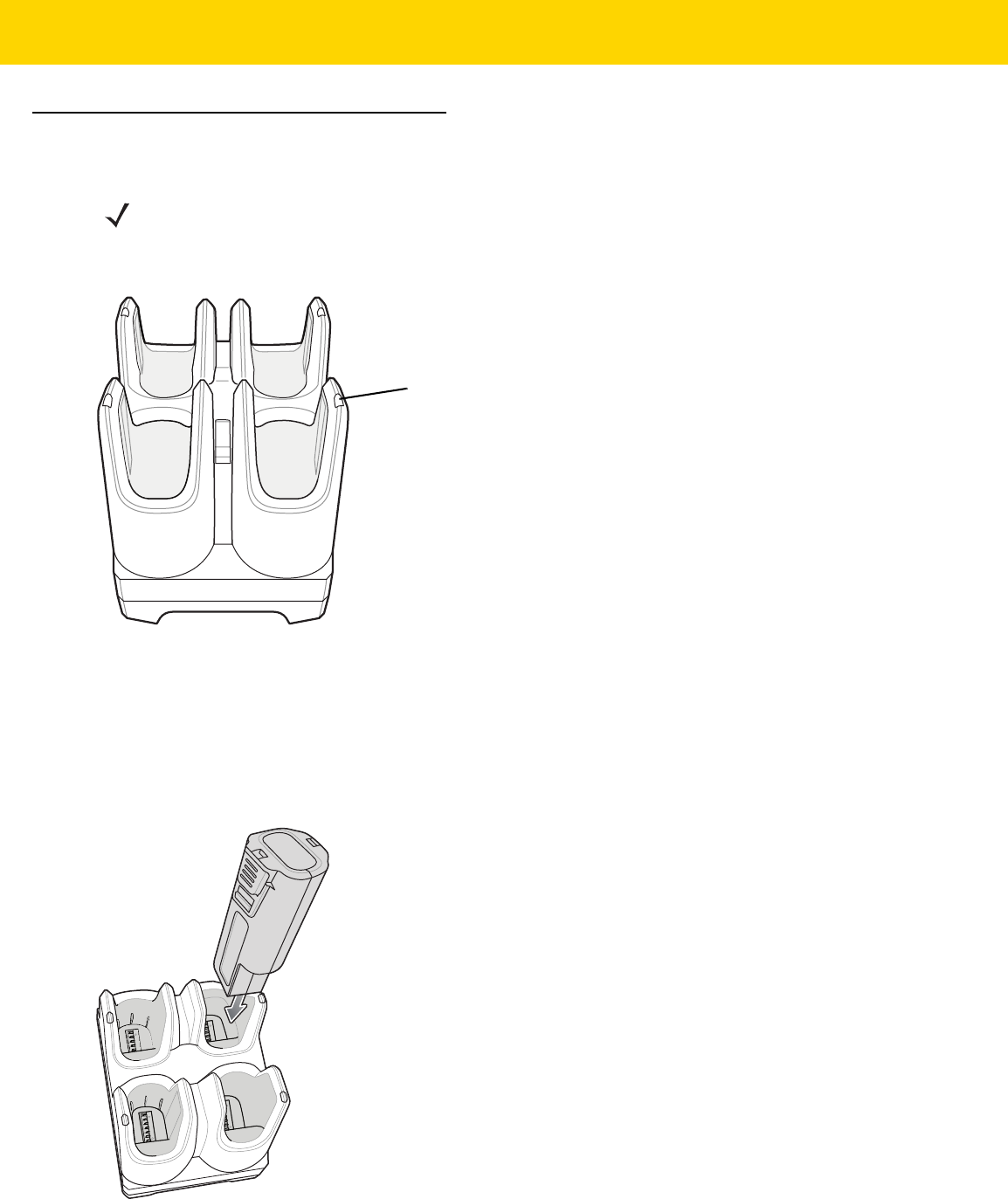
Accessories 6 - 15
4-Slot Battery Charger
The 4-Slot Battery Charger charges up to four TC8000 batteries.
Figure 6-9 4-Slot Battery Charger
Battery Installation
To install the battery:
1. Insert the battery into a battery slot.
2. Gently press down on the battery until it snaps into place.
Figure 6-10 Insert Battery into Slot
NOTE
Ensure that you follow the guidelines for battery safety described in Battery Safety Guidelines on page 7-1.
Battery Charging LEDs (4)
Review Copy
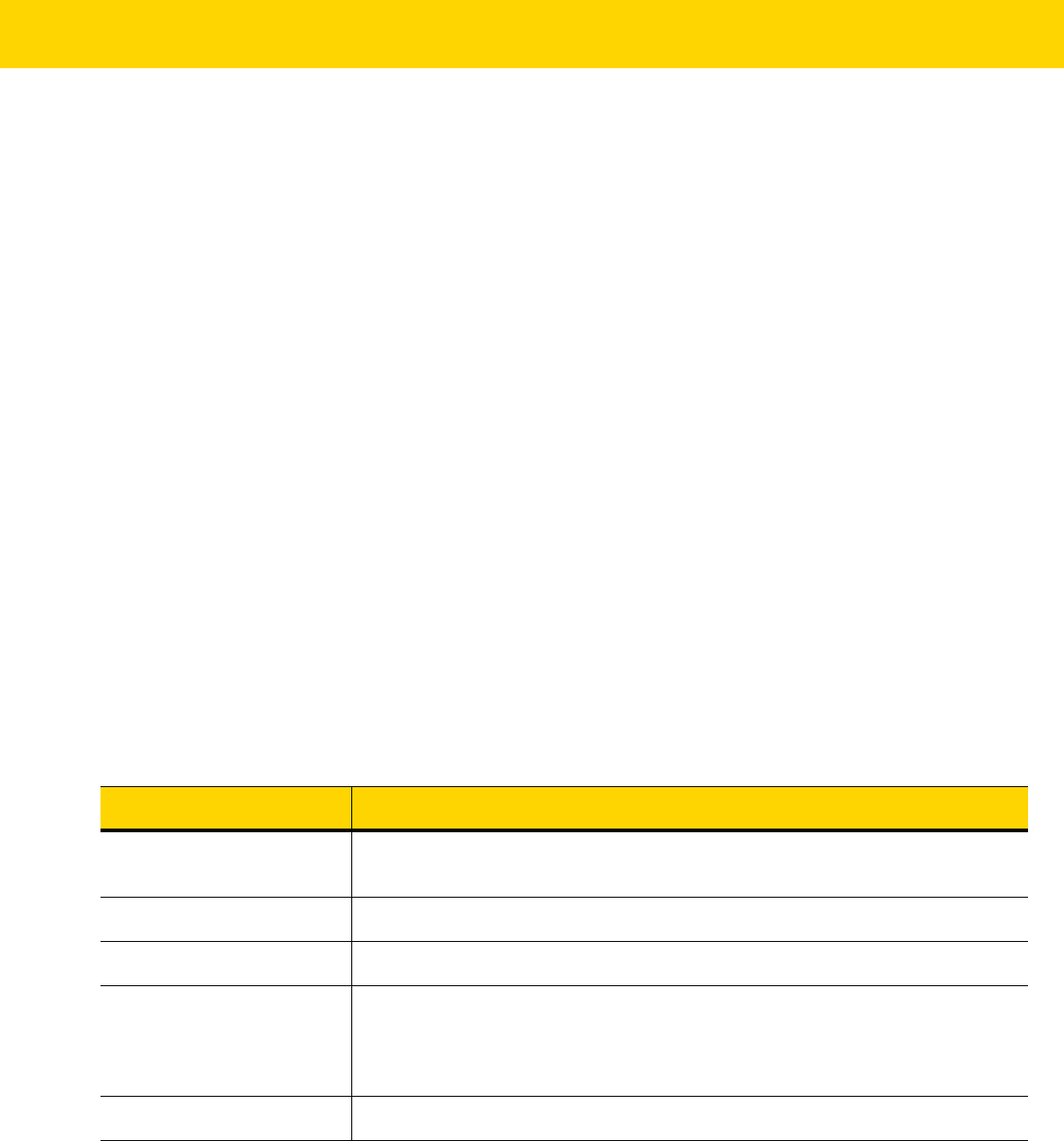
6 - 16 TC8000 User Guide
Battery Removal
To remove the battery, press the two release latches on each side of the battery and lift the battery out of the
battery slot.
Figure 6-11 Remove Battery
Battery Charging
Spare Battery Charging
Each Battery Charging LED indicates the status of the battery charging in each slot. The table below describes the
Battery Charging LED status.
The 6,400 mAh battery fully charges in less than six hours at room temperature.
Charging Temperature
Charge batteries in temperatures from 0 °C to 40 °C (32 °F to 104 °F). The battery charger always performs battery
charging in a safe and intelligent manner. At higher temperatures (e.g. approximately +37 °C (+98 °F)) the battery
charger may for small periods of time alternately enable and disable battery charging to keep the battery at
Table 6-7 Battery Charging Indicators
State Indication
Off Battery is not charging. It is not inserted correctly in the cradle or connected to a
power source. Charger is not powered.
Solid Amber Battery is charging.
Solid Green Charge complete.
Fast Blinking Red
(2 blinks/second) Charging error, e.g.:
- Temperature is too low or too high.
- Charging has gone on too long without completion (typically eight hours).
Solid Red Battery is at end of useful life.
Review Copy

Accessories 6 - 17
acceptable temperatures. The battery charger indicates when charging is disabled due to abnormal temperatures
via its LED.
Review Copy
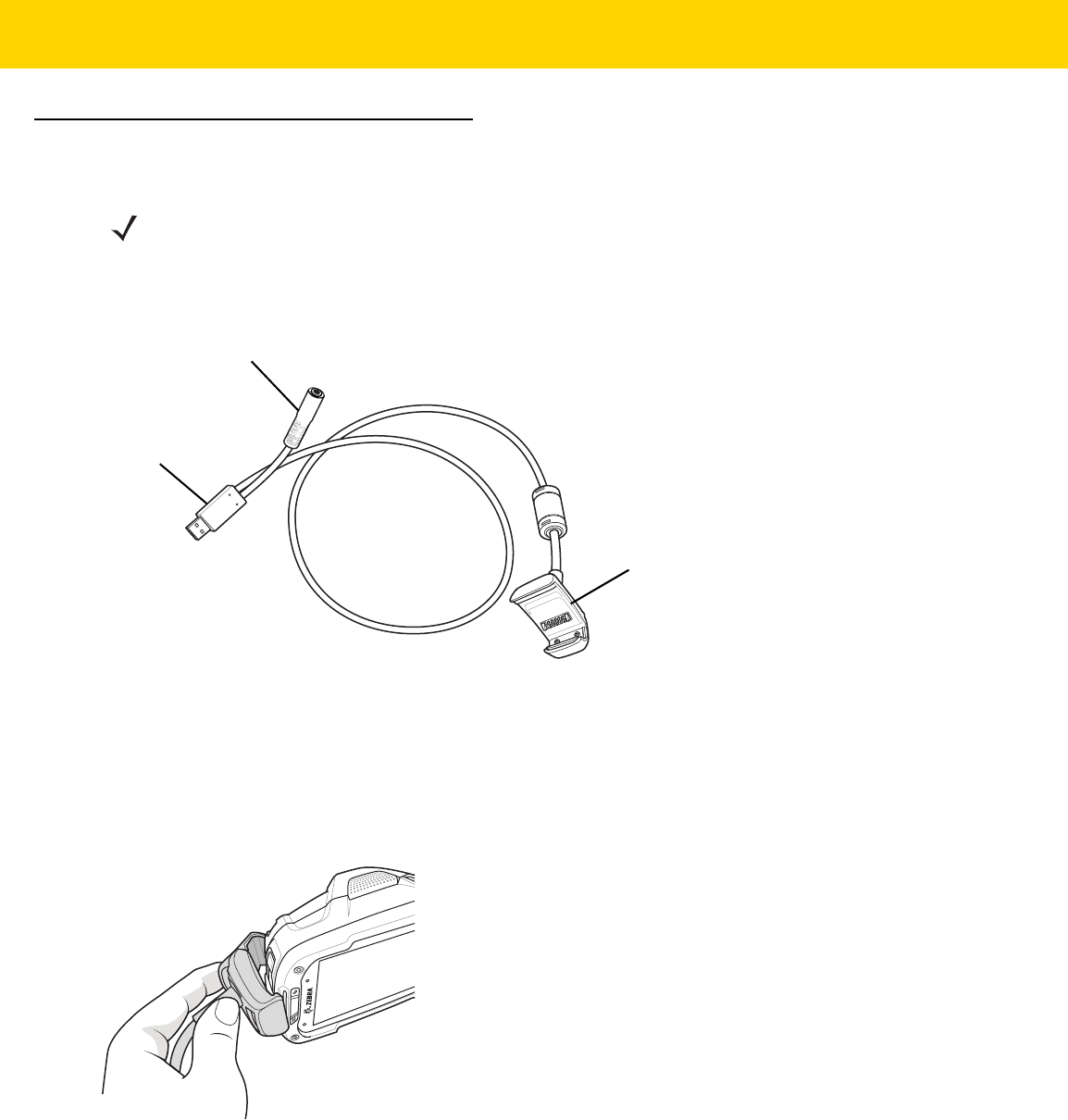
6 - 18 TC8000 User Guide
USB and Charging Cable
The USB and Charging cable snaps onto the top of the TC8000. When attached to the TC8000, allows the TC8000
to transfer data to a host computer and provide power for charging the TC8000.
Figure 6-12 Snap-On USB Cable
Attaching the USB and Charging Cable
1. Align the tabs on the Audio Adapter with the slots on the device.
2. Rotate the Adapter toward the back of the device until the Adapter snaps onto the device.
Figure 6-13 Attach Cable to TC8000
3. Attach the USB connection to the host computer.
USB Communication
1. Connect the USB and Charging Cable to the TC8000.
2. Connect the USB connector of the cable to a host computer.
NOTE
Ensure that you follow the guidelines for battery safety described in Battery Safety Guidelines on page 7-1.
Power Connector
USB Connector
TC8000 Connector
Review Copy

Accessories 6 - 19
Figure 6-14 Power Setup
Removing the USB and Charging Cable
To remove the USB and Charging cable:
1. Press the release level toward the cable.
2. Rotate the adapter toward the front of the device and remove.
Figure 6-15 Remove Audio Adapter
Battery Charging
To charge the TC8000, attached the power cable to the Power Connection on the Snap-On USB cable and it in.
Main Battery Charging
The TC8000 Charging/Scan LED indicates the status of the battery charging in the device. See Table 1-3 on page
1-6.
Review Copy

6 - 20 TC8000 User Guide
The 6,400 mAh battery fully charges in less than six hours at room temperature.
Review Copy
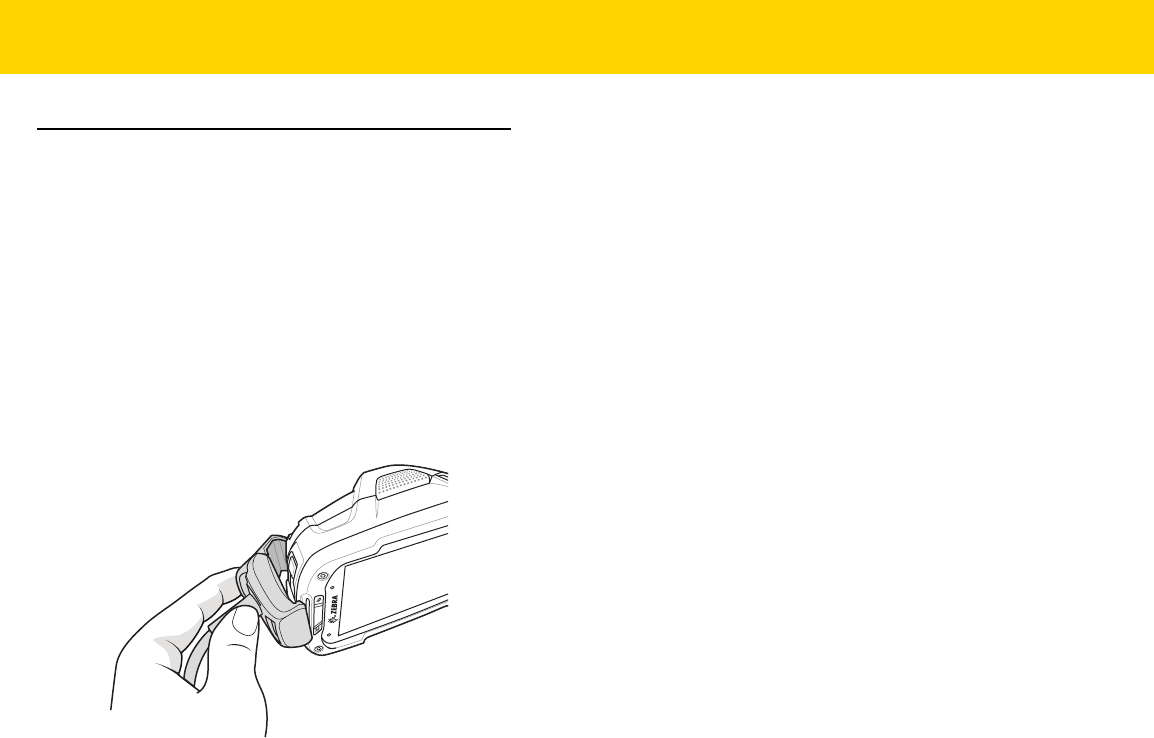
Accessories 6 - 21
Quick Disconnect Audio Adapter
The Quick Disconnect Audio Adapter snaps onto the top of the TC8000 and removes easily when not in use. When
attached to the TC8000, the Quick Disconnect Audio Adapter allows a user to connect a wired headset to the
TC8000.
Attaching the Audio Adapter
1. Align the tabs on the Audio Adapter with the slots on the device.
2. Rotate the Adapter toward the back of the device until the Adapter snaps onto the device.
Figure 6-16 Attach Cable to TC8000
Connecting the Adapter to a Headset
Figure 6-17
Removing the Audio Adapter
To remove the Audio Adapter:
1. Press the release level toward the cable.
Review Copy

6 - 22 TC8000 User Guide
2. Rotate the adapter toward the front of the device and remove.
Figure 6-18 Remove Audio Adapter
Review Copy
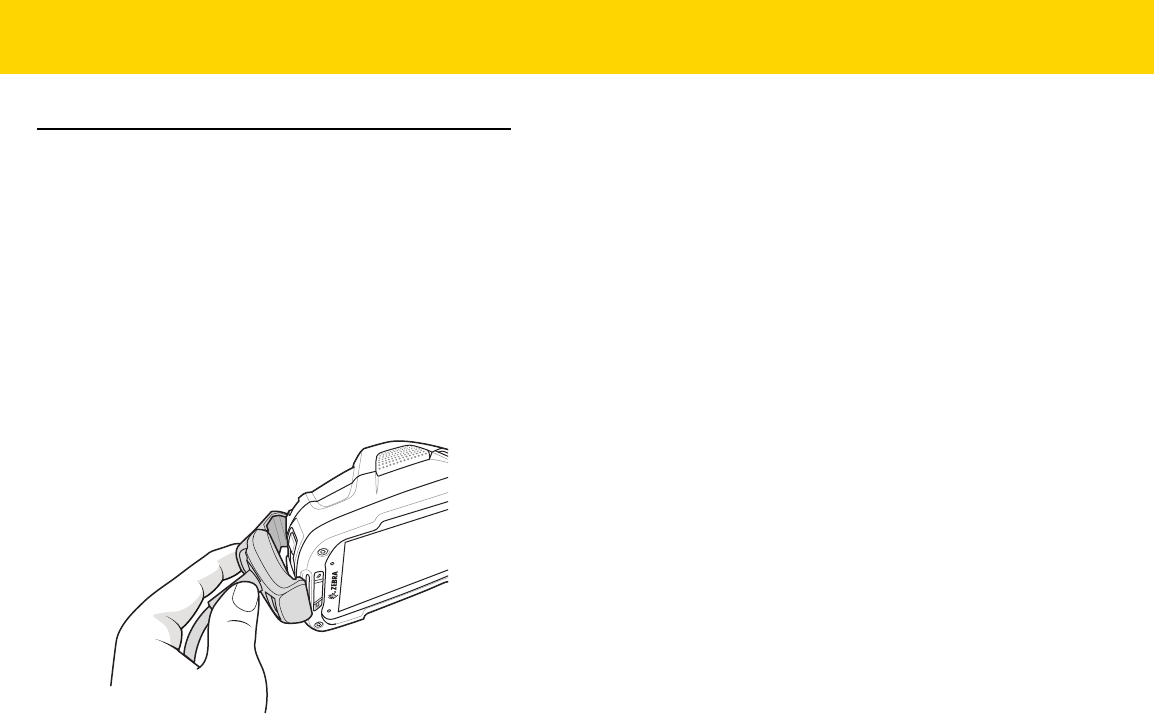
Accessories 6 - 23
3.5 mm Audio Adapter
The 3.5 mm Audio Adapter snaps onto the top of the TC8000 and removes easily when not in use. When attached
to the TC8000, the Audio Adapter allows a user to connect a wired headset to the TC8000.
Attaching the Audio Adapter
1. Align the tabs on the Audio Adapter with the slots on the device.
2. Rotate the Adapter toward the back of the device until the Adapter snaps onto the device.
Figure 6-19 Attach Cable to TC8000
Removing the Audio Adapter
To remove the Audio Adapter:
1. Press the release level toward the cable.
2. Rotate the adapter toward the front of the device and remove.
Figure 6-20 Remove Audio Adapter
Review Copy
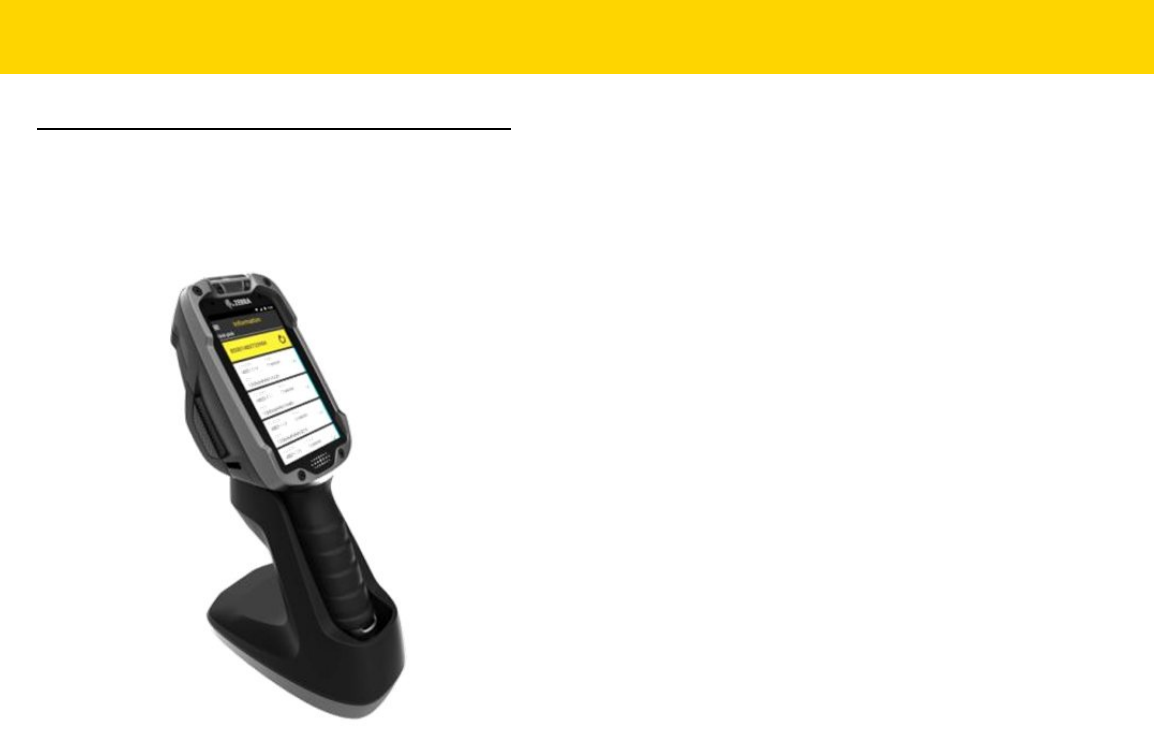
6 - 24 TC8000 User Guide
Desktop Stand
The Desk Stand provides allows the user place the TC8000 in presentation mode for hands-free scanning.
Figure 6-21 Desktop Mount
Review Copy

Accessories 6 - 25
Cart Mount
The Cart Mount
Figure 6-22 Cart Mount
See TC8000 Integrator Guide for assembly instructions.
Review Copy

6 - 26 TC8000 User Guide
Quick-Draw Soft Holster
Figure 6-23 Quick-Draw Holster
Review Copy

Accessories 6 - 27
Presentation Holster
Figure 6-24 Presentation Holster
Review Copy
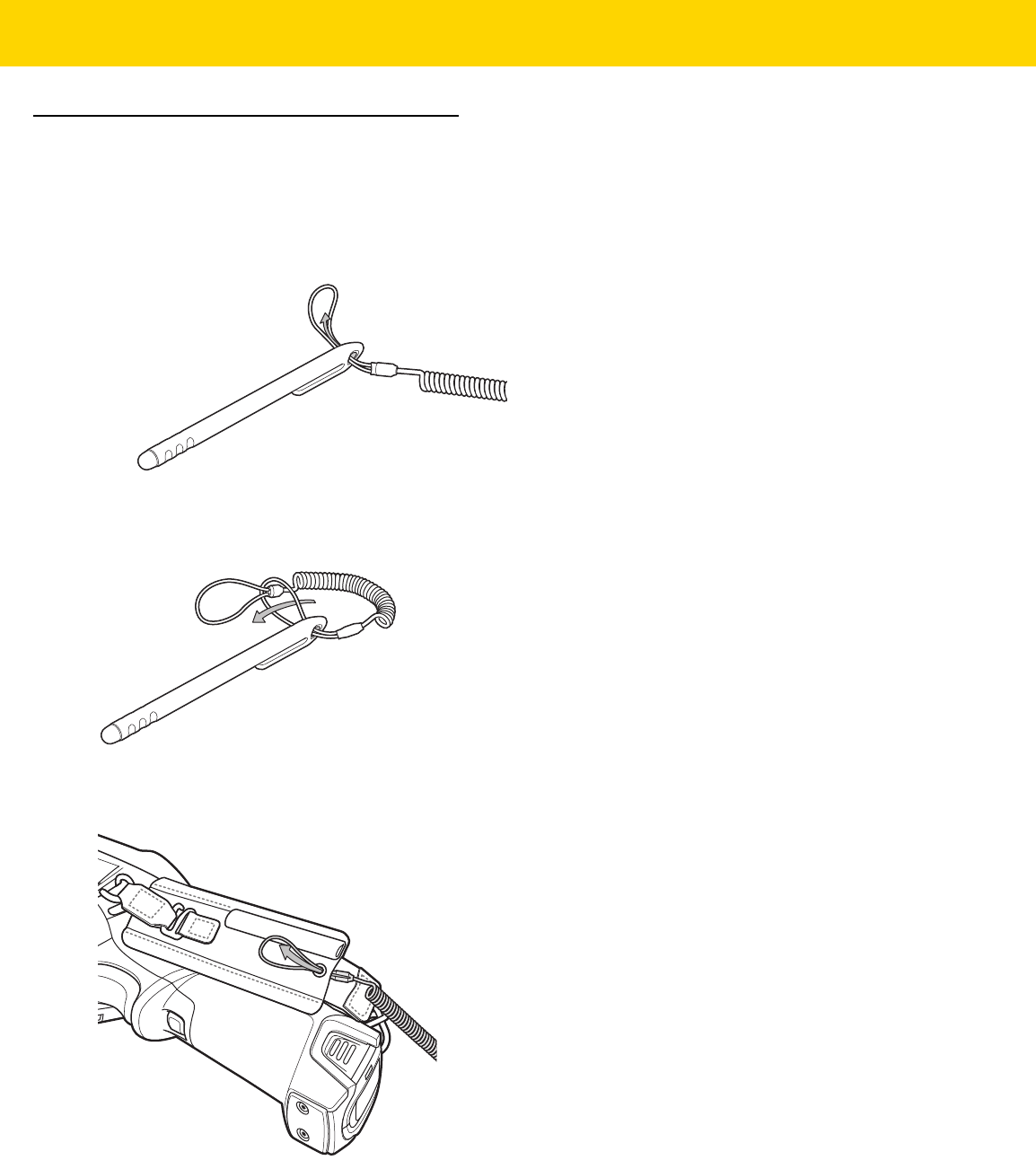
6 - 28 TC8000 User Guide
Stylus
To install the stylus onto the hand strap:
1. Thread the loop of the tether through the hole in the stylus.
Figure 6-25 Thread Loop through Stylus Hole
2. Thread the other end of the tether through the loop.
Figure 6-26
3.
Figure 6-27 Feed Loop through Hand Strap Hole
4.
Review Copy
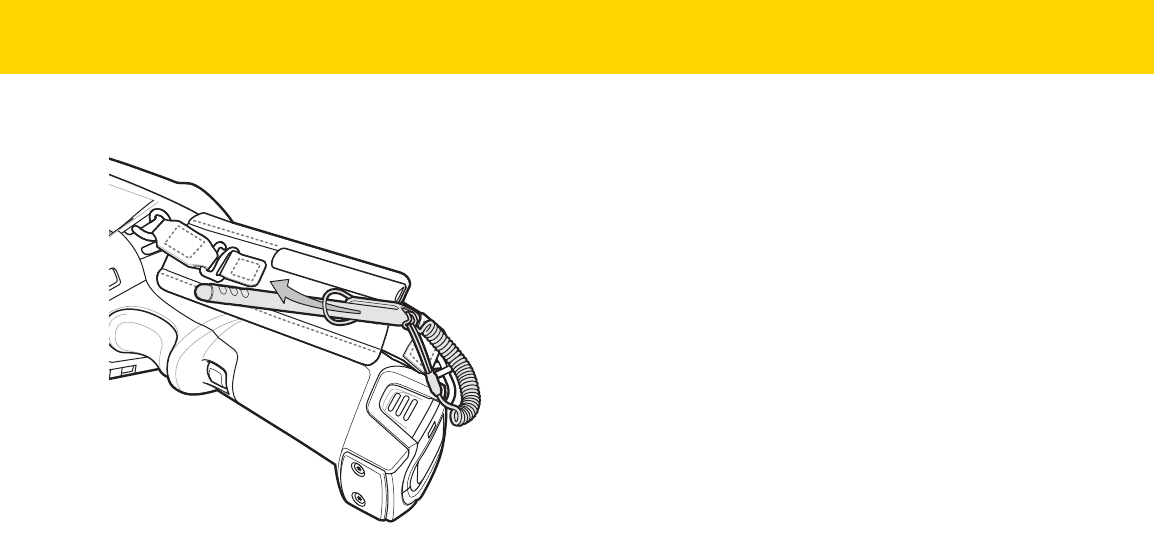
Accessories 6 - 29
Figure 6-28 Feed Stylus Through Loop
5. Pull stylus through the loop and tighten.
Review Copy

6 - 30 TC8000 User Guide
Review Copy

CHAPTER 7 MAINTENANCE AND
TROUBLESHOOTING
Introduction
This chapter includes instructions on cleaning and storing the TC8000, battery maintenance and provides
troubleshooting solutions for potential problems during TC8000 operations.
Maintaining the TC8000
For trouble-free service, observe the following tips when using the TC8000:
•
Protect the TC8000 from temperature extremes.
•
Do not store or use the TC8000 in any location that is extremely dusty, damp, or wet.
•
Use a soft lens cloth to clean the scan exit window of the TC8000. If the surface of the TC8000 screen
becomes soiled, clean it with a soft cloth moistened with a diluted window-cleaning solution. Do not use
bleach or ammonia.
•
Take care not to scratch the screen of the TC8000.
•
The display of the TC8000 contains glass. Take care not to drop the TC8000 or subject it to strong impact.
Battery Safety Guidelines
•
The area in which the TC8000 units are charged should be clear of debris and combustible materials or
chemicals. Particular care should be taken where the device is charged in a non-commercial environment.
•
Do not use incompatible batteries and chargers. If you have any questions about the compatibility of a
battery or a charger, contact Zebra Support. See Service Information on page xiii for contact information.
•
Do not crush, puncture, or place a high degree of pressure on the battery.
•
Follow battery usage, storage, and charging guidelines found in the TC8000 Quick Reference Guide.
•
Improper battery use may result in a fire, explosion, or other hazard.
•
To charge the mobile device battery, the battery and charger temperatures must be between +32°F and
+104°F (0°C and +40°C)
Review Copy
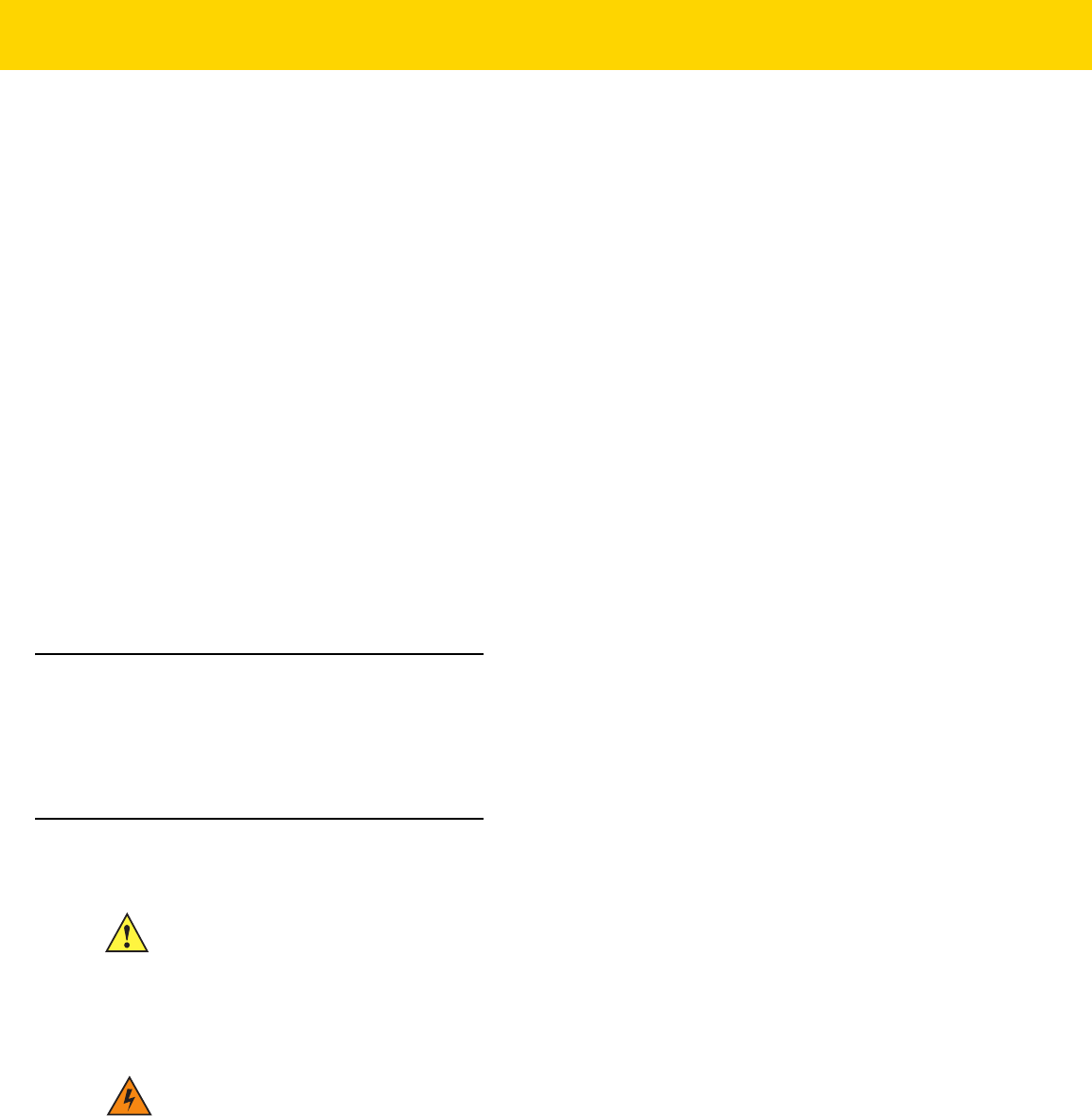
7 - 2 TC8000 User Guide
•
Do not disassemble or open, crush, bend or deform, puncture, or shred.
•
Severe impact from dropping any battery-operated device on a hard surface could cause the battery to
overheat.
•
Do not short circuit a battery or allow metallic or conductive objects to contact the battery terminals.
•
Do not modify or remanufacture, attempt to insert foreign objects into the battery, immerse or expose to water
or other liquids, or expose to fire, explosion, or other hazard.
•
Do not leave or store the equipment in or near areas that might get very hot, such as in a parked vehicle or
near a radiator or other heat source. Do not place battery into a microwave oven or dryer.
•
Battery usage by children should be supervised.
•
Please follow local regulations to promptly dispose of used re-chargeable batteries.
•
Do not dispose of batteries in fire.
•
Seek medical advice immediately if a battery has been swallowed.
•
In the event of a battery leak, do not allow the liquid to come in contact with the skin or eyes. If contact has
been made, wash the affected area with large amounts of water and seek medical advice.
•
If you suspect damage to your equipment or battery, call Customer Support to arrange for inspection. See
Service Information on page xiii for contact information.
Long Term Storage
When storing the TC8000 for a long period of time, it is recommended to remove the battery.
When returning the TC8000 to everyday operation, install a fully charged battery.
Cleaning
Materials Required
•
Alcohol wipes
•
Lens tissue
•
Cotton tipped applicators
•
Isopropyl alcohol
CAUTION
Always wear eye protection.
Read warning label on compressed air and alcohol product before using.
If you have to use any other solution for medical reasons please contact Symbol Technologies for
more information.
WARNING
!
Avoid exposing this product to contact with hot oil or other flammable liquids. If such
exposure occurs, unplug the device and clean the product immediately in accordance with
these guidelines.
Review Copy
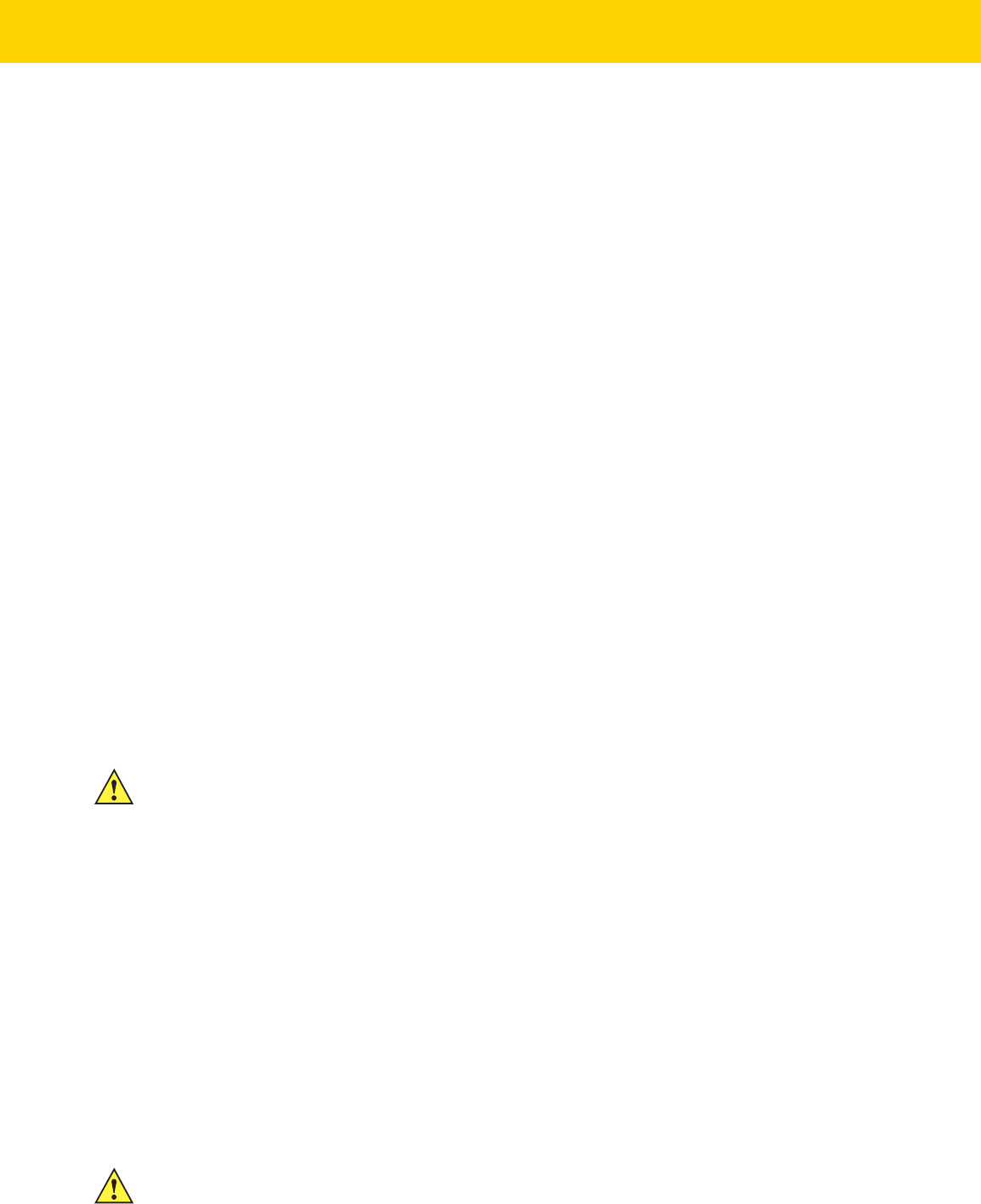
Maintenance and Troubleshooting 7 - 3
•
Can of compressed air with a tube.
Cleaning the TC8000
Housing
Using the alcohol wipes, wipe the housing including the Scan key.
Display
The display can be wiped down with the alcohol wipes, but care should be taken not to allow any pooling of liquid
around the edges of the display. Immediately dried the display with a soft, non-abrasive cloth to prevent streaking.
Scan Exit Window
Wipe the scan exit window periodically with a lens tissue or other material suitable for cleaning optical material
such as eyeglasses.
Power Connector
1. Remove the main battery from TC8000.
2. Install the battery cover.
3. Dip the cotton portion of the cotton tipped applicator in isopropyl alcohol.
4. Repeat at least three times.
5. Use the cotton tipped applicator dipped in alcohol to remove any grease and dirt near the connector area.
6. Use a dry cotton tipped applicator and repeat steps 3 through 6.
7. Spray compressed air on the connector area by pointing the tube/nozzle about ½ inch away from the surface.
8. Inspect the area for any grease or dirt, repeat if required.
Cleaning Cradle Connectors
Use this procedure to clean the connectors on a cradle:
1. Remove power from the cradle.
2. Dip the cotton portion of the cotton tipped applicator in isopropyl alcohol.
3. Rub the cotton portion of the cotton tipped applicator along the pins of the connector. Slowly move the
applicator back-and-forth from one side of the connector to the other. Do not let any cotton residue on the
connector.
4. All sides of the connector should also be rubbed with the cotton tipped applicator.
5. Spray compressed air in the connector area by pointing the tube/nozzle about ½ inch away from the surface.
CAUTION
Do not point nozzle at yourself and others, ensure the nozzle or tube is away from your face.
CAUTION
Do not point nozzle at yourself and others, ensure the nozzle or tube is pointed away from your face.
Review Copy

7 - 4 TC8000 User Guide
6. Ensure that there is no lint left by the cotton tipped applicator, remove lint if found.
7. If grease and other dirt can be found on other areas of the cradle, use lint free cloth and alcohol to remove.
8. Allow at least 10 to 30 minutes (depending on ambient temperature and humidity) for the alcohol to air dry
before applying power to cradle.
If the temperature is low and humidity is high, longer drying time is required. Warm temperature and dry
humidity requires less drying time.
Cleaning Frequency
The cleaning frequency is up to the customer’s discretion due to the varied environments in which the TC8000
units are used. They may be cleaned as frequently as required. However when used in dirty environments it may
be advisable to periodically clean the scanner exit window to ensure optimum scanning performance.
Review Copy
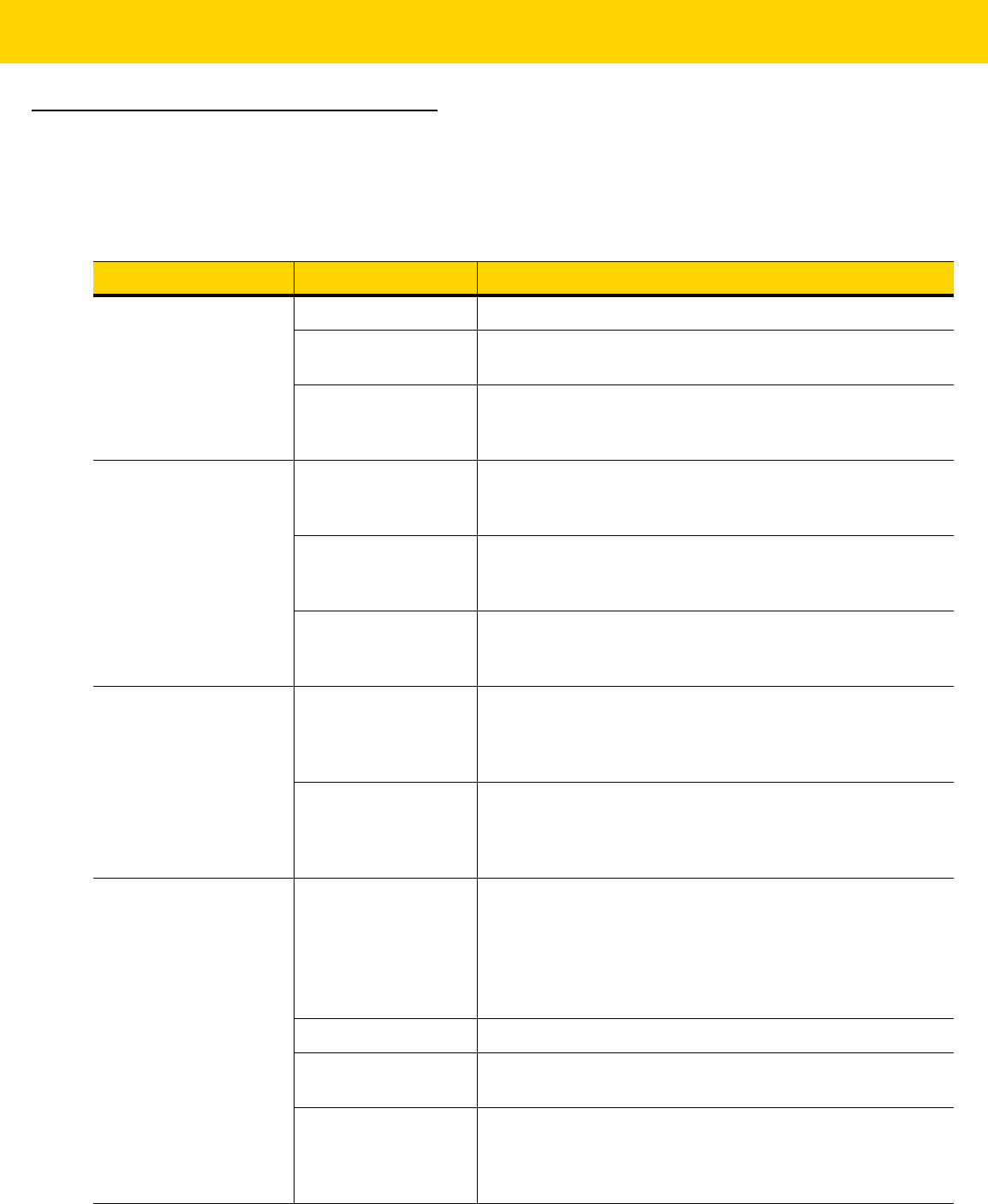
Maintenance and Troubleshooting 7 - 5
Troubleshooting
TC8000
Table 7-1 Troubleshooting the TC8000
Problem Cause Solution
TC8000 does not turn
on. Battery not charged. Charge or replace the battery in the TC8000.
Battery not installed
properly. Ensure battery is installed properly. See
Installing the Battery
on page 1-4
.
System crash. Perform a soft reset. If the TC8000 still does not turn on,
perform a hard reset. See
Resetting the TC8000 on page
2-15
.
Battery did not charge. Battery failed. Replace battery. If the TC8000 still does not operate, try a soft
reset, then a hard reset. See
Resetting the TC8000 on page
2-15
.
TC8000 removed from
cradle before charging
completed.
Insert the TC8000 into the cradle and begin charging. The
battery fully charges in approximately four hours.
Ambient temperature
of the cradle is too
warm or too cold.
The ambient temperature must be between 0 °C and 40 °C
(32 °F and 104 °F).
During data
communication, no data
was transmitted, or
transmitted data was
incomplete.
TC8000 unplugged
from host computer
during
communication.
Reconnect the programming cable to the host computer and
re-transmit.
Communication
software was
incorrectly installed or
configured.
See system administrator.
TC8000 turns itself off. TC8000 is inactive. The TC8000 turns off after a period of inactivity. If the TC8000
is running on battery power, this period can be set to 15
seconds, 30 seconds, 1 minute, 2 minutes, 5 minutes, 10
minutes, or 30 minutes.
TC8000Change the setting if you need a longer delay before
the automatic shutoff feature activates.
Battery is depleted. Place the TC8000 in the cradle to re-charge the battery.
Battery is not inserted
properly. Insert the battery properly (see
Installing the Battery on page
1-4
).
The
TC8000
’s battery
is low and it powers
down to protect
memory content.
Place the TC8000 in the cradle to re-charge the battery.
Review Copy
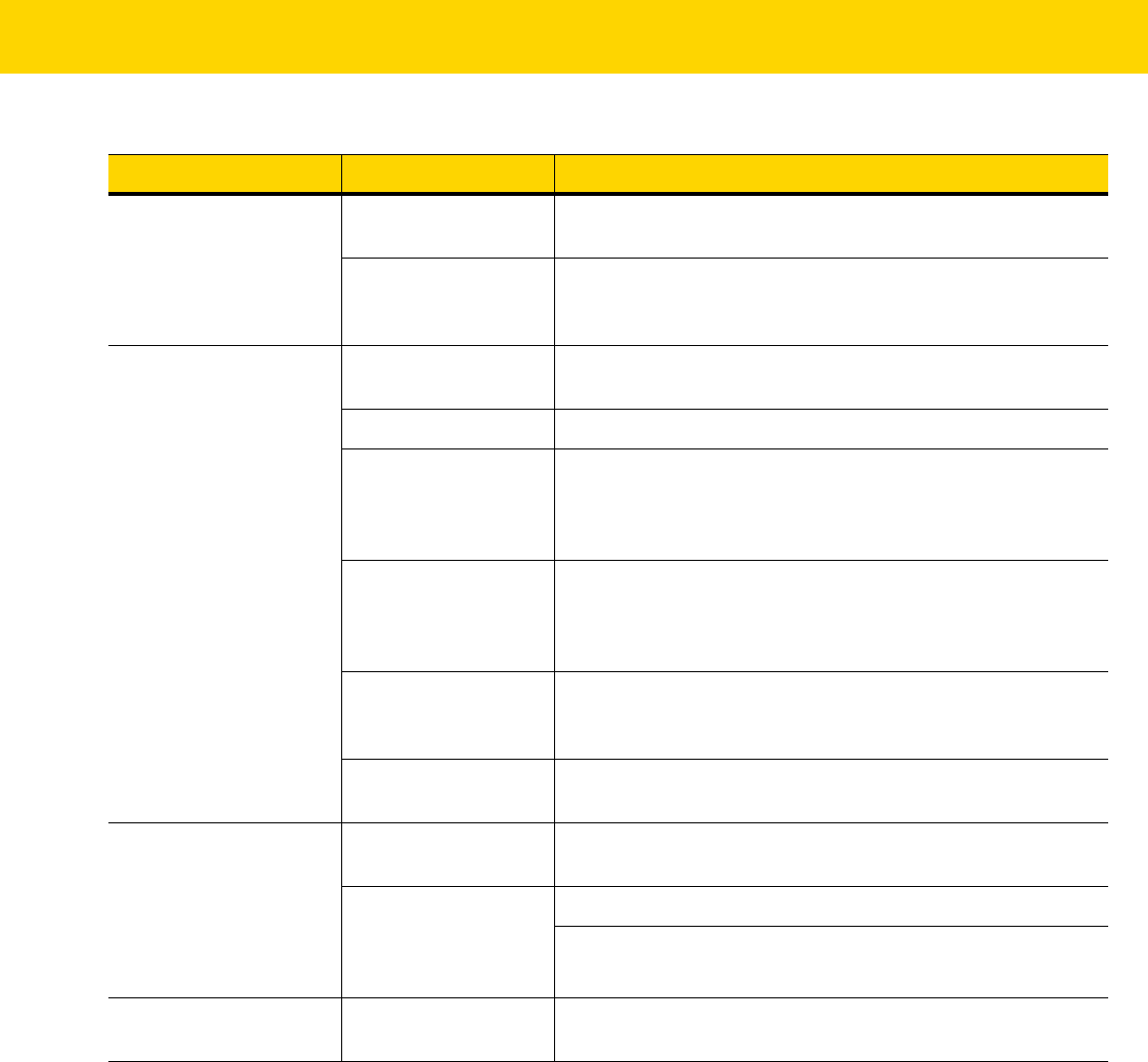
7 - 6 TC8000 User Guide
A message appears
stating that the TC8000
memory is full.
Too many files stored
on the TC8000. Delete unused memos and records. You can save these
records on the host computer.
Too many applications
installed on the
TC8000.
If you have installed additional applications on the TC8000,
remove them to recover memory. See
Uninstalling an
Application on page 10-4
.
The TC8000 does not
accept scan input. Scanning application
is not loaded. Verify that the TC8000 is loaded with a scanning application.
See the System Administrator.
Unreadable bar code. Ensure the symbol is not defaced.
Distance between
imager exit window
and bar code is
incorrect.
Move the TC8000 closer or further from the bar code to the
proper scanning range.
TC8000 is not
programmed for the
bar code.
Verify that the TC8000 can read the type of bar code being
scanned (See
Technical Specifications
). Ensure that the bar
code parameters are set properly for the bar code being
scanned.
TC8000 is not
programmed to
generate a beep.
Verify that a beep on a good decode is used. See
Bar Code
Input on page 9-10
for more information.
Battery is low. If the scanner is still not reading symbols, contact the
distributor or service.
During USB data
communications, no data
was transmitted, or
transmitted data was
incomplete.
Incorrect cable
connection. See
Chapter 6, Accessories
.
Communications
software is not
installed or configured
properly.
Perform setup as described in
Chapter 6, Accessories
.
Ensure that a sync program is installed on the host computer.
Cannot sync with Host
Computer Host computer not
configured properly. Ensure that sync program on the host computer is set to allow
USB connections.
Table 7-1 Troubleshooting the TC8000 (Continued)
Problem Cause Solution
Review Copy
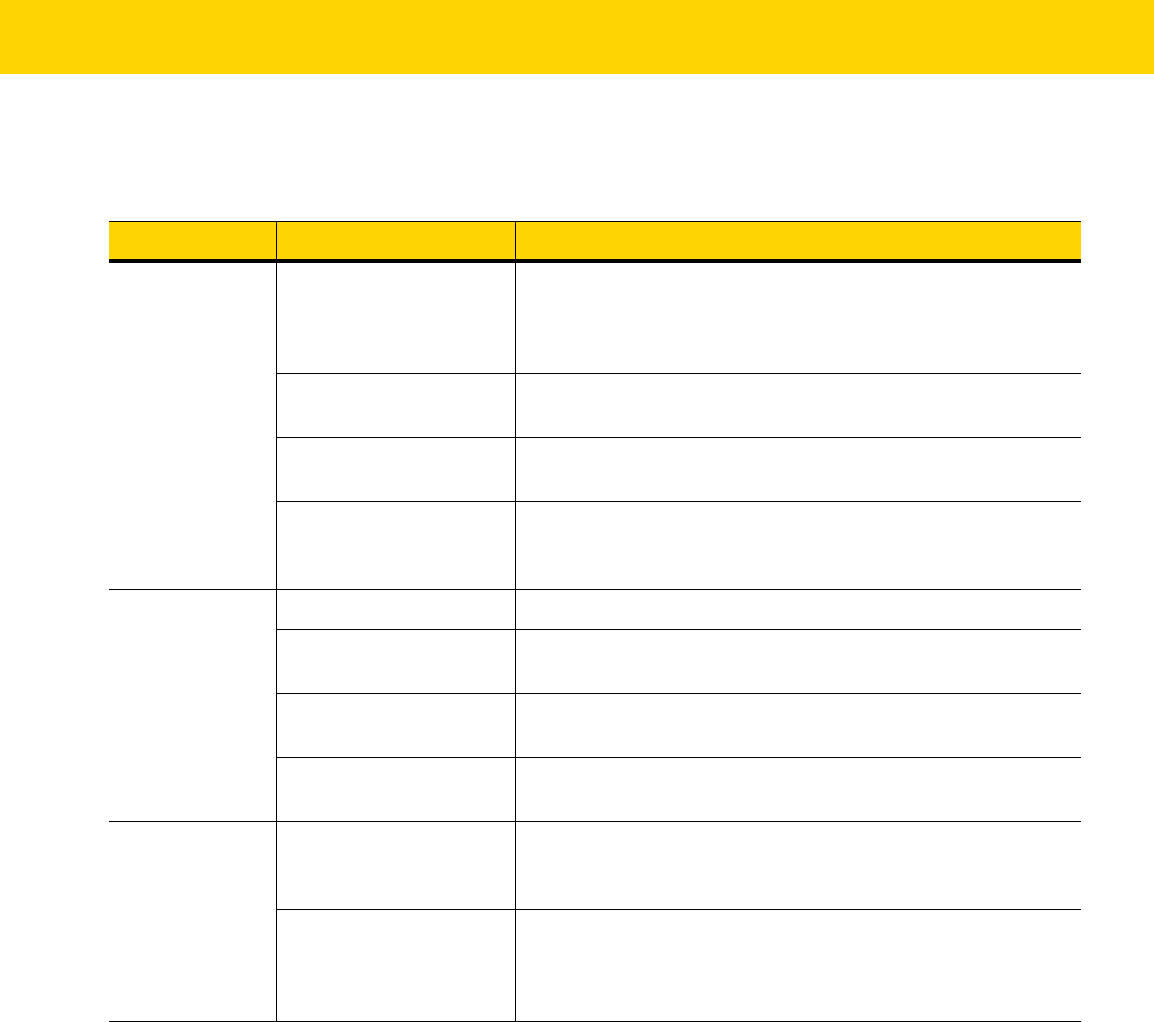
Maintenance and Troubleshooting 7 - 7
Cradles
Table 7-2 Troubleshooting the Cradles
Symptom Possible Cause Solution
TC8000 battery
is not charging. TC8000 was removed
from cradle or cradle was
unplugged from AC
power.
Ensure cradle is receiving power. Ensure TC8000 is seated
correctly. Confirm main battery is charging. The battery fully
charges in approximately four hours.
Battery is faulty. Verify that other batteries charge properly. If so, replace the
faulty battery (see
Installing the Battery on page 1-4
).
The TC8000 is not fully
seated in the cradle. Remove and re-insert the TC8000 into the cradle, ensuring it is
firmly seated.
Ambient temperature of
the cradle is too warm or
too cold.
Move the cradle to an area where the ambient temperature is
between 0 °C and 40 °C (32 °F and 104 °F).
When the
TC8000 is
placed in the
cradle, the cradle
LED does not
blink.
Cradle is not powered. Ensure cradle is receiving power.
Cradle firmware is
corrupted. Contact system administrator.
The TC8000 is not
operational. Contact system administrator.
Cradle - TC8000
communication error.
Contact system administrator.
Cradle LED
blinks red. The cradle is issued an
unlock command and it
fails to unlock.
Contact system administrator.
Cradle is overheating
due to continuous
lock/unlock or other
cradle faults.
Contact system administrator.
Review Copy

7 - 8 TC8000 User Guide
Review Copy
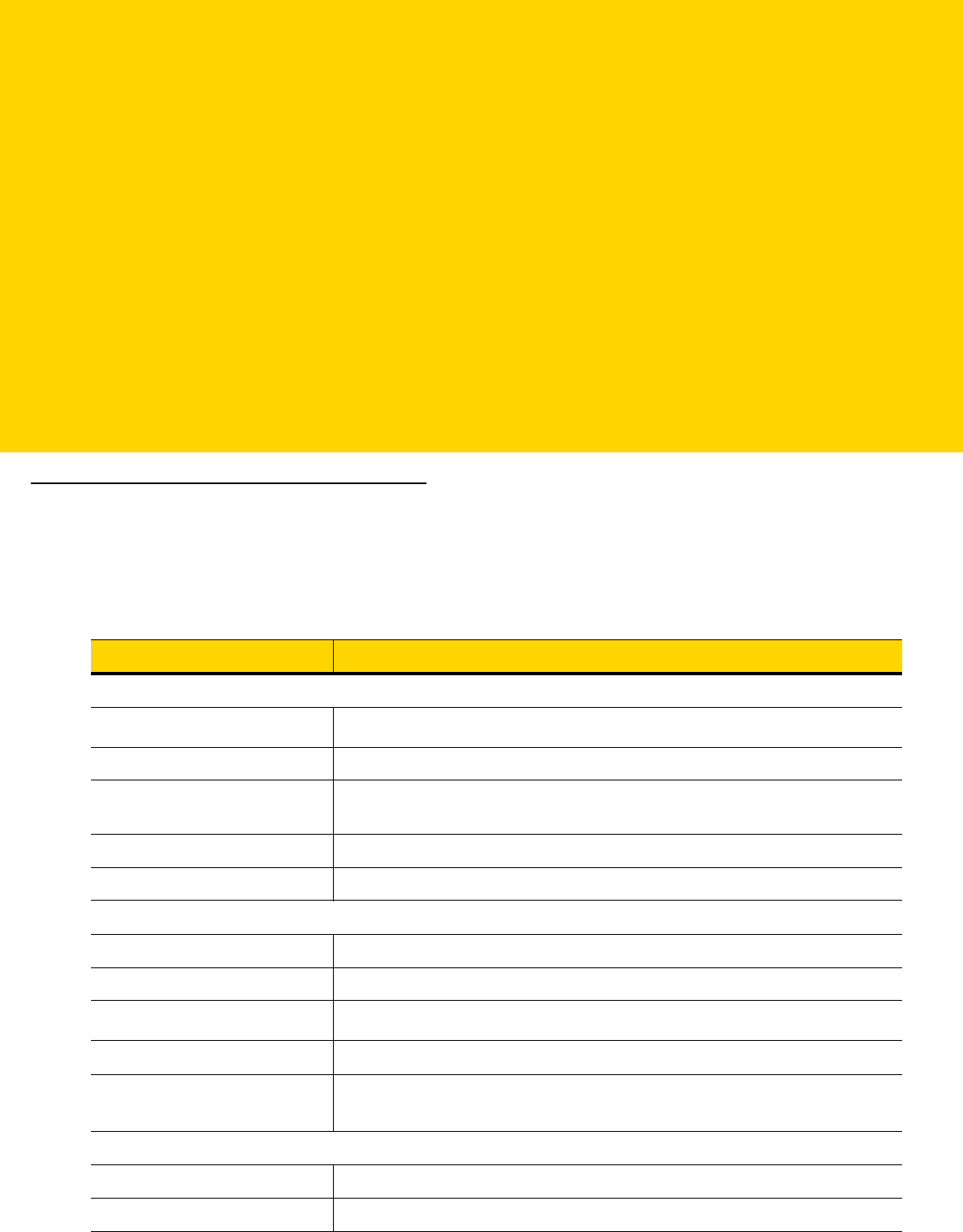
APPENDIX A SPECIFICATIONS
Technical Specifications
The following tables summarize the TC8000’s intended operating environment and general technical hardware
specifications.
Table A-1 Technical Specifications
Item Description
Physical and Environmental Characteristics
Dimensions (H x L x W) 233 mm x 76 mm x 64 mm
Weight 500 g (SE965 scan engine)
Display Color LCD, 4",480x800 WVGA resolution, 16 bits/pixel RGB, 450 Nits LED
backlight, capacitive touch screen
Speaker 2W speaker
Main Battery PowerPrecision+ rechargeable 3.7 VDC 6400 mAh Lithium Ion battery
Performance Characteristics
CPU Qualcomm 8060 Pro Dual Core 1.7 GHz
Operating System Android -based AOSP 4.4.3
Memory
1 GB RAM / 4 GB Flash, 1 GB RAM / 8 GB Flash optional
Application Development Zebra Android EMDK.
Data Capture Method SE4750 imager (SR and MR), SE965 laser
8 MP auto-focus, color camera w/ flash optional
User Environment
Operating Temperature 0° C to 40° C (32° F to 104° F)
Storage Temperature -20° C to 60° C (-4° F to 140° F)
Review Copy
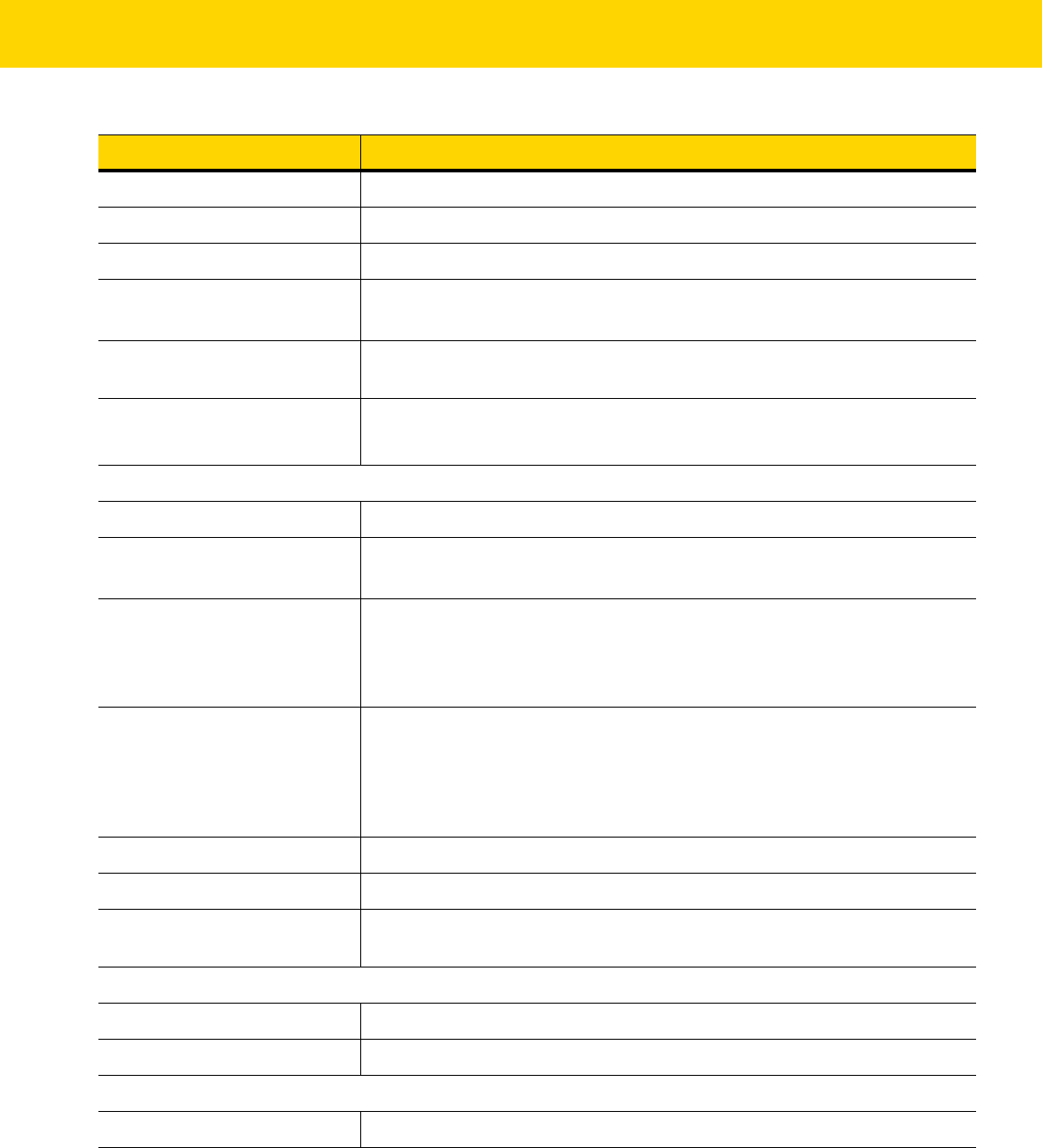
A - 2 TC8000 User Guide
Battery Charging Temperature 0° C to +40° C (32° F to 104° F) ambient temperature range.
Humidity 40° C (RH 10% - 95%) Non-condensing
Flammability UL94V1
Drop Specification 4 ft.(1.2 m) to vinyl tile over concrete, over product temperature range.
4 ft.(1.2 m) to concrete, at room temperature of 23° C (73.4° F).
Sealing Liquid penetration per “A4T Casual Spill Test Spec” document number
71-98611-01. Applies ONLY with battery installed.
ESD ± 20k VDC air discharge
± 10k VDC contact discharge
Wireless LAN Data Communications
Radio IEEE ® 802.11a/b/g/n/d/h/i/k/r
Data Rates 5GHz: 802.11a/n - up to 72.2 Mbps;
2.4GHz: 802.11b/g/n - up to 72.2 Mbps
Operating Channels Channels 36 - 165 (5180 - 5825 MHz)
Channels 1 - 13 (2412 - 2472 MHz)
Actual operating channels/frequencies depend on regulatory rules and
certification agency
Security and Encryption WEP (40 or 104 bit);
WPA/WPA2 Personal (TKIP, and AES);
WPA/WPA2 Enterprise (TKIP, and AES) - EAP-TTLS (PAP, MSCHAP,
MSCHAPv2), EAP-TLS, PEAPv0- MSCHAPv2, PE APv1-EAP-GTC,
EAP-FAST (MSCHAPv2 and EAP-GTC) and LEAP
Multimedia Wi-Fi Multimedia™ (WMM)
Certifications WFA (802.11n, WMM, WMM-PS), Cisco CCXv4
Fast Roam PMKID Caching, Opportunistic Key Caching (OKC), Cisco CCKM, 802.11r,
Zebra Aggregated FT
Wireless PAN Data Communications
Bluetooth V4.0 with Low Energy
USB USB 2.0 Client for service and maintenance
Imager Decode Capability
•
Table A-1 Technical Specifications (Continued)
Item Description
Review Copy

INDEX
A
Numerics
2-D bar codes . . . . . . . . . . . . . . . . . . . . . . . . . . . . . . 3-2
A
accessories . . . . . . . . . . . . . . . . . . . . . . . . . . . . . . . . 6-1
airplane mode . . . . . . . . . . . . . . . . . . . . . . . . . . . . . 1-12
albums . . . . . . . . . . . . . . . . . . . . . . . . . . . . . . . . . . . 5-12
application shortcuts . . . . . . . . . . . . . . . . . . . . . . . . . 2-5
applock administrator . . . . . . . . . . . . . . . . . . . . . . . 2-10
B
bar codes
two dimensional . . . . . . . . . . . . . . . . . . . . . . . . . 3-2
battery charging temperature . . . . . . . . . . . . . . . . . . A-2
battery usage . . . . . . . . . . . . . . . . . . . . . . . . . . . . . . 1-10
browser . . . . . . . . . . . . . . . . . . . . . . . . . . . . . . . . . . . 2-8
bullets . . . . . . . . . . . . . . . . . . . . . . . . . . . . . . . . . . . . .xiii
C
calculator . . . . . . . . . . . . . . . . . . . . . . . . . . . . . . . . . . 2-8
calendar . . . . . . . . . . . . . . . . . . . . . . . . . . . . . . . . . . . 2-8
camera settings . . . . . . . . . . . . . . . . . . . . . . . . . . . . . 5-9
cleaning . . . . . . . . . . . . . . . . . . . . . . . . . . . . . . . . . . . 7-1
clock . . . . . . . . . . . . . . . . . . . . . . . . . . . . . . . . . . . . . 2-8
configuration . . . . . . . . . . . . . . . . . . . . . . . . . . . . . . . . .xi
contacts . . . . . . . . . . . . . . . . . . . . . . . . . . . . . . . . . . . 2-9
conventions
notational . . . . . . . . . . . . . . . . . . . . . . . . . . . . . . . xii
CPU . . . . . . . . . . . . . . . . . . . . . . . . . . . . . . . . . . . . . . A-1
D
data capture . . . . . . . . . . . . . . . . . . . . . . . . . . . . . . . . .xi
imager operational modes
decode mode . . . . . . . . . . . . . . . . . . . . . . . . 3-2
image capture mode . . . . . . . . . . . . . . . . . . 3-2
pick list mode . . . . . . . . . . . . . . . . . . . . . . . . 3-2
imaging . . . . . . . . . . . . . . . . . . . . . . . . . . . . . . . . 3-2
two dimensional bar codes . . . . . . . . . . . . . . . . . 3-2
datawedge . . . . . . . . . . . . . . . . . . . . . . . . . . . . . . . . . 2-8
diagnostics . . . . . . . . . . . . . . . . . . . . . . . . . . . . . . . 5-22
dimensions . . . . . . . . . . . . . . . . . . . . . . . . . . . . . . . . A-1
display . . . . . . . . . . . . . . . . . . . . . . . . . . . . . . . . . . xi, A-1
downloads . . . . . . . . . . . . . . . . . . . . . . . . . . . . . . . . . 2-8
drop specification . . . . . . . . . . . . . . . . . . . . . . . . . . . A-2
DWDemo . . . . . . . . . . . . . . . . . . . . . . . . . . . . . . . . . . 2-8
E
EAP . . . . . . . . . . . . . . . . . . . . . . . . . . . . . . . . . . . . . . 4-1
Elemez . . . . . . . . . . . . . . . . . . . . . . . . . . . . . . . . . . 5-22
email . . . . . . . . . . . . . . . . . . . . . . . . . . . . . . . . . . . . . 2-8
F
file browser . . . . . . . . . . . . . . . . . . . . . . . . . . . . . 2-8, 5-1
G
gallery . . . . . . . . . . . . . . . . . . . . . . . . . . . . . . . . . . . . 2-8
H
humidity . . . . . . . . . . . . . . . . . . . . . . . . . . . . . . . . . . . A-2
Review Copy

Index - 2 TC8000 User Guide
I
imager. See data capture, imaging
imaging . . . . . . . . . . . . . . . . . . . . . . . . . . . . . . . . . . . 3-2
information, service . . . . . . . . . . . . . . . . . . . . . . . . . . .xiii
K
keyboard . . . . . . . . . . . . . . . . . . . . . . . . . . . . . . . . . . 2-7
L
laser scanning . . . . . . . . . . . . . . . . . . . . . . . . . . . . . . 3-2
LED indicators . . . . . . . . . . . . . . . . . . . . . . . . . . . . . . 3-1
lithium-ion battery . . . . . . . . . . . . . . . . . . . . . . . . . . . 1-1
low battery notification . . . . . . . . . . . . . . . . . . . . . . . 1-11
M
maintenance . . . . . . . . . . . . . . . . . . . . . . . . . . . . . . . 7-1
memory . . . . . . . . . . . . . . . . . . . . . . . . . . . . . . . . .xi, A-1
mobile computer
scanning . . . . . . . . . . . . . . . . . . . . . . . . . . . . . . . 3-1
starting . . . . . . . . . . . . . . . . . . . . . . . . . . . . . . . . 1-6
multiuser administrator . . . . . . . . . . . . . . . . . . . . . . 2-10
N
naming folders . . . . . . . . . . . . . . . . . . . . . . . . . . . . . . 2-5
O
operating system . . . . . . . . . . . . . . . . . . . . . . . . . .xi, A-1
operating temperature . . . . . . . . . . . . . . . . . . . . . . . . A-1
P
parts of the mobile computer . . . . . . . . . . . . . . . . . . . 1-1
PEAP-GTC . . . . . . . . . . . . . . . . . . . . . . . . . . . . . . . . 4-1
PEAP-MSCHAPv2 . . . . . . . . . . . . . . . . . . . . . . . . . . . 4-1
photos . . . . . . . . . . . . . . . . . . . . . . . . . . . . . . . . . . . . 5-4
R
radios . . . . . . . . . . . . . . . . . . . . . . . . . . . . . . . . . . . . . . .xi
recording videos . . . . . . . . . . . . . . . . . . . . . . . . . . . . 5-7
RS507 scanning . . . . . . . . . . . . . . . . . . . . . . . . . . . . 3-7
S
scanning
angle . . . . . . . . . . . . . . . . . . . . . . . . . . . . . . . . . . 3-3
imaging . . . . . . . . . . . . . . . . . . . . . . . . . . . . . . . . 3-2
range . . . . . . . . . . . . . . . . . . . . . . . . . . . . . . . . . . 3-3
scanning considerations . . . . . . . . . . . . . . . . . . . . . . 3-3
screen
Symbol splash screen . . . . . . . . . . . . . . . . . . . . . 1-6
screen lock sound . . . . . . . . . . . . . . . . . . . . . . . . . . 1-15
screen timeout . . . . . . . . . . . . . . . . . . . . . . . . . . . . . 1-13
screen touch notification . . . . . . . . . . . . . . . . . . . . . 1-15
secure storage administrator . . . . . . . . . . . . . . . . . . 2-10
service information . . . . . . . . . . . . . . . . . . . . . . . . . . . .xiii
set date . . . . . . . . . . . . . . . . . . . . . . . . . . . . . . . . . . 1-12
set time . . . . . . . . . . . . . . . . . . . . . . . . . . . . . . . . . . 1-12
set time zone . . . . . . . . . . . . . . . . . . . . . . . . . . . . . . 1-12
setting
camera . . . . . . . . . . . . . . . . . . . . . . . . . . . . . . . . 5-9
video . . . . . . . . . . . . . . . . . . . . . . . . . . . . . . . . . 5-11
settings . . . . . . . . . . . . . . . . . . . . . . . . . . . . . . . . . . . 2-9
starting the mobile computer . . . . . . . . . . . . . . . . . . . 1-6
storage temperature . . . . . . . . . . . . . . . . . . . . . . . . . . A-1
system notification . . . . . . . . . . . . . . . . . . . . . . . . . . 1-15
T
TLS . . . . . . . . . . . . . . . . . . . . . . . . . . . . . . . . . . . . . . 4-1
troubleshooting . . . . . . . . . . . . . . . . . . . . . . . . . . . . . 7-5
TTLS
TTLS-MSCHAP . . . . . . . . . . . . . . . . . . . . . . . . . . 4-1
TTLS-MSCHAPv2 . . . . . . . . . . . . . . . . . . . . . . . . 4-1
TTLS-PAP . . . . . . . . . . . . . . . . . . . . . . . . . . . . . . 4-1
U
unpacking . . . . . . . . . . . . . . . . . . . . . . . . . . . . . . . . . 1-1
V
video settings . . . . . . . . . . . . . . . . . . . . . . . . . . . . . . 5-11
videos . . . . . . . . . . . . . . . . . . . . . . . . . . . . . . . . 5-4, 5-7
W
weight . . . . . . . . . . . . . . . . . . . . . . . . . . . . . . . . . . . . A-1
WEP . . . . . . . . . . . . . . . . . . . . . . . . . . . . . . . . . . . . . . 4-1
WLAN radio . . . . . . . . . . . . . . . . . . . . . . . . . . . . . . . . A-2
WPA . . . . . . . . . . . . . . . . . . . . . . . . . . . . . . . . . . . . . . 4-1
Review Copy
Review Copy

MN002410A01 Revision A - October 2015
Zebra Technologies Corporation, Inc.
3 Overlook Point
Lincolnshire, IL 60069, U.S.A.
http://www.zebra.com
Zebra and the stylized Zebra head are trademarks of ZIH Corp., registered in many
jurisdictions worldwide. All other trademarks are the property of their respective owners.
© 2015 ZIH Corp and/or its affiliates. All rights reserved.
Review Copy
